- South Africa
- Afghanistan
- North Korea
- Adventure + Outdoors
- Amusement Parks
- Backpacking Trips
- Boating + Cruises
- Budget Travel
- Bus + Train Travel
- Coasts + Islands
- Country Trips
- Fall Vacations
- Family Vacations
- Green Travel
- Heritage + History
- Honeymoons + Romance
- Inspiration + Guide
- Landmarks + Attractions
- LGBT Travel
- Markets + Bazaars
- National Parks + Reserves
- Nature + Wildlife
- Parks + Gardens
- Pets + Animals
- Photography
- Airlines + Airports
- Budgeting + Currency
- Business Travel
- Celebrity Travel
- Customs + Immigration
- Deals + Rewards
- Family Travel
- Hotels + Resorts
- Luggage + Packing Tips
- Offbeat News
- Photography Tips
- Responsible Travel
- Solo Travel
- Tech + Gear
- Travel Etiquette
- Travel Warnings
- Bars + Clubs
- Celebrity Chefs
- Restaurants + Cafés
- Wine + Vineyards
- Beach Hotels
- Boutique Hotels
- Hotel Openings
- Hotel Reviews
- Luxury Hotels
- Mountain + Ski Resorts
- Spa Resorts
- Vacation Rentals
- Asia Cruises
- European Cruises
- Festivals + Events
- Museums + Galleries
- Style + Design
- Travel’s Best
- Hotel with Agoda.com
- Hotel with Booking.com


Must eat in Melaka — 10+ famous Malacca street food &…
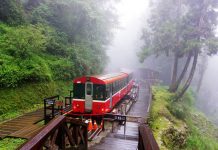
What to do in Alishan? — 5 top attractions & best…

Hong Kong Soya sauce Chicken Rice and Noodles — The first…
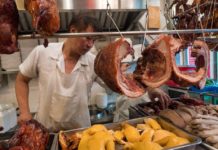
Hong Kong food culture — Hong Kong cuisine tells the historical…

Melaka food blog — Experience Melaka delicacies, arrived at by Trishaw

All about tips in Nepal — How much to tip in…

Cambodia travel tips — 15+ what to know & things to…

When is the best time to visit Kyoto? — The best,…

When is the best time to visit Malaysia? — The best,…

Top hotels in Siem Reap — 8+ best places to stay…

Top hotels in shanghai — 15+ best hotels in Shanghai

Top hotels in Malacca — 10+ good & best hotels in…

Top places to stay in Bali — Top 10 best areas…

10 must-know things for your best first time European river cruise

Top 3 best luxury cruises in Halong Bay, Vietnam

Cherry blossom festival Korea 2024 — Top 5 cherry blossom festivals…

Ghibli museum blog — The fullest Ghibli museum guide for first-timers

Kyoto festival — Top 10 best events & most famous festivals…

National Palace Museum Taipei blog — What to see in National…

Japanese waterfall — Top 10 most beautiful waterfalls in Japan in…

19+ most beautiful towns in Europe every tourist need to visit…

Georgia travel photos — 20+ captivating photos show Georgia is heaven…

Explore Damnoen Floating Market — The oldest floating market of Thailand

Visiting Fenghuang Ancient Town — One of the most charming ancient…

Mekong Delta travel blog — Beyond rivers of Southwestern Vietnam

14 reasons why you should travel when you are young

Shigaraki Tanuki – An animal symbol of good luck in Japan

Living in the charms of cave houses in Andalucia, Southern Spain

20+ jaw-dropping tiny homes around the world
Suzhou travel blog — the fullest suzhou travel guide & suggested 2-day itinerary for first-timers.

Chinese people have a lot of nice words to describe the legendary beauty of the famous land of Suzhou such as: “Up above there is heaven, down below there is SuHang (Suzhou and Hangzhou)”, which means that the beauty of Suzhou and Hangzhou as beautiful as heaven. Dubbed the Venice of Asia with small canals running between rows of poetic ancient houses, Suzhou has long been an attractive destination of the land of Jiangnan (the south of China). Not only that, Suzhou is also the Cradle of art and culture of China because it possesses countless beautiful classical gardens (forest garden).
Guide to Suzhou nightlife — 5+ what & best things to do in Suzhou at night
- Top things to do in Suzhou — 10+ fun, must & best things to do in Suzhou
- Where to visit in Suzhou? — 15+ top Suzhou attractions & best Suzhou places to visit
- Suzhou shopping guide — 15+ best Suzhou souvenirs & what to buy in Suzhou
- Kunming travel blog — The fullest Kunming travel guide for first-timers
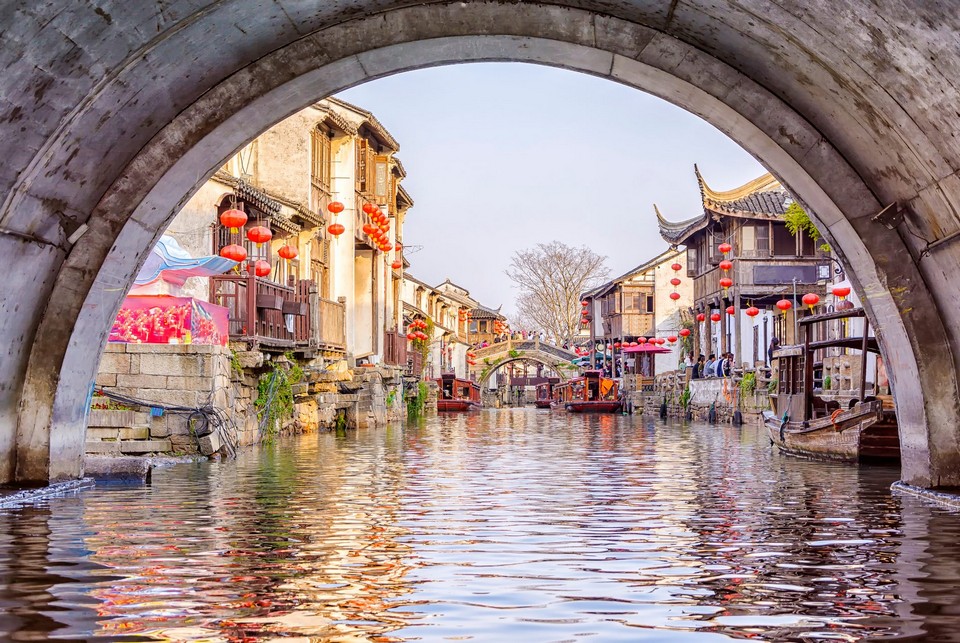
So, is Suzhou worth visiting, how to visit Suzhou, what to do in Suzhou and how to plan a budget trip to Suzhou for the first-time perfectly? Let’s check out our Suzhou travel blog (Suzhou blog) with the fullest Suzhou travel guide (guide to Suzhou, Suzhou tourist guide, Suzhou city guide, Suzhou guide) from how to get to Suzhou, best places to visit, best time to come, what to eat as well as top things to do in Suzhou and suggested Suzhou 2 days itinerary to help you maximize your trip as follows!
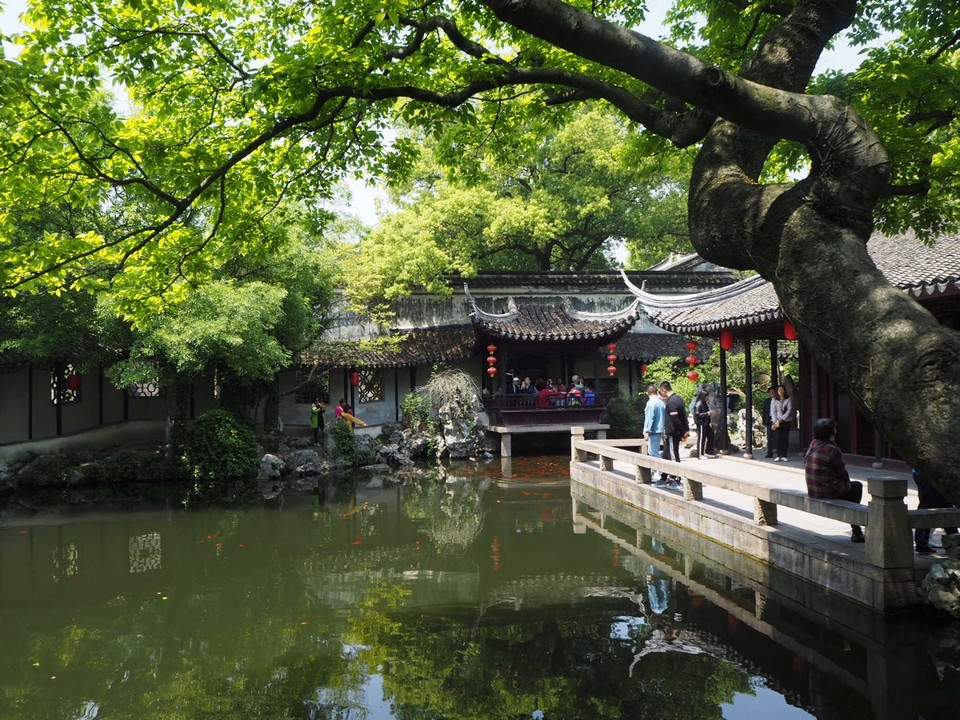
Suzhou is famous for its beautiful arched stone bridges, ancient Chinese-style temples and traditional gardens that are meticulously designed. Suzhou also used to be the center of silk production since the Song Dynasty.
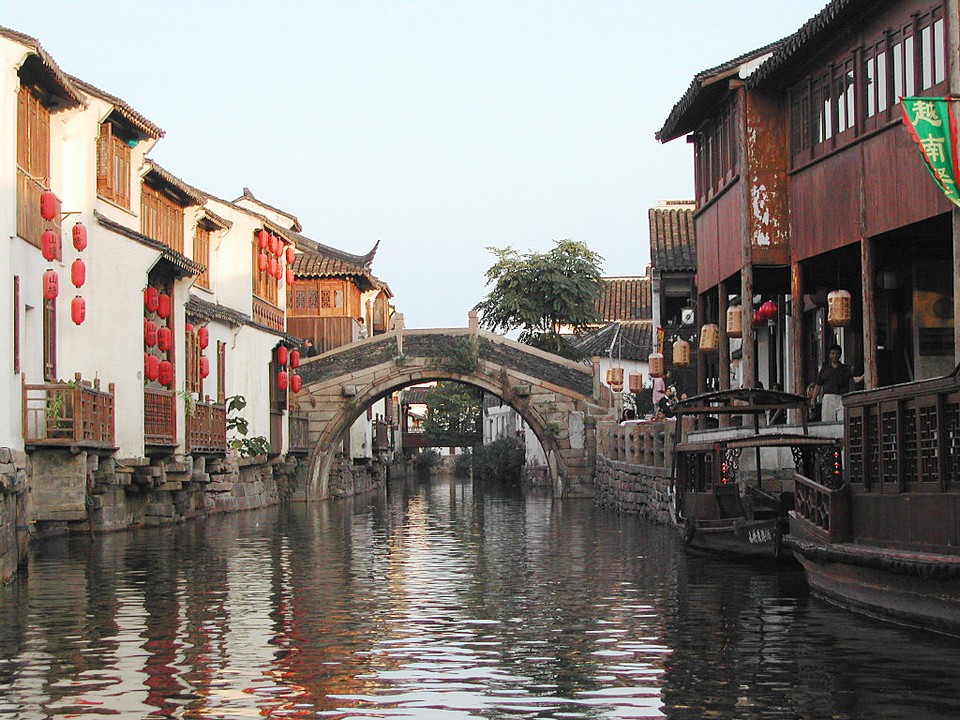
Suzhou travel blog: Overview of Suzhou
Suzhou has a long-standing history, located in the lower Yangtze River and on the bank of Lake Tai (or Lake Taihu) in Jiangsu province, China. Suzhou is 122km away from Shanghai and 240km away from Hangzhou. Because of the close to each other, travellers often combine these 3 destinations in one trip.
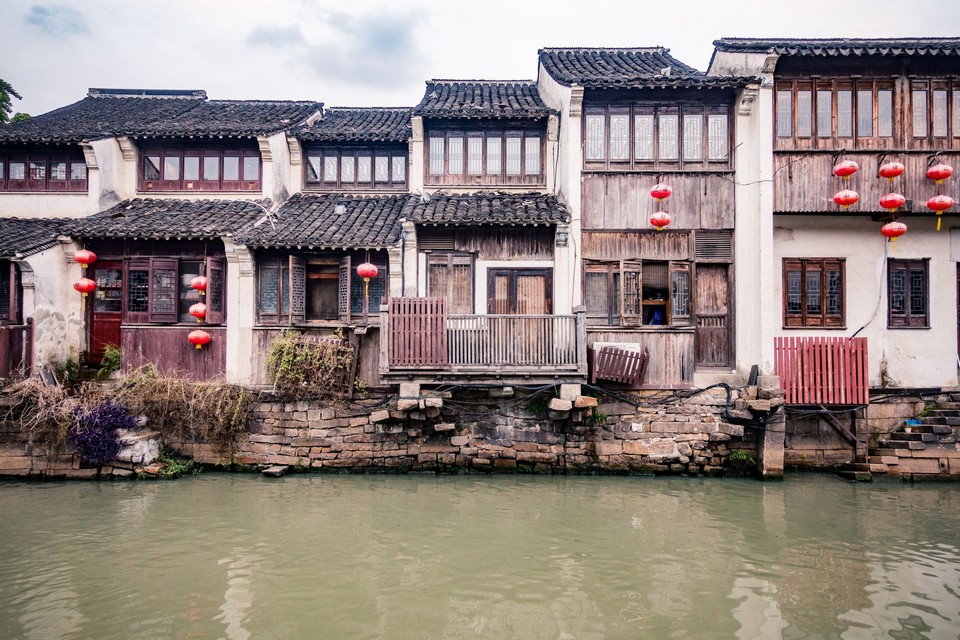
The beauty of Suzhou has long been an endless source of inspiration for poetry and music. Suzhou captivates visitors with its ancient, nostalgic beauty with ancient forest gardens, a maze system of canals and hundred-year-old stone bridges.
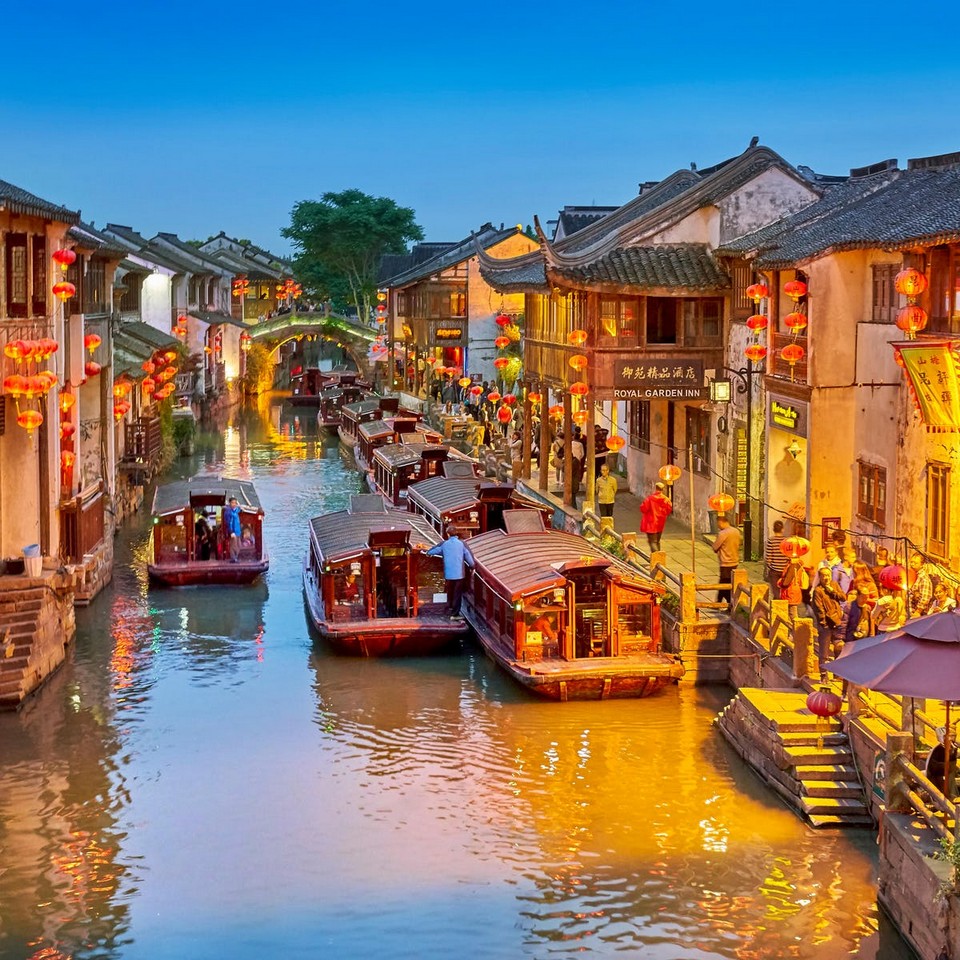
Life in Suzhou is crowded but not noisy, hustle and bustle but very peaceful. The rows of maple trees stand on the side of the road, willow trees hanging by the canals swaying as the wind blows, the curved gray roofs covered by moss, all the pieces that make up the gentle, charming of Suzhou today.
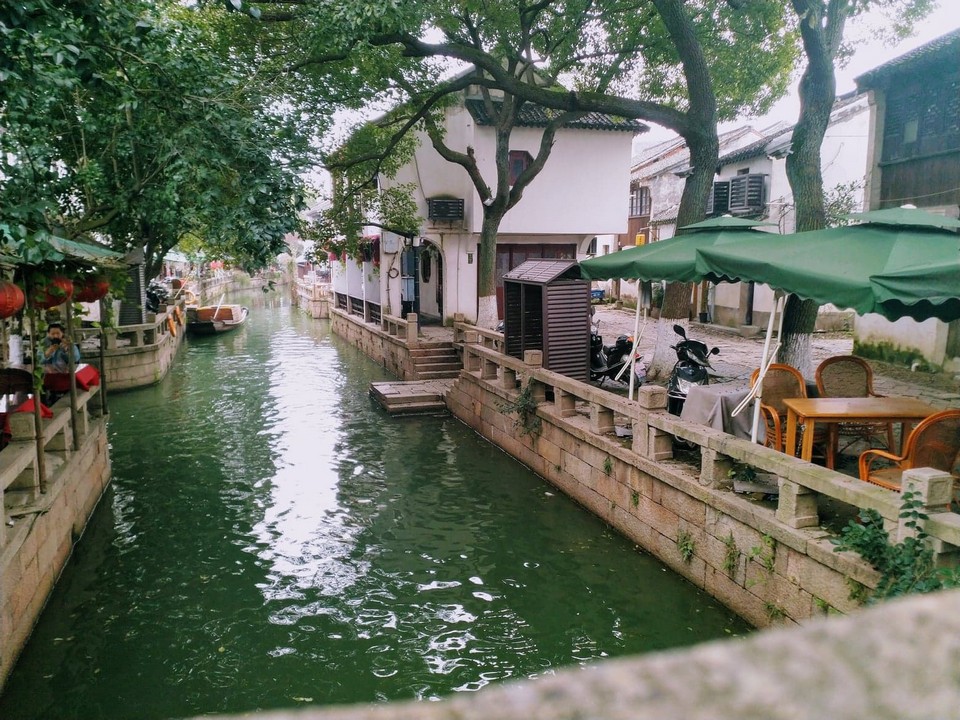
Suzhou travel blog: When to visit?
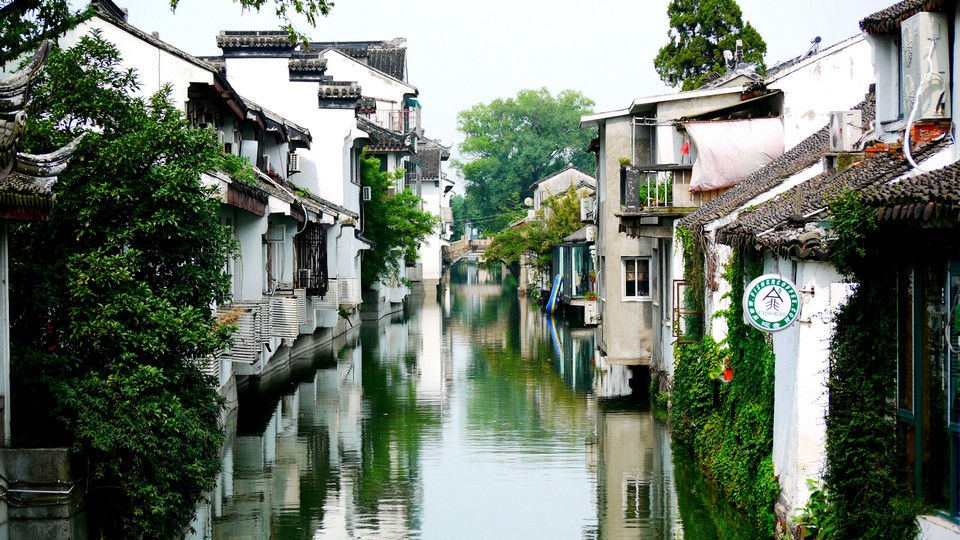
With a humid subtropical climate, Suzhou has four distinct seasons and each season has its own characteristics. You can visit Suzhou at anytime of year. But in my opinion, there are 2 good periods you should go:
Summer (late June – mid-July) or lotus season. In this period, the lotus will bloom in the ponds of gardens with lotus fragrance, creating a poetic scene bearing bold ancient style. However, the weather at this time will be very hot and crowded with tourists.

Autumn (mid-October – mid-November) with cool and pleasant weather (the temperature ranging from 17 – 22 degrees Celsius), the leaves start to turn yellow, creating a very poetic, nostalgic scene. I went in early November, although the weather was quite ideal, but there were little yellow leaves, and lotus leaves dying in the lakes in the gardens. So, the chance to see yellow leaves is quite rare, depends on your lucky.

In addition, in the middle of October, there will be a very beautiful field of Imperata cylindrica “Red Baron” (red Cogon grass) in Suzhou Industrial Park, I also did not see them because I came in early November, so regret. In general, October is considered the most beautiful time to travel to Suzhou, this is autumn time with cool weather and beautiful scenery.
In addition, spring is also very good time to come because this is the time when you can also admire the beautiful scenery in spring with blooming flowers everywhere. Especially at the end of April and early May, the scenery of Suzhou is full of vitality with the most brilliant of flowers, buds, plants.
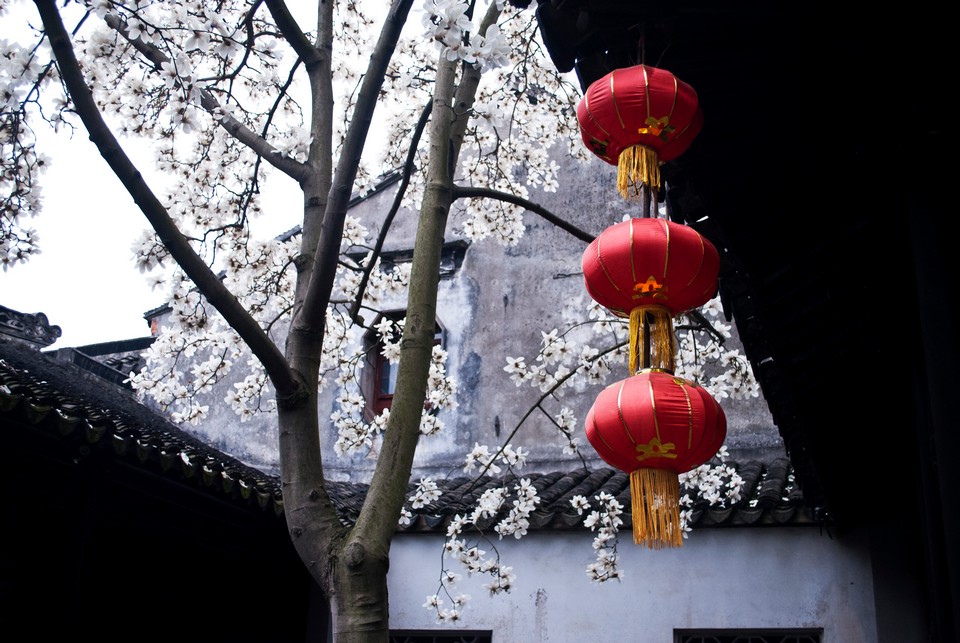
If you want to see snow fall in Suzhow, let come here in winter.
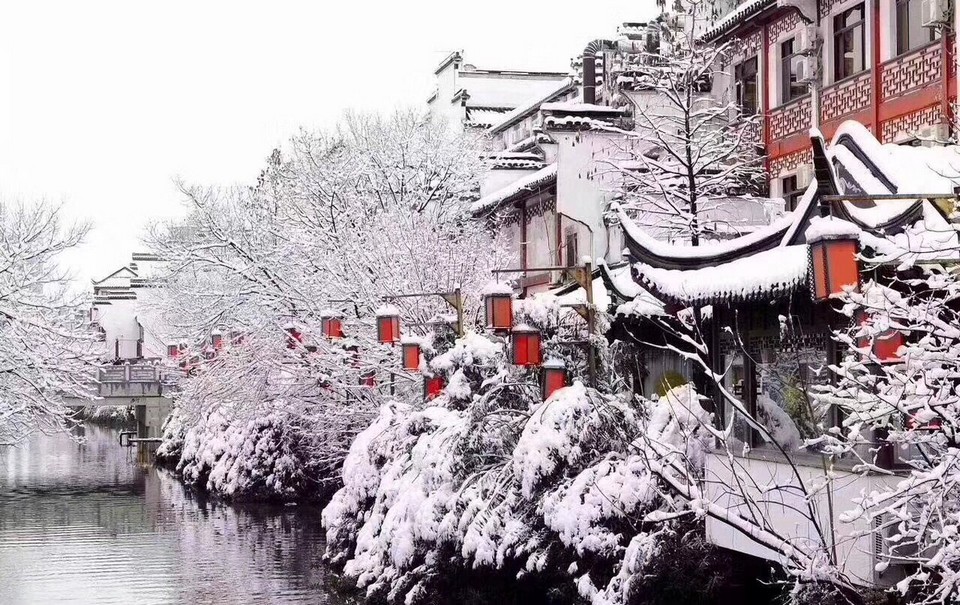
- Avoid traveling to Suzhou on major Chinese holidays such as Labor Day (International Workers’ Day) on May 1 and Independence Day on October 1. Because on these occasions Chinese tourists flock to tourist destinations are extremely crowded (even you will hard to find a spot to standing).
- Avoid traveling to Suzhou on weekends, because Suzhou is like other hot tourist destinations such as Dalat or Sapa, Hoian in Vietnam, it also is a weekend destination for Chinese people. So, every weekend, tourists flock here. Although, it was not a special occasion, but I saw visitors also flocked very crowded on Shantang Street of Suzhou.
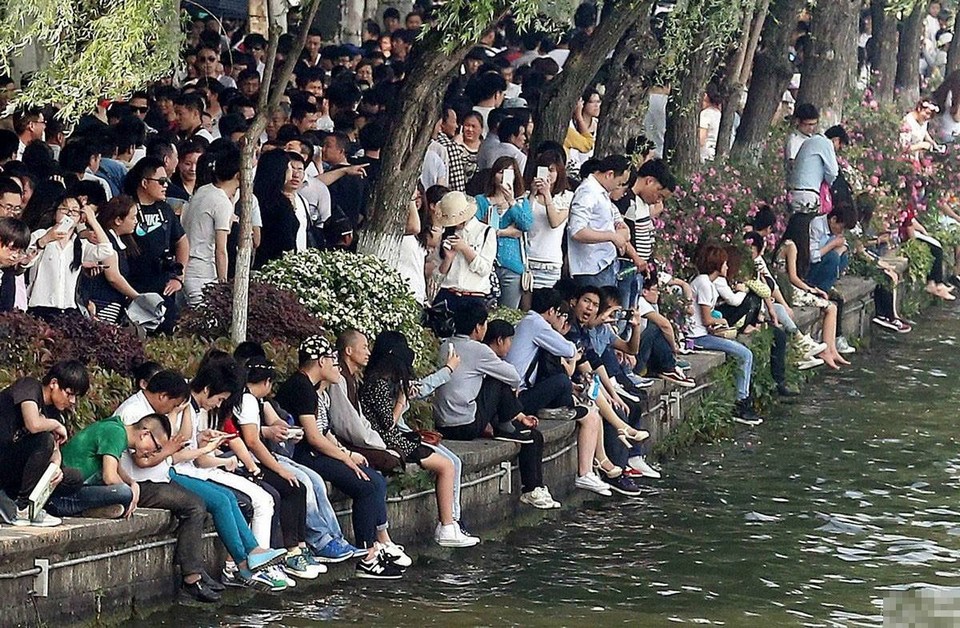
Suzhou blog: How to get to Suzhou?
Currently there is no airport in Suzhou, so if you want to get to Suzhou, you will have to fly to another city and then going to Suzhou from there. The most popular option is to go from Shanghai.
From Shanghai you can go to Suzhou by different means of transportation, but the most convenient is still to take a train. The train to Suzhou from Shanghai will depart from two stations: Shanghai and Shanghai Hongqiao Railway Station. You should choose to depart from Shanghai Station because it is closer to the city center. One-way ticket price from 31 – 39.5 yuan depending on time.
Besides taking the train you also can take a bus which costs CNY40-50 and traveling time about 1 hour and a half. Also taxi at high price of CNY400-500, traveling time similar traveling by bus.
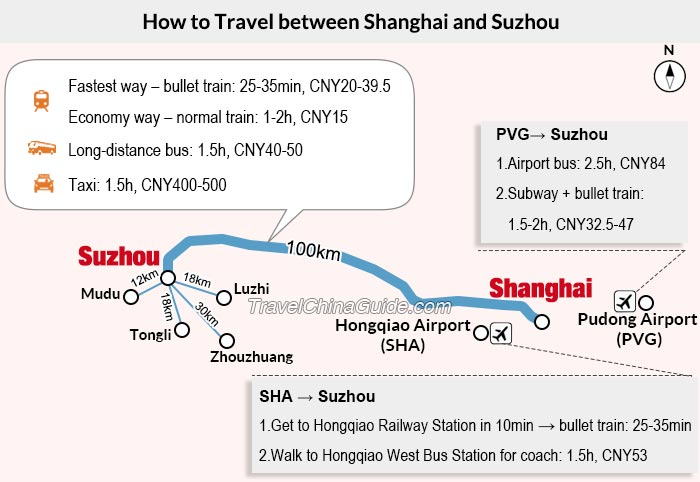
You should buy tickets in advance through Klook to avoid queuing here .
I have a friend in Shanghai, so take advantage of weekend, he took me to Suzhou by his private car. Compared to the 30-minute train ride, traveling by car will take longer, it takes about 2 hours of traveling. On the way, when reaching the check point, you will have to stop for the police to check your papers.
Suzhou travel guide: Getting around Suzhou
Bus: Suitable for travelers because it’s very convenient. Traveling by bus you can freely to enjoy and sightseeing the scenes of Suzhou. Prices are around 2-5 yuan for each trip, usually these buses go through the train stations.
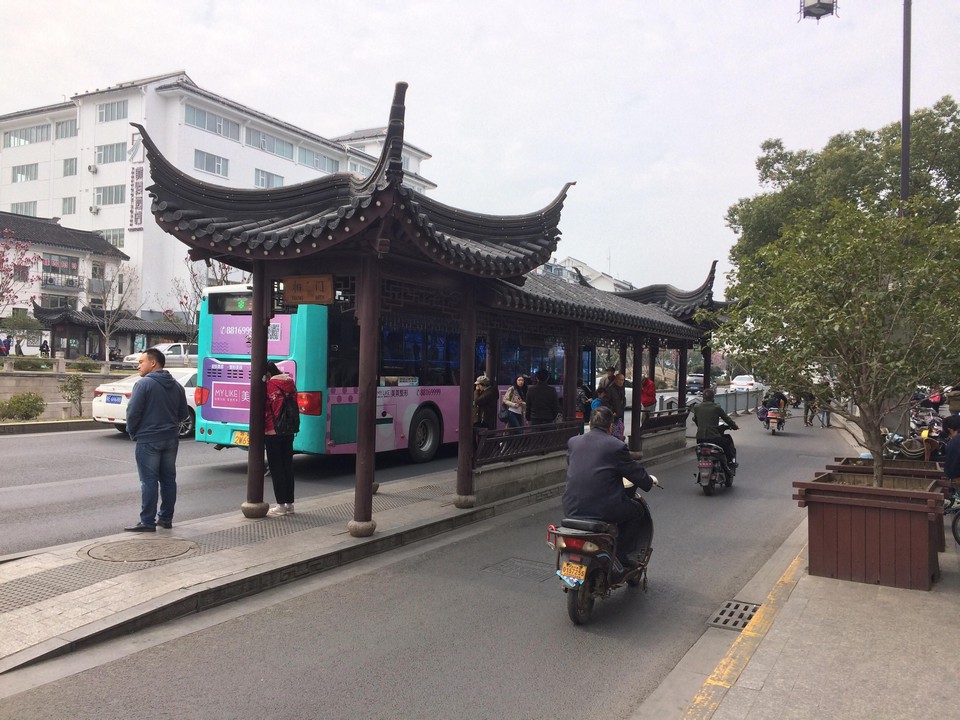
In Suzhou, you also can walking to visit several nearby attractions such as Humble Administrator’s Garden (Zhuozheng Yuan) or Lingering Garden. But for some futher attractions I recommend you should take a taxi.
Subway: In addition, there is also a subway system in Suzhou that connects points in the city. But according to my self-sufficient Suzhou travel experience, if you just want to visit main attractions, it is not necessary.
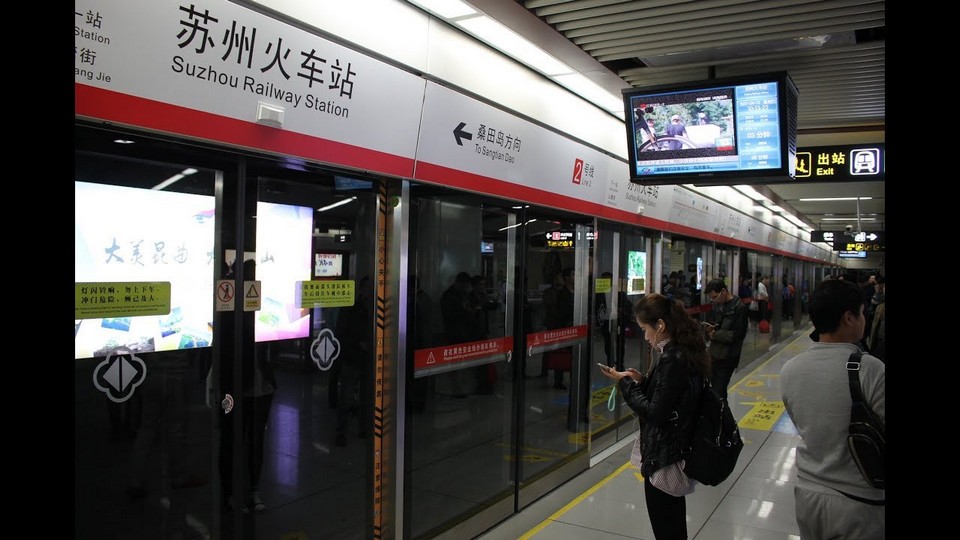
Suzhou travel blog: Where to stay?
Normally, tourists usually make their day trip to Suzhou and back to Shanghai at the end of the day, but since we just arrived in China the day before, we chose to stay overnight.
If you plan to stay overnight, you should stay around Shantang or Northeast (Dongbei) walking streets. At night, Shantang street will be very bustling and vibrant like the scene in some Chinese historical movies.
For one overnight in Suzhou, I stayed at Together – Venue Fawn Hostel Suzhou . A hostel for young people, is chosen by many backpackers, very cool with prime location, right near the subway station with a little walk to reach Lingering Garden. Overall, I rated this hostel 9/10! Room rate at 34 yuan/night.
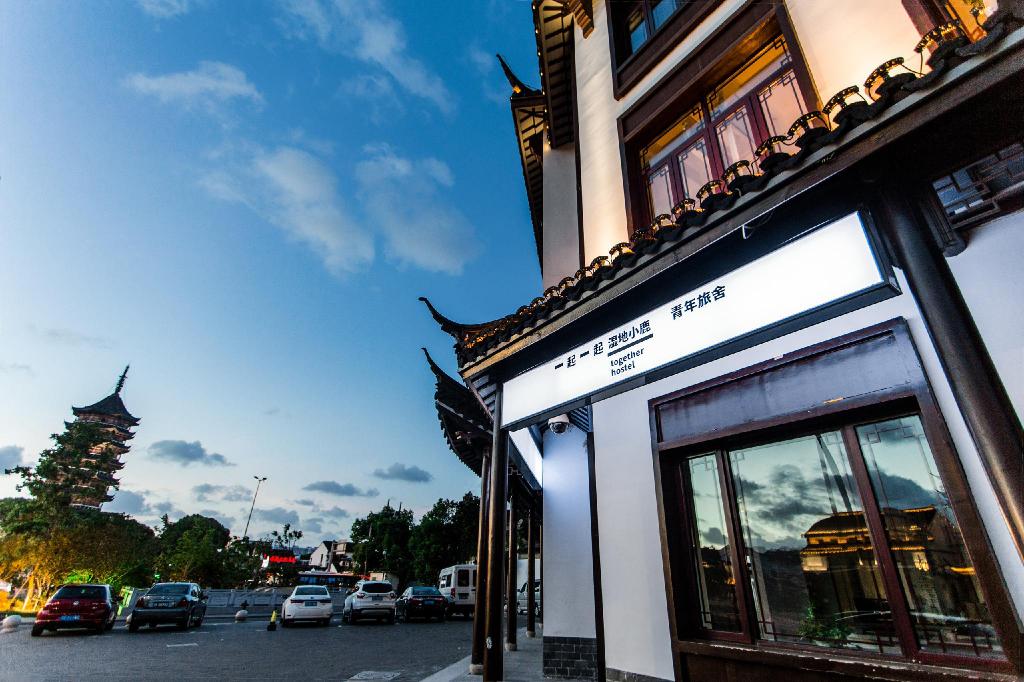
- Not all hotels in China are allowed to welcome foreign guests, please note when booking.
- Hotels that are allowed to accept foreign guests in Suzhou will check-in international guests by facial recognition system (also in Shanghai and but not yet in Beijing).
Below we recommend more best budget, mid-range and upscale hotels with good ratings and reviews you can refer to.
- Shangri-La Hotel Suzhou ( Agoda.com or Booking.com )
- Kempinski Hotel Suzhou ( Agoda.com or Booking.com )
- InterContinental Suzhou ( Agoda.com or Booking.com )
- Shangri-La Hotel, Suzhou Yuanqu ( Agoda.com or Booking.com )
- Renaissance Suzhou Hotel ( Agoda.com or Booking.com )

Find out more the top rating hotels in Suzhou on Agoda.com or Booking.com .
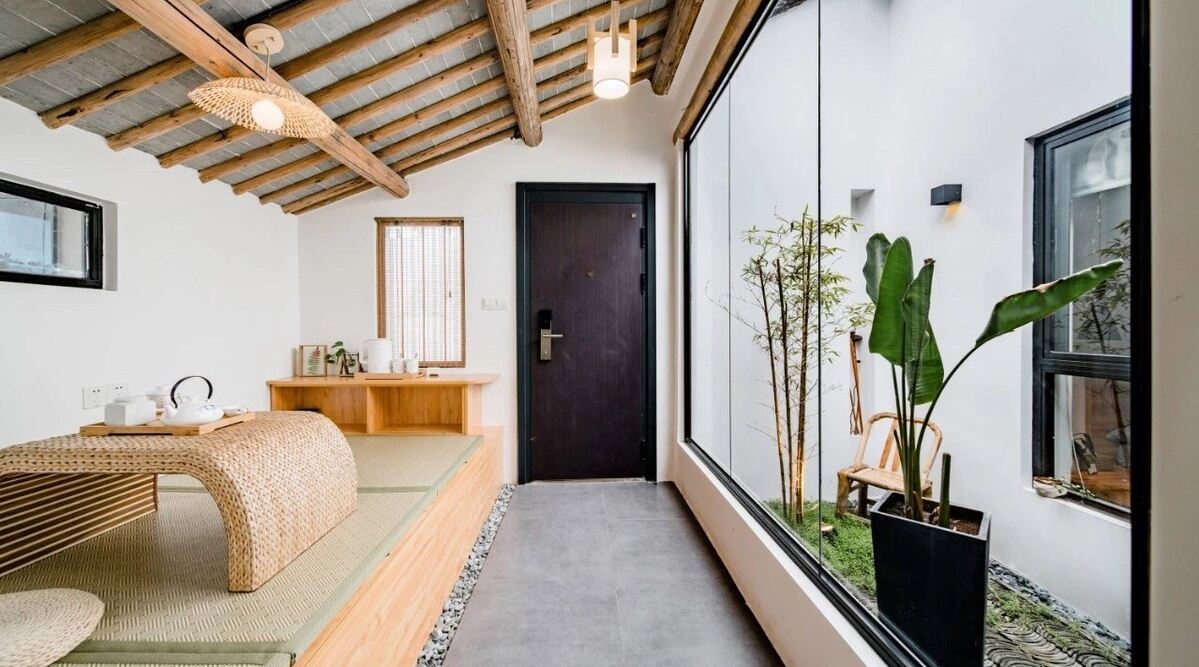
Suzhou blog: What to do and where to go?
Pingjiang historic district.
Suzhou has always been proud of its intertwined canals, especially in the Pingjiang District which is a former district of Suzhou, dating back to the Song dynasty. It has about 7 canals running in the north to south direction and 14 canals in the east to the west direction along with 18 beautiful arch stone bridges over these canals.

Because of being extremely famous for its intertwining and intersecting canal system, Suzhou is compared to Venice of China. Sitting on a boat to relax and drop your soul freely along the romantic canals and observing people passby is a wonderful experience like no other. The canal water here is green, flowing through small canals that are embanked with solid stones and large enough to allow the boat easily navigate.
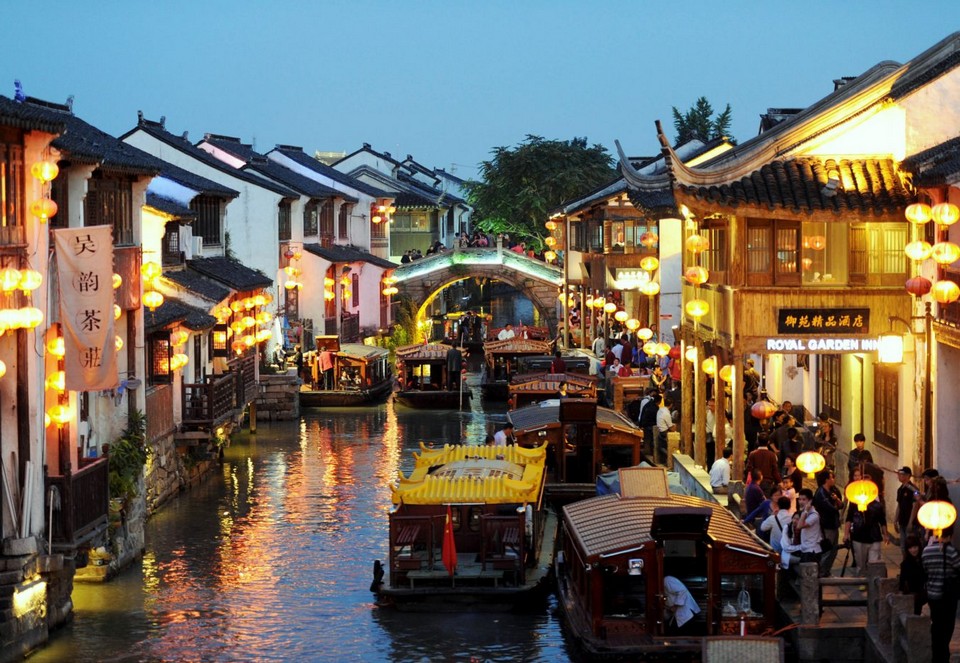
Stone bridges
Ancient and old stone bridges span the lovely canals in Suzhou as a highlight and adorn its beauty and has more than 18 arch stones brigde cross the canals. If you walking along the canals, you will see so many stone bridges that you cannot count how many bridges and even remember their names without paying attention. Each stone bridge has its own unique architecture with all of shapes: the tall one, the big one, the small one, the high slope one, but most of them share a common thing: an art and poetic arch shape. Each bridge holds unforgettable memories of local couples as this is a familiar romantic date spot every time the moon rises.
Especially at night, along the two sides of the canals are decorated with bright lanterns shining down on the canal surface, creating a beautiful and magical scene like in a historical movie. Life here is quite crowded, bustling, but not noisy, hustle and bustle but has its own order.
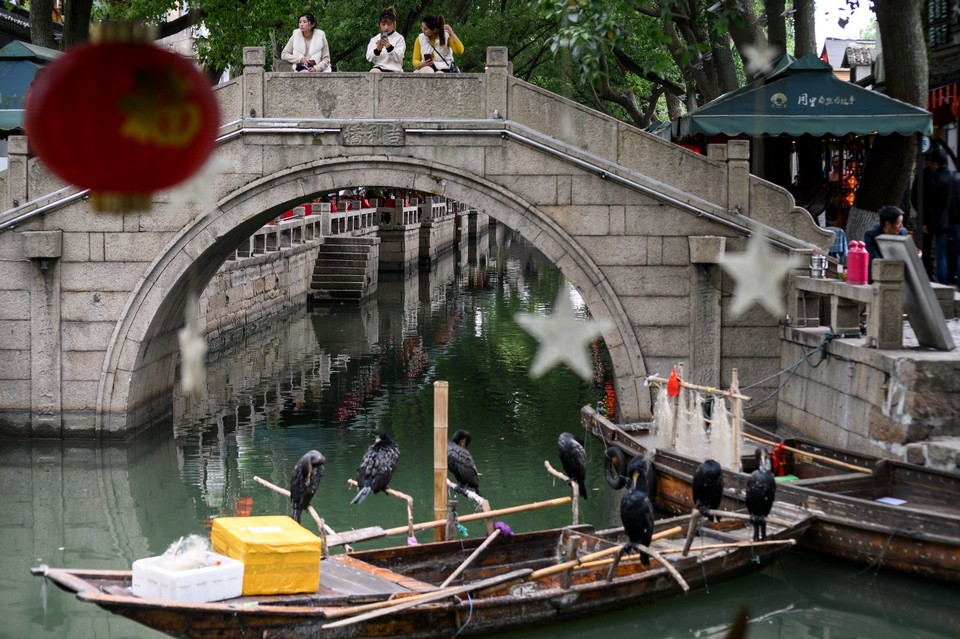
Ancient town
It can be said that the ancient town in Suzhou is not too different from the other ancient towns of China, but if chosen, many tourists still want to go to Suzhou the most because this is a poetic land with grey roof tiles, white walls of ancient houses located along the charming canals, slowing pace of life, narrow and roughly cobblestone roads with few passing vehicles evoke the peaceful atmosphere in the old town with many old features.
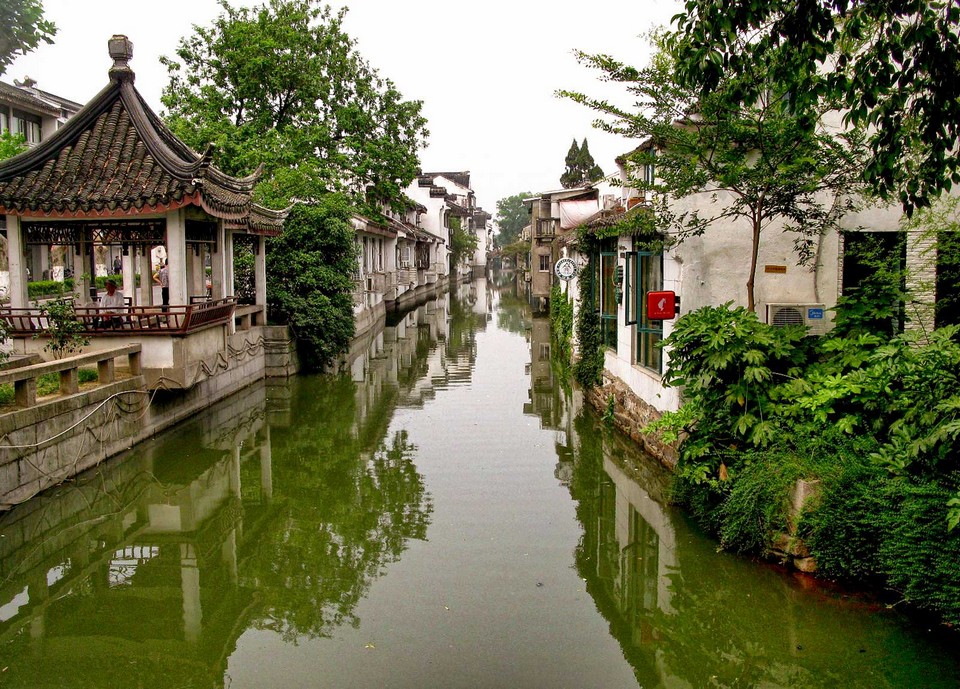
Chinese gardens
Suzhou is not only famous for its Pingjiang canal system, gentle curving bridges like silk over the rivers or an old town with full of poetic features, but also known as the land of Chinese classical gardens. As a city not very large in both size and scale, but Suzhou owns more than 200 large and small gardens which were built through the centuries, many dynasties with 9 gardens recognized by UNESCO as World Cultural Heritage Sites which should be preserved such as The Lingering Garden (Liu Yuan), The Master of the Nets Garden (Wangshi Yuan), The Mountain Villa with Embracing Beauty (Huanxiu Shanzhuang), The Lion Grove Garden (Shi Zi Lin Yuan). Suzhou is named by tourists as the “kingdom” of the classical gardens.
Humble Administrator’s Garden (Zhuozheng Yuan)
Zhuozheng Yuan is considered to be the perfect symbol of Ming garden architecture style. Stretching on an area of more than 5 hectares with bamboo groves, windy pavilions and lotus ponds, Zhuozheng Yuan is the largest and most famous garden in Suzhou.
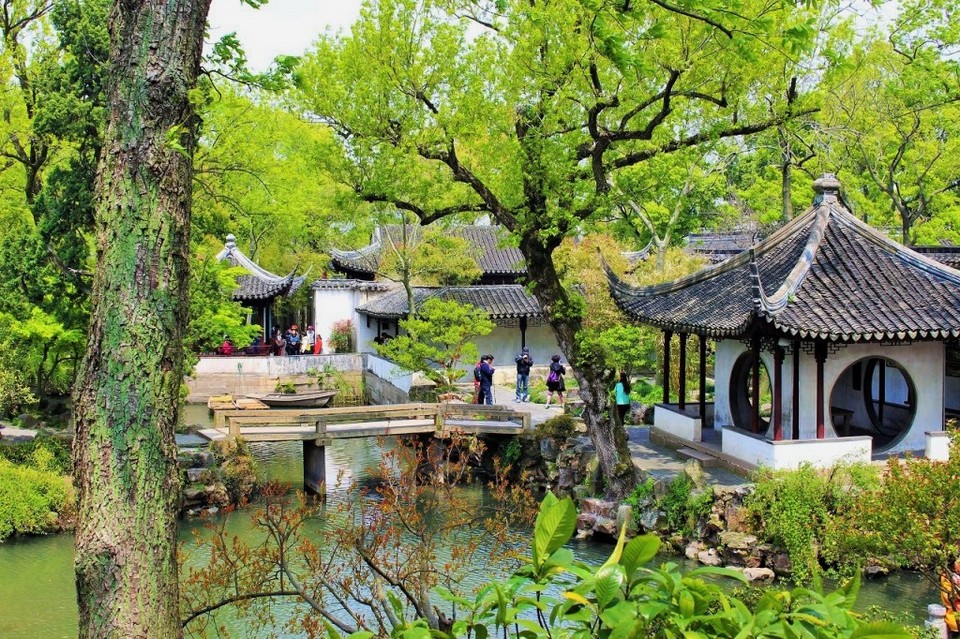
Once stepping inside the garden, you will feel like stepping into a dreamland in a quiet, tranquil space like what you often seen in Chinese historical movies. Legend has it that although it was designed in 1509, it spent a full boat of “silver” and 6 years to build up Zhuozheng Yuan. Thanks to the meticulousness and feats that have created a wonderful work bearing bold architectural style of the Ming Dynasty for later generations.
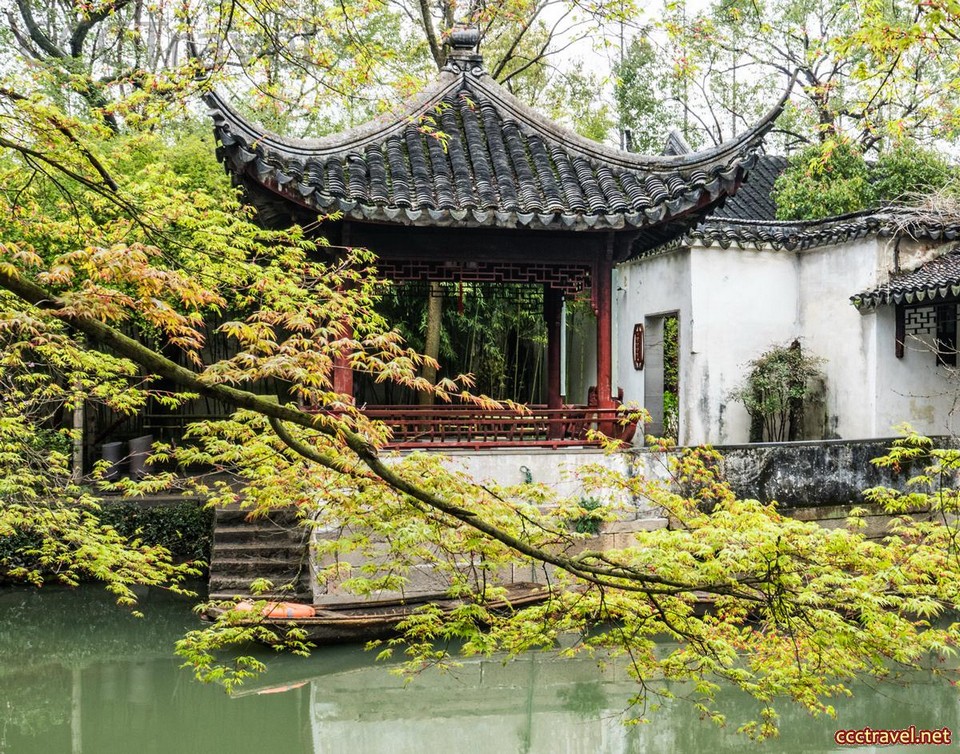
- Humble Administrator’s Garden Ticket in Suzhou
Address: 178 Dongbei St, Gusu District, Suzhou, Jiangsu, China, 215001 Opening hours: 7:30AM – 5PM Admission: 90 yuan – Buy tickets in advance here
Lion Forest Garden (Shi Zi Lin Yuan)
Shi Zi Lin Yuan is the filming location of the movie Journey to the West. Shi Zi Lin Yuan with unique and magical architecture is not only a treasure of Suzhou but also one of the most beautiful and large-scale classical gardens in China.

Shi Zi Lin Yuan is a traditional Chinese garden which was built in the northeast of Suzhou in the Yuan Dynasty, so it bearing bold architectural style of this dynasty. In the garden, the rocks were brought from Lake Taihu with countless strange and diverse shapes, stacked, which are very similar to a lion’s head at first glance, so this place is called Lion Grove Garden.
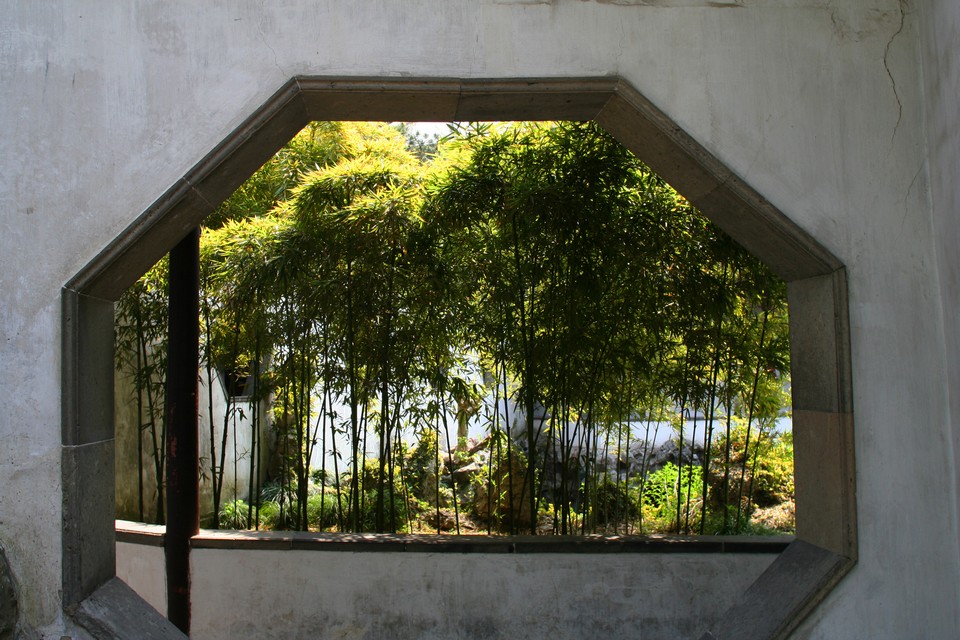
- Lion Forest Garden Admission Ticket in Suzhou
In an area of 1.1 hectares, Shi Zi Lin Yuan is designed harmoniously between water and mountains, nature and people exchange and open up. The ancient and elegant beauty of Shi Zi Lin Yuan makes visitors always feel relaxed and peaceful while strolling around the garden.
Note: You should not visit Shi Zi Lin Yuan if you go with the elderly and children because the ways are zigzag, up and down as a maze, it’s hard to find the exit.
Address: Address: 23 Yuanlin Rd, Gusu District, Suzhou, Jiangsu, China Opening hours: 7AM – 5PM Admission: 40 yuan – Buy tickets in advance here
Lingering Garden (Liu Yuan)
With an area of 23,310 m², the Liu Yuan garden is divided into 4 areas which were designed according to different architecture style but are linked into a long corridor. This makes visitors feel like they are lost in a giant garden with endless natural scenery without stops.
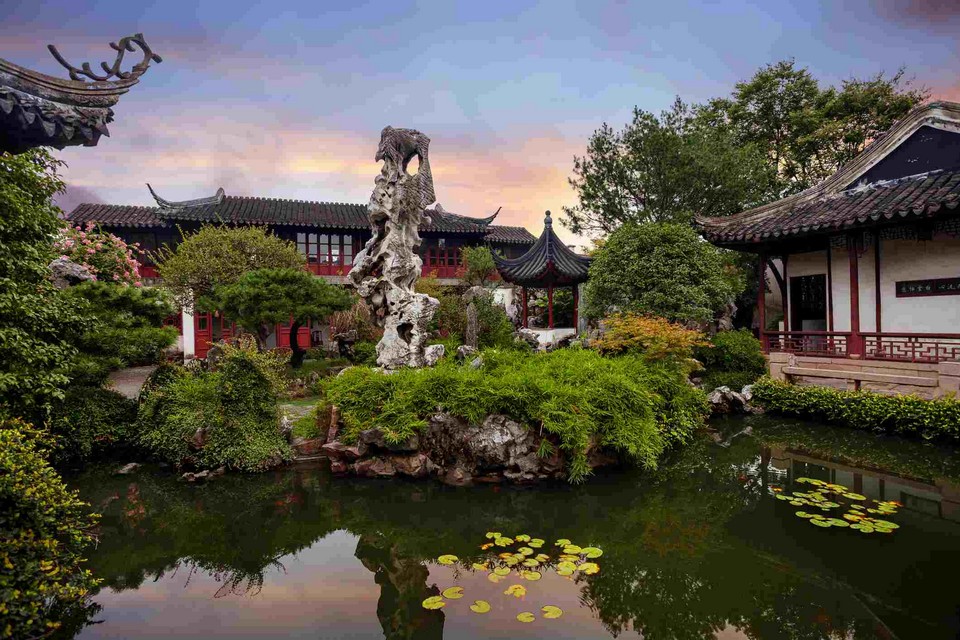
- Lingering Garden Ticket in Suzhou
Address: 338 Liuyuan Rd, Gusu District, Suzhou, Jiangsu, China
Couple’s Retreat Garden (Ou Yuan)
Ou Yuan is also known as Suzhou classical style bonsai garden. This is a typical forest garden architecture in the citadel, taking the residential core in the middle as the main garden, this type of architecture dates back to the Spring and Autumn period (Chunqiu Shidai, 770-476 BC) in 514 BC. Ou Yuan garden is the convergence of the artistic quintessence of ancient Chinese garden style. Although simple but delicate, bringing the natural beauty and showing the outstanding skills of the ancient gardeners, it can be said that this garden represents the art of Chinese garden style.
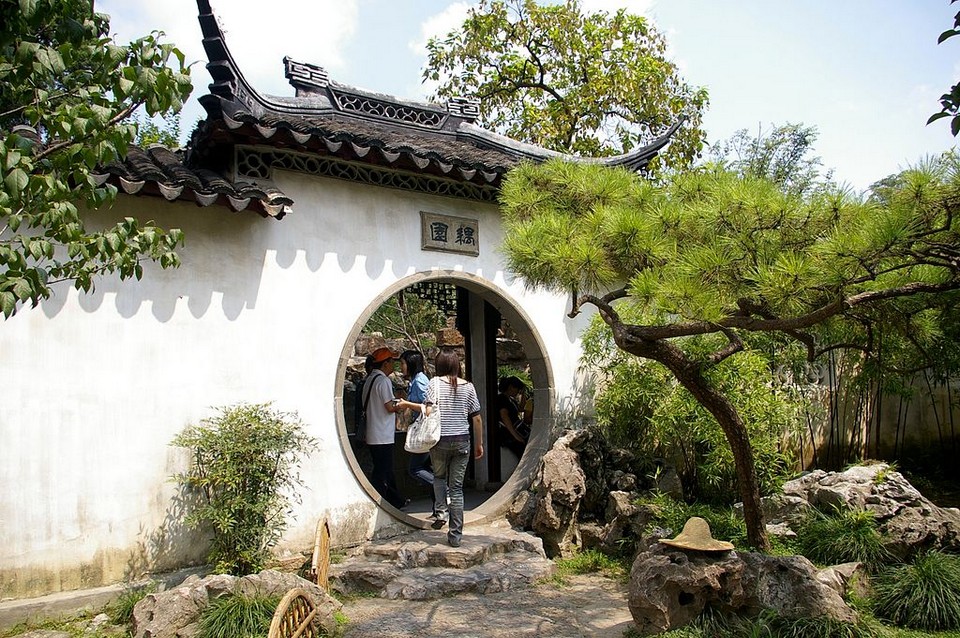
Address: Gusu District, Suzhou, China
Suzhou Silk Museum
Suzhou is not only a famous tourist destination of China but also a famous silk production region. Suzhou Silk Museum is a tourist spot not to be missed if you want to learn about the silk of this land. The museum is a place to keep many documents about the silk production process of local people from ancient times with a history of more than 5000 years.
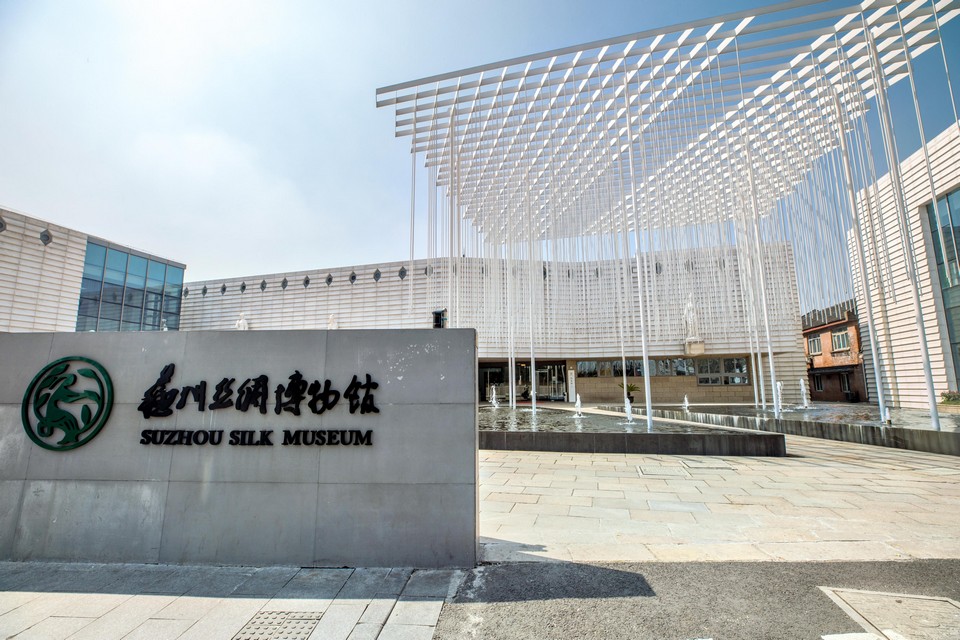
Tourists coming here can see the traditional looms, some ancient silk patterns and the proper mulberry growing process to produce the best silk in the world. It also displays a wide range of paintings, calligraphy and handicrafts from all over the country. Most of these artifacts date from the Song, Ming and Qing dynasties. Besides, the unique architecture of the museum also impresses tourists.
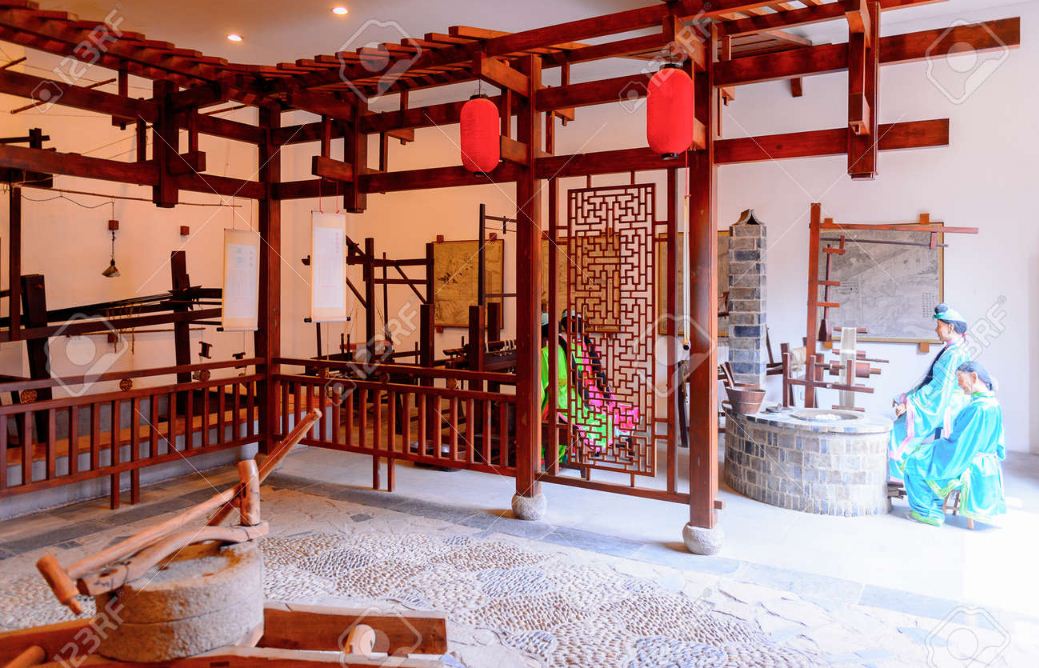
Address: 2001 Renmin Rd, Ping Jiang Qu, Suzhou, Jiangsu, China, 215001 Opening hours: 9AM – 5PM (closed on Mondays) Ticket price: Free
Shantang Old Street
Shantang is a famous pedestrian street in Suzhou and is a gathering place for tourists. It’s always bustling especially at night, a must-visit place in Suzhou. Along the street are souvenir shops, restaurants, food stalls and inns lying close together, all creating town’s ancient atmosphere.
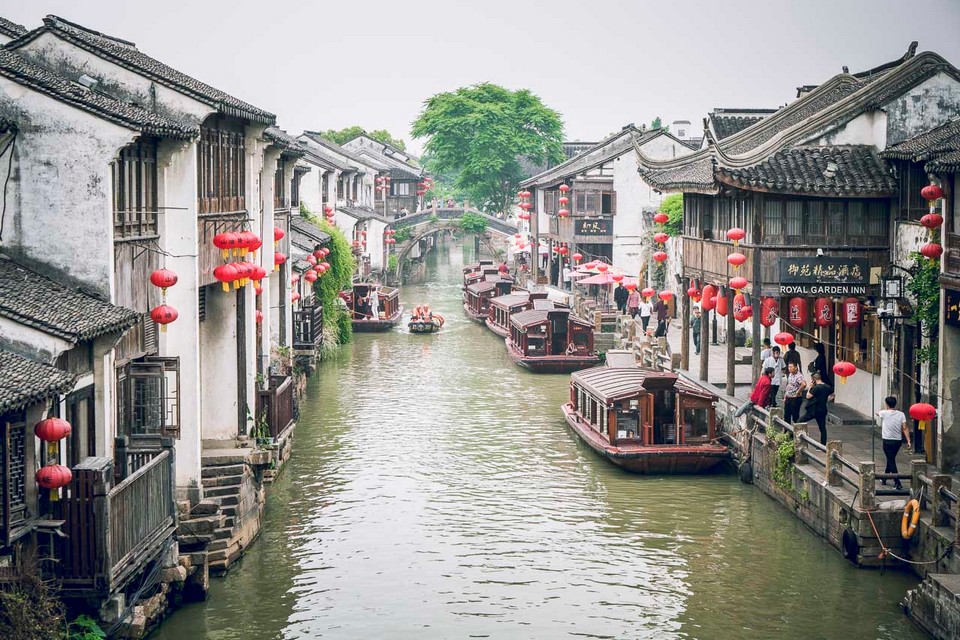
Tip: Do not come here on the weekends because there are extremely crowded with tourists, 1 square meter is “hundreds of people”, even you will hard to find a spot to stand.
Oriental Arc Building
Oriental Arc (The Gate to the East) is the tallest building in Suzhou with a height of over 300m with 66-storey. This building built in gate-shaped, symbolizing the gateway to bring the quintessence of the land of Suzhou to the world. But if you look longer you will see that this building is more like a pair of pants than a gate.
There are many spots to see the panorama of this architecture, but the closest one is right at the park opposite, the Suzhou Industrial Park. If you want to know what the scene will look like, you can check out the photo below.
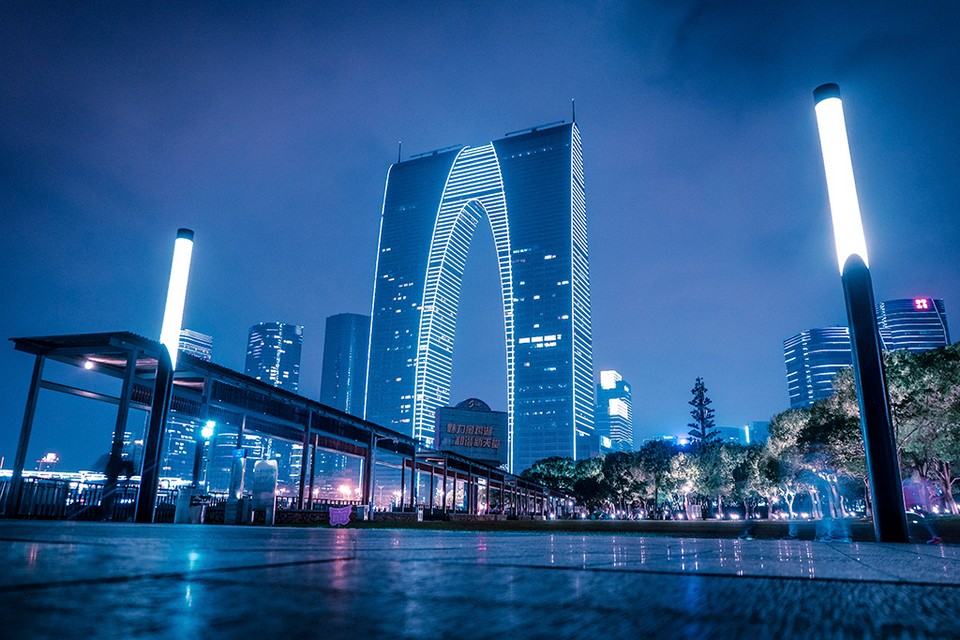
Hanshan Temple (Hanshan Si)
Suzhou is a land where Buddhism thrives and long-standing with very famous temples and pagodas but the most famous is Hanshan Si Temple. The temple was built in the early 6th century under the dynasty of the Emperor Wu of Liang.
The temple has an area of about 10,600 square meters, located in the west of Fengqiao District, about 5km from the center of Suzhou. The most known mural is Hanshan carved in stone by the painter La Sinh So who lived in the Qing dynasty, the famous calligraphy of Truong Xu Lieu is also now kept here. In addition, Hanshan Temple is also famous for the statues of Buddha, the Eighteen Arhats… and stone steles recording poems and great poets.
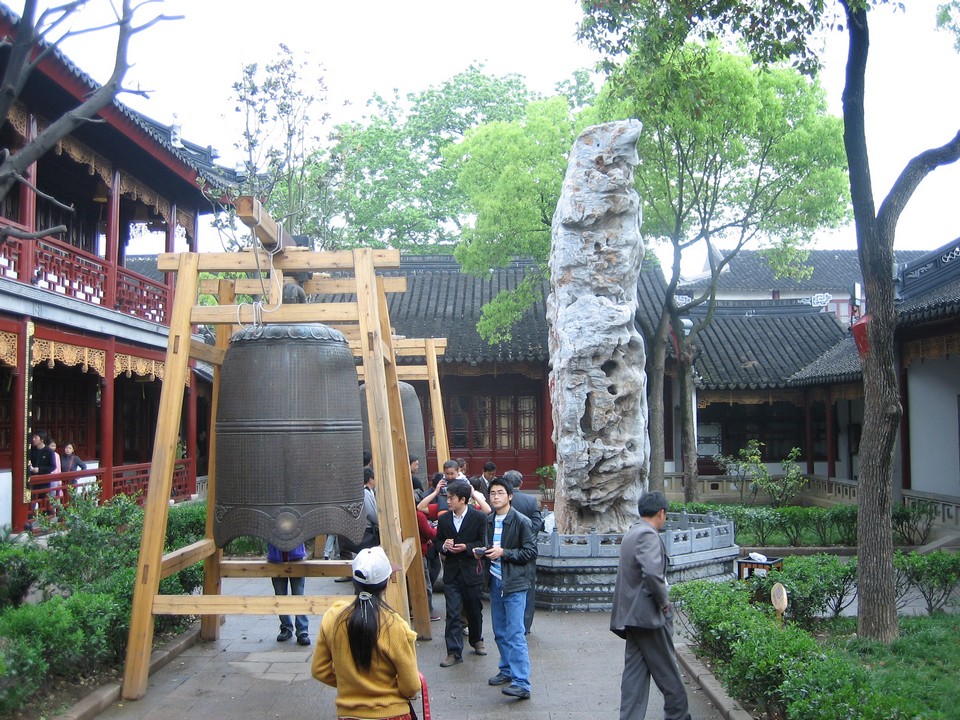
Address: China, Jiangsu, Suzhou, 金阊区寒山寺弄24号
Wuxi Film Studios
If you plan to stay in Suzhou more than a day, you can visit here. This is one of the familiar locations for cheap China tours and also on the Suzhou travel guide brochures. The historical movie Three Kingdoms and many other legendary historical films about the mighty China of the past were all filmed here. Visitors will see firsthand the battle boat models that recreate the battle flood and landslide called Chibi (the Battle of Chibi), enjoy the fascinating traditional peking opera on the river, horse riding, wear armor, disguised as characters in the epic movies, experience spirit of the warriors in ancient times.
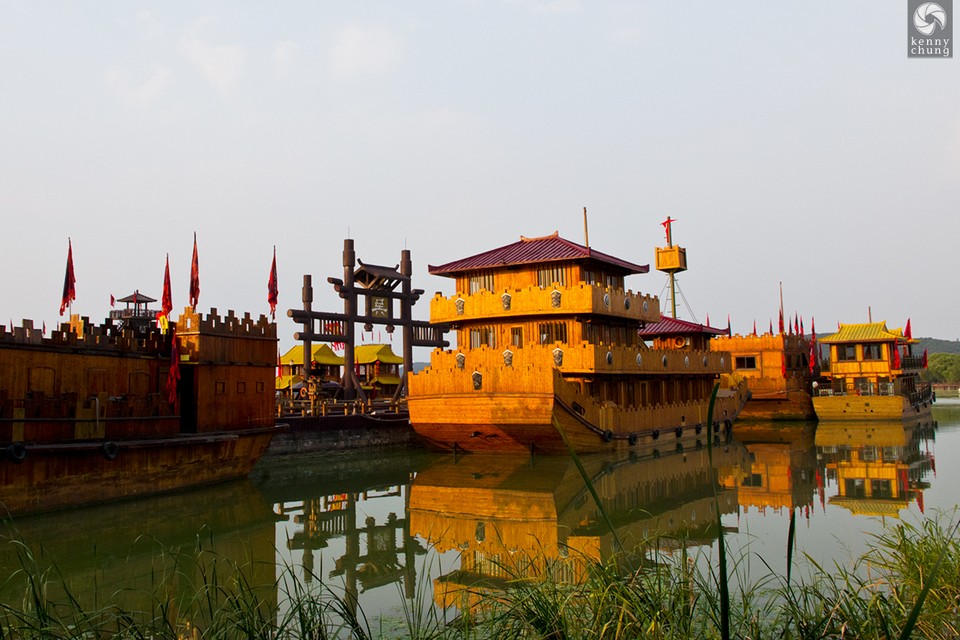
Address: China, Jiangsu, Wuxi, 南长区 Renmin W Rd, 45号金惠大厦13层1306
Suzhou travel blog: What to shop?
It is a famous Chinese tea grown in Dongting mountain, Lake Taihu, Suzhou province. This type of tea when sipping for the first time, it has a light color and a fresh aroma. At the second drink, it has green color, fragrant while the third drink, it has emerald color and the aroma is strong and sweet.

Weaving and embroidery products are very famous in Suzhou as well as the world, you can choose these products as gifts for friends and relatives.
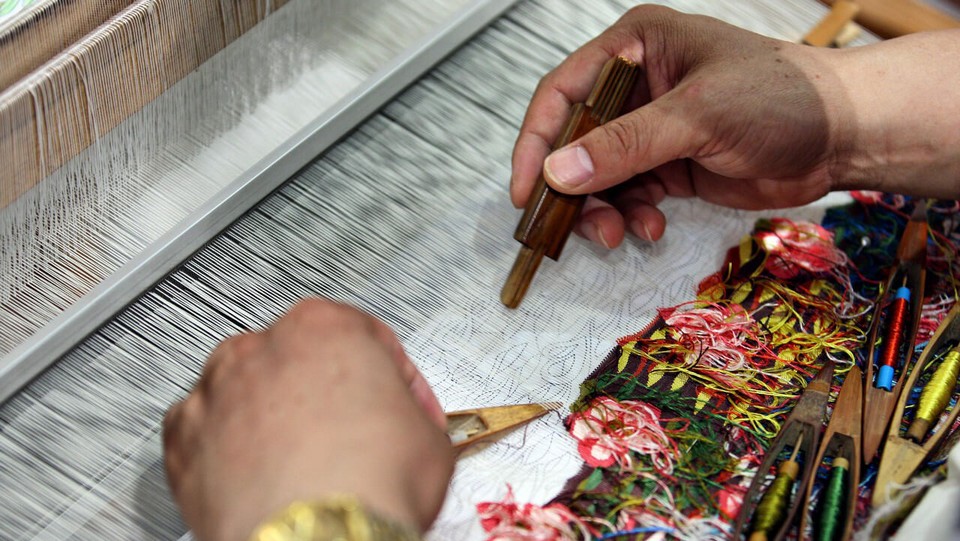
Guanqian Street is a famous shopping street, it has everything from shopping, cuisine, sightseeing to tourism services. Here, you can choose from a full range of items as gifts, especially the famous traditional products in Suzhou such as tea, silk.
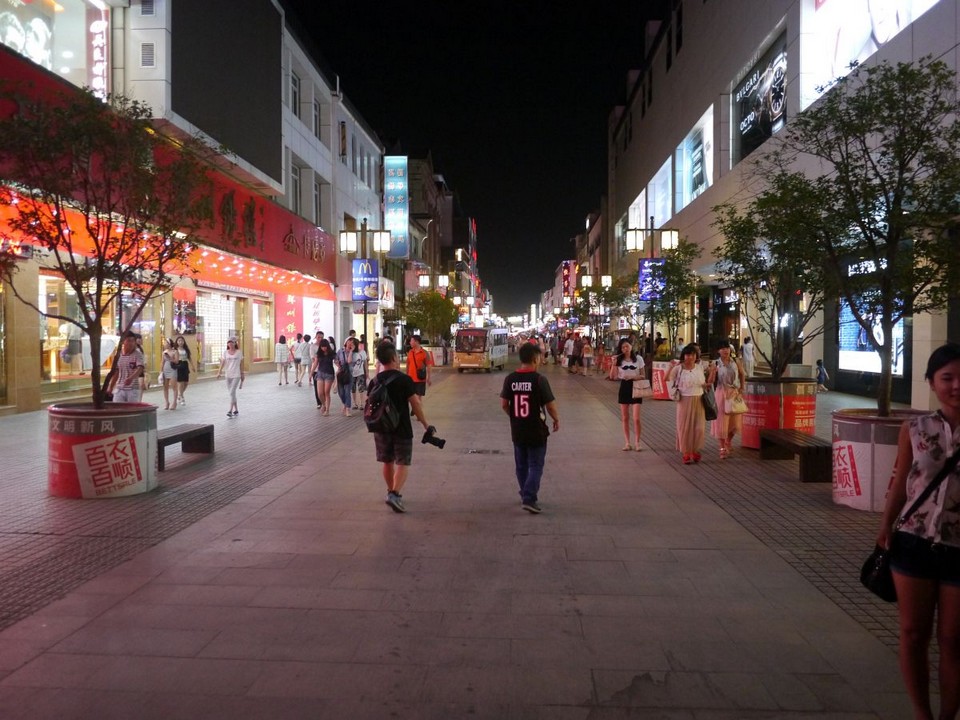
Suzhou blog: What to eat and where to eat?
Traveling to Suzhou, in addition to being able to admire the beautiful scenes like in Chinese historical movies, you will also be fascinated by the quintessential dishes of the people here. Although it’s not as rich as its neighbor Hangzhou, Suzhou cuisine is enough to make visitors remember forever. Many kinds of meat, sesame cakes are very delectable, but you only have to pay less than 5 yuan to have a rustic breakfast, or bring it as a reserve food for a long day of discovery. I will introduce some typical dishes you should try in Suzhou below.
Steamed Taihu Lake Fish
Although the steamed fish dish is easy to prepare and can be found anywhere, but only fish in Taihu Lake has a characteristic sweet taste. The tender and chewy fish meat is steamed with soy sauce to create a delicious taste that is irresistible.
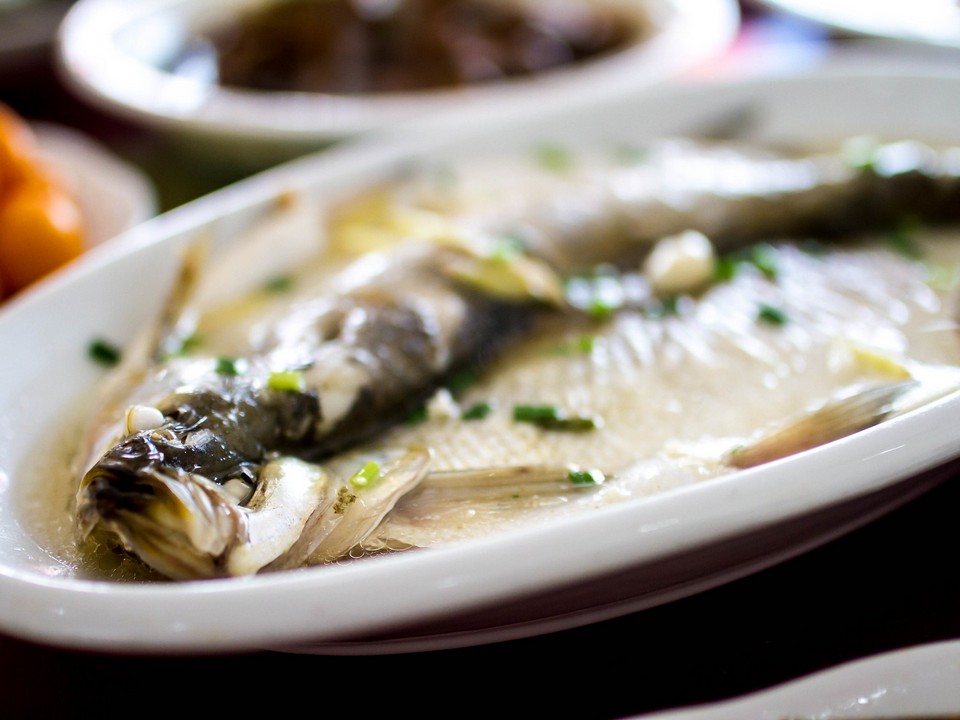
This is a delicately processed dish, fish will be nicked, battered and fried. This is favorite dish by Emperor Qianlong and most restaurants in Suzhou serve this dish. Fish after deep-fried will look like a squirrel-shaped, and be poured with sweet and sour sauce.
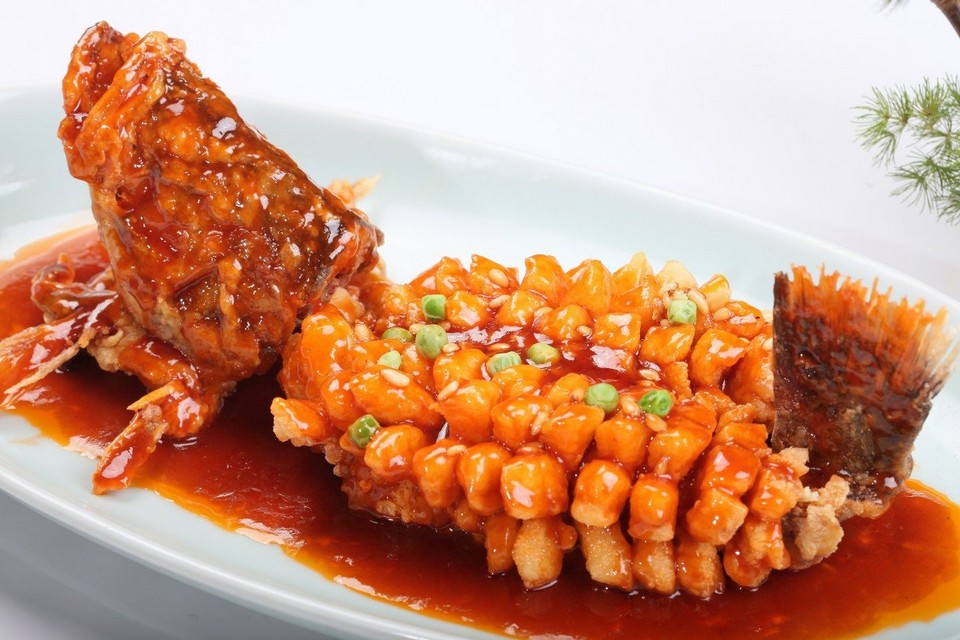
Stewed goat
In addition to the popular dishes, my Chinese friend also introduced to me the stewed goat dish. This dish is served in a large bowl and will be served with naan bread.
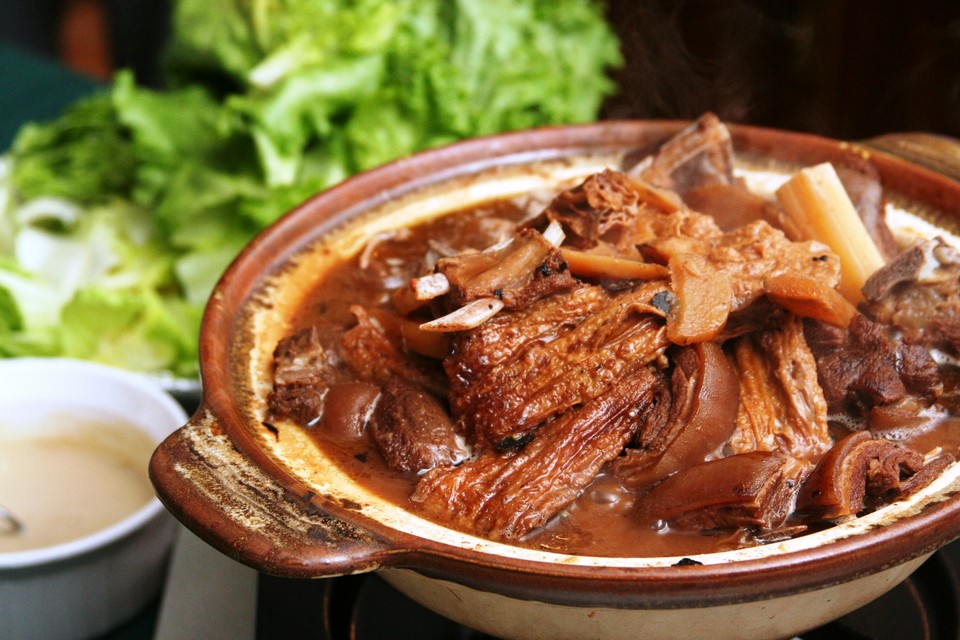
Wansan Braised Pig’s Trotters
The dish sold with some other parts of the pig which are stewed according to a secret recipe, but for tastier, it is still pig trotters. Enjoying the fatty skin with the sweet and tender meat inside is hard to describe the flavor of this dish. A must-try food in Suzhou.
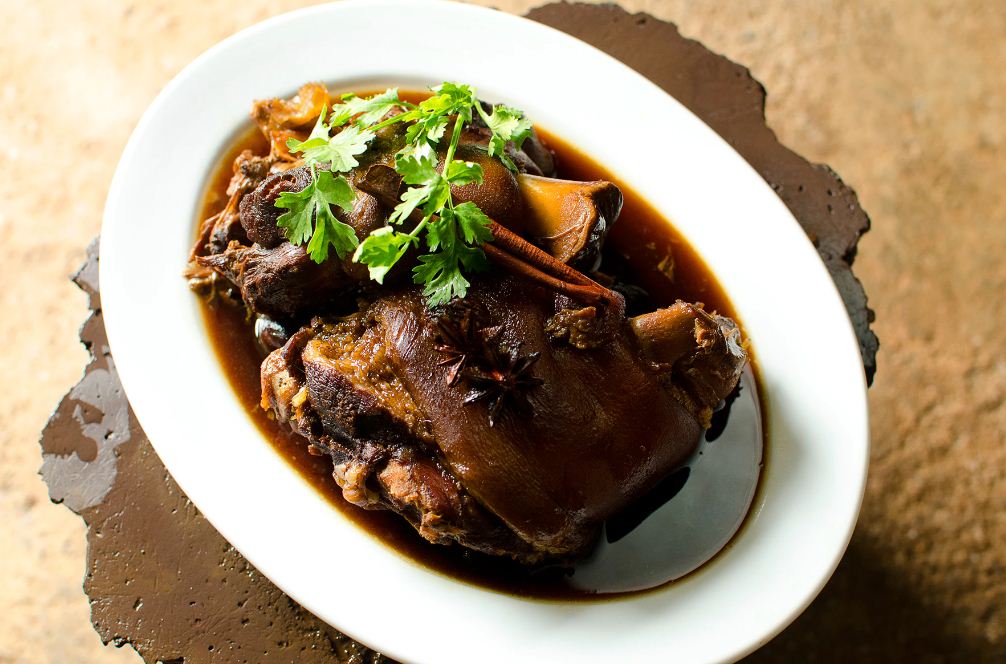
In addition, there is a very special noodle called The Red Soup Noodle which made in a Suzhou style is also very popular.

Suzhou Pork Mooncake
Suzhou is famous for its unique pork moon cake specialty. It has a thin shell, the cake is sweet and fatty, so you shoul only eat about 1-2 cakes is enough to avoid getting greasy.
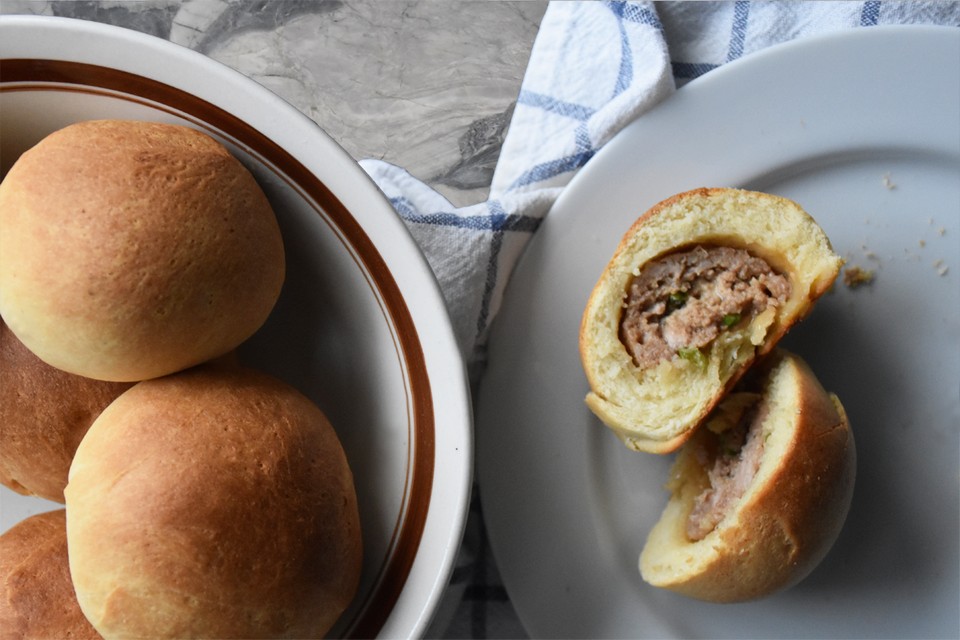
There are also many more snacks, desserts and other specialties such as: Chinese pizza, Dumplings, The Red Date Paste Cake, Red Bean Glutinous Rice Ball, Sugar Porridge, The Fermented Rice Cake, The Suzhou Small Wontons… You can find them in Shantang Street and street food vendors.
Suzhou blog: Suggested Suzhou itinerary for 2 days
How to spend 2 days in Suzhou? Here is my suggested Suzhou 2-day itinerary for you refer to.
8:30AM – 11AM: Traveling from Shanghai to Suzhou 11:30: Lunch 12PM – 1PM: Suzhou Silk Museum 1PM – 2:30PM: Humble Administrator’s Garden 3PM: Back to the hotel to rest 6:30PM – 7:30: Dinner 8PM – 9PM: Oriental Arc Building
10AM: Check out hotel 10:30AM – 11:30AM: Lunch 12PM – 1PM: Lion Grove Garden 2PM – 4PM: Shantang Walking Street 4:30PM: Going back to Shanghai
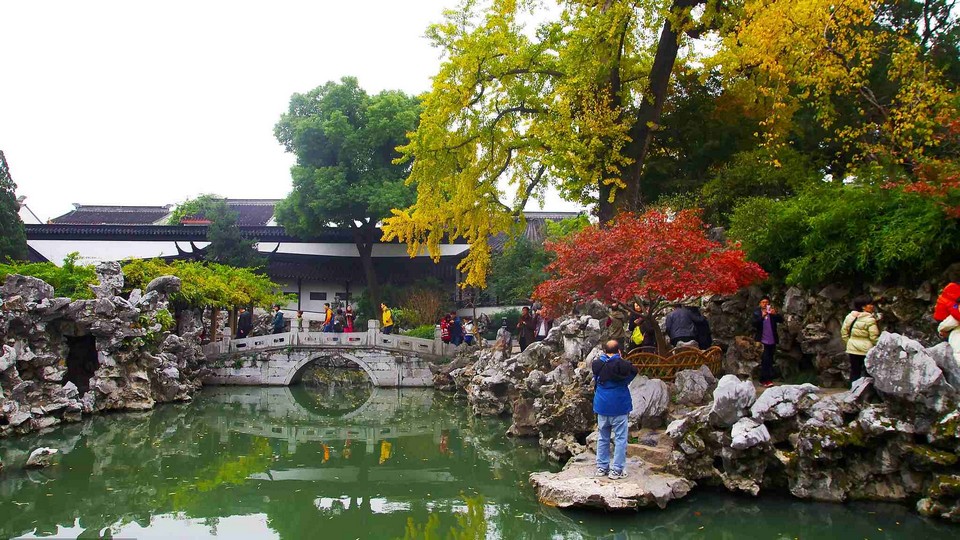
Suzhou travel blog: The trip cost
In general, the cost of traveling to Suzhou is quite affordable, including going back during the day or staying 1 night like us.
In the cost listing below, I did not list the traveling cost from Shanghai to Suzhou and vice versa, because I travel by my friend’s private car.
- Traveling: Taxi for 20 yuan
- Accommodation: 1 night for 156 yuan
- Admissions: Humble Administrator’s Garden ticket for 90 yuan (Buy at the ticket counter or buy in advance here ) / Lion Forest Garden ticket for 40 yuan (Buy at the ticket counter or buy in advance here )
- Food and drink: Cost for 2 days: 150 yuan
TOTAL: CNY456 ~ $70.89
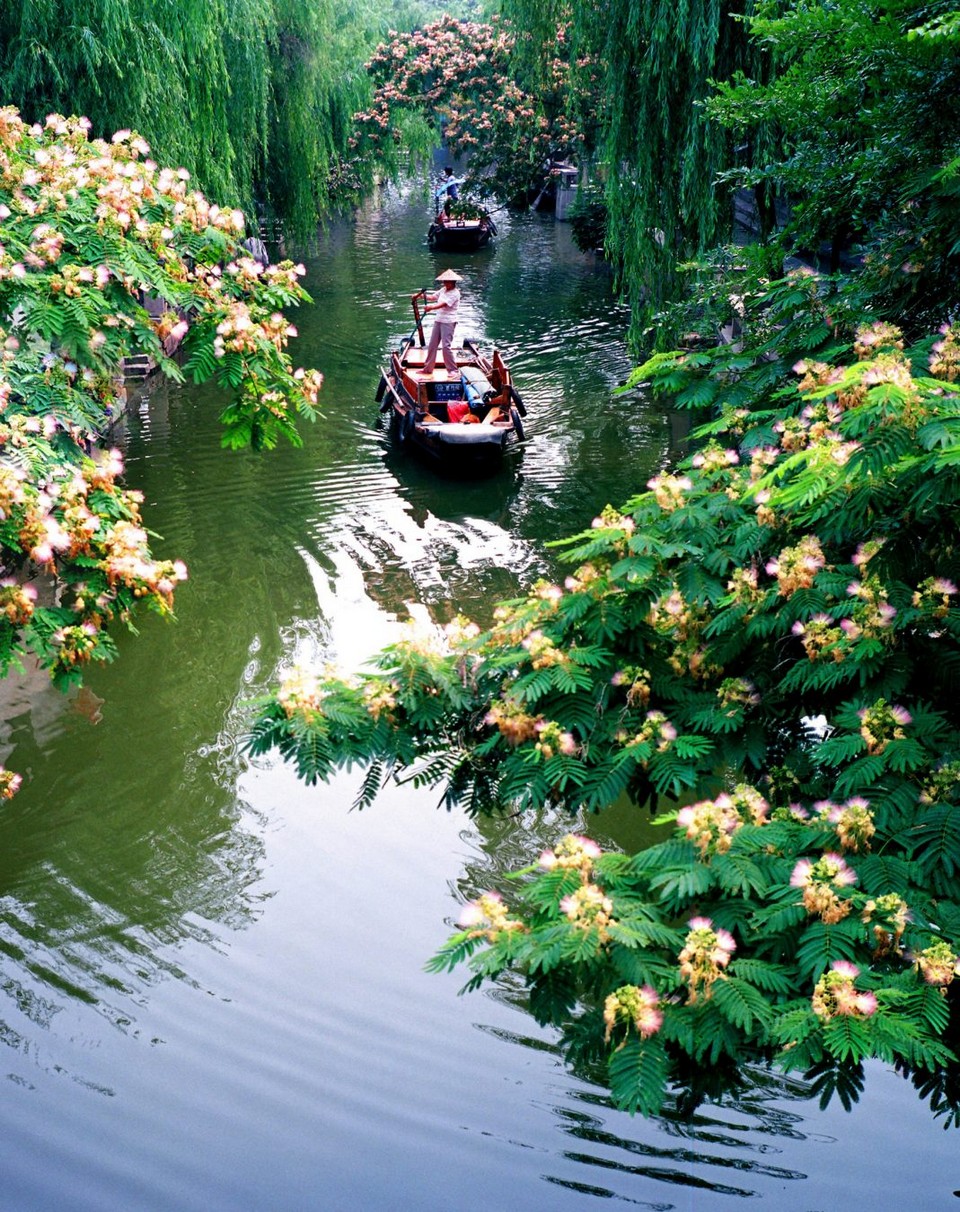
Suzhou blog: Before you go
- Download and install in advance the necessary applications to support your China travel such as: Baidu Maps, Dianping, Didi, WeChat, Alipay, Google Translate (offline version, becaue Google has been blocked in China) …
- Very few Chinese people can speak English, if you do not know Chinese, you can use Google Translate or learn some common Chinese words or sentences.
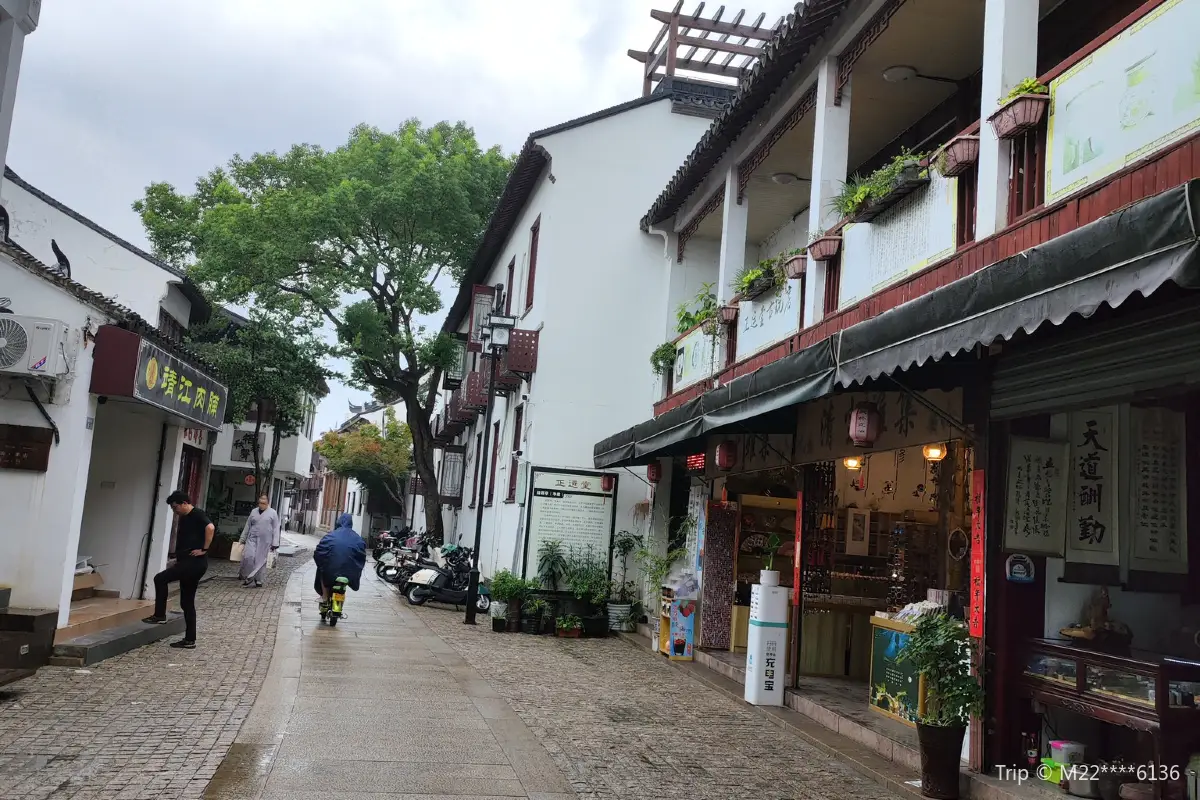
Suzhou China travel guide: Some best day tours, trips, activities and transfer services, tickets in, from and to Suzhou you can refer to
- Tongli Ancient Town Ticket in Suzhou (For Mainland China ID Holders)
- Tongli Water Town Admission Ticket in Suzhou
- Tianping Mountain Ticket in Suzhou
- Master of Nets Garden Admission Ticket in Suzhou
- Suzhou & Zhouzhuang Water Village
- Suzhou Highlights Half Day Biking Tour
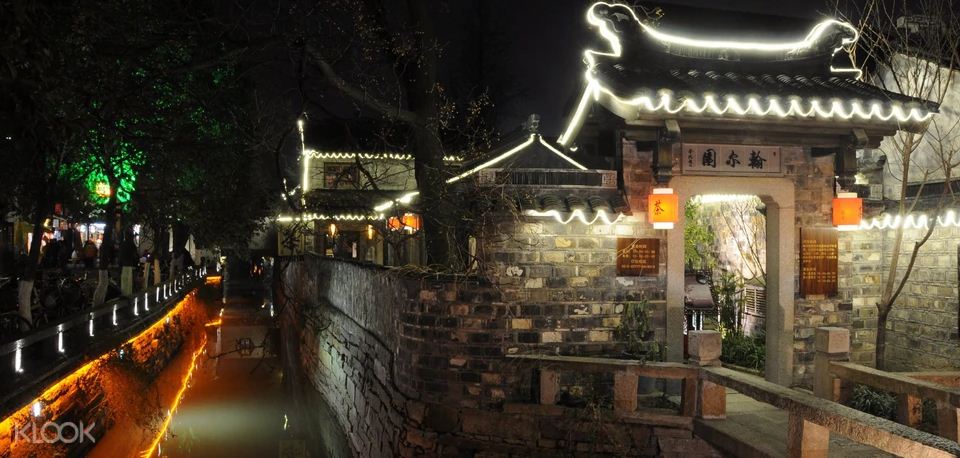
Are you looking for more top things to do in Suzhou: Tours, activities, attractions and other things? Let’s check it out here . And China here .
Related articles

RELATED ARTICLES MORE FROM AUTHOR
Must eat in melaka — 10+ famous malacca street food & must try food in melaka, what to do in alishan — 5 top attractions & best things to do in alishan, taiwan, hong kong food culture — hong kong cuisine tells the historical story of the whole land.
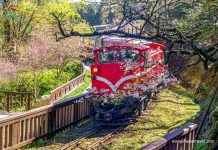
Alishan travel blog — The fullest Alishan travel guide for first-timers
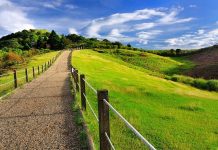
Gingtiangang Grassland Yangmingshan — The ultimate guide on how to go & top things to do
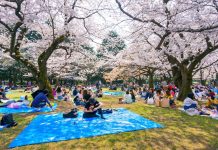
Tokyo best parks — 10+ best & most beautiful parks in tokyo
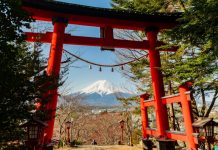
Yamanashi blog — The Yamanashi travel guide & top things to do in Yamanashi
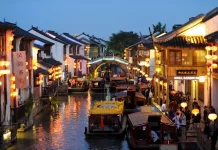
EDITOR PICKS

Must eat in Melaka — 10+ famous Malacca street food &...

What to do in Alishan? — 5 top attractions & best...

Hong Kong Soya sauce Chicken Rice and Noodles — The first...
Popular posts.

What to buy in USA? — 17+ must buy in USA...

Must buy souvenir in Taiwan — Top 17+ most famous, cheap...

Must buy in Korea — Top 23 cheap, famous & best...
Popular category.
- Inspiration + Guide 1452
- Trip Inspiration 469
- Thailand 209
- Food + Drink 206
- Coasts + Islands 193
- South Korea 168
- Vietnam 166
- Travel Photos 144
- Work for Us
- Terms & Conditions
- Privacy Policy

26 Things to do in Suzhou China – All You Need to Know Before you Go
Written By: The Planet D
Updated On: April 3, 2023
Suzhou, China is a memorable place to visit. Many tourists only pop in for a day trip from Shanghai to view its classical Chinese gardens, but we suggest spending several days to really explore this exquisite city in the Jingshao proving.
Table of Contents
Best Things to do in Suzhou China
Known as the Venice of the East, we barely scratched the surface of all the things to do in Suzhou.
If you have the time, it is a place to relax in the gardens, take in the energy and excitement of the nightlife and get lost in the back canals in one of the most livable cities in all of China.
1. Shantang Street

Shantang Street is Suzhou’s famous street that is an ancient pedestrian path dating back 1200 years. It lines either side of the canal in Suzhou’s old city.
Stretches from Shantaing River to Tiger Hill.
It is 7 traditional Chinese miles long (2.38 miles) and filled with shops and eateries where tourists can take in the liveliness of the city.
There are two sections to the street. The tourist section has more boutique-style shops and western restaurants like Dairy Queen and Starbucks, while the other half has more traditional Chinese shops where locals go about their daily business.
- Looking for more Asia travel inspiration? Check out this complete 7 Day Itinerary for Taiwan.
2. Squirrel Mandarin Fish
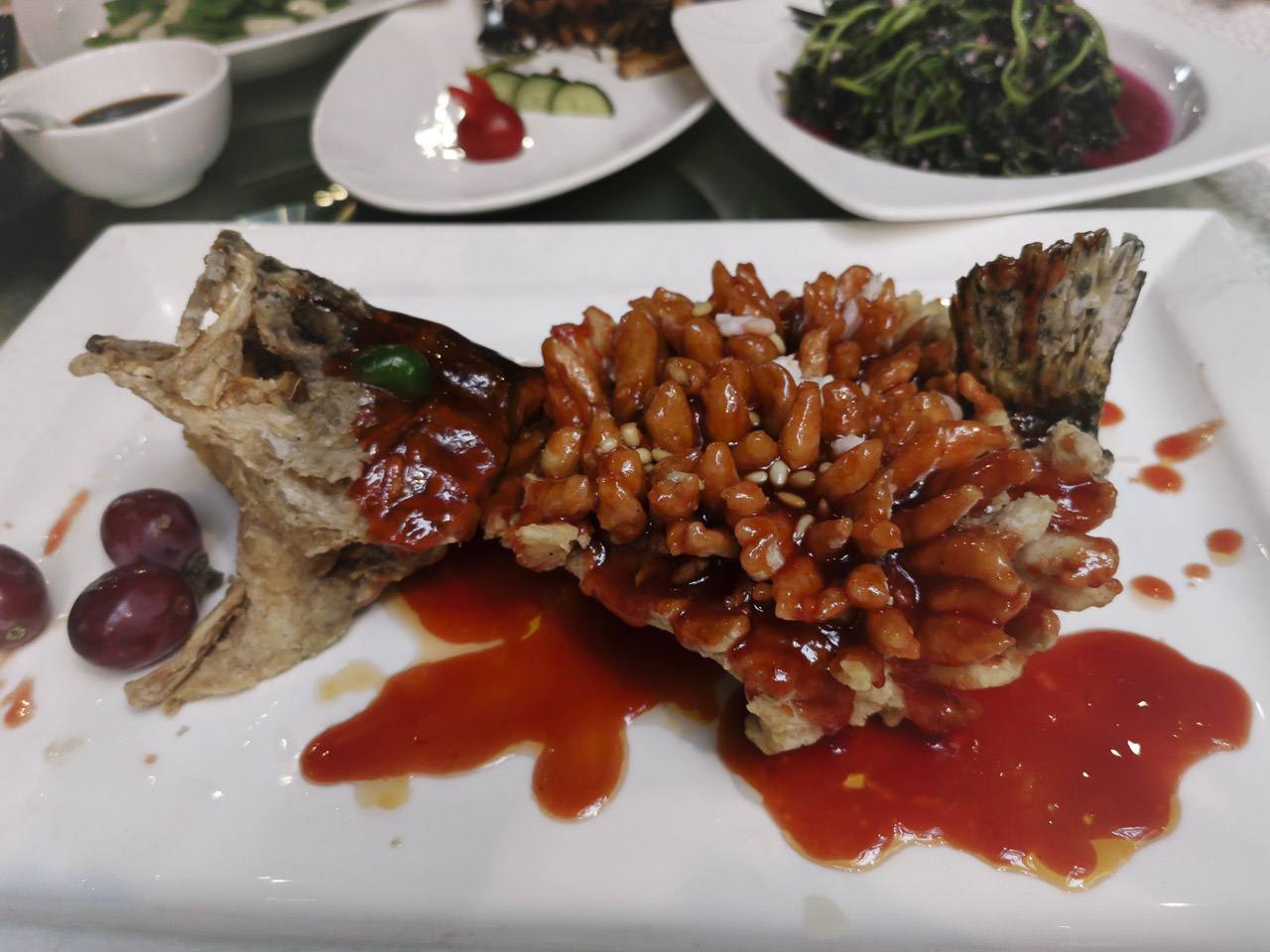
It was here on Shantang Street that we sampled Suzhou’s famous fish dish, Squirrel Mandarin Fish.
Song He Lou has been serving traditional food for more than 250 years.
We ate a feast of fresh family-style Chines food such as the Suzhou sweet and sour mandarin fish, stir-fried shrimp and vegetables.
3. Canal Tour
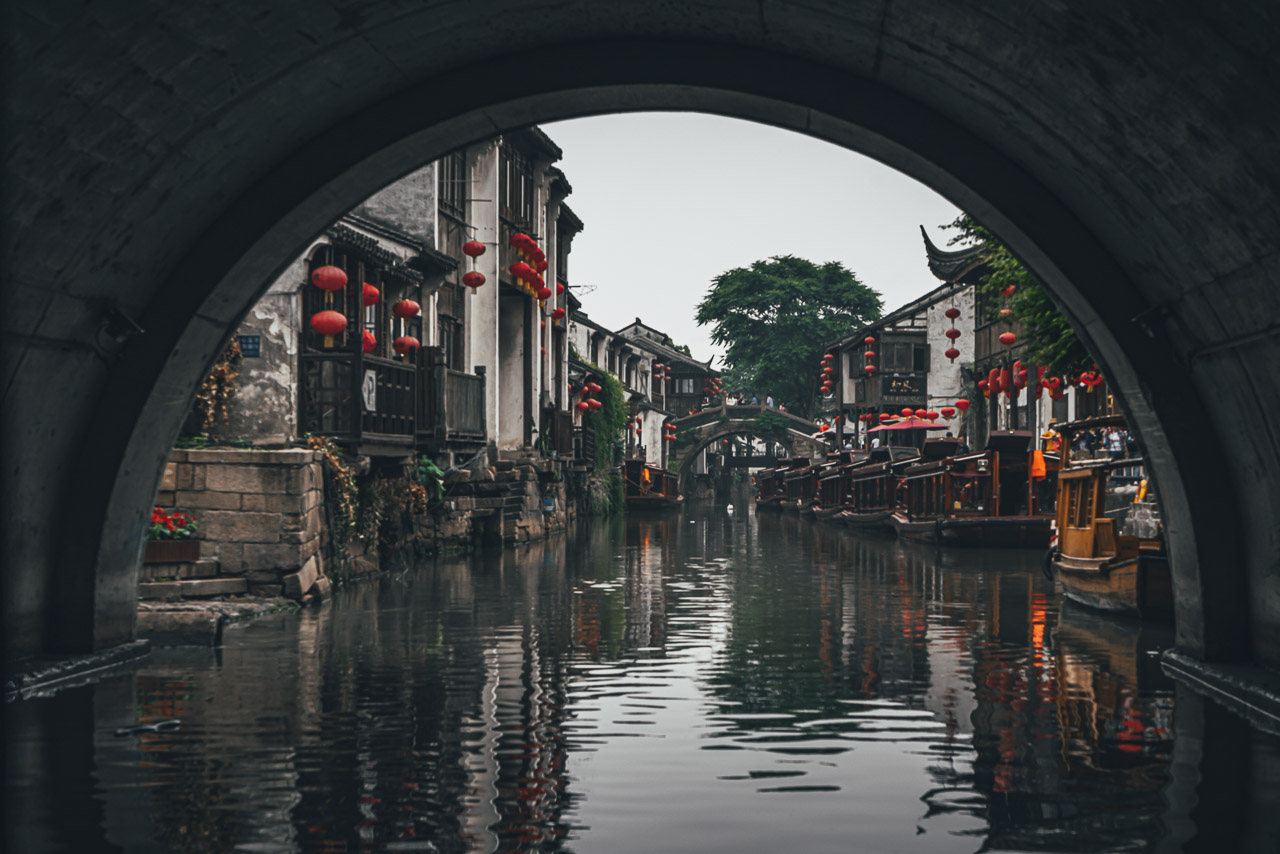
Be sure to take a boat tour along the Canal to sneak a peek at traditional life.
It may be prime real estate on the canal , but buildings here cannot be renovated.
They are tiny old homes that must be left as they were, so instead of rich Chinese renovating houses for a weekend retreat, they are left as they always were with basic amenities.
Locals live off the river, some without proper kitchen, bathrooms or laundry facilities.
4. Shantang street at night
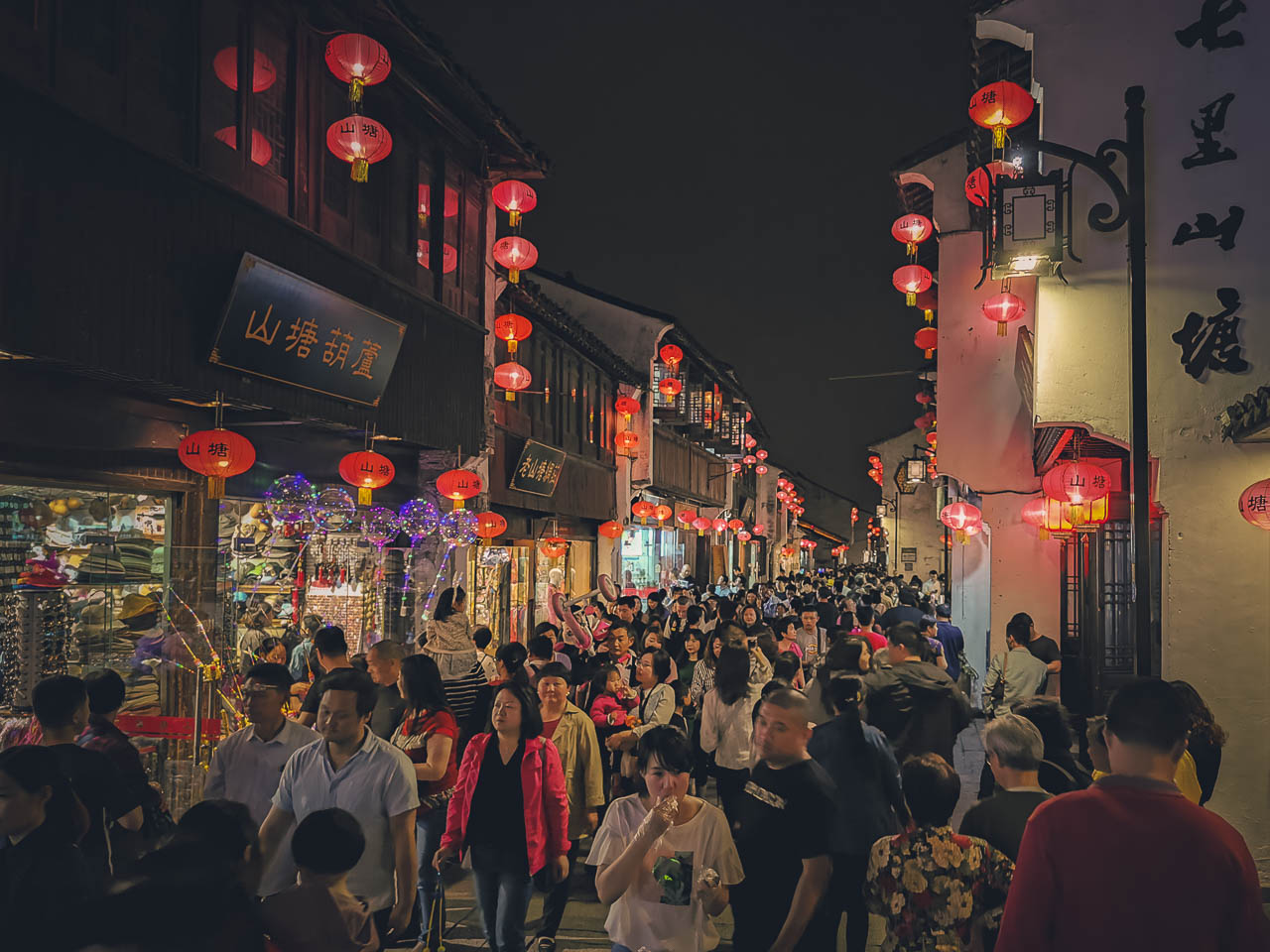
Shantang Street is a completely different vibe at night and the crowds come out in droves to soak in the energetic atmosphere.
We quickly made our way through the narrow street along the canal to the Chaozong Pavilion where traditional Suzhou collides with the modern city.
5. Chaozong Pavilion
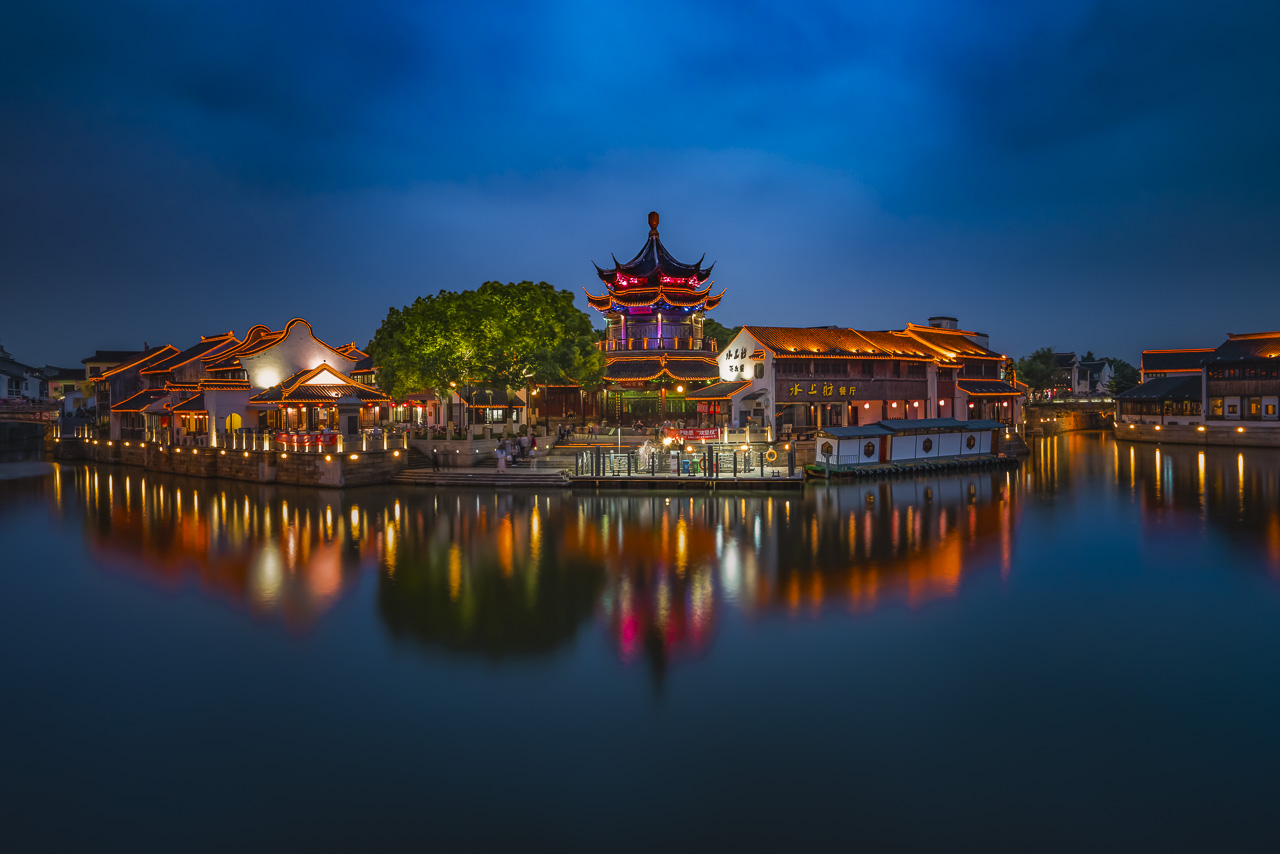
On one side of the canal is the picturesque pagoda and on the other is a mass of motorcycles lining the sidewalks gathering in the massive square filled with fast food, shopping centers, and restaurants.
We were welcomed by the crowd who seemed more impressed with us being there than we were of the scene before our eyes.
6. Rickshaw Ride
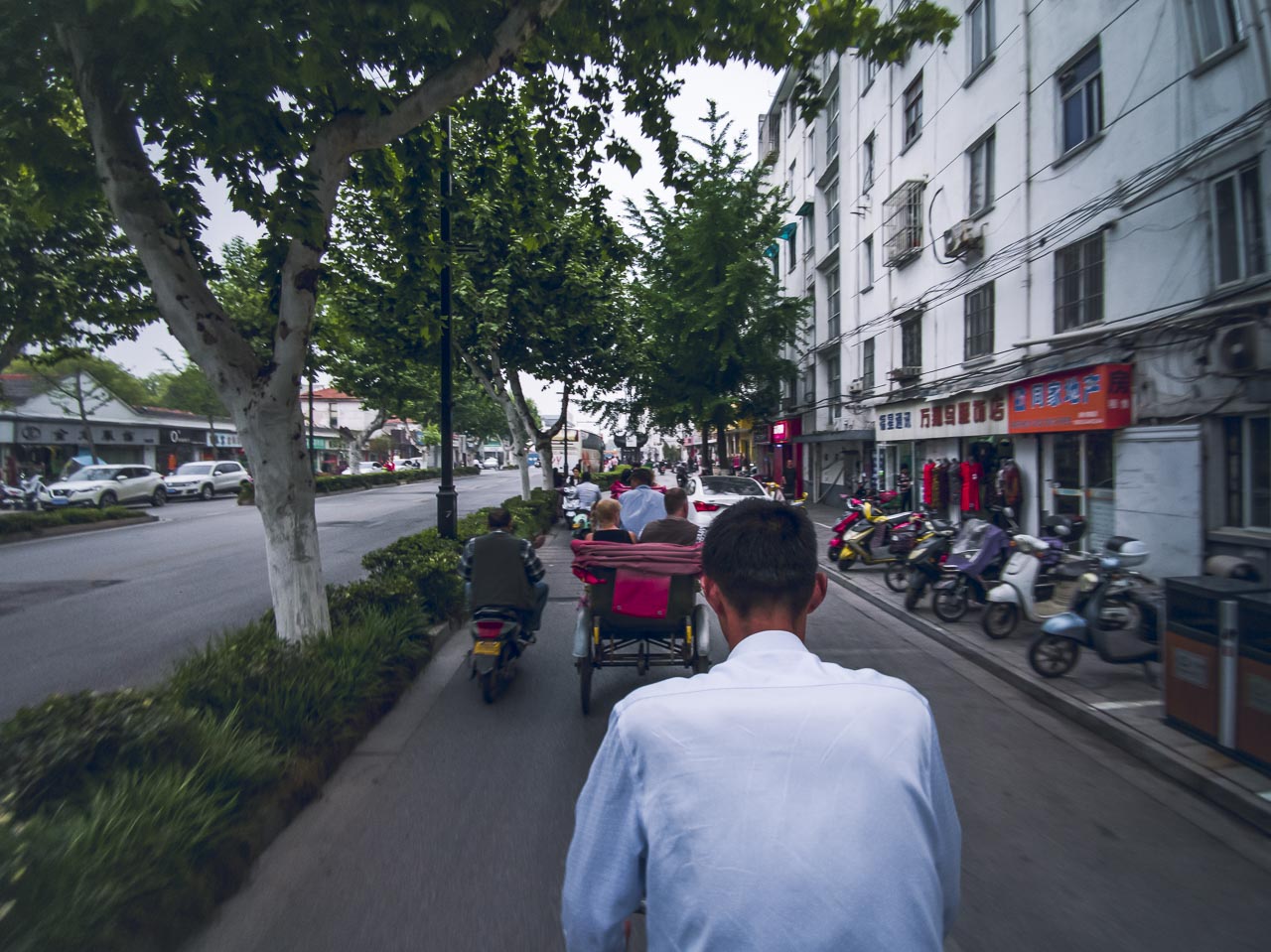
Whenever we visit China, we must take a rickshaw ride. When visiting Suzhou, the rickshaw’s took us through the quiet back streets and pathways lining the canals.
We stopped at a traditional Chinese market to view produce and some very interesting dining choices.
It is not for the faint of heart as live frogs and turtles sit in mesh plastic awaiting their fate.
But as we always say, “ At least in Asia, they know where their food is coming from, unlike the west where we pack our meat neatly in styrofoam and plastic wrap pretending that it never lived in the first place.”
The tour ended at dusk at another famous street of Suzhou, Pingjiang Road.
7. Pingjiang Road
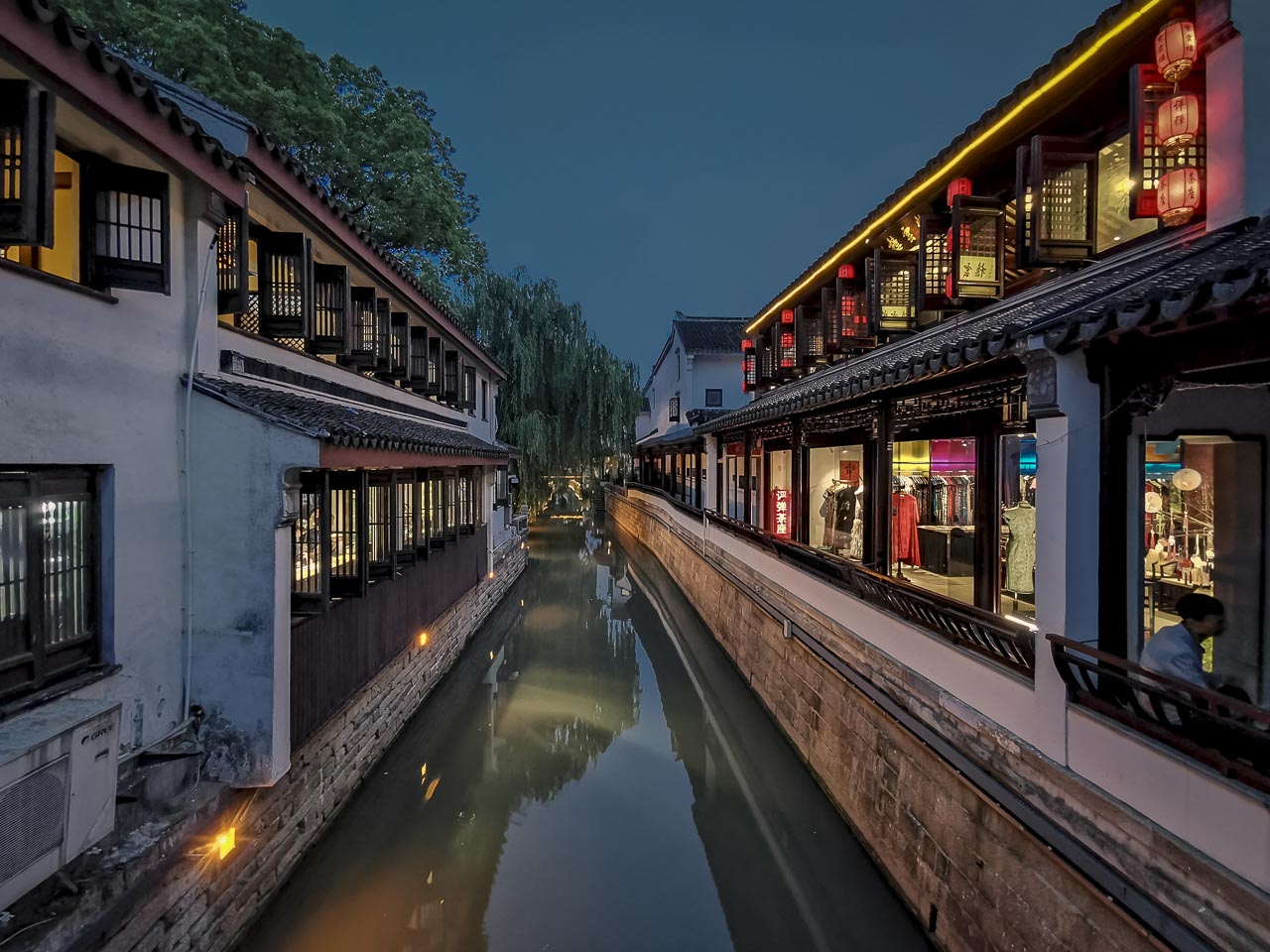
Similar to Shantang Street, Pingjang Road is a pedestrian street spanning along the canal
It is filled with street vendors, cafes, souvenir shops and plenty of crowds.
There are photo opportunities along the canal as the street lights up for the night.
I love China at night . The cities were truly designed for the dark with lanterns and neon lights decorating the night sky.
8. Chinese Kun Opera
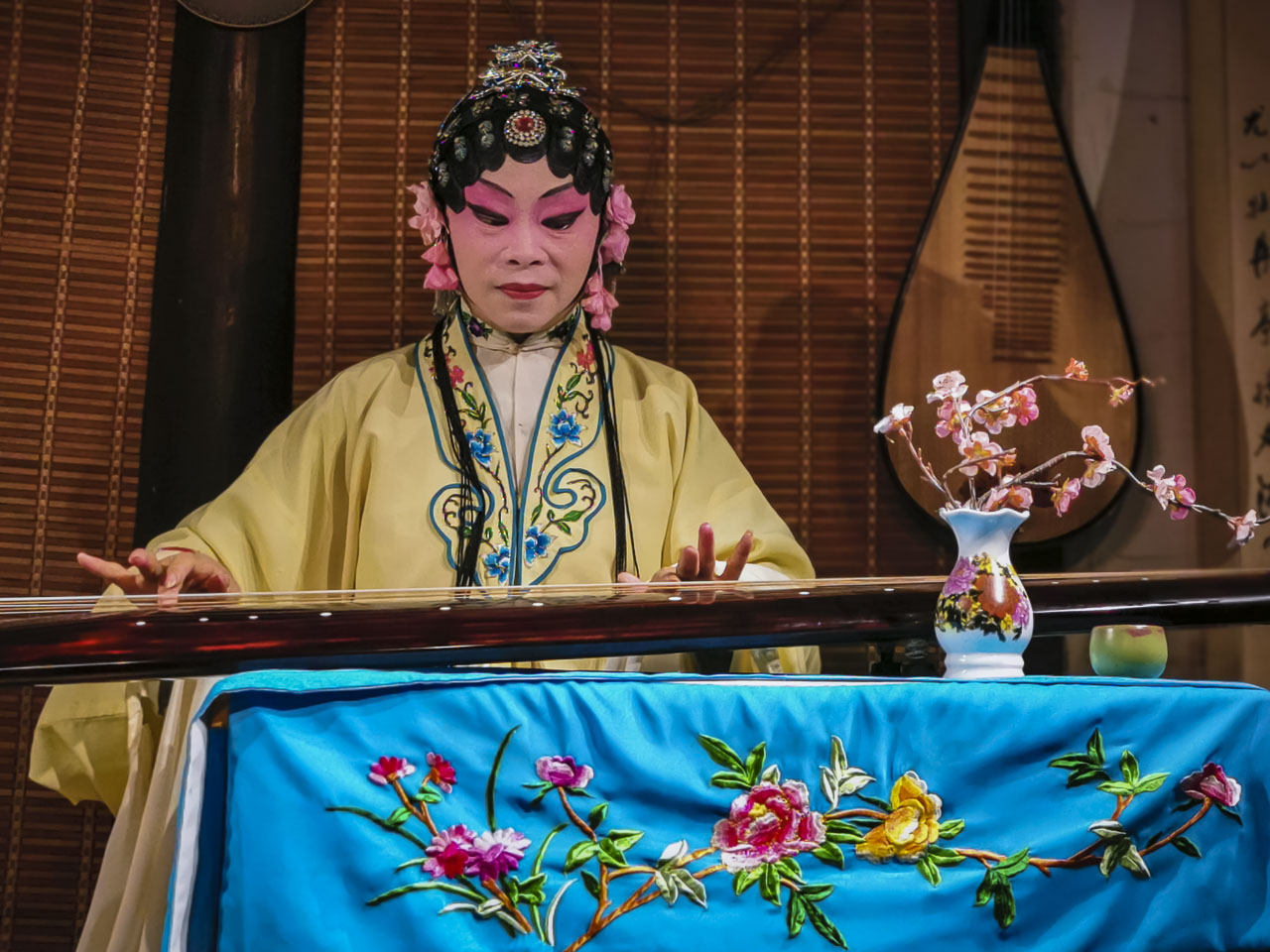
I don’t know if I would recommend seeing an entire Chinese opera, but going to a small house in Pingjian Road to watch an opera performer apply her makeup followed by a show, is a must!
The Fuxi Tea House on Pingjiang Road gives visitors the unique experience of witnessing the transformation before their eyes.
We sat down in a dim restaurant to watch an artist pull her face to extreme limits while painting her face to look like a painting.
She told us how the makeup was applied and how usually opera performers have people help them and it can take up to an hour and a half to finish the work.
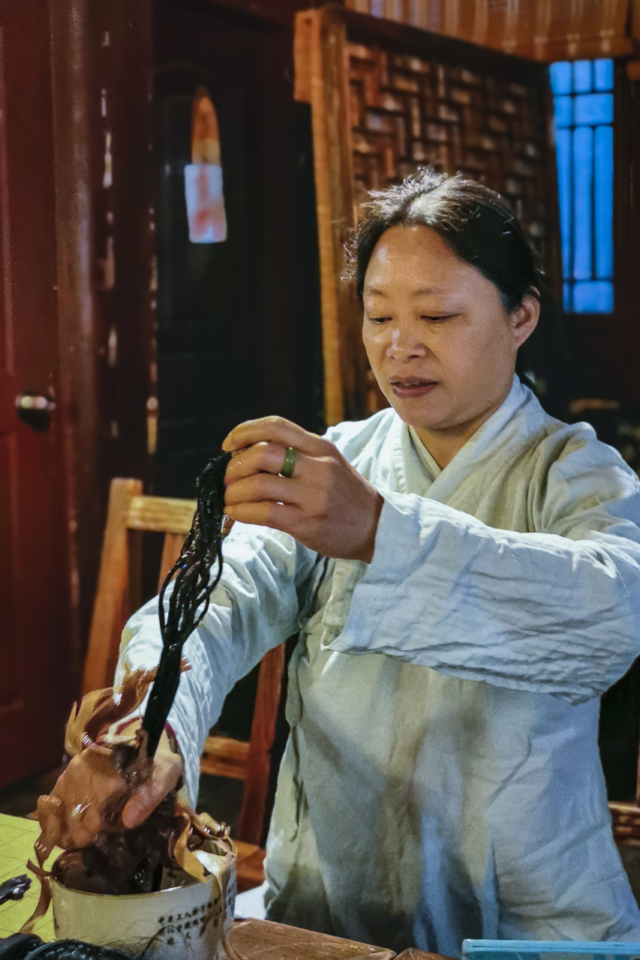
She has mastered her craft and managed to finished her transformation in 30 minutes!
Her face was pulled so tight that she said (through our translator) that many new performers pass out from the pain.
After she finished, she put on a show for a packed hall and although we couldn’t understand a word she was saying, we felt the fun and delight the crowd was having. (we assume at our expense as the only foreigners in the building:)
9. Humble Administrator’s Garden
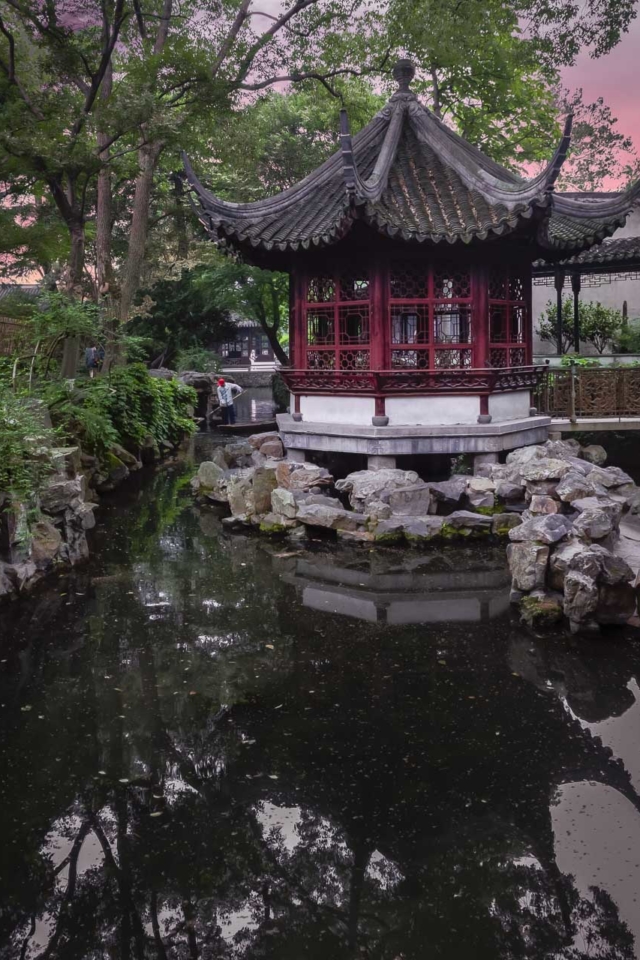
Suzhou has 69 classical Chinese gardens and nine of the greatest are together they are designated a UNESCO World Heritage Site.
The Humble Administrator’s Garden is the most famous of all the gardens. Dating back 500 years, it is one of the four famous gardens of China.
Unlike the Summer Palace or Forbidden City Garden’s of Beijing that were imperial gardens used by royalty, the Humble Administrator’s Garden was owned by a private family.
This garden truly shows the wealth and prosperity of China’s elite.
Since it is so popular, it gets very busy very quickly. We arrived first thing in the morning and beat the crowds, but by 9:00 am, it was swarming with people.
10. Lion Grove Gardens
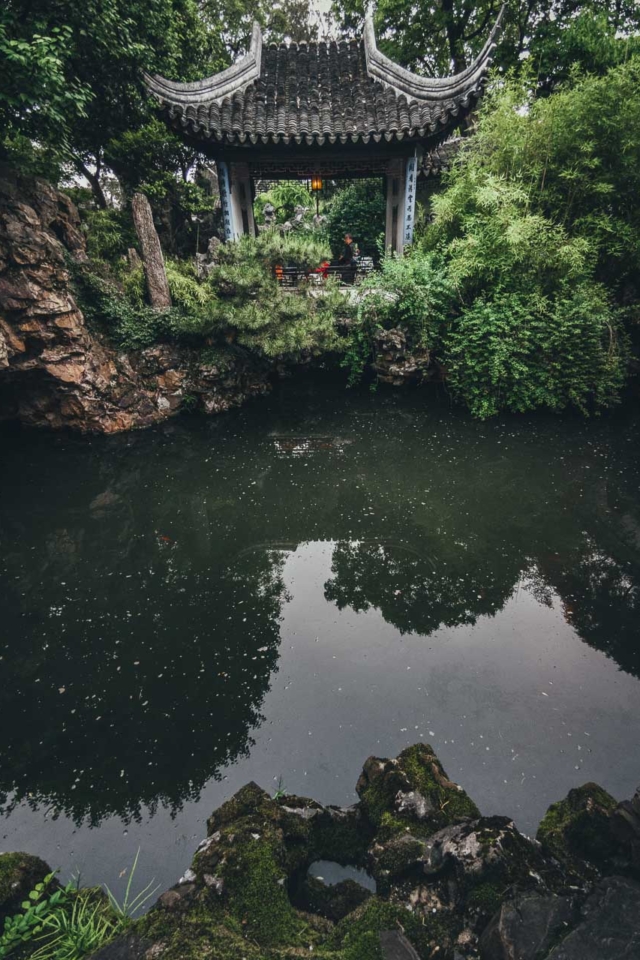
Not too far away was the smaller yet in my opinion more impressive Lion Grove Gardens.
Built-in 1342 during the Yuan Dynasty, Lion Grove Gardens was named after the rocks that resembled that of a lion.
What sets this garden apart is the multilevel rock formations known as rockeries that weave through waterways creating pathways up, over and through decorative rocks made of limestone from Taihu Lake.
We got lost in a maze of rocks designed to create a relaxing atmosphere of serenity and contemplation.
Today the crowds take away from the serenity, but they cannot detract from the beauty of the gardens. It is truly a work of art.
11. Panmen Scenic Area
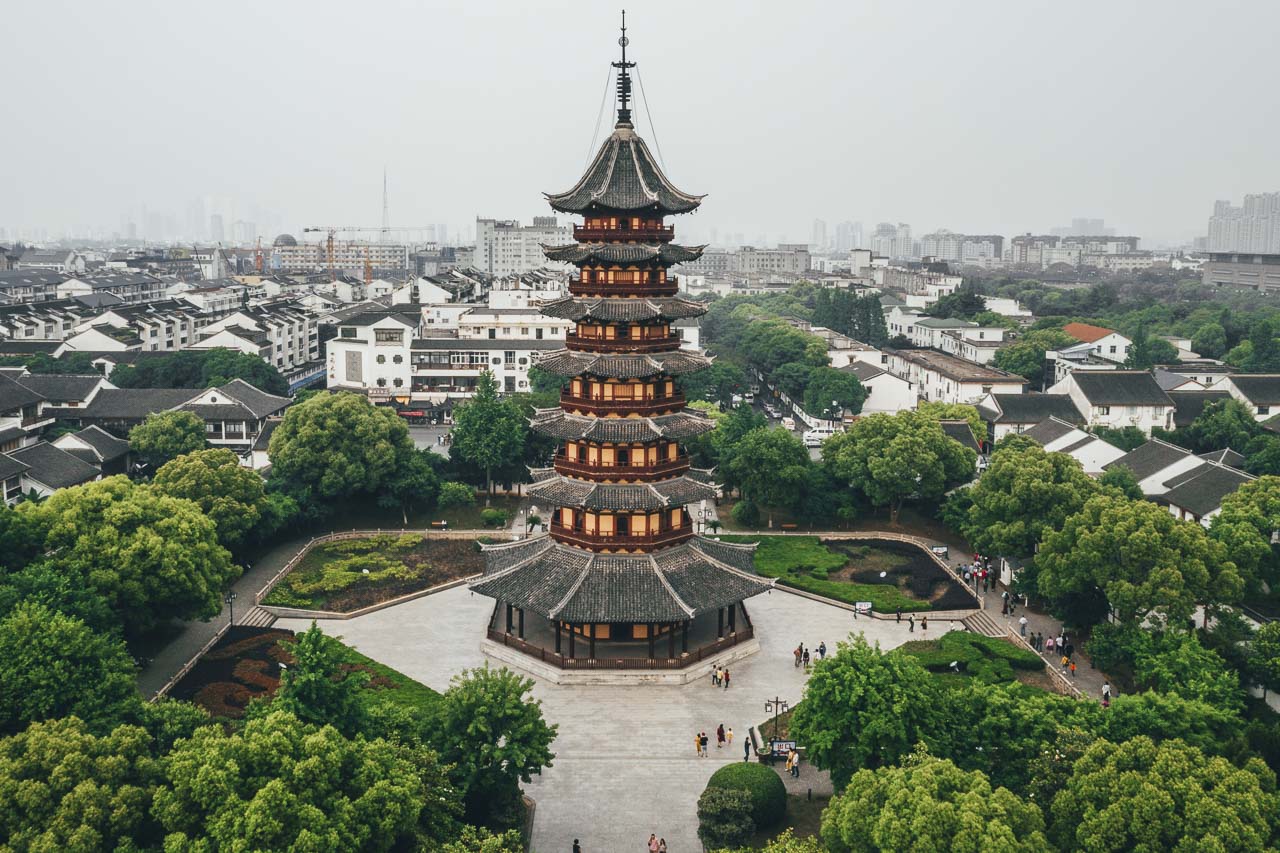
Another garden that we enjoyed visiting was the Panman Gardens. Connected to our hotel accommodations, the Pan Pacific Hotel, it gave us the opportunity to stroll the grounds without crowds during the off hours.
It is a large area housing pagoda’s, lakes, gardens, and bridges. The garden leads out to the incredible Grand Canal.
12. Panmen City Gate
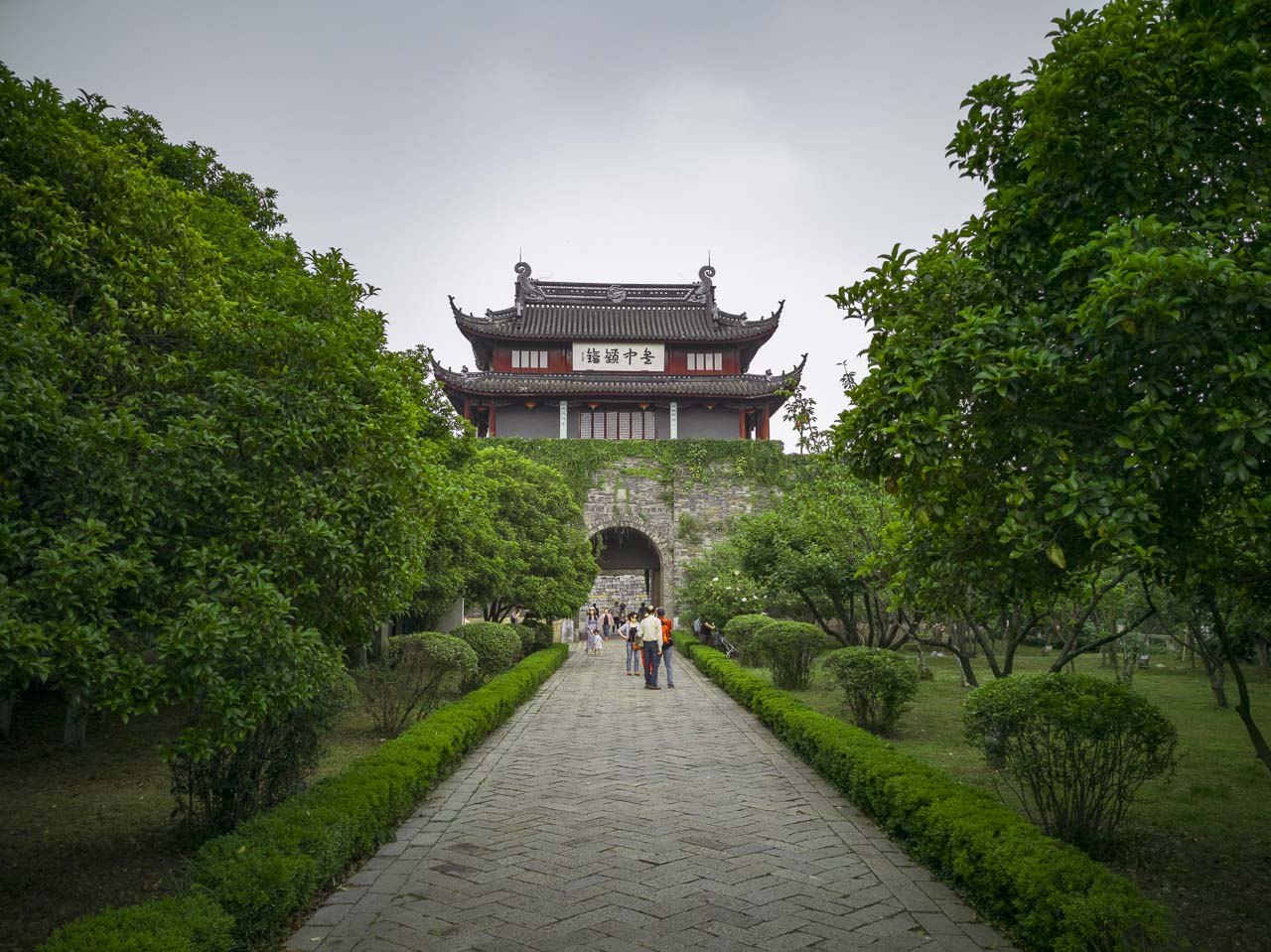
The Panman Gate is located here on the Grand Canal and visitors can enter here crossing through the historic structure dating back 2500 years.
It has the distinction of being the only preserved water and land city gate in the world.
Attached to the Old City Wall, it is possible to walk along the 300 metres (328 yards) that are still intact standing 5 metres (16 foot) high offering panoramic views.
13. Boat Trip on Grand Canal
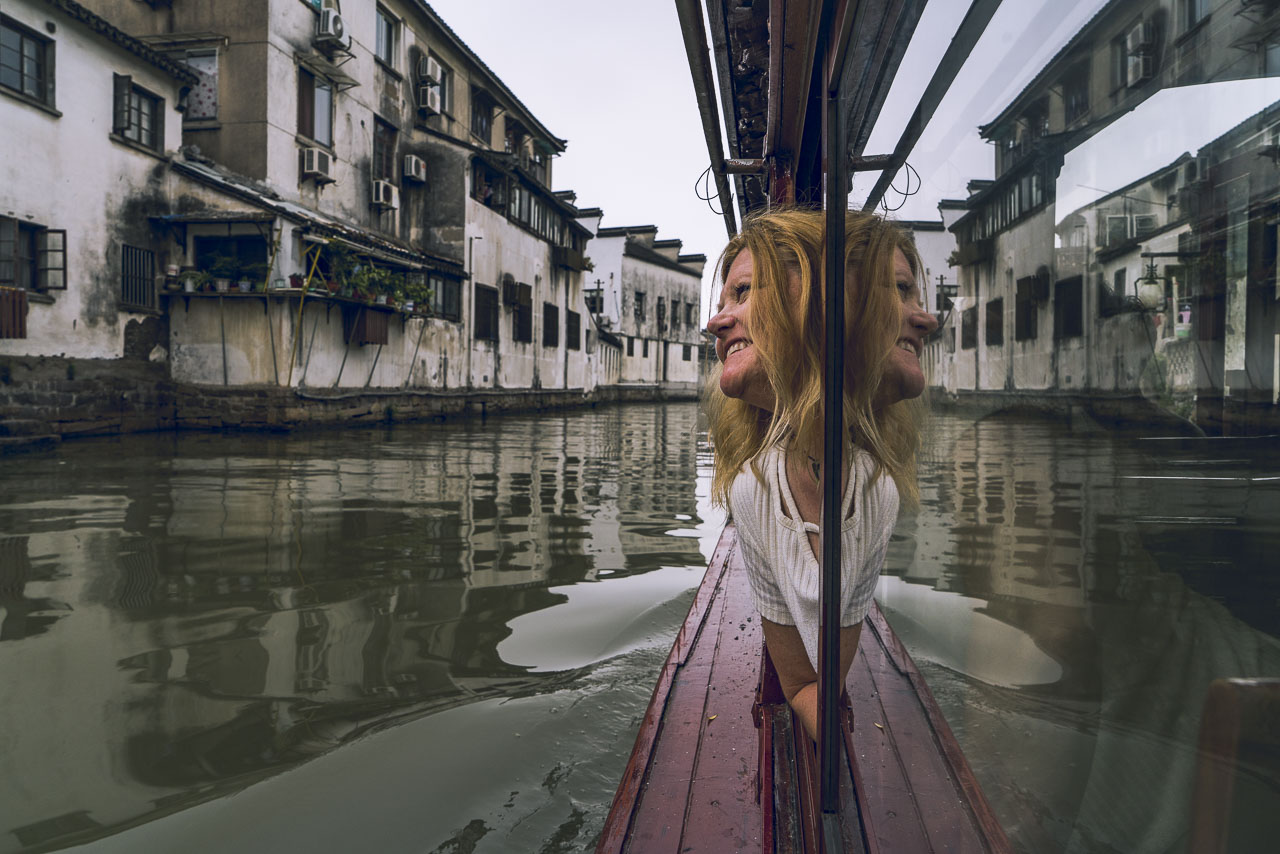
We took a walk through the Panmen Gardens to the Grand Canal where we hopped aboard a canal tour to take in the sights along the water.
The Grand Canal is a must stop as it is part of the longest and oldest man-made waterway in the world.
Known as the Golden Waterway, Construction began on the Grand Canal in 770 BC. It spans an astounding 1776 km from Beijing to Hangzhou
14. Pan Pacific Hotel
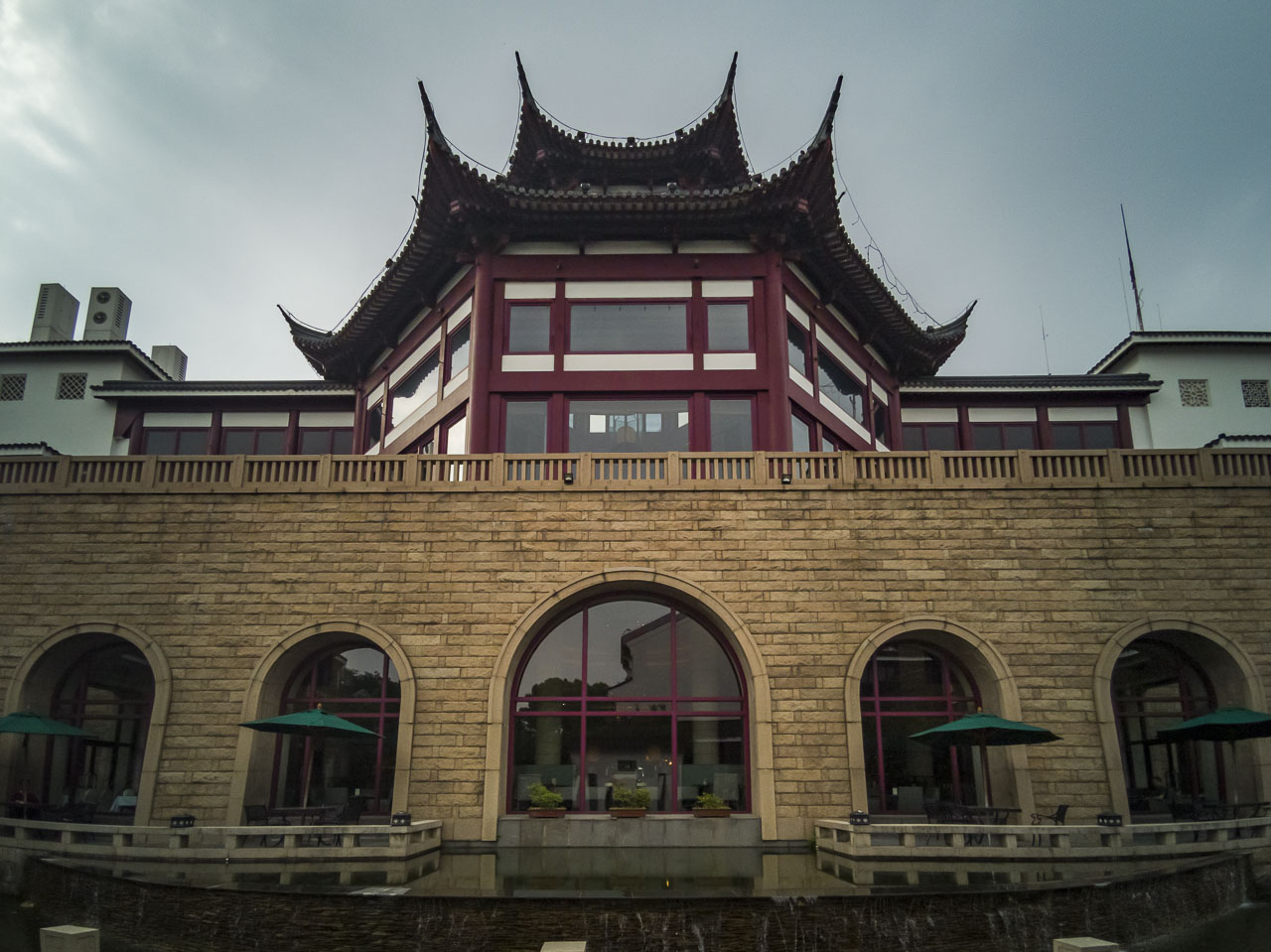
While we are here, we must talk about our accommodation, the Suzhou Pan Pacific Hotel.
This is a destination unto itself. Connected to the Panmen Gardens, The Pan Pacific feels as if you are staying in a traditional Chinese Palace. Modeled after the Forbidden City, it looks like a temple that boasts impressive gardens of its own.
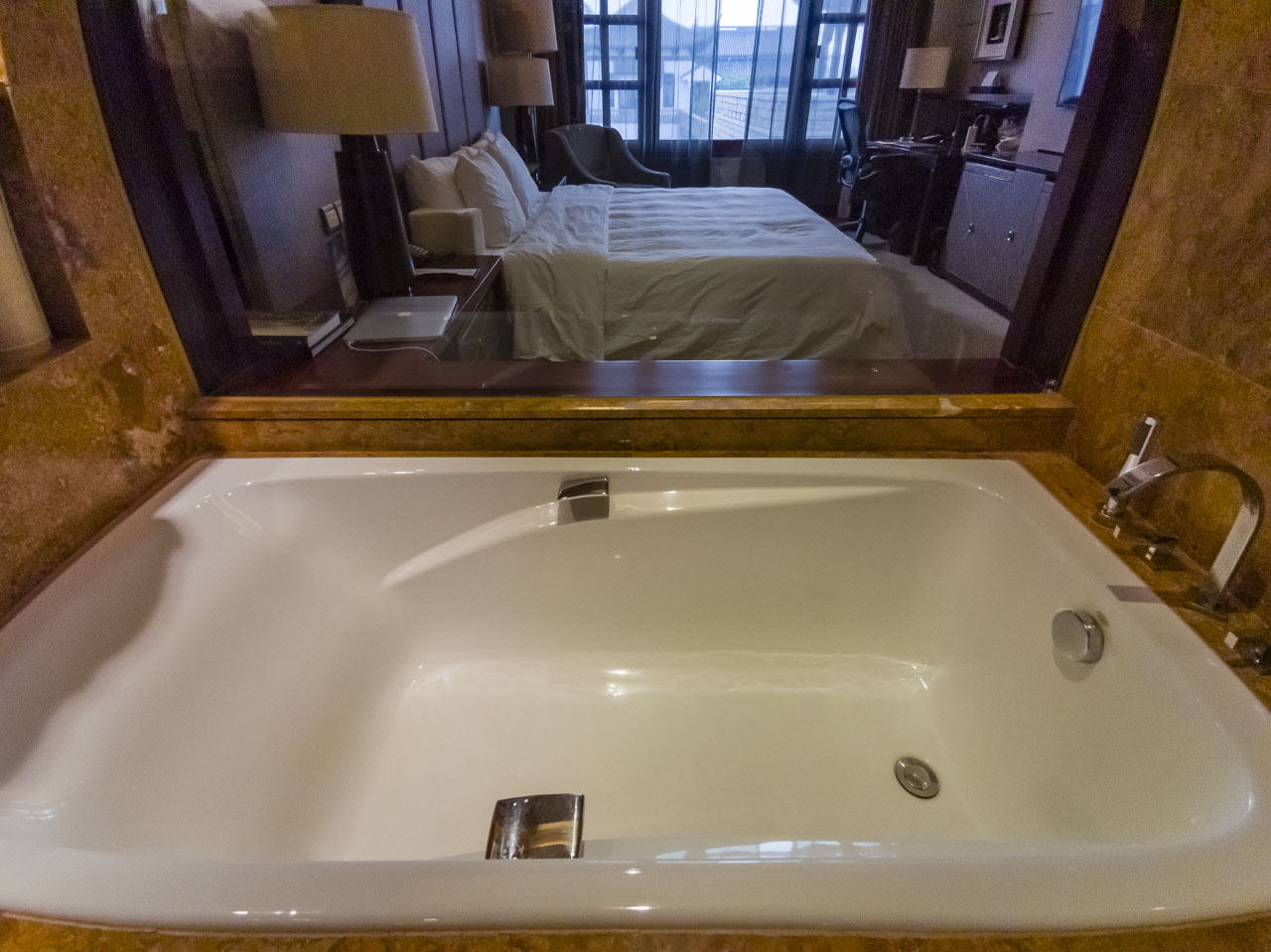
We stayed in the new wing of the building and if you find yourself in the unrenovated side (like we did at first) be sure to ask to change.
The difference between the two sections is like night and day. So ask for the Executive Premier Rooms in the Garden and Pagoda wings.
The Pan Pacific has a lovely in and outdoor swimming pool, fitness centre, spa, and three dining rooms.
Check prices and availability at TripAdvisor
15. W Hotel for Water Light Show
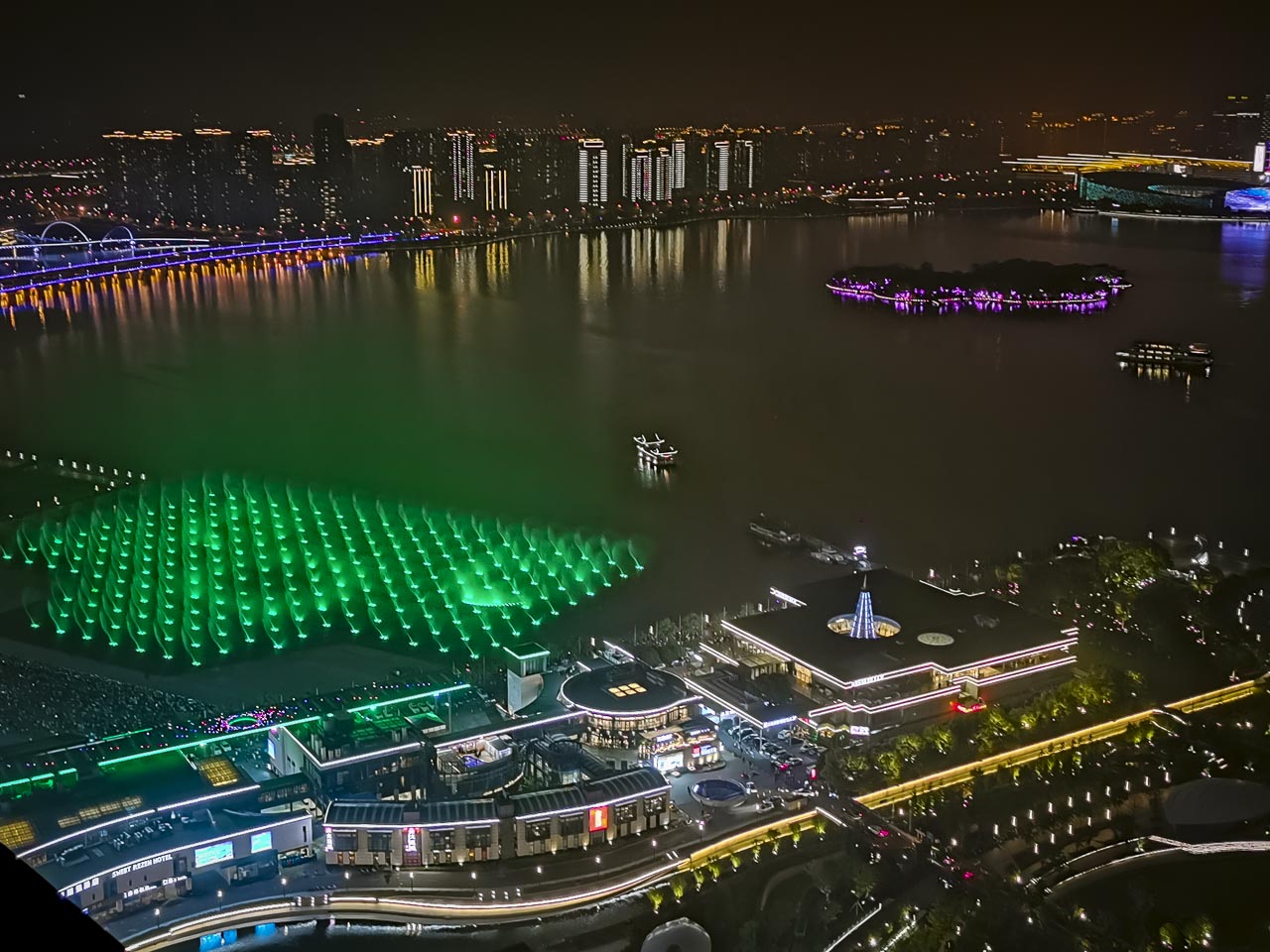
Like most cities in China, Suzhou has a fantastic modern skyline and going to see it at night is a must.
China really comes alive when the sun goes down and on Friday and Saturday nights (days vary by season) it puts on a light and fountain show similar to the Bellagio in Vegas and the Dubai Fountain Show at the Burj Khalifa Lake.
We went to the top of the W Hotel where it is apparently, it is the best view. If you really want to see the show, I suggest getting to the waterfront early and watching it from below, but this was a good consolation.
The view of the show itself was a bit obstructed so we had to maneuver our way around hanging cameras over the edge, but it was worth it.
The atmosphere on the W rooftop is elegant and the views of the city and lake are gorgeous.
16. Walk Along the Waterfront
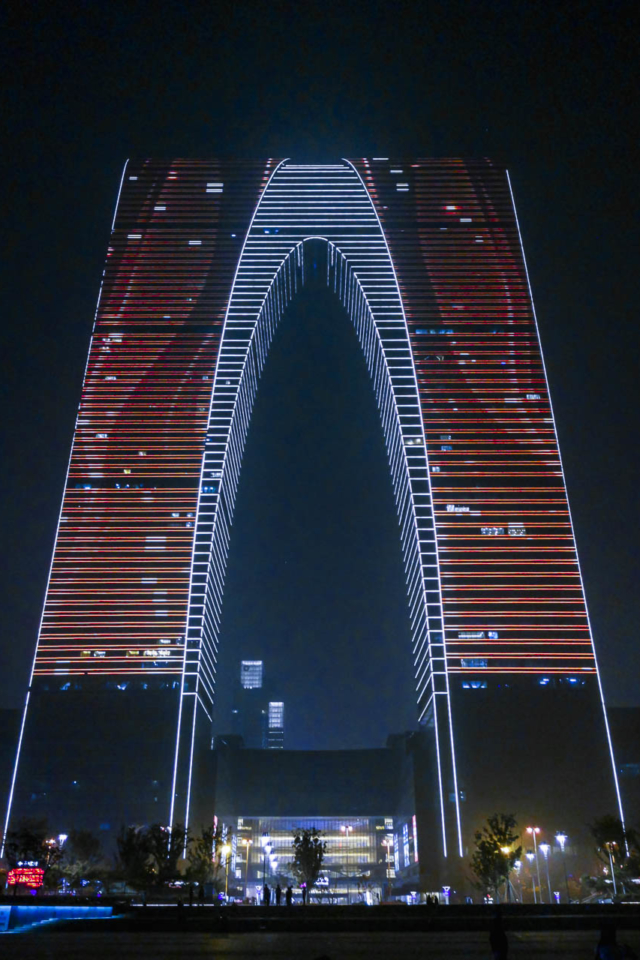
After the show, take a walk along the waterfront to see the light show (until 10 pm) on portrayed on the magnificent building The Gate of the Orient.
This skyscraper looks like a pair of trousers and is the perfect backdrop for a light spectacle displayed on the face of the building.
If you are down on the waterfront during the fountain show, you’ll see the pictures displayed on the building, but if you are up in the W Hotel like we were, you will have to wait until after the show to view the scene.
It’s worth seeing for sure!
17. Suzhou Industrial Park
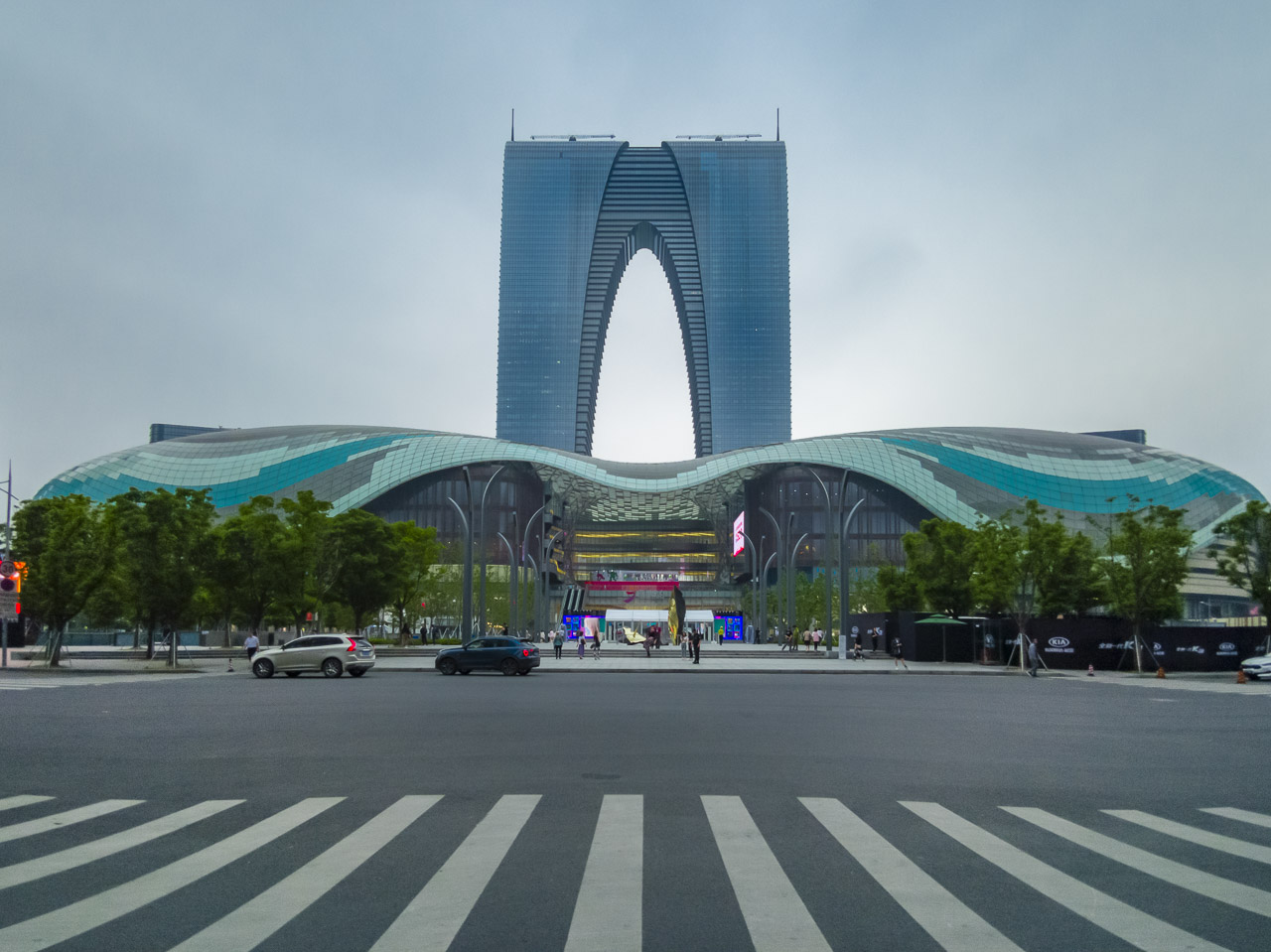
Suzhou Centre Mall is a massive shopping centre complete with skating rink, snowboard park, pony riding arena, and a carousel.
This is a mall that rivals the malls of Dubai and it’s a fantastic place to get your shopping on.
It is such an impressive mall, that it even won the award of Best New Shopping Centre” at MAPIC Awards 2018 in Cannes, France.
18. Suzhou Museum
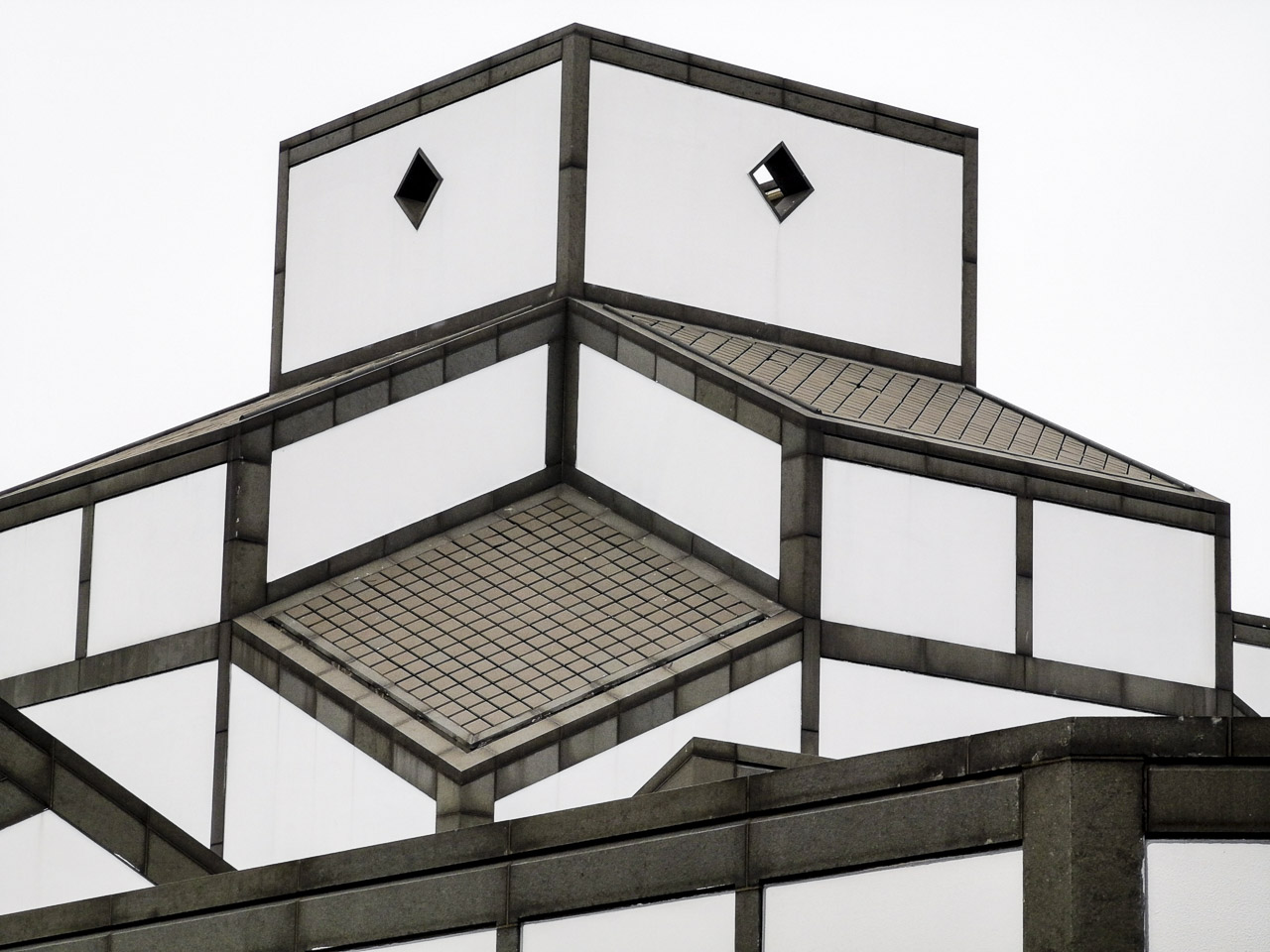
During our time in Suzhou, we were fascinated to find out that IM Pei grew up near here.
During the day of our visit to the Suzhou Museum which he designed, we found out that he had just died.
It was a very strange feeling to be standing in front of one of his great architectural designs and learn of his childhood home while at the same time learning that he passed away.
Suzhou was the traditional retreat of his family and they owned one of the gardens in the city.
It is only fitting that he designed a work of art in a place that gave him such inspiration.
IM Pei designed The Louve pyramids, the Bank of China Hong Kong Tower and many other famous buildings around the world.
19. Tiger Hill Scenic Area – Leaning Tower
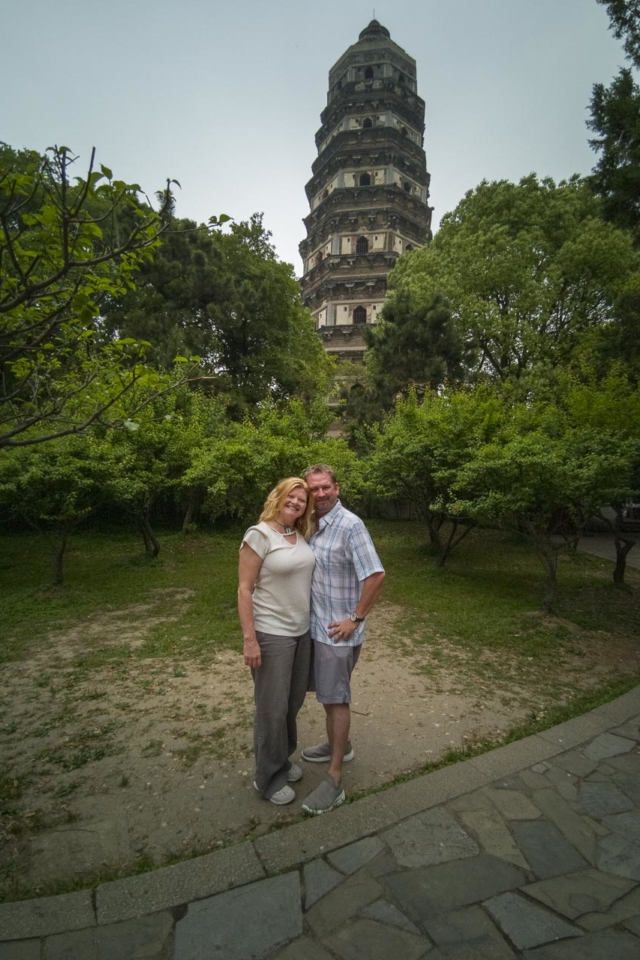
Built during the Song Dynasty, (960-1279) Tiger Hill has become the unofficial symbol of Suzhou and is a popular tourist attraction.
Thinking we’d have to climb to the top we were surprised to hop on a golf cart that brought us right to the entrance of the Tiger Hill Pagoda.
We love how efficient the Chinese are.
Tiger Hill Pagoda is the oldest pagoda in Suzhou and it is unique in the fact that it is leaning.
Yes, we’ve all heard of the leaning tower of Pisa , but the Tiger Hill Pagoda has an impressive lean of 5 degrees and when standing below the 158 foot (48 metres) tower you feel as if it may fall over at any second.
There are many sights to see in the 3.5 acre complex including the sword pool where it is believed that King He Lu was buried with his collection of swords below the water,
20. Bonsai tree session
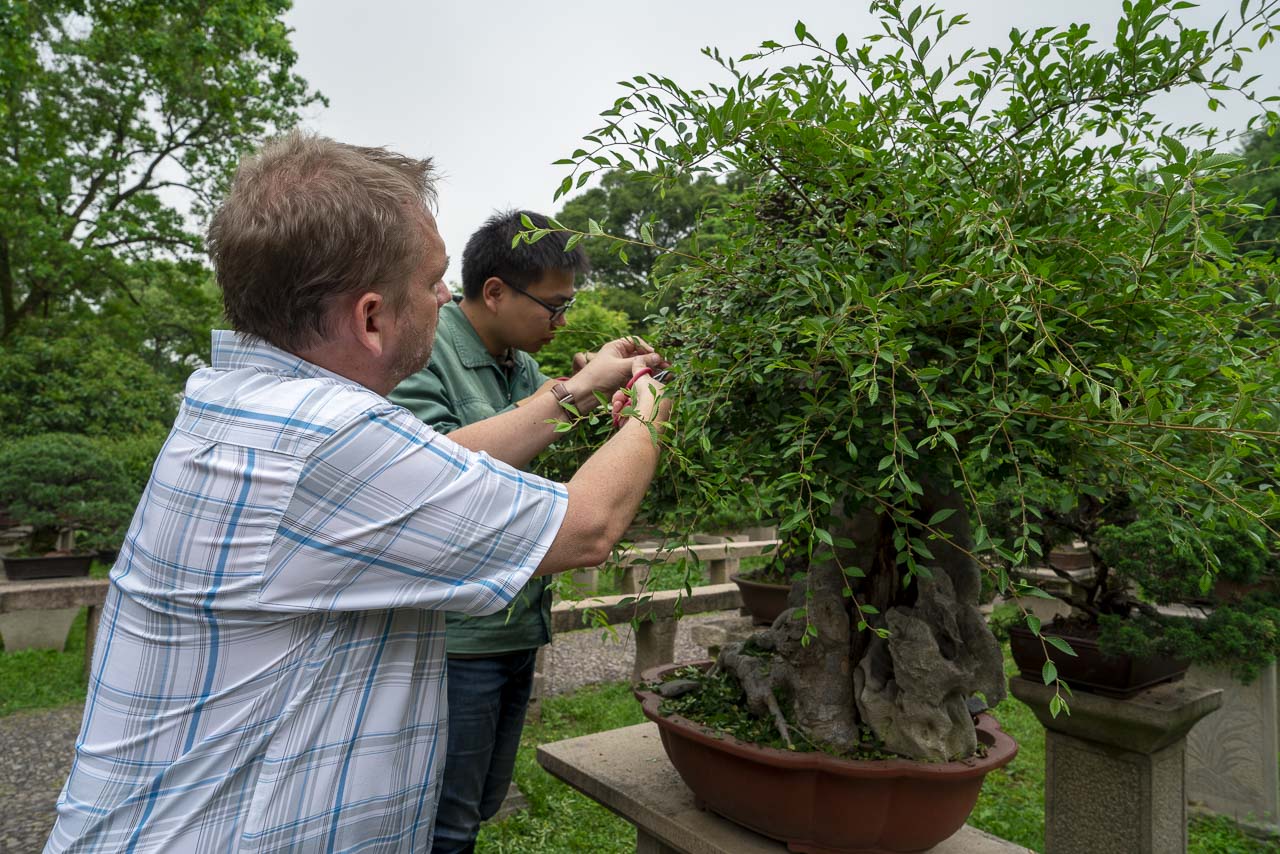
Bonsai masters are revered in Suzhou and it is at Tiger Hill that we witnessed an impressive collection of Bonsai Trees.
We met with a Bonsai master who taught us how to prune bonsai trees properly.
Trying our hand at a mature tree, my hands shook as I worried I may slip and ruin a masterpiece.
But it all turned out and we learned that to prune a tree properly, you must cut where the branch splits in 3 so that you can control which way the leave grow.
Before leaving the area, be sure to check out the 400-year-old bonsai that is protected by a fence and only cut by the Bonsai master.
21. Master Yang Tai Chi
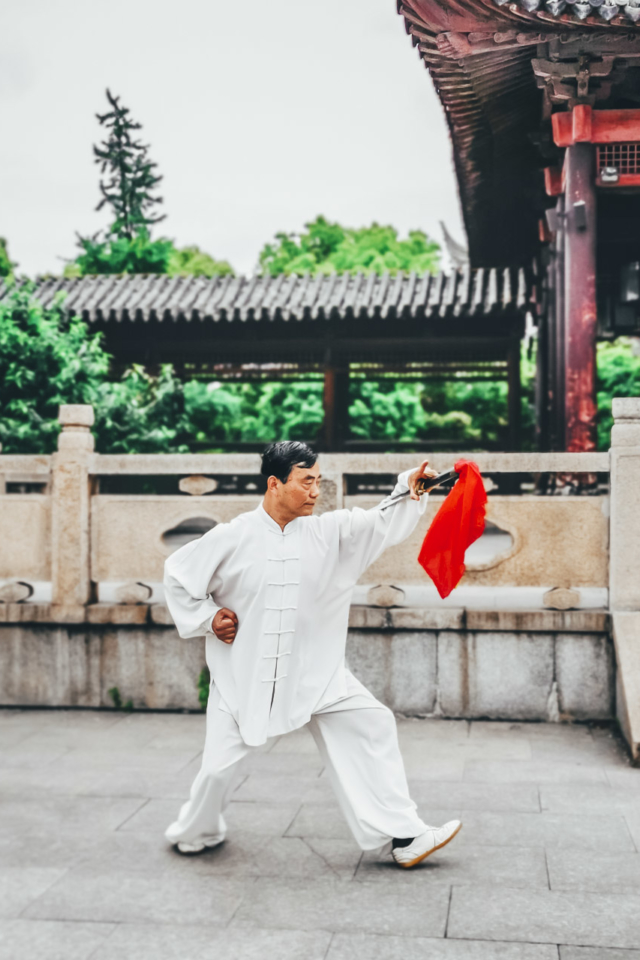
China is the birthplace of Tai Chi, and it seems that whenever we go there, we take a class. I don’t know why we don’t take up Tai Chi when we are at home, it is relaxing and has many benefits.
As our muscles and bones ache, we keep telling ourselves to immerse in Tai Chi in the future.
But it’s hard to top a lesson with Master Yang. He is a Tai Chi Champion in China and Hong Kong.
We met him at the Pan Men gardens for an early Tai Chi class and marveled at his skills with a sword as he demonstrated what is possible with this martial art.
- If you want to book a class, ask your guide or concierge to phone Master Yang. Everyone knows him, he’s famous!
What started out as a quiet and serene morning, quickly turned to a lively performance as local Chinese citizens stopped by to watch us try our hand at their traditional art.
They took our photos and some even joined it. It was a festive event that brought everyone together and we loved every moment.
22. Tongli Watertown
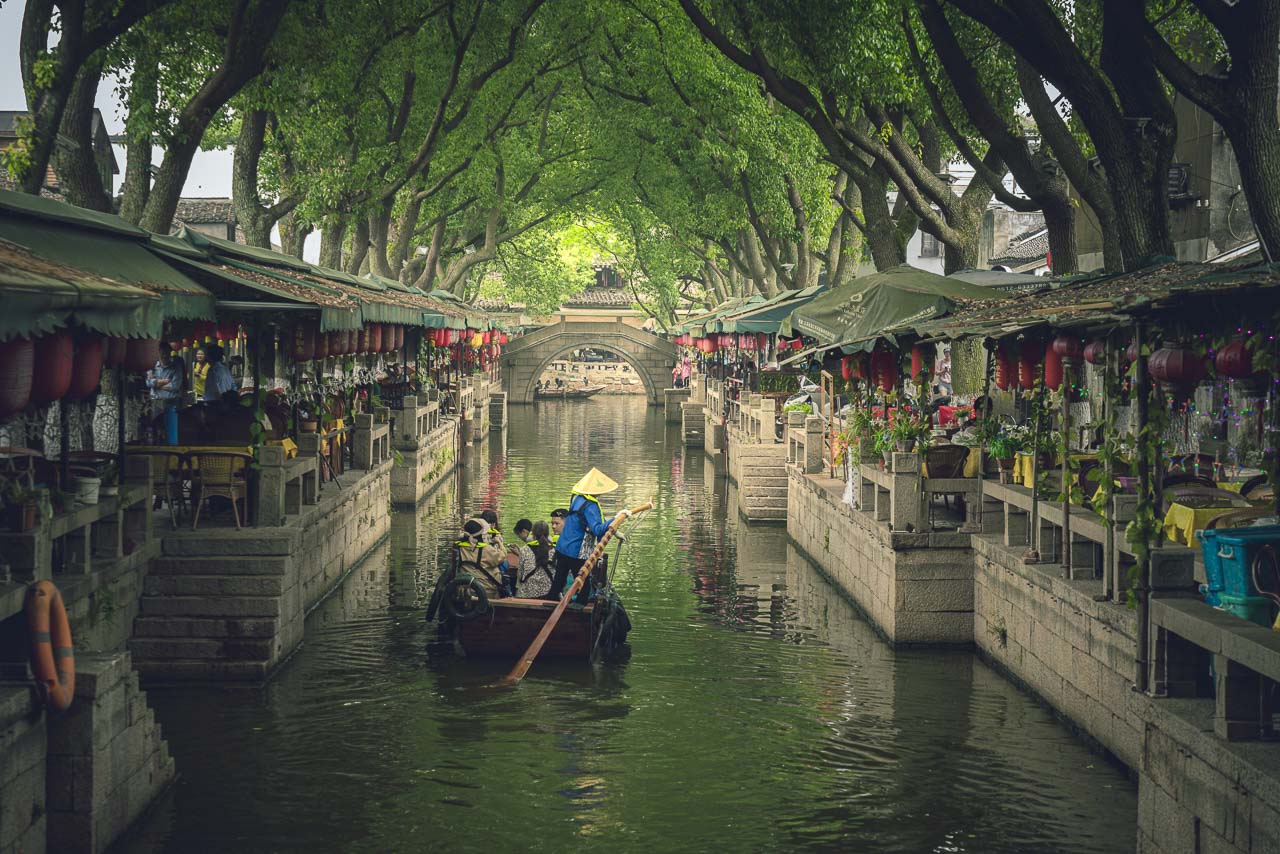
Suzhou is known as the Venice of the East, but Tonglin Watertown truly lives up to it.
Just a one-hour drive from Suzhou, this lovely town is the perfect place to get on a canal and take in the sights.
Tongli is one of six ancient towns south of the Yangtze River and it can even be reached by Shanghai public transit.
Like Suzhou, it has a classical Chinese garden to explore, there are canals running through the town and pedestrian streets crossing over ancient bridges to wander.
One of the most photogenic stops is on the canal tour when we passed a boat filled with large blackbirds. I think this is one of the most recognizable scenes of Tongli.
23. No 1. Silk factory
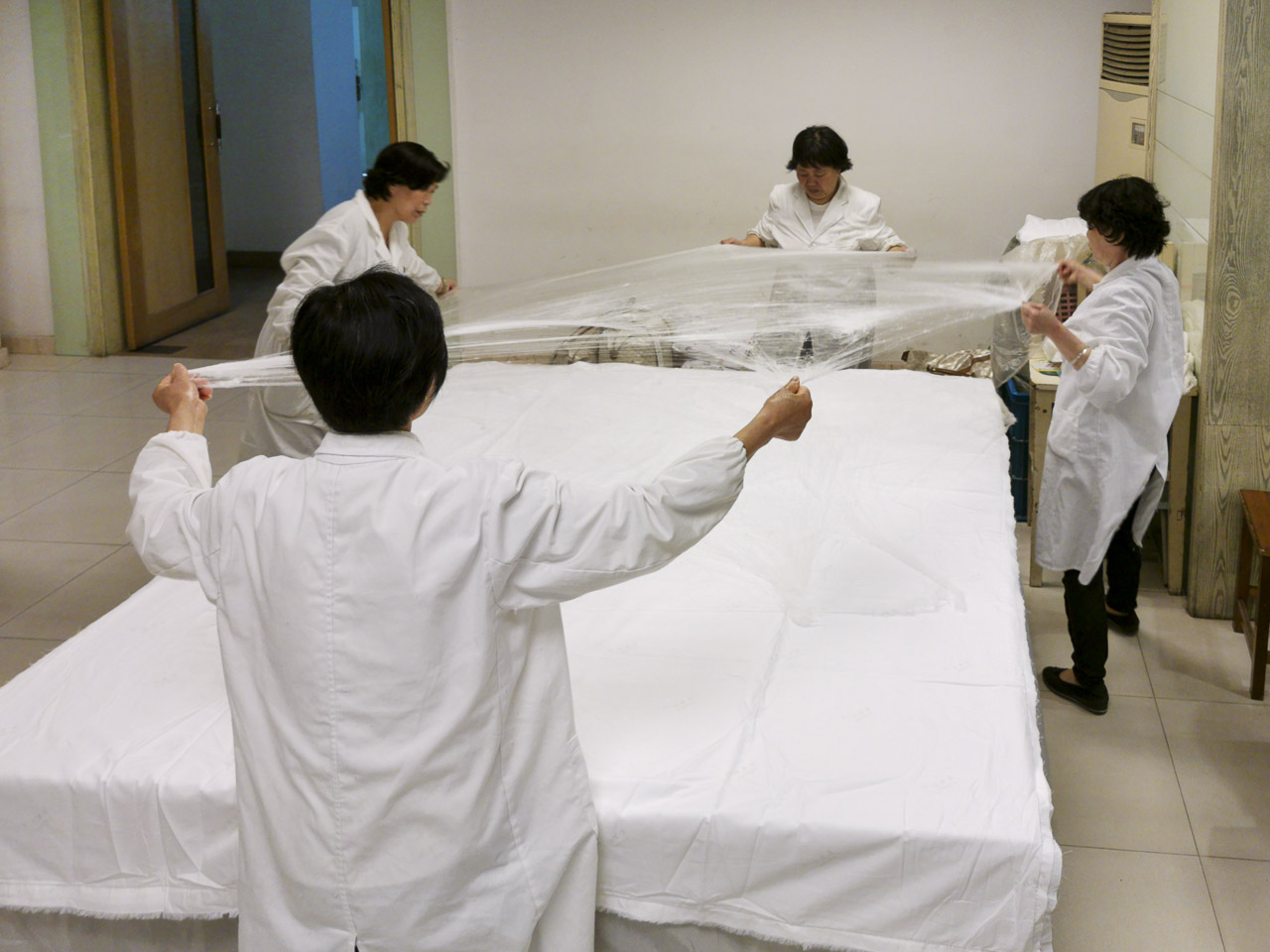
Silk is a major industry in Suzhou. In fact, students learn how to take care of silkworms in school here.
Part of their curriculum is to take home and raise silkworms properly.
I can’t believe that Dave and I have never visited a silk factory before in all our travels.
I was captivated by the process. The silk industry in China dates back to 8500 years!
Visiting a silk factory is a must in China.
Silkworms are reared at the factory where they are given plenty of mulberry leaves to munch on before they See from the worms to the silk-making, boiling and threading.
One cocoon can create one kilometer of thread! Before the cocoon is finished, it is boiled and killed within its safe haven before it can hatch. A handful of dead cocoons are then placed in a threading machine where the strands of silk are woven together making a strong fabric.
This process has been used for thousands of years. The only thing that has changed is the technology, but the worms do all the work.
24. Wedding dress capital of the world

Being a huge producer of silk, it is no wonder that Suzhou is the wedding dress capital of the world.
They have an entire street dedicated to wedding dresses.
When Dave and I heard this, we weren’t too keen to visit a wedding dress market, but after visiting the factory and learning of how huge the industry was, we were game to find out more.
We had the opportunity to visit the largest supplier of wedding dresses – Jusere – in China and they had an incredible display.
Not only did they have wedding dresses, but they also have a private room where they dress movie stars and dignitaries.
People fly from all around the world to have a dress made here.
Even if you aren’t into big fancy weddings, the wedding dress market or a factory tour is an interesting excursion in Suzhou.
25. Embroidery Institute
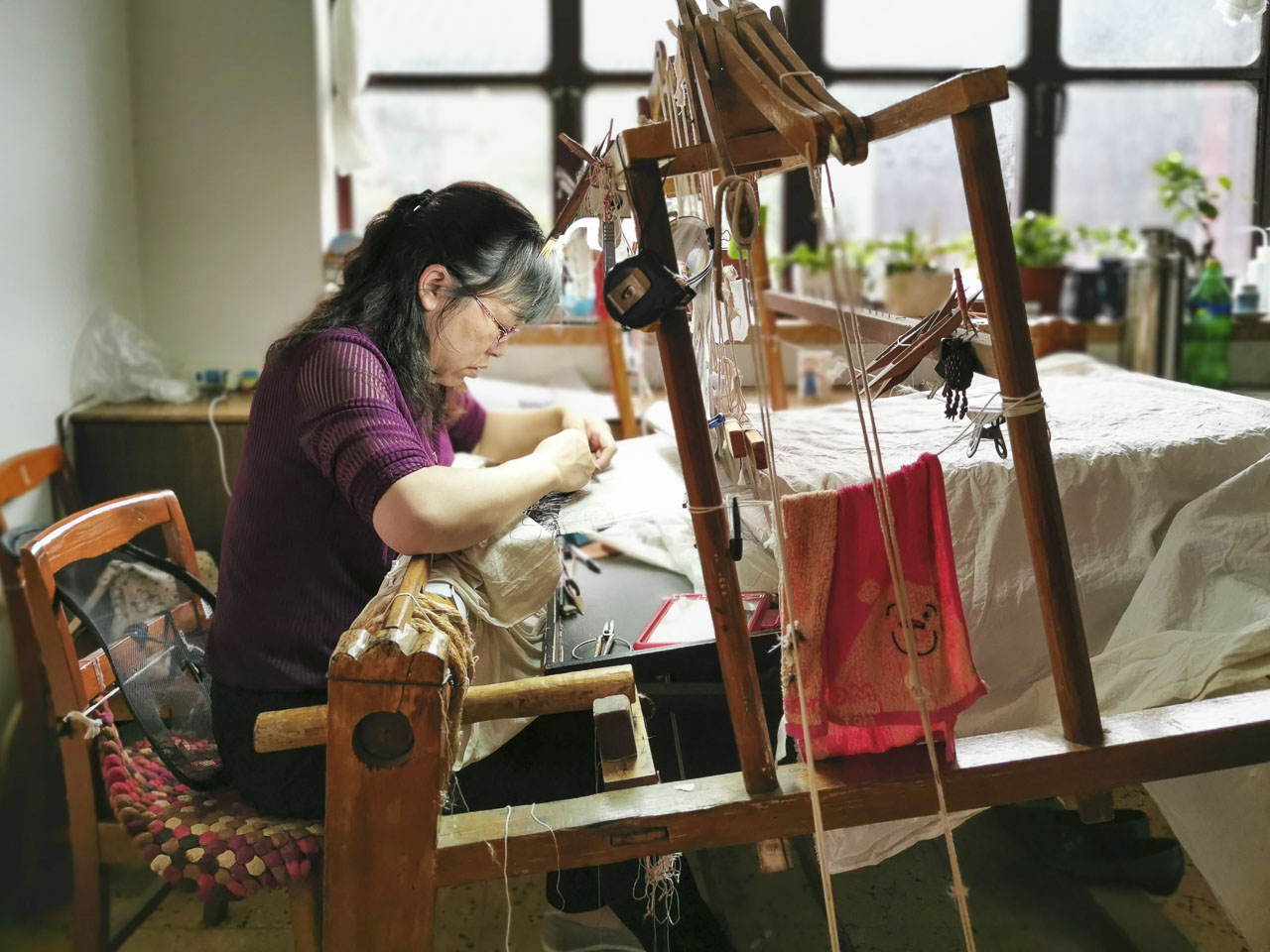
And the final stop for artistry was the Embroidery Institute. Somebody has to have the skills to decorate those beautiful dresses.
Embroidery artists are another revered job in Suzhou and women work on intricate patterns with swaths of thread to create embroidery art and clothing.
The work is so difficult that they have to take regular breaks to meditate in the garden.
You must have young eyes to be an embroidery artist, I couldn’t even see the eye of the needle when they showed me how they thread it.
Okay, I am impressed!
26. Master of the Nets Show
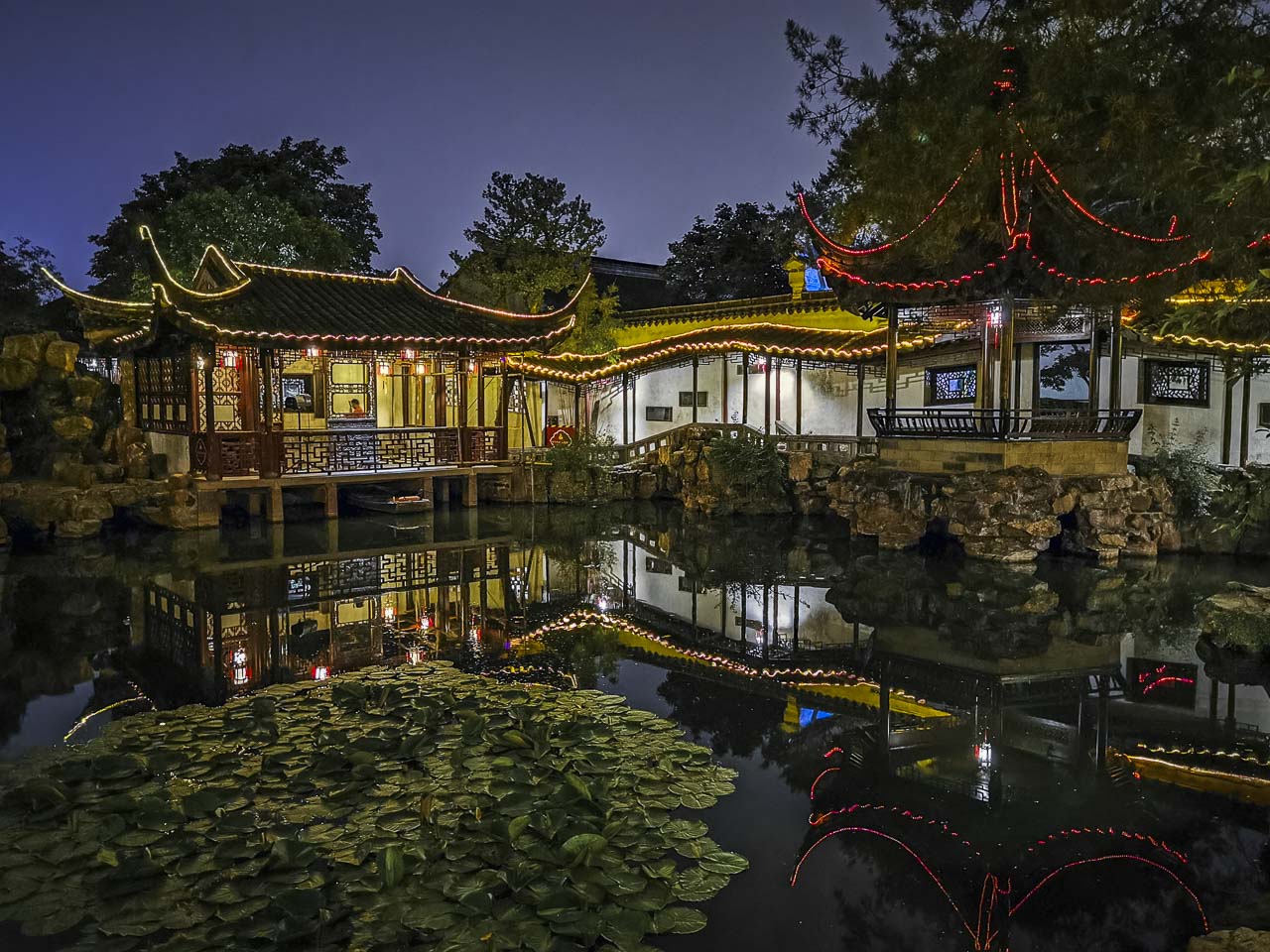
Our final evening in Suzhou ended with one of the top things to do in Suzhou according to other websites.
I found this funny and realized that many people probably didn’t bother doing this, they probably just read about it on another website and put it in their post. Ah, the Internet.
But the garden itself is considered one of the finest in Suzhou, so you should see it.
The Master of the Nets show is a kitschy performance of traditional Chinese music, folklore, and poetry. We couldn’t understand a thing and the crowd moved from one room to another through the gardens.
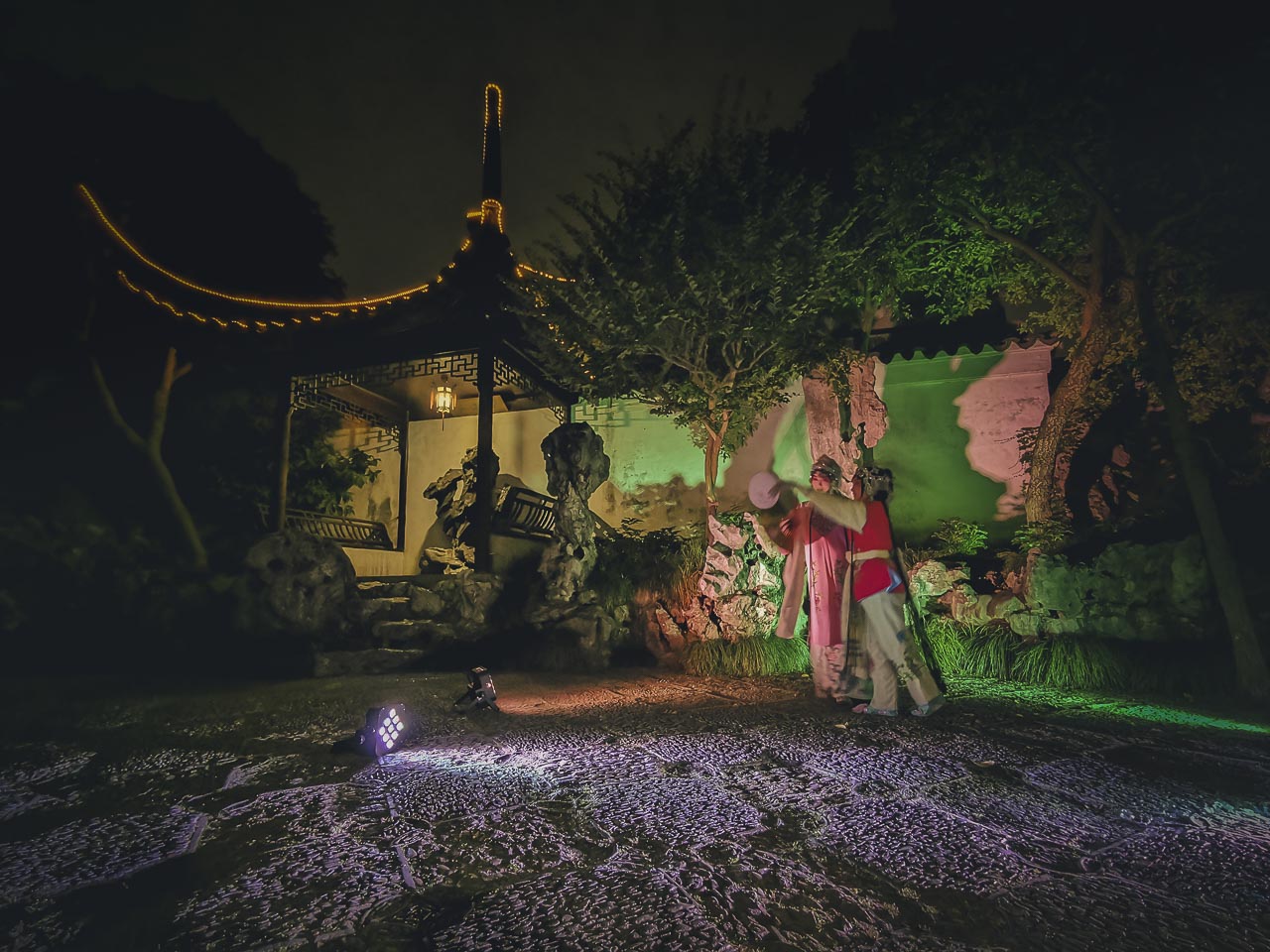
It was a pretty display as it was lit up with colorful lights, but it definitely wasn’t a mindblowing cultural performance.
The musicians seemed bored and the performers seemed like amateurs.
Clearly, every package tour goes to this, so chances are, if you are on an organized trip through Suzhou, you will be seeing the Master of Nets.
The best advice I can give you is to run ahead of the crowd after each short performance so that you can get a seat at the next stop. They pack people in!
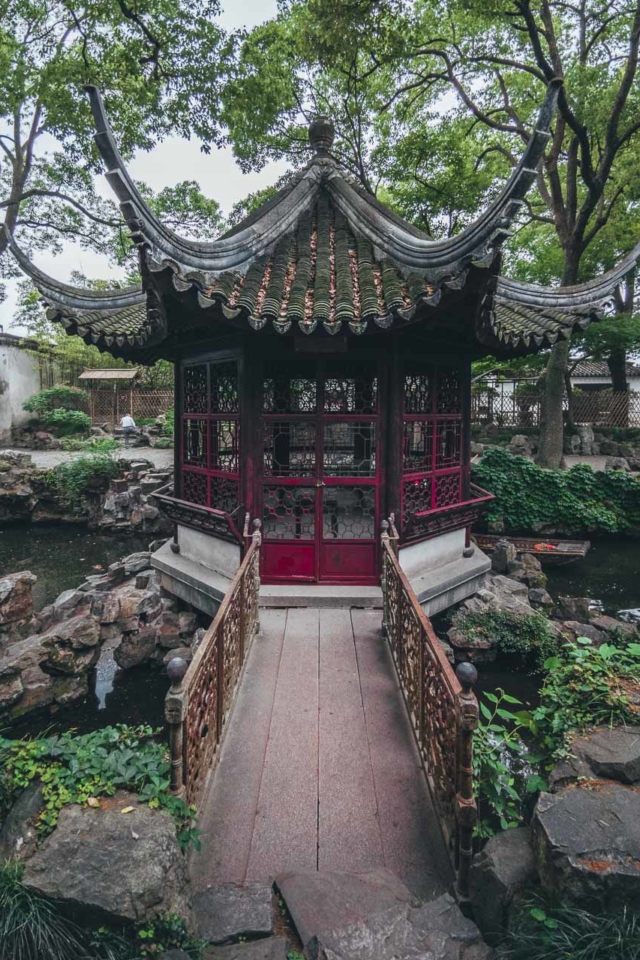
Suzhou is an amazing destination in China. I can see it becoming a larger stop on people’s China itinerary and soon, it won’t be just Chinese tourists exploring the gardens and Canals.
Whether you are a fan of traditional or modern China, Suzhou has it all. I would rand the city right up there with Shanghai , Hong Kong , and Beijing as a must-visit urban center of the country.
Photo attribute Groverlynn – CC BY-SA 4.0 Wikemedia
Did you enjoy this article on Suzhou? Save it to Pinterest for future planning.
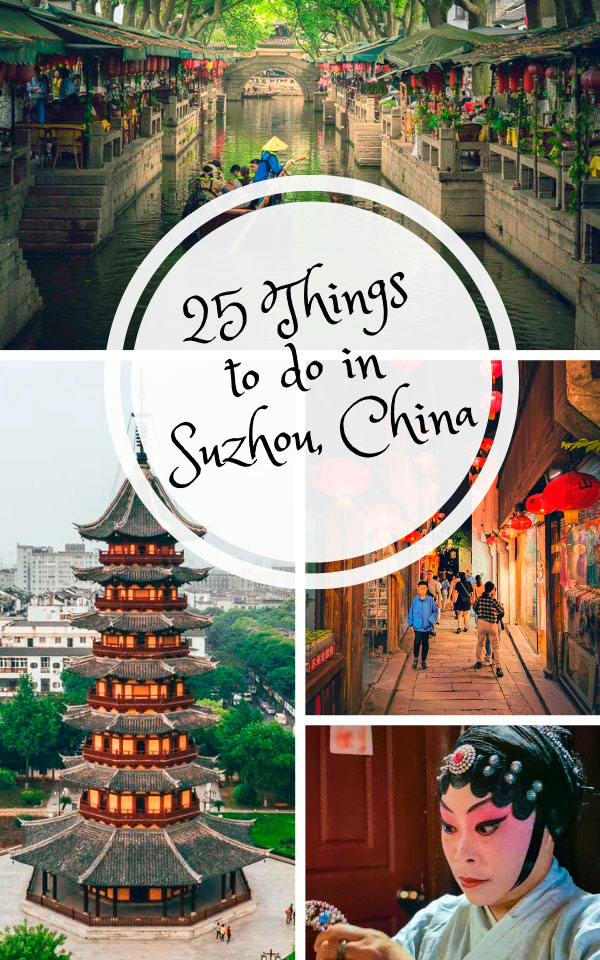
- A Complete Guide To Nanjing – China’s Ancient Capital
- 24 of the Top Things to do in Shanghai
- The Very Best of Beijing
Travel Planning Resources
Looking to book your next trip? Why not use these resources that are tried and tested by yours truly.
Flights: Start planning your trip by finding the best flight deals on Skyscanner
Book your Hotel: Find the best prices on hotels with these two providers. If you are located in Europe use Booking.com and if you are anywhere else use TripAdvisor
Find Apartment Rentals: You will find the cheapest prices on apartment rentals with VRBO .
Travel Insurance: Don't leave home without it. Here is what we recommend:
- Allianz - Occasional Travelers.
- Medjet - Global air medical transport and travel security.
Need more help planning your trip? Make sure to check out our Resources Page where we highlight all the great companies that we trust when we are traveling.
You May Also Like
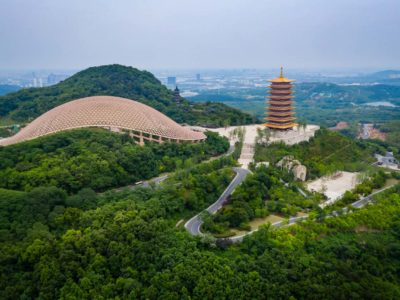
13 Things to do in Nanjing China – A Complete Guide to the Ancient Capital
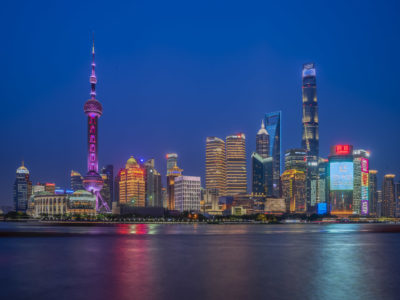
24 Top Things to Do in Shanghai, China
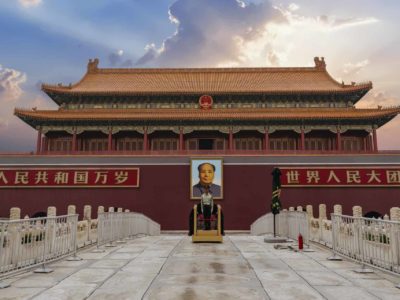
24 of the Best Things to do in Beijing, China
About The Planet D
Dave Bouskill and Debra Corbeil are the owners and founders of The Planet D. After traveling to 115 countries, on all 7 continents over the past 13 years they have become one of the foremost experts in travel. Being recognized as top travel bloggers and influencers by the likes of Forbes Magazine , the Society of American Travel Writers and USA Today has allowed them to become leaders in their field.
Join thousands of others who get our monthly updates!
Leave a comment cancel reply.
Save my name, email, and website in this browser for the next time I comment.
13 thoughts on “26 Things to do in Suzhou China – All You Need to Know Before you Go”
Suzhou, a paradise-like city with fast growing opportunities, is worth to visit and live!
I Like The Embroidery Section And There Idea Of Having young persons For This Work. And I Love the Pictures You Shared.
wow .. it’s fun, of course, to travel the world like you
I really like the beautiful pictures. After reading this i really want to visit china now
One of the best places to live and work in China. I couldn’t recommend it enough
Hello, great blog. I just had a que about your trip to suzhou? How did you guys managed to go to top of HOTEL W? I heard there is a coffee shop?
Suzhou, an over 2500 years old historical and cultural city, is famous for many elegant ancient gardens not seen anywhere else. Our well planned Suzhou tours will give you a greater insight into the city s unique landscape, architectural splendours and rich culture.
Suzhou China is really a memorable place to visit. Thank you for this article.
You guys were able to hit up pretty much all of the “good” places and even got in some interesting cultural experiences! I lived in Suzhou for a short time and those were all the highlights I wanted to see. So glad you got to experience a city another foreigner got to experience. Suzhou really is a city that is often overlooked in China, but I loved the beautiful waterways.
I think it’s becoming more and more popular. Foreigners coming to China are increasingly past Shanghai and Beijing and towards Hangzhou and Suzhou. Beautiful and more chilled cities, even if they are still HUGE by our standards
Wow! I will admit that I have never had a lot of interest in visiting China–until now. Suzhou sounds amazing and I’m adding it to my wish list. Thank you! 🙂
Hopefully I get to travel out of the country someday and expand my mind. Would love someday to see what other countries are like being there. 🙂
Ah, i love your blog, its always fun for me to see what you think we should visit! And I love all the photos.

- Around China
Suzhou Travel Guide: Explore Top 26 Things to Do and See
Imagine walking along ancient streets lined with traditional Chinese architecture, where every corner reveals a new story. That’s Suzhou, a city that seamlessly blends history with modernity. Known as the “Venice of the East” for its intricate network of canals, Suzhou offers a tranquil escape from the bustling cities.
Start your day with a peaceful boat ride along the Grand Canal, soaking in the city’s waterway charm. Explore exquisite classical gardens like the Humble Administrator’s Garden, where every corner reveals a new poetic scene.
In this guide, we’ll take you on a journey through the top 26 things to do in Suzhou, highlighting the best the city has to offer.
You might also be interested in: ⭐ 53 Best Things to Do in Shanghai, China in 2023
Table of Contents
🌟suzhou travel planning guide, 👑 top 26 things to do in suzhou, 🛫 how do i travel to suzhou, 🚖 how to get around suzhou, ☀️ best time to visit suzhou, 🌸final tips on traveling to suzhou, china travel planning guide&faq.
Disclosure: This article contains affiliate links. If you make a purchase after clicking one of these links, I earn a small commission at no extra cost to you. You can learn more about this in my disclosure policy.
Considering a last-minute trip to Suzhou? 🇨🇳 Top Activities and Tours in Suzhou: 1. Suzhou Flexible Private Day Tour with Lunch 2. Private Flexible Suzhou City Tour with Tongli or Zhouzhuang Water Town Options 3. Suzhou Alleyway Walking Food Tour With Locals 🌐Make sure to install ExpressVPN in advance for unrestricted internet access during your stay in China!
1. Pingjiang Road
Pingjiang Road is only two kilometers long, yet it captures the essence of the entire ancient city of Suzhou . Lined with white-walled, grey-tiled ancient houses parallel to the river, the road is flanked by lush camphor trees. Underneath the trees, stone tables and stools depict the life of the water town residents, spreading out along this street.
Today, while there are still locals living on Pingjiang Road, it is predominantly a realm for tourists. Pastry shops, snack stalls, bookstores, cafes, and bars, along with various shops converted from old houses, have settled along the street.
Many alleys stretch out on both sides of Pingjiang Road, featuring former residences of scholars and celebrities, as well as niche museums like the Scholar’s Mansion, Kunqu Opera Museum, and Suzhou Pingtan Museum, all worth exploring.
A significant feature of Pingjiang Road is the hand-rowed boats on the water. Boatmen, dressed in uniform clothing and straw hats, occasionally sing a Jiangnan folk tune.
🚗How to get there: Take metro line 1 to Lindun Road Station or Xiangmen Station.
2. Guangqian Street
Guangqian Street, situated in the heart of Suzhou, derives its name from the Xuanmiao Taoist Temple. In the past, people gathered here to burn incense and pray, gradually forming a market and later developing into a street. Until the early 21st century before the renovation of the old city, Guangqian Street had always been the commercial center of Suzhou.
It’s a paradise for food lovers , with old and famous eateries still bustling with customers, such as Lugaojian , Caizhizhai Candy Store , Huangtianyuan , Songhelou Restaurant , and Deyuelou Restaurant . Besides local delicacies, you can find everything from steaks to snacks, pastries, and desserts here!
However, unlike the more subdued ambiance of Pingjiang Road, Guangqian Street exudes a stronger commercial vibe. Moreover, a stroll through Lindun Road at the street’s end leads to Pingjiang Road.
🚗How to get there: Take metro line 4 to Chayuanchang Station
3. Shantang Street
Shantang Street, also known as Seven-Li Shantang, extends about 2.2 miles (seven li), hence its name. This street was built over a thousand years ago during the Tang Dynasty when the great poet Bai Juyi was the governor of Suzhou, and workers were recruited to dig the river and build the embankment.
Today, Shantang is divided into east and west sections. The east section has been transformed into a scenic area and a bustling commercial street, attracting tourists with its lively water town atmosphere.
The west section retains its original charm, with houses facing the street and backing onto the river, offering visitors the best place to experience the lifestyle of the Shantang people.
Regardless of the section, at night, the lanterns on both sides of the street and in the houses light up in succession, their reflections shimmering on the water, making Shantang even more beautiful!
Shantang Street is actually a series of narrow and secluded lanes, lined with a variety of shops selling all kinds of trinkets and delicious snacks. It can take several hours to explore all the shops. Female tourists often enjoy buying oil-paper umbrellas, fans, head ornaments, bronze mirrors, and combs.
To truly experience the ambiance of a Jiangnan water town, visitors can take a boat ride along the waterway . Along the riverbanks, you can observe elderly women washing clothes, stone houses adorned with dark green moss where the stone meets the water, providing glimpses of Suzhou’s primitive way of life!
🚗How to get there: Take metro line 2 and get off at Shantang Street Station.
4. Humble Administrator’s Garden
As the premier among China’s four famous gardens, the Humble Administrator’s Garden is often the first stop for many tourists seeking to experience Suzhou’s classical gardens.
The garden is vast, requiring 2-3 hours to explore fully, and is divided into three main sections: East, Central, and West, with the Central section being the highlight.
The Eastern Section features expansive lotus ponds, particularly enchanting during the summer when lotus flowers bloom, occasionally graced by the presence of ducks swimming in the lake.
The Central Garden embodies the typical Ming Dynasty garden style, featuring water pools, artificial hills, small pavilions, exuberant trees, and a well-organized layout.
The Western section is characterized by its architecture, including various covered corridors and residential courtyards. This area is less crowded, offering a peaceful environment to stroll and admire the former owners’ living spaces.
I personally recommend hiring a guide for CNY 30 per person. There are two reasons for this: first, the garden is extensive, and you might get lost without guidance; second, many attractions here have interesting stories behind them, which you can only appreciate fully if you understand them.
However, due to the garden’s fame, it attracts a large number of tourists, which can diminish the sense of freedom and tranquility while sightseeing. If time allows, it’s advisable to visit in the early morning or evening to avoid crowds.
🎫Admission ticket: CNY 90 (Apr-Oct); CNY 70 (Nov-Mar) ⏰Opening hours: 07:30 – 17:00 🚗How to get there: Take bus no. 40 or 313 and get off at Beiyuanlu Station.
5. Lion Grove Garden
Ranked among the four renowned gardens in China, Lion Grove Garden is often described by visitors as “fun!”
Unlike the sprawling Humble Administrator’s Garden, Lion Grove Garden is relatively compact, offering a completely different experience. While the Humble Administrator’s Garden impresses with its grandeur, Lion Grove Garden exudes a sense of amusement.
The garden boasts the largest surviving ancient rockery in China, forming a delicate stone maze with 9 mountain paths and 21 caves. Visitors navigate through winding mountain paths and dark tunnels, encountering peculiar rocks resembling lions along the way, blending amusement with scenic beauty.
In addition to the fascinating rockery, the garden’s floral windows are also worth mentioning. Especially in buildings like Yanyu Hall (yanyutang) and Pointing at Cypresses Hall (zhibaixuan), these windows are adorned with colored glass, adding a different play of light and shadow to the predominantly black and white garden.
🎫Admission ticket: CNY 40 (Apr-Oct); CNY 30 (Nov-Mar) ⏰Opening hours: 07:30 – 17:00 🚗How to get there: Take bus no. 55, 178, 202, 518, 529, 811, 923 or 925, or tourist bus no. 1, 2 or 5, and then get off at Suzhou Museum Station.
6. Suzhou Museum
The Suzhou Museum, designed by the renowned American-Chinese architect Mr. Ieoh Ming Pei, is not only home to valuable collections but is also considered an architectural masterpiece.
The museum consists of two parts: the new museum and the old Prince Zhong’s Mansion, blending seamlessly into a small garden-like setting.
Inside, visitors can explore four permanent exhibitions: Relics of Wudi, National Treasure of Wu Tower, Wuzhong Fengya, and Wumen Calligraphy and Painting , which offer a deep dive into the refined elegance of Suzhou. The collections include ancient to modern ceramics, jade artifacts, and calligraphy and paintings. The old mansion section showcases Suzhou-style painted decorations.
Among the museum’s highlights are two “national treasures”: the Olive Green Lotus-Shaped Bowl discovered at the Tiger Hill Pagoda in Tiger Hill and the exquisite Pearl Pillar of the Buddhist Shrine from the Song Dynasty.
Beyond its collections, the Suzhou Museum’s architecture is a major draw. The interplay of light in its corridors, the natural and logical lighting, the ink-painting-style background walls, and a large central pool in the courtyard that reflects the surrounding scenery create a visually stunning experience.
Note: The Suzhou Museum, Humble Administrator’s Garden, Lion Grove, and other attractions are close to each other, making it convenient for visitors to explore them in a single day. It’s advisable to make reservations in advance.
🎫Admission ticket: free ⏰Opening hours: 9:00 – 17:00 (Tuesday – Sunday) 🚗How to get there: Take bus no. 55, 178, 202, 518, 529, 811, 923 or 925, or tourist bus no. 1, 2 or 5, and then get off at Suzhou Museum Station.
7. Suzhou Silk Museum
Suzhou is a renowned ancient silk city in China, is famous for its Suzhou embroidery , a type of silk craftsmanship that has gained worldwide recognition. The Suzhou Silk Museum, established in 1989, is the first specialized silk museum in China.
The museum not only displays fragments of silk from the Tang, Liao, Song, and Yuan dynasties, as well as clothing from the Ming and Qing dynasties, but also provides information on silkworms, silk, sericulture, and textile production.
One particularly interesting feature is the display of specimens showing the different growth stages of silkworms, alongside machines used for silk reeling. Moreover, the museum’s flooring consists of transparent fiberglass structures with flowing water beneath. Illuminated by soft blue lights, it creates a beautiful effect, giving the impression of walking on water.
Additionally, a large part of the museum is dedicated to showcasing and selling silk products such as silk quilts and silk garments.
🎫Admission ticket: free ⏰Opening hours: 9:00 – 17:00 🚗How to get there: Take tourist bus no. 4, bus no. 1, 5, 8, 38, 54, 101, 102 or 602 and get off at Pingmen Station.
8. North Temple Pagoda
Bao’en Temple, the oldest temple in Suzhou, has a history of over 1700 years.
The North Temple Pagoda in Bao’en Temple stands at 76 meters tall, with high eaves and a slender pagoda spire. The outer wooden eaves, reconstructed during the Qing Dynasty, are still intact.
As the tallest landmark within Suzhou’s ancient city, the North Temple Pagoda sets the height limit for buildings in the old city according to Suzhou’s government regulations. The best viewing spot for the pagoda is from the nearby Humble Administrator’s Garden.
Apart from the ancient pagoda, two other must-see structures in the North Temple Pagoda scenic area are the Bronze Buddha Hall and the Hall of the Goddess of Mercy .
In early December, visitors to the North Temple Pagoda scenic area can also enjoy the beautiful views of gingko trees.
🎫Admission ticket: CNY 25 ⏰Opening hours: 07:45 – 17:30 🚗How to get there: Take metro line 4 to Beisita Station.
9. Master of Nets Garden
Although it is one of the famous gardens in Suzhou, the Master of Nets Garden is actually the smallest. Despite its small size, it does not feel cramped at all. The garden features traditional Suzhou-style architecture, including small bridges over flowing water and pavilions, all laid out in a compact yet clever and delicate design.
As the former residence of many literati and scholars, the garden is adorned with numerous inscriptions of poems and literary works, and the study rooms and halls are arranged with great elegance. For instance, you’ll find the “Four Treasures of the Study” placed on the desk and incense burners placed beside the elegant seats.
In addition to its elegance, the Master of Nets Garden is the only garden in Suzhou that can be visited at night. From April to October each year, from 7:30 p.m. to 10:00 p.m. every evening, visitors can enjoy performances of Kunqu Opera, Pingtan (a Suzhou storytelling art form), ancient Chinese music, and folk music, making it a truly representative experience of Suzhou!
🎫Admission ticket: CNY 40 (Apr-Oct); CNY 30 (Nov-Mar) ⏰Opening hours: 07:30 – 17:00 🚗How to get there: Take bus no. 55, 202, 529, 811, or 931 and get off at Wangshiyuan Station.
10. FengMen HengJie
To deeply understand Suzhou, it’s essential to visit FengMen HengJie. This street is a narrow, east-west oriented, 600-meter-long lane paved with stone slabs,, wide enough for only a small car to pass through. Despite its narrowness, it’s densely packed with shops selling vegetables, fruits, clothing, shoes, aged liquor, poultry, fish, and more.
However, each shop is neatly arranged, and the shopkeepers don’t use loudspeakers to advertise, maintaining a sense of order. Here, you’ll find traditional Suzhou residents, and you’ll discover things you can’t see in many other places.
🚗How to get there: Take bus no. 501 and get off at Fengmen Station.
Tiger Hill, with a history of over 2500 years, is almost a must-visit for everyone traveling to Suzhou. Located in the northwest suburb of the city, it features a small hill shaped like a crouching tiger. Although the area is not large, it is densely packed with historical relics, each step revealing its mysteries.
The highlight of the area is the Tiger Hill Pagoda and the Sword Pool. The Tiger Hill Pagoda is Suzhou’s oldest pagoda, with a history of over a thousand years. It is also the world’s second leaning tower, majestic and ancient, long symbolizing ancient Suzhou.
Descending from the Tiger Hill Pagoda, you will find the Sword Pool, where the walls bear inscriptions from ancient Chinese calligraphy masters. Legend has it that the bottom of the pool is the entrance to the tomb of an emperor, containing a large number of swords and treasures.
Tiger Hill is full of many story-filled attractions. The area offers free guided tours, allowing visitors to better appreciate the charm of Tiger Hill’s history.
🎫Admission ticket: CNY 80 (Apr-Oct); CNY 60 (Nov-Mar) ⏰Opening hours: 07:30 – 17:30 🚗How to get there: Take bus no. 146 or tourist bus no. 1 or 2 and get off at Huqiu Station.
12. Hanshan Temple
Hanshan Temple is one of the most famous temples in Suzhou, with a history of over 1,400 years. It gained widespread fame due to the poem “A Night Mooring Near Maple Bridge” written by Zhang Ji , a poet of the Tang Dynasty.
The temple houses many historical relics, including the statue of Han Shan, the stone tablet inscription of the poem “A Night Mooring Near Maple Bridge,” and other tablet inscriptions written by famous intellectuals of ancient China.
Today, it remains a place of worship, attracting locals and visitors alike. Every year on December 31st, Hanshan Temple holds a New Year’s Eve bell-ringing ceremony, ringing the bell 108 times to pray for happiness and safety in the upcoming year.
🎫Admission ticket: CNY 20 ⏰Opening hours: 07:30 – 17:00 🚗How to get there: Take bus no. 30, 31, 33, 40, 44, 300, 301, 307, 313, 324, 332, 406, 415, 442, 622, 816, 932 or tourist bus no. 3 and get off at Hanshansi South Station.
13. Panmen Scenic Area
Panmen City Gate is the only remaining ancient city gate in Suzhou. The scenic area is expansive, combining the charm of Jiangnan gardens with the grandeur of ancient city gates, exceeding my expectations during my visit.
Within the scenic area, Ruiguang Pagoda and Wumen Bridge, along with Panmen Water Gate, are collectively known as the Three Scenes of Panmen.
Panmen City Gate was first constructed during the Wu Kingdom of the Spring and Autumn Period (770BC-476BC). It includes the land city gate, the water city gate, the city gate tower, the barbican, and the city wall on both sides. Walking along the slope on the north of the city wall provides a panoramic view of Panmen City Gate.
Wumen Bridge, near Panmen City Gate, was built during the Northern Song Dynasty. It is a typical large single-arch stone bridge with the characteristics of Jiangnan water towns. The bridge arch is tall, allowing boats to pass smoothly. However, the bridge has a steep slope with many stone steps that have become uneven and sunken over time due to its age.
Upon entering from the east gate of the scenic area, the first building you encounter is the Ruiguang Pagoda. This ancient pagoda stands at over fifty meters tall with seven floors. It is a brick-and-wood structure with a loft-style Buddha pagoda. Relics, scriptures, and many Buddhist artifacts were discovered in the pagoda.
🎫Admission ticket: CNY 40 ⏰Opening hours: 07:30 – 17:00 🚗How to get there: Take bus no. 39, 47, 305, 935, 949, or tourist bus no. 2 or 5 and get off at Panmen Scenic Area North Station.
14. Lingering Garden
Among China’s four famous gardens, Suzhou boasts two: the Humble Administrator’s Garden and the Lingering Garden. Compared to the Lion Grove and the Humble Administrator’s Garden in the old city area, the Lingering Garden doesn’t seem too crowded.
The entrance to the Lingering Garden is small, resembling the doorway of an ordinary ancient household. Upon entering, visitors navigate through a maze-like corridor that alternates between spacious and narrow. This section of the garden is highly admired by enthusiasts of garden and architectural design.
The Lingering Garden is primarily divided into four areas: east, west, north, and central, connected by a winding corridor spanning 700 meters.
The eastern part of the garden focuses on architecture, while the central area features landscapes of mountains, water, and flowers. The western side showcases fantastic rockeries, and the northern section offers a pastoral atmosphere abundant with greenery.
The rooms in the Lingering Garden are grand and bright, resembling those of affluent households, adorned with numerous paintings and calligraphy. Apricot and peach trees are planted throughout the garden, and pergolas are erected over the gravel paths.
The garden boasts numerous bonsai trees of varying sizes, meticulously crafted, with bamboo railings separating scenic spots from pedestrian paths throughout the garden.
🎫Admission ticket: CNY 55 (Apr-Oct); CNY 45 (Nov-Mar) ⏰Opening hours: 07:30 – 17:00 🚗How to get there: Take bus no. 85, 317, 933, or tourist bus no. 1 and get off at Liuyuan Station.
15. Xiyuan Temple
Outside Changmen in Suzhou stands Xiyuan Temple, with a history of over 700 years. The existing halls were mostly built in the late Qing and early Republican periods, making it the largest temple in Suzhou .
Xiyuan Temple has a unique structure, different from ordinary temples. Before entering the main gate, there are two bridges. Behind the temple, there is a large garden and a Free Life Pond. It is said that there were originally two spotted turtles in the Free Life Pond, and this kind of turtle with spots on its back is one of only three left in the world, with Xiyuan Temple having two of them.
As one of the few temples offering Buddhist study courses, most of the visitors here are believers and pilgrims. In the rooms, you can often see people quietly copying scriptures and diligently studying.
Entering through the door next to the Hall of Heavenly Kings, you will find the vegetarian hall on the left, which attracts many tourists and is often in high demand . There are many varieties of vegetarian dishes here, including vegetarian steamed buns and buffet, at very affordable prices.
🎫Admission ticket: CNY 5 ⏰Opening hours: 07:30 – 17:30 🚗How to get there: Take bus no. 406 and get off at Xiyuan Station.
16. Canglang Pavilion (Blue Wave Pavilion)
Canglang Pavilion is Suzhou’s oldest garden and one of the city’s four most famous gardens. It exudes a delicate charm, reminiscent of a small, precious jade. The pavilion’s corridors, floral windows, inscribed steles, and pond fish all contribute to its unique aura.
Before entering the garden, visitors are greeted by a large pond, which they must cross via a stone bridge. Unlike other famous gardens like the Humble Administrator’s Garden, Canglang Pavilion is relatively small and devoid of crowds, offering a tranquil atmosphere.
One notable feature of Canglang Pavilion is its abundance of bamboo. Everywhere you look, lush green bamboo creates a soothing ambiance, with a diverse array of bamboo species found throughout the garden. While winter might not be the ideal time to appreciate bamboo, the leaves remain verdant throughout the season, ensuring a consistent scenery year-round.
Another unique feature of Canglang Pavilion is its lattice windows. The garden boasts 108 different patterns of lattice windows, each more exquisite than the last. These intricate lattice windows adorn the walls of the corridors, featuring designs like Han vases, autumn leaves, longevity peaches, potted flowers, crabapple blossoms, gourds, and more!
🎫Admission ticket: CNY 20 (Apr-Oct); CNY 15 (Nov-Mar) ⏰Opening hours: 07:30 – 17:00 🚗How to get there: Take metro line 4 to Sanyuanfang Station.
17. Couple’s Retreat Garden (Ou Yuan)
This is a garden near Pingjiang Road, so you can walk there from Pingjiang Road. They also sell tickets that include a boat ride. After exploring Couple’s Retreat Garden, you can take a boat back to Pingjiang Road, experiencing a bit of the water town’s charm.
The name “Couple’s Retreat Garden” reflects the deep bond between the original owners, as everything in the garden, including the buildings, lattice windows, rockeries, pavilions, and towers, comes in pairs.
The garden still preserves a large number of calligraphy and paintings by the original owners Another feature is its large yellow stone rockery, which is as big as a small hill.
There are performances here almost every day, including Pingtan storytelling, traditional Chinese opera, and Suzhou embroidery. You can see a schedule of performances at the entrance. While watching the performances is free, there is an additional charge if you want to request specific songs or pieces.
🎫Admission ticket: CNY 25 (Apr-Oct); CNY 20 (Nov-Mar) ⏰Opening hours: 08:00-17:00 🚗How to get there: Take metro line 1 to Xiangmen Station.
18. Jinji Lake
The most beautiful night scenery in Suzhou is undoubtedly Jinji Lake!
Jinji Lake boasts stunning scenery, surrounded by Suzhou’s CBD where skyscrapers that are not visible in the old area are concentrated. It features attractions like Lakeside Avenue, Ferris Wheel Park, Li Gong Di Causeway, and the Suzhou Culture and Arts Center.
The Suzhou Ferris wheel stands at 120 meters, making it the largest water-based Ferris wheel in China, offering panoramic views of Jinji Lake from high above.
The commercial area here offers everything from clothing and snacks to horseback riding, game rooms, and ice skating rinks.
Jinji Lake is quite large, and walking around it during the day can be quite challenging. Riding a bike is the best way to explore it.
In the evening, you can visit Moonlight Harbor or the bar street. Sitting in one of the waterfront bars, sipping wine, listening to jazz, and enjoying the beautiful night lights is a delightful experience!
🎫Admission ticket: Free ⏰Opening hours: All day 🚗How to get there: Take metro line 1 to Gate of the Orient Station.
19. Zhouzhuang Water Town
Located about 40 km southeast of Suzhou, Zhouzhuang Water Town is hailed as the “Number One Water Town in China.” It is not only one of the six ancient towns in the south of the Yangtze River but also once listed by CNN as one of the “Top 10 Most Beautiful Towns in the World.”
Zhouzhuang Water Town is built around water, with streets following the rivers. The grid-like waterways still retain 14 ancient bridges built during the Yuan, Ming, and Qing dynasties. More than 60% of the residences still maintain the architectural style of the Ming and Qing periods. Major attractions in the town include the Twin Bridges (Shuang Qiao), Shen House, and Zhang House.
The Twin Bridges are a must-visit spot. They are not two separate bridges but rather, their significance lies in the perfect circle formed by their reflections in the water, which is quite unique. Other famous bridges include Taiping Bridge and Fu’an Bridge.
In the town, you can take a boat tour with friends, enjoy wine at a bar, or drink tea at a tea house. Walking along the streets, you’ll see elderly ladies weaving, and passing by the river, you might hear locals singing folk songs while rowing boats. The people here are known for their simplicity and kindness.
It is highly recommended to visit Zhouzhuang during off-peak tourist seasons, such as avoiding the May Day holiday and National Day, as the town is not particularly large and may not be ideal for exploring when crowded.
🎫Admission ticket: CNY 100; CNY 180 for a daytime cruise ⏰Opening hours: All day 🚗How to get there: Take a bus from Suzhou North Bus Station to Zhouzhuang, departing approximately every 40 minutes between 7:00 and 18:05. The fare is CNY 16.
👉 Book Zhouzhuang Water Town Tour on VIATOR
20. Tongli Ancient Town
As one of the six ancient towns in Jiangnan , Tongli Ancient Town is the most conveniently located among the ancient towns around Suzhou, as you can reach it by taking the subway to Tongli Station and then a short taxi ride to the town.
Tongli Ancient Town is not very large, with its crisscrossing streets and waterways. It features various attractions, including the Retreat and Reflection Garden, Jiayin Hall, and the Ternate Bridges.
In my opinion, the Retreat and Reflection Garden is the most worthwhile visit, as the other attractions are quite small. The Retreat and Reflection Garden is the most famous private garden in Tongli Ancient Town and is the only World Cultural Heritage site in Jiangnan ancient towns, comparable to the Lingering Garden.
The town is still home to many local residents, and you’ll often see people washing by the river and pedicabs carrying tourists around the town. There are also many riverside restaurants with plenty of tables and chairs, which are not usually full during the day.
Tongli Ancient Town also has a small island called Luoxing Island , which you can reach by ferry from Tongli Lake Pier, about a 5-minute journey. The island is basically tourist-free, offering a quiet retreat with clear waters reflecting temples built along the lake.
🎫Admission ticket: CNY 100 ⏰Opening hours: 08:00-17:15 🚗How to get there: Take metro line 4 to Tongli Station, then switch to the tourist bus heading to the north entrance of Tongli.
👉 Book Tongli Ancient Town Tour on VIATOR
21. Luzhi Town
Luzhi Town, with a history of over 2500 years, may not have the same level of fame as Zhouzhuang or Tongli, but it’s still one of the six major ancient towns in Jiangnan . It’s not very large, and you can explore most of it in half a day.
The town is still inhabited by generations of locals, preserving the traditional way of life of a water town to the fullest.
Various ancient bridges are scattered throughout the small town, and you’ll encounter one every few steps. You can take a leisurely ride on a black awning boat for a serene and peaceful experience on the river, as there are not many boats, ensuring tranquility.
Walking along the slightly uneven bluestone roads deeper into the ancient streets, you’ll find quaint old houses on both sides, some housing local specialty workshops, teahouses, restaurants, old shops, or even small stores renting out traditional costumes for tourists to take photos in.
The ancient town is open to the public for free, but there are some attractions that charge admission. However, in my opinion, buying a combination ticket isn’t necessary.
🎫Admission ticket: Free ⏰Opening hours: All day 🚗How to get there: Take metro line 1 to Zhongnan Street Station, Exit 1. Transfer to bus no. 528, exiting at Xiaoshi Road Station.
22. Jinxi Ancient Town
Jinxi Ancient Town is located in the southwest of Kunshan City, about a one-hour drive from Suzhou City.
For thousands of years, people here have lived by the river, closely connected with water. The town is dotted with bridges, among which the most famous is the Shiyan Bridge built in the Ming Dynasty.
There is no entrance fee, and there aren’t many tourists. Taking a boat ride and listening to the boatwomen sing folk tunes are must-have relaxing experiences. These boatwomen are all locals with excellent singing voices, singing in the soft and sweet Wu dialect.
Many residents still wash clothes in the river. During the wheat rain season, the countryside is filled with scenes of planting rice seedlings.
After strolling through the old streets, you can find a teahouse to rest and enjoy a cup of tea.
🎫Admission ticket: Free ⏰Opening hours: 08:00-17:00 🚗How to get there: It should take a high-speed train to Kunshan first, and then take a bus to Jinxi.
23. Taste Suzhou-style Noodles
Suzhou-style noodles are a popular comfort food in Suzhou and are enjoyed by locals and visitors alike.
One distinctive feature of Suzhou-style noodles is their soup base , which is usually clear and light, allowing the flavors of the toppings to shine through.
The noodles should be thin with a fragrance, smooth and chewy, and neatly arranged in the bowl without clumping together.
These noodles can be served with a variety of toppings. In any noodle restaurant, you can see dozens of toppings. Braised pork, fried pork, fried fish, fried eels, braised duck, shrimp, crab meat… if one topping is not enough, then double toppings!
When a steaming bowl of noodles and toppings is served, first blow on the steam, then take a small sip of the soup with a spoon and taste the freshness of the soup.
24. Suzhou Cuisine and Local Snacks
Suzhou people are particularly particular about food, perhaps unmatched elsewhere in Jiangnan. Whether it’s Suzhou-style cuisine or local snacks, there’s always something to satisfy your taste buds.
For tourists, Suzhou’s culinary delights are mainly concentrated in areas such as Guanqian Street, Pingjiang Road, Shantang Street, and Shiquan Street .
Jiangsu cuisine is one of China’s traditional Eight Great Cuisines, which is known for its fresh and sweet flavors, attention to cooking techniques, and seasonal variations.
As a land of plenty with abundant produce, Suzhou cuisine boasts a wide variety of ingredients. Fish and shrimp are major highlights , with a variety of fresh fish and shrimp enjoyed seasonally throughout the year. Signature dishes like “Squirrel Mandarin Fish,” “Braised Minced Eel,” “Stir-fried Shrimp,” and “Crab Meat Tofu” have long been renowned.
Suzhou’s snacks are diverse , with offerings like sweet red bean porridge, which is soft, sticky, and sweet; savory soy milk, a unique local delicacy; as well as pan-fried buns, crab roe soup dumplings, small wontons, pork lard rice cakes, and savory meat mooncakes.
25. Taihu Lake
Taihu Lake is one of the five largest freshwater lakes in China, located quite far from downtown Suzhou, about 50 kilometers away. Due to its size, it typically takes at least two days to fully explore. Many people choose to cycle around the lake to enjoy its beauty.
The main scenic spots around Taihu Lake are concentrated on Dongshan Island, Xishan Island, and Sanshan Islands.
Dongshan Island is the most beautiful, extending into the lake as a peninsula. The famous Diaohua Building is a must-visit, and Luxiang Ancient Village features over 30 Ming and Qing Dynasty buildings scattered around.
Compared to Dongshan Island, the scenery of Xishan Island is slightly less spectacular, but the Taihu Lake Bridge lying across the lake is a beautiful sight. L inwu Cave is a rare stalactite cave in the area. Moon Bay is a typical representation of the ancient villages along the Taihu Lake, with its ancient pier still in use since the Tang Dynasty.
Without visiting the shores of Taihu Lake, you cannot experience the abundance of fruits and vegetables, as well as the fat fish and shrimp available throughout the year.
From March to April, Biluochun tea is in season; in May, green plums and loquats ripen, offering a refreshing and delicious treat; from June to July, waxberries and peaches are ripe; in August to September, the fishing season begins, allowing you to taste the freshest “Three Whites of Taihu Lake” (white fish, white shrimp, and silver fish); from October to December, Taihu Lake crabs are in season, with large sizes and rich roe.
26. Watch Kunqu Opera and Suzhou Pingtan
Walking in Suzhou, the trendiest entertainment is not the rock or folk music in other bars, but listening to authentic Kunqu Opera and Suzhou Pingtan.
Both Kunqu Opera and Pingtan originated in Suzhou. The former is one of the oldest forms of Chinese opera, while the latter combines storytelling and singing, often focusing on historical stories and heroes, making it more accessible.
To listen to authentic Kunqu Opera, you can visit Fuxi Hall on Pingjiang Road and Shantang Kunqu Opera House on Shantang Street. Suzhou Kunqu Opera Theater not only features classic Kunqu Opera performances but also showcases the development history of Kunqu Opera.
Pingtan performances are often held in teahouses. You can enjoy them in teahouses and restaurants on commercial streets such as Pingjiang Road and Shantang Street. For a more authentic experience, you can visit the Guangyu Theatre on Guanqian Street, where many locals and elderly people go. The tickets are cheap, and the atmosphere is authentic.
Currently, Suzhou does not have a civilian airport.
The nearest airport is Wuxi Sunan Shuofang International Airport . The airport operates several shuttle buses to and from Suzhou Railway Station daily, with a journey time of approximately 45 minutes.
Shanghai Pudong International Airport and Shanghai Hongqiao International Airport also offer passenger shuttle buses to and from Suzhou. If you arrive or depart from Terminal 2 of Shanghai Hongqiao Airport, you can also choose to take a high-speed train to Suzhou, which takes only 35 minutes.
The most convenient way to travel to Suzhou is by high-speed train.
Suzhou has four main railway stations: Suzhou Railway Station, Suzhou North Railway Station, Suzhou Xinqu Railway Station, and Suzhou Yuanqu Railway Station. Among these, Suzhou Railway Station and Suzhou North Railway Station are the primary stations.
If your departing city has high-speed trains to multiple railway stations, we recommend choosing Suzhou Railway Station as it is located in the city center and close to major attractions.
- 🚇 Metro: Suzhou currently has four metro lines (Line 1, Line 2, Line 3, and Line 4) covering many popular tourist destinations.
- 🚗 Taxi: Taxi are easily accessible in Suzhou, and you can hail one on the street or use smartphone apps to book a ride.
- 🚌 Public Bus: Suzhou’s public bus system can take you to most tourist sites, and you’ll enjoy the garden-style design of the bus stops.
- ⛵ Bike Sharing: Chengdu has a variety of bike-sharing options, making it a convenient choice for short-distance travel.
The best time to visit Suzhou is during the autumn months from October to November . During this time, the weather is cool and comfortable, making it ideal for exploring the city’s gardens, parks, and attractions.
The spring months of March to May are also a good time to visit, as the weather is mild and the city’s gardens are in full bloom. However, Suzhou can be quite crowded with tourists during these peak seasons.
If you prefer fewer crowds, consider visiting during the winter months from December to February, although it can be cold and rainy during this time.
- When traveling in Suzhou, consider trying the sightseeing buses that go directly to major attractions.
- Start your journey in Suzhou by visiting its renowned classical gardens, like the Humble Administrator’s Garden and the Lingering Garden.
- When buying silk in Suzhou, be sure to visit reputable old stores and avoid buying around tourist spots.
- Fengmen Hengjie is Suzhou’s most lively and authentic old street, where you can find surprising discoveries while strolling around.
- Using ride-hailing services in Suzhou is very convenient and you won’t encounter fraudulent practices.
- When in Suzhou, taking a boat ride is a must. Enjoy a leisurely boat trip and listen to the boatwoman sing authentic Suzhou folk songs.
- Sample local specialties like sweet and sour Mandarin fish and Suzhou-style mooncakes.
- Relax at a traditional tea house and enjoy a cup of Suzhou’s famous Biluochun green tea.
- Watch a performance of Kunqu Opera, a traditional art form that originated in Suzhou.
- Shop at Shantang Street for souvenirs and handicrafts.
- Take a day trip to Zhouzhuang Water Town to explore its ancient canals, bridges, and traditional architecture.
- In Suzhou, admire cherry blossoms in spring, lotus flowers in summer, gingko trees in autumn, and plum blossoms in winter.
🎫Do I need a visa for China?
Yes. Most visitors to China will need a visa to enter the country. The type of visa you need will depend on the purpose and duration of your trip, as well as your nationality. If you are a resident of the US, you must apply for a Chinese visa at the Consular Office in the country. On the other hand, inhabitants of countries like Japan, Canada, and the UK can request a visa through the Chinese Visa Application Service Center .
🤔 Why is it necessary to install a VPN in China?
In China, the government has strict regulations on internet access, leading to the blocking of popular websites and social media platforms such as Facebook, Twitter, Google, and YouTube. To access these sites, a VPN is suggested as a means of bypassing the restrictions. It is important to choose a reputable VPN provider and use caution while doing so. ExpressVPN has been historically deemed the most reliable VPN for this purpose, despite being heavily targeted by China’s censors. Nevertheless, it is still a widely preferred option owing to its ease of installation and user-friendliness.
📲 Is it necessary to have a Chinese SIM card while in China?
Yes. It is crucial to acknowledge that accessing the internet in China may pose limitations due to certain websites being prohibited or filtered. To ensure uninterrupted connectivity while staying in China, purchasing a local SIM card is advisable. For optimum results, acquiring SIM cards from either China Unicom or China Mobile is recommended. While China Mobile has the most comprehensive coverage in China and is a market leader, China Unicom is more compatible with foreign phones, enabling 3G and 4G services. Or you can purchase a SIM card online .
🔮 Should I buy China travel insurance?
Yes. Although China is generally a safe country for travel, it is still possible to encounter accidents or other unexpected occurrences. Therefore, obtaining travel insurance can provide a sense of security and financial protection. In my research, I have found that World Nomads is a reputable travel insurance provider that covers a wide range of activities and is recommended for the average traveler. Nevertheless, I advise you to compare insurance quotes from various providers before making a decision.
🚙 Can you rent a car in China?
Unfeasible . Obtaining a Chinese driver’s license to rent a car and self-drive may seem like an option, but it is not a practical choice for most foreigners. Therefore, many prefer to opt for a driver or public transportation when navigating China, as it proves to be more convenient.
✈️ What’s the best site to purchase flight tickets for China?
I suggest using Trip for affordable flights to China. As a China-based company, they often offer lower prices compared to foreign companies. Additionally, they offer English-speaking phone support in case of any issues.
🏡 What is the best way to book hotels in China?
Not only does Trip offer a wider range of flight options, but it also provides a greater selection of hotels to choose from. Moreover, Agoda is a reliable resource for hotels throughout Asia.
🎒What do I pack for China?
Travel adapter and converter: China uses a different electrical system than many other countries, so it’s important to bring a travel adapter and converter if you plan to use electronic devices such as phones, cameras, and laptops. Sunscreen: The UV index in China can be high, particularly during the summer months, and prolonged exposure to the sun without protection can cause skin damage and increase the risk of skin cancer. Deodorant: It should be noted that finding deodorant in China may not be a simple task.
📚 Can a guidebook for traveling to China be useful?
Yes . If you’re planning to travel to China for the first time, a travel guidebook can be a valuable resource, and Lonely Planet is one of the most reputable guides available globally. Its comprehensive itineraries and recommendations take into account your personal preferences and can save you both time and money. The insider tips are also extremely helpful in navigating China’s unique cultural landscape like a local.
Enjoy these related articles

Leave a Reply Cancel Reply
Your email address will not be published. Required fields are marked *
Name *
Email *
Add Comment *
Save my name, email, and website in this browser for the next time I comment.
Post Comment

One day in Suzhou: Make the Most Out of 24 Hours in China’s Classical City
Looking to explore one of the most beautiful and well-preserved cities in all of china here’s how to make the most of one day in suzhou.
Suzhou is an ancient city located in the southeast of China’s Jiangsu Province. It has a long history and culture, dating back thousands of years ago.
Suzhou was once known as “The Venice of the East” for its beautiful classical gardens and canals that crisscross through the city center. Today it is a popular tourist destination in China for travelers who want to experience the laid-back vibes of this ancient city.
With so much to see and do in this gem of China , it can be difficult to know where to start when planning a trip here.
But with just one day in Suzhou, you could still make the most out of your time in this vibrant Chinese city with this itinerary!
One day in Suzhou
One day in suzhou: 7 top-rated things to do.
The best way to get to Suzhou is by taking the fast train. I recommend booking your tickets through Trip.com !
>> Book Your Fast Train Ticket to Suzhou! <<
1. Visit a Couple of the Classical Gardens

Suzhou is known for its 5 classical gardens, a UNESCO World Heritage Site. When you spend one day in Suzhou, you cannot miss out on visiting a couple of the well-known gardens: Humble Administrator Garden, Lingering Garden, Lion Grove, Master of the Nets, or Canglang Pavilion.
- The Humble Administrator Garden is the largest and most well-known of the classical gardens. This particular garden is known for the design of its landscapes, pavilions, and connected pools. You can easily spend up to 3 hours in this garden.
- The Lingering Garden is the best preserved of the gardens and is known for its architecture. This garden has the most structures and beautiful rock formations. You can see everything in the Lingering Garden in under 2 hours.
- Lion Grove is best known for its labyrinth of rock formations, pavilions, and towers. This garden gets its name from the formations of the rock, which tend to look like lions. Plan to spend about 2 hours here.
- The Master of the Nets Garden is the smallest of all the classical gardens in Suzhou. You’ll notice this garden has beautiful landscaping and represents the Chinese culture well with displays of Chinese musical instruments. You can see the Master of the Nets Garden in about 1 hour.
- The Canglang Pavillion is the oldest of the 5 classical gardens and has fewer visitors than the others. Instead of high walls, the Canglang Pavillion is surrounded by a lake on the north and mountains on the south side.
To make the most of your time, my personal recommendation is to visit The Humble Administrator Garden and either the Canglang Pavillion or the Master of the Nets Garden.
2. See the Silk Museum
Suzhou is also renowned for its long-standing tradition of producing fine silk fabrics. Visit the Suzhou Silk Museum to learn about the history of Chinese silk production in the city and take a tour of a traditional workshop.
You’ll also learn the history of how the Chinese have used silk over the years, from creating silk dresses to embroidery by spending 1-2 hours here.
3. Grab Lunch on Guan Qian Shopping Street

After a busy morning of sightseeing, it’s time to grab lunch at one of the many eateries on Guan Qian Shopping Street. This street is lined with shops selling all sorts of souvenirs, so you can pick up a few gifts for friends back home.
But even more than shopping, stop at Guan Qian Street for street food. You can head to Yaba Pan-Fried Bun Shop to grab some pan-fried buns that have a crisp outer shell and a soupy center.
If you sit down at a restaurant in Suzhou, be sure to try the sweet and sour exploding fish, called guiyu in Mandarin, where the deboned fish is covered in batter and fried with a sweet and sour sauce. Yum!
4. Explore Ruiguang Tower

Once you’re done with lunch, head to the nearby Ruiguang Tower. This tower was built in the Song Dynasty and is one of the best-preserved buildings in Suzhou. It was once in disrepair but has since then been renovated. Today you can climb up the narrow stairs to reach the top of this 60-meter-tall structure and take in views of the city from above.
Ruiguang Tower is also surrounded by beautiful gardens and ponds full of koi fish where you can feed them after your climb up the 7 flights of stairs.
5. Visit the Suzhou Museum
With free admission to the Suzhou Museum, head here to see one of the largest collections of Chinese artifacts and antiques. This museum is known for its impressive traditional architecture, and you can spend about an hour here browsing through the 15,000 artifacts of Chinese culture, art, and history.
6. Ride a Boat on the Canals near Piangjiang Road

Take a break from sightseeing and enjoy a peaceful boat ride along the canals near Piangjiang Road. The canals of Suzhou were once the lifeblood of this city, and you’ll get a glimpse into the past as you float along the tranquil waters.
Catch views of old bridges, historic buildings, and lush greenery as you drift along. This is an easy way to get great views of Suzhou’s classical gardens, and you can even embark on a guided tour with one of the many boat companies in the area.
>> Book Your Boat Ride in the Canals of Suzhou! <<
7. Explore Shangtang Street

Shangtang Street is a bustling pedestrian street lined with shops, restaurants, teahouses, and souvenir stands. Stop by one of the traditional teahouses for a cup of freshly brewed tea and people-watch as you stroll along this vibrant street.
Shangtang Street stretches about 2 miles and is similar to Pianjiang Road, but is best known for its nightlife, so you’ll want to stop here at the end of your one day in Suzhou.
As you can see, there is no shortage of things to do when you have just one day in Suzhou! From visiting the classical gardens to going for a relaxing boat ride along the canals, you will be sure
More Time? Options to Extend Your One Day in Suzhou
If you have more time to spend in Suzhou, there is so much more to see!

Stroll Along Jinji Lake
A 30-minute drive away, head to the Suzhou Industrial Park for a leisurely afternoon stroll along Jinji Lake, China’s largest city lake. Walk around Lakeside Avenue the Harmony Sculpture or visit the highest above-water Ferris Wheel in China.
You can also walk around Moonlight Harbor and have a panoramic view of the lake as well as European architecture filled with restaurants and shops.
Hike up Tiger Hill
One of the most iconic sights in Suzhou is Tiger Hill, known as Hu Qiu in Mandarin and often referred to as the leaning tower of Pisa in China. This site is an ancient hill with a 7-story and 8-sided pagoda located on top. The hill is said to have been named after the King of Wu who died of war and came back as a white tiger 3 days later.
Today, you can hike the stairs to get to Tiger Hill for great views and plenty of Chinese history. It’s about a 30-minute drive from the city center of Suzhou.
Visit Tongli Water Town
Tongli Water Town is about 40 minutes south of the center of Suzhou and is worth exploring. Surrounded by 5 lakes, Tongli Water Town is filled with old bridges that connect the islets of this small town.
There are more gardens to explore such as the Retreat and Reflection Garden or visit the Three Bridges, which is a popular highlight as walking on the bridges in order from Jili Bridge, Taiping Bridge, to Changqing Bridge is known to bring good luck!
Explore ZhouZhuang Water Town
Visit ZhouZhuang, another water town in Suzhou, which is about a 50-minute drive from the city center of Suzhou. ZhouZhuang is another very popular water town and is often favored by European travelers.
Walk across the double bridge, also known as Shuangqiao, which was painted by Chen Yifei, a famous Chinese artist. You can also visit numerous historic houses–that of Chen Yifei, wear costumes at Zhang’s House (Zhangting), or the wealthy home of the Shen family (Shenting).
Map of One Day in Suzhou Itinerary
Key: Green – Classical Gardens | Blue – One Day Itinerary | Purple – Extended Itinerary
How to Get to and Around Suzhou

To get to Suzhou, the most convenient method is by train . The city has several railway stations including Suzhou Railway Station, Suzhou New District Railway Station, and South Station.
The high-speed rail from Shanghai usually takes around 30 minutes while slower trains might take up to two hours. You can also take a bus from Shanghai to Suzhou. Buses leave from Shanghai South Long-Distance Bus Station and take approximately 1 hour and 20 minutes.
Once you’re in Suzhou, it is a highly walkable city. You can walk around the canals and easily get from the gardens to the museums. However, other places like Jinji Lake may require a taxi.
It’s important that you have access to maps while you’re spending one day in Suzhou. You can always use Bing, which is China’s Google. Or I highly recommend getting a VPN to be able to use Google Maps on your day of exploration.
My #1 go-to VPN is ExpressVPN, which provides security, coverage, and fast internet. Sign up with ExpressVPN and get your first month free!
When is the Best Time to Visit Suzhou

The best time to visit Suzhou is during the autumn months of September and October. You’ll experience comfortable temperatures in the low 70s, allowing you to explore all of the attractions while avoiding heat exhaustion.
During these months, you can also attend festivals like Mid-Autumn Festival or Mooncake Festival which are celebrated during this season. It’s also a great time to visit the Classical Gardens when they are in full bloom.
Overall, Suzhou has something to offer all year round and is worth a visit no matter what season you’re planning your trip!
What to Eat for One Day in Suzhou

With so many Chinese dishes to order in China , you can grab food as you go or head on over to a restaurant to try out Suzhou’s food scene.
For restaurants, make sure to check out Yaba Pan-Fried Bun Shop on Guan Qian Road or head over to Yu Xing Ji or Yu Mian Zhai Noodle restaurants to get some of the best noodles in Suzhou!
Other dishes you can try in Suzhou are:
- Exploding fish or squirrelfish, guiyu
- Eel in sizzling oil
- Stir-fried shrimp (Xiao Yuan Lou Restaurant)
- Cherry pork: sweet and sour pork in small pieces (De Yue Lo Restaurant)
- Taihu Three Whites: white fish, white shrimp, and white bait (South China Little Restaurant)
What to Pack When Spending One Day in Suzhou

When spending one day in Suzhou, it’s important to pack the right items.
☀️ The weather in Suzhou is usually mild and humid throughout the year so make sure to wear lightweight clothing. A sunhat , sunscreen , and sunglasses are also key items to protect you from skin damage due to prolonged exposure to the sun’s rays.
🎒 You’ll also want to have a day bag or fanny pack on you to keep your personal belonging and hold any souvenirs you happen to buy.
👟 Exploring Suzhou on foot is the best way to experience all of its attractions. Make sure to bring comfortable walking shoes that are also suitable for wet pavement, as some areas may be more prone to flooding during rainy seasons.
📸 Suzhou offers picturesque scenery and sites so make sure to pack a camera to capture all the beauty you’ll encounter in this classical city! If your phone is your camera, make sure to have an unlocked iPhone !
🚰 You can always find snacks around, but be sure to bring a water bottle if you don’t want to drink hot water in restaurants to keep you hydrated while you explore Suzhou!
🧻 Packages of wet wipes are also useful for cleaning your hands when there aren’t any bathrooms nearby. It’s also not a bad idea to have tissues on hand when you do find the bathrooms!
🪫 Finally, bring a portable charger for your electronic devices throughout the day so that you never run out of juice!
Where to Stay in Suzhou
If you are indeed spending more than one day in Suzhou, there are numerous options for you! I would recommend sticking close to the Old Town of Suzhou so that you can walk to all the highlights in Suzhou.
Pan Pacific Suzhou
The Pan Pacific Suzhou is located in the Panmen Park area and within walking distance of all the beautiful sights of Suzhou. You’ll also get Chinese oriental design from this hotel with gorgeous views and standard amenities.
>> Check Best Prices for Pan Pacific Suzhou! <<
Suzhou Houlishenghuo Guesthouse
For a more boutique and cozy stay, the Suzhou Houlishenghuo Guesthouse is also a great option in the Old Town Suzhou location. You’ll have garden views and be 3 miles from everything you need to see in Suzhou.
>> Check Best Prices for Suzhou Houlishenghuo Guesthouse! <<
FAQs: One Day in Suzhou

Why is Suzhou famous?
Suzhou is a city located in China’s Jiangsu province. It has been a renowned site for classical Chinese gardens and canals in China’s long history, leading to its nickname of “Venice of East Asia.”
It’s also a hotspot for UNESCO World Heritage sites due to the stunning landscapes, gardens, and history found in Suzhou.
Is Suzhou Safe?
Yes, Suzhou is a safe city for tourists. The crime rate is low and there are plenty of security guards patrolling the streets at night. However, it’s still wise to take necessary precautions like being aware of your surroundings and avoiding dark alleys or poorly lit areas. You’ll also want to keep your belongings close to you.
It’s highly unlikely that you’ll be scammed. However, to avoid tourist traps and scams, be sure to buy your tickets on an official website or directly at the ticket booth. Do not trust anyone who is offering to sell you tickets on the streets.
Is one day in Suzhou enough?
For a one-day trip to Suzhou, there are plenty of activities and sites that you can explore, especially if your main goal is to see the canals and visit the classical gardens.
However, there is so much more to see in Suzhou that you can definitely spend 2-3 days in this gorgeous city exploring its history.
Do I need a VPN in Suzhou?
Yes! A Virtual Private Network (VPN) is required when using the internet in China, as some websites are blocked or censored. A VPN will also keep your data secure and protect you from hackers. There are many reliable VPN services available for use in Suzhou, but my favorite is ExpressVPN !
>> Try ExpressVPN for 30 Days Risk-Free! <<
Final Thoughts: One Day in Suzhou – Make the Most of your 24 Hours
Spending one day in Suzhou is a great way to experience the city’s picturesque scenery and historical sites. You’ll definitely want to make time to see the “Venice of the East” and create memorable experiences here!
Always remain aware of your surroundings, follow safety instructions, and practice caution while exploring this beautiful city. But most importantly, have fun!
Ready to head to Suzhou? Check out my packing essentials to make the most out of your trip!
Other content you may enjoy:
- 30 Popular Dishes to order in China
- 27 Common Mistakes to Avoid When Traveling to China
- 2 Days in Yangshuo: How to Have the Best Nature-Filled Time!
- 3 Days in Lijiang: Old Town Lijiang + Tiger Leaping Gorge
- 5 Gems to Visit in China
- The 8 Best and Worst of my China Stories
Liked what you read? Share it on Pinterest!

My Favorite Travel Tips + Resources
Here is a quick glance at all my go-to travel tips and resources that I use to plan every trip! For more information, check out my travel resources page .
- Booking flights: I use Google Flights to check all routes and find the best flights. Then I compare Skyscanner (for the lowest prices) before I book.
- For hotels, I go through Booking.com or book directly with Marriott (for points + rewards).
- When I travel internationally, I’ll book through Hostelworld for very budget-friendly stays.
- For vacation rentals, use Vrbo or Marriott Homes & Villas .
- Expedia also has some great bundles for hotels, flights, and car rentals altogether.
- Car Rentals: I love renting cars through Discover Cars . They have been consistent and provide the best customer service.
- Trains in Asia: Trip.com has the best options!
- Trains in Europe: Trainline or Omio .
- Visa Application: For a hassle-free process, apply for your visa from iVisa .
- Travel Credit Card: I book all my travel (flights, hotels, car rentals) through Chase Sapphire .
- Vaccines and Medications: Check the CDC website for updates on necessary vaccines to enter a country, including updates on Covid-19 and recommended places to visit. I recommend getting all the vaccines you need before you go!
- Tours + Experiences: I absolutely love my tours! Everything from eerie walking ghost tours to food tours, I’ll usually book something every trip either through Viator or GetYourGuide .
- Entertainment: Looking for entertainment like sporting events, theater shows, or concerts? Book with Ticket Squeeze !
- Tech : Keep your internet browsing safe, secure, and fast with ExpressVPN
- Language Learning: The best place to learn a new language is through Babbel as you travel to countries you don’t know the language.
- What to Pack: I almost always travel by backpack . For products I like, check out my packing guide page for all the things I take with me on different trips.
Pafoua is the author and creator of Her Wanderful World. Pafoua writes from her numerous excursions about all things travel, from fun itineraries to creating memorable experiences on the road. When she’s not traveling, Pafoua loves a fun board game night with her friends or is snuggled up reading a good book. You can find her on Instagram @herwanderfulworld.

- Suzhou: The most beautiful gardens & what to do in town
Suzhou in eastern China, very close to Shanghai, is known for its picturesque gardens and its picturesque old town with its many waterways . Suzhou is over 2500 years old and is known throughout China as a place of poets and thinkers. But above all, Suzhou is one thing for me on this China trip : quite a surprise. I’ll tell you here which great sights in Suzhou are waiting for you!

The most beautiful sights in Suzhou
Suzhou and its gardens: the garden of the humble official, shantang street: immersion in ancient china, pingjiang road: tea houses, canal boats and nightlife, suzhou opera in the garden of the master of the nets, real chinese silk: a visit to the silk factory, the suzhou museum, gate of the orient & jinji lake, suzhou supertower, suzhou industrial park & suzhou culture and arts centre, popular souvenirs from suzhou, tip for design lovers, exotic dishes: what is one in suzhou, jiangsu cuisine, vegetarian cuisine, mandarin fish, suzhou noodles, street food in suzhou, accommodation in suzhou, location & arrival, individual travel vs. group travel, individual travel modules instead of a complete round trip, locomotion within suzhou, suzhou: my conclusion.
Because of its many small canals that run through the rather large old town center, Suzhou is also often and gladly referred to as the Venice of the East . And I shudder at this expression at the latest.
Welcome to my travel blog!
Hey, I’m Tatiana, a German-Brazilian living in Berlin & the author behind The Happy Jetlagger. I’ve been writing about my travels since 2014. In addition to my job as a flight attendant, this blog is my passion project!
Tip: In Suzhou you will find numerous large hotels of western chains with corresponding comfort. Unfortunately, these are often housed in uninspired high-rises or large complexes. It’s best to look for accommodation near the old town like the Garden Hotel* for that real Suzhou flair! Book Garden Hotel in Suzhou*
“Venice of…” (as well as “Mecca of…” and “Paris of…”) – as an author or copywriter, you only ever write this when you really can’t think of any better comparisons. The main thing is a few boats, a few canals, and the analogy with Venice can be formed. As with the waterways in Suzhou in the Yangtze River Delta in eastern China near Shanghai.

All Venice, although nothing really compares to Venice, not even Suzhou. But anyone who has been there will wonder why Suzhou needs any comparison at all – because Suzhou is a true gold treasure .
By the way, you can easily reach Suzhou from Shanghai! And even without a visa for China! (Attention: Due to the pandemic there may be temporary restrictions – please check with the Chinese Embassy or the Foreign Office). The trick: For a stay of less than 72 hours in Shanghai and the surrounding area, entry for German citizens (and many other countries) is possible without a visa! And from Shanghai, you can be in Suzhou and the surrounding water towns like Zhouzhuang and Tongli in no time!
By the way: The nearby water town Zhouzhuang was also very worth seeing! You can find out more in my article:
Zhouzhuang Water Town
The garden of the humble official. What a name. Modesty is really the last term that comes to mind when looking at what is probably the most famous garden in Suzhou. The garden is actually a huge park with secluded pavilions and thoughtfully landscaped lakes and trees.

According to Chinese horticulture , the main focus is not so much on flowers and colors, but on the harmonious interaction of the so-called “seven elements”: earth, sky, water, stones, buildings, living creatures and plants , although here rather trees and green plants are meant.

And it soon becomes clear how harmonious the garden of the modest civil servant is: although hopelessly overrun by tourists, an aura of peace and relaxation nevertheless shines over the garden. Very impressive. In many corners you can meet painters and draftsmen who give free rein to their creativity and are inspired by the atmosphere of the garden. I was briefly annoyed that I didn’t have my watercolor stuff with me – I would have loved to just sit next to it and paint along. But there was much more to see in Suzhou anyway, that time was short anyway.

Got a taste for it? ➜ C heck out my China blog for even more inspiration for a trip to China!

How much history there is in Suzhou can also be seen here: For almost 900 years, a garden has existed on this site, which passed through many hands until a high-ranking official chose it as his retirement home in the 16th century and gave the garden its name. Today, the garden of the humble official is state-owned, a UNESCO World Heritage Site and one of the most beautiful gardens in China.

With temperatures around 35 degrees (yes, it can get very, very hot!) and what feels like 100 percent humidity, a boat trip is always a welcome change, especially in Suzhou with its picturesque canals . Clotheslines fluttering in the wind, children waving enthusiastically at the foreign tourists (as a Western visitor in Suzhou you are still something special) or sneak peeks into foreign kitchens: My eyes did not even know where to look first.

Even on foot, Shantang Street (Shāntáng Jiē) was the China I was looking for: red lanterns, small houses with old wooden beams – and relaxed, friendly faces everywhere. On 7 miles you can find everything at once: tourist stuff, culture, history, snack bars and cafes with all kinds of exotic delicacies and actually real street life. If you turn into the more deserted alleys, you will quickly find yourself in local hustle and bustle, without any touristy stuff. A real experience.
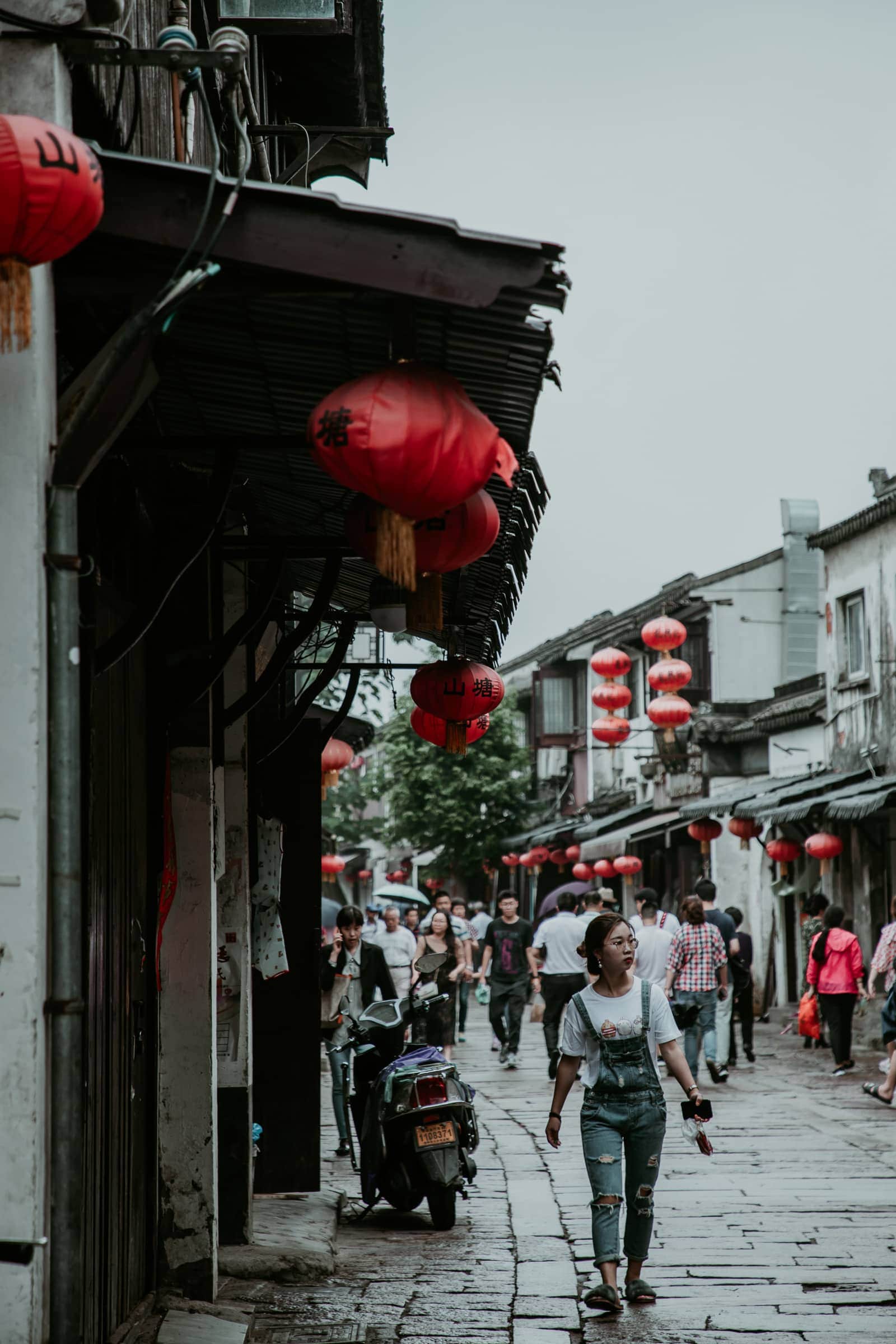
Advertising / *affiliate links
Even more authentic Chinese flair can be found on Pingjiang Road (Píngjiāng Lù) , similar to Shantang Street a street with many stores and restaurants. Here it is even a little bit more cozy than on Shantang Street. The boats are smaller, the bridges even a little prettier.
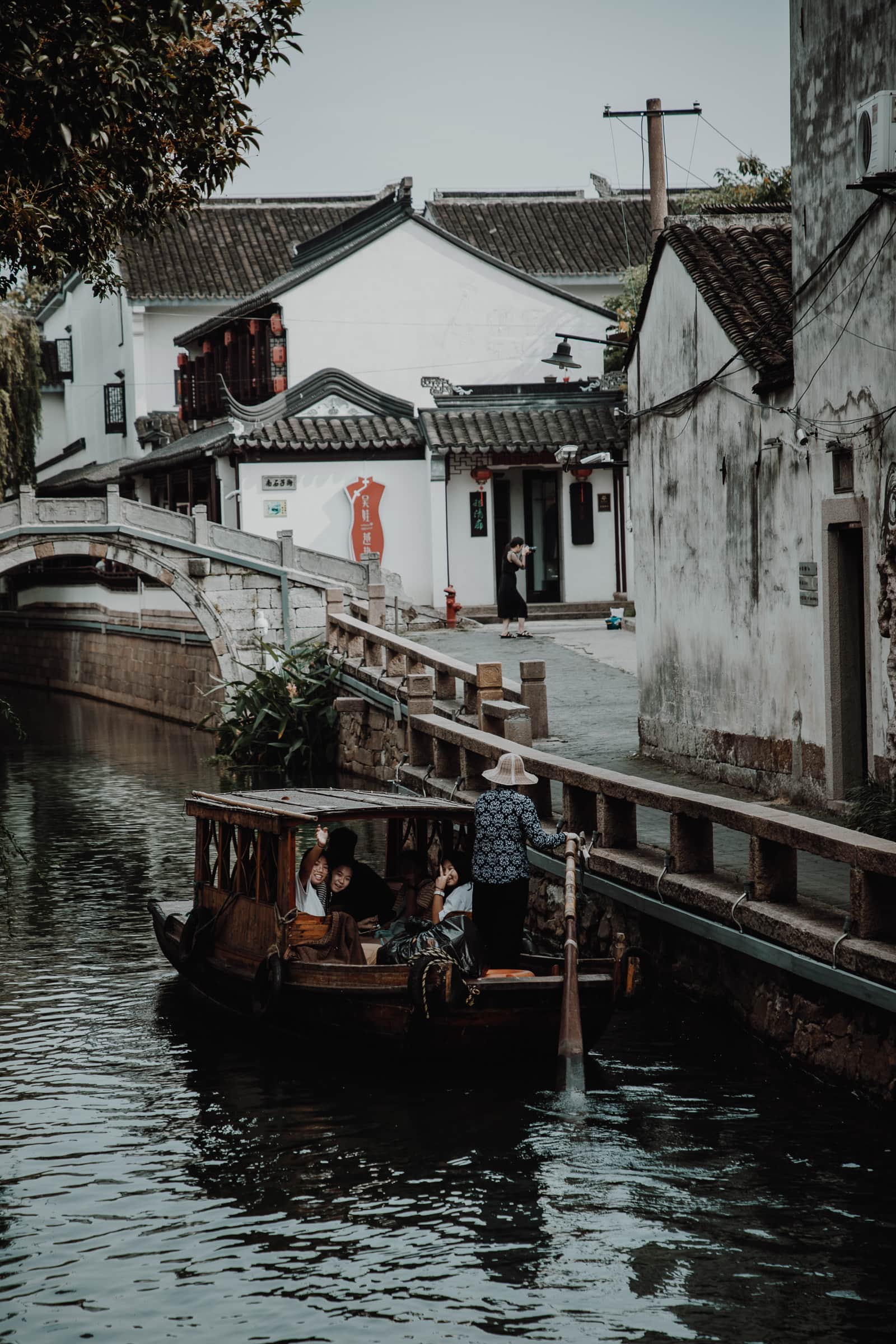
My highlight was the tea house, a small café by the canal, more wooden shack than house, where we listened to 80 year old(!) Mr. Wang playing original Pingtan music to us over a cup of tea. It could hardly get more Chinese! By the way, Pingjiang Road is also very busy in the evening and a nice nightlife spot in Suzhou.

Are you interested in China? Here you can find more articles about China!
In general, music, like all other arts, plays a major role in Suzhou. Somehow creativity and appreciation of art and culture are in the air here, so I wasn’t surprised to learn that Suzhou is considered a “very elegant” city in China. Found it apt – and I never thought before that I could find a place in China elegant. For me, China was big, crowded and rough at times – but this trip showed me once again how unfair prejudices can be. Suddenly China was small, picturesque and warm (oh, the people!).
I would even recommend an evening at the opera to anyone here, even if you are one of those people for whom operas are more likely to trigger flight impulses. Or where else do you watch an opera in one of the most beautiful gardens?

In the garden of the Master of the Nets there is a performance of a Kunqu opera every evening. The opera consists of several parts: Comedy, song, music and dance. The special thing: Each part is performed in a different place within the garden, so you walk along the garden between each performance.

Suzhou is famous for its silk – and the region has always formed one end of the Silk Road, from where the beautiful fabric found its way to the world. The silk factory, modestly named No.1, is therefore on the agenda of many tours of Suzhou. You should think about this carefully beforehand – because what many people don’t consider is that here you can observe the production process (at least part of it). That also means watching caterpillars crawl. And later it becomes even less something for the faint of heart, because the silk thread is obtained from the cocoon of silkworms. In order not to damage it, the cocoons including caterpillars are thrown into boiling water. Not for everybody.

Personally, I have an affinity for fabrics anyway (I actually used to have a fabric store in Berlin) and silk anyway (I always like to block out the boiled caterpillar part), so I found the visit interesting in itself. Unfortunately, the production process is shown only abbreviated (there is no weaving or dyeing here), and shortly after watching the spinning of the threads, you will find yourself standing in a huge sales hall with clothing made of silk for (almost) every taste. I didn’t like the clothes that much, but I was a bit sad afterwards not to have bought some fabric. So for all people who love to sew: In Suzhou, do not forget to buy silk!

The Suzhou Museum stands out mainly because of its architecture – somehow edgy and not at all traditional Chinese. It was designed by Chinese star architect Ieoh Ming Pei , who also planned the famous glass pyramid in the courtyard of the Louvre and the Museum of Islamic Art in Qatar, among others – and he was born and raised in Suzhou.

Here you will find an outline of Suzhou’s long history in the form of works of art and artifacts, from calligraphy to porcelain and handicrafts. Worth seeing, but perhaps not necessarily interesting for everyone. But what is really fascinating is the way the mostly Chinese visitors interact with the exhibition: I have never seen so many young people in German museums who are so intensely interested in history and who press their noses against the display cases out of sheer thirst for knowledge.

The modern part of Suzhou
Outside the sprawling old city, Suzhou looks a bit more like how you’d imagine big Chinese cities to look. The city currently has over 10 million inhabitants and as well as Suzhou is developing, there is no end in sight. Large companies produce and conduct research here. The proximity to Shanghai ensures that Suzhou is one of China’s up-and-coming cities. The spirit of optimism is also reflected in the bold architecture in the modern part: The landmark of the new Suzhou is the Gate of the Orient (Dongfang Zhimen) , the second tallest skyscraper in Suzhou. Located on Lake Jinji , it is supposed to act as a gateway to the East – but locals affectionately nicknamed the building “the pants” due to its unusual shape.

The “pants” are topped by the Suzhou Supertower , 450 meters high – and that’s where it really starts to look futuristic. Every time we passed it, I could hardly believe that just a few kilometers away we were sailing on small wooden boats along romantic canals. The way the old and the futuristic are combined here is breathtaking.
In the Suzhou Industrial Park there are further examples of modern Suzhou: The Suzhou Culture and Arts Centre is a gigantic cultural center with a (free) museum of modern art, various exhibition rooms, a musical theater and a small amusement park with a Ferris wheel, cafés and restaurants. In good weather, there is a fantastic view from here across Lake Jinji to the Suzhou skyline.
Shopping in Suzhou – shopping from silk to designer clothes
In Suzhou you can shop till you drop. I’ve long imposed a strict no-shopping policy on myself, which I usually stick to, because otherwise I’d be impoverished by now with all the traveling I do. My souvenirs are my photos – but in places like Suzhou, it’s pretty hard to contain yourself.
Popular souvenirs from Suzhou are silk in all variations, green tea (Bi Leo Chun), fans in all shapes, and lots of handicrafts like embroidery and fruit core carvings . On Shantang Street and around Pingjiang Road there are also a lot of small stores selling pretty hip handicrafts – no more boring tourist stuff!

I could have shopped myself to death at Chengpin Eslite , actually a huge bookstore. I have a thing for beautiful bookstores anyway, and this one is embedded in a state-of-the-art shopping center with countless small designer stores . I’m usually put off by shopping malls, but the Eslite reminded me a lot of trendy temples like Terminal 21 in Bangkok! Between the stores, there are always small snack bars and cafés, so you can sample all the delicacies of the region here if you don’t dare try street food.
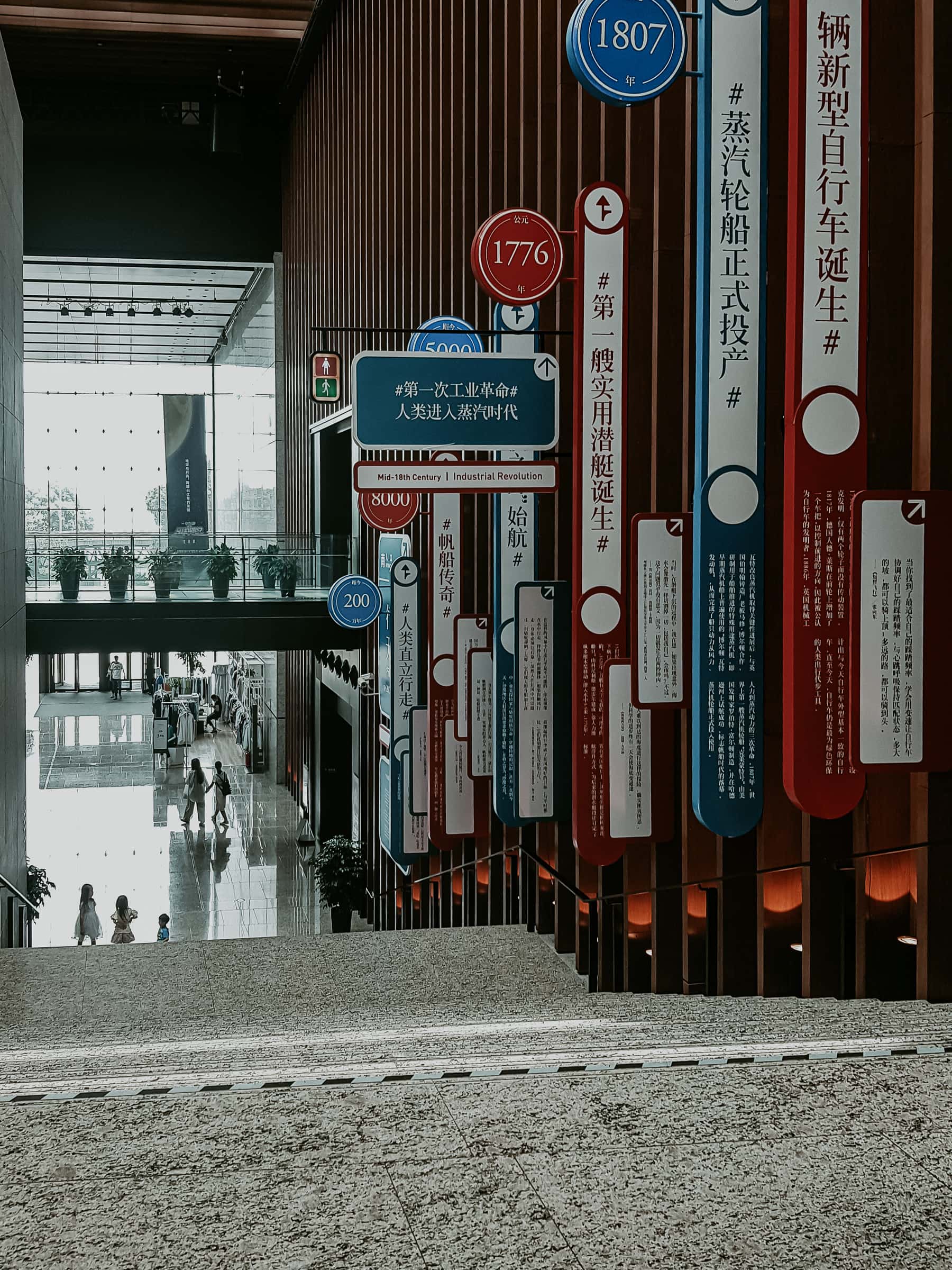
Food & Drink in Suzhou
Food in general can be quite exotic in China. And it has nothing whatsoever to do with the Chinese restaurant from the German provinces. Vegetarians often have a hard time, somewhere there is meat in it or seasoned with fish sauce. Meat eaters like me have to deal with the most off-the-wall dishes like duck tongues or braised offal . Basically, Western tourists are already careful not to offer the most unusual dishes, but due to communication difficulties, you should be prepared for anything.

The Jiangsu cuisine (this is the name of the province in which Suzhou is located) is so sophisticated and rich in variation that I often wished I could jump over my shadow even more and try dishes like Pig snout or Chicken feet Unfortunately, I couldn’t get over myself to do it. After all, if you’re going to eat meat, it’s only logical to use every piece of it. Especially the cuisine in Suzhou is a true paradise for gourmets!

Vegetarians don’t have to starve though, there are plenty of exotic ingredients to try like water asparagus , lotus roots or purple sweet potatoes . Not everything is spicy, but a lot is greasy and due to the foreign spices and the different climate, one or the other stomach needs some time to get used to the new cuisine. However, I have tried so many new and delicious things in the whole days that I can not even remember everything!
Dishes are always shared, which means if you sit in a big group, you can try a lot more!
Specialties of Suzhou cuisine
Sooner or later you will get it served in Suzhou, this specially prepared fish is THE dish in Suzhou. The fish is completely deboned, cleverly draped in the shape of a squirrel and then deep fried. Finally, a sweet and sour sauce is added on top, which took sweet and sour to another level for me!

Noodle soup is noodle soup you could say. But the fresh noodles at Zhuhongxing in homemade broth with tender beef were so divine that I still think about them sometimes. Tip: Don’t spend too long marveling at the food and enjoying it, because the noodles soak up so much broth in the bowl that the mountain of noodles gets bigger and bigger instead of smaller. The professional slurps quickly! (Don’t be afraid of table manners: Hanging over the bowl and slurping loudly is not seen as closely in China as it is here).

Dumplings in all varieties can not be missing! The Tangbao are again a special variety, filled with broth in addition to the mostly meat content. This is slurped out beforehand with a straw, similar to the xiaolongbao that exists in neighboring Shanghai.

Always dare to try street food ! Sometimes it can also be surprising, like the particle on the right, which I bought in a bakery. It looked delicious, so hairy breaded – but what I imagined was sweet ended up being a breading of finely ground pork. Wasn’t mine – but I still like to try strange things. The dumplings, however, were divine!
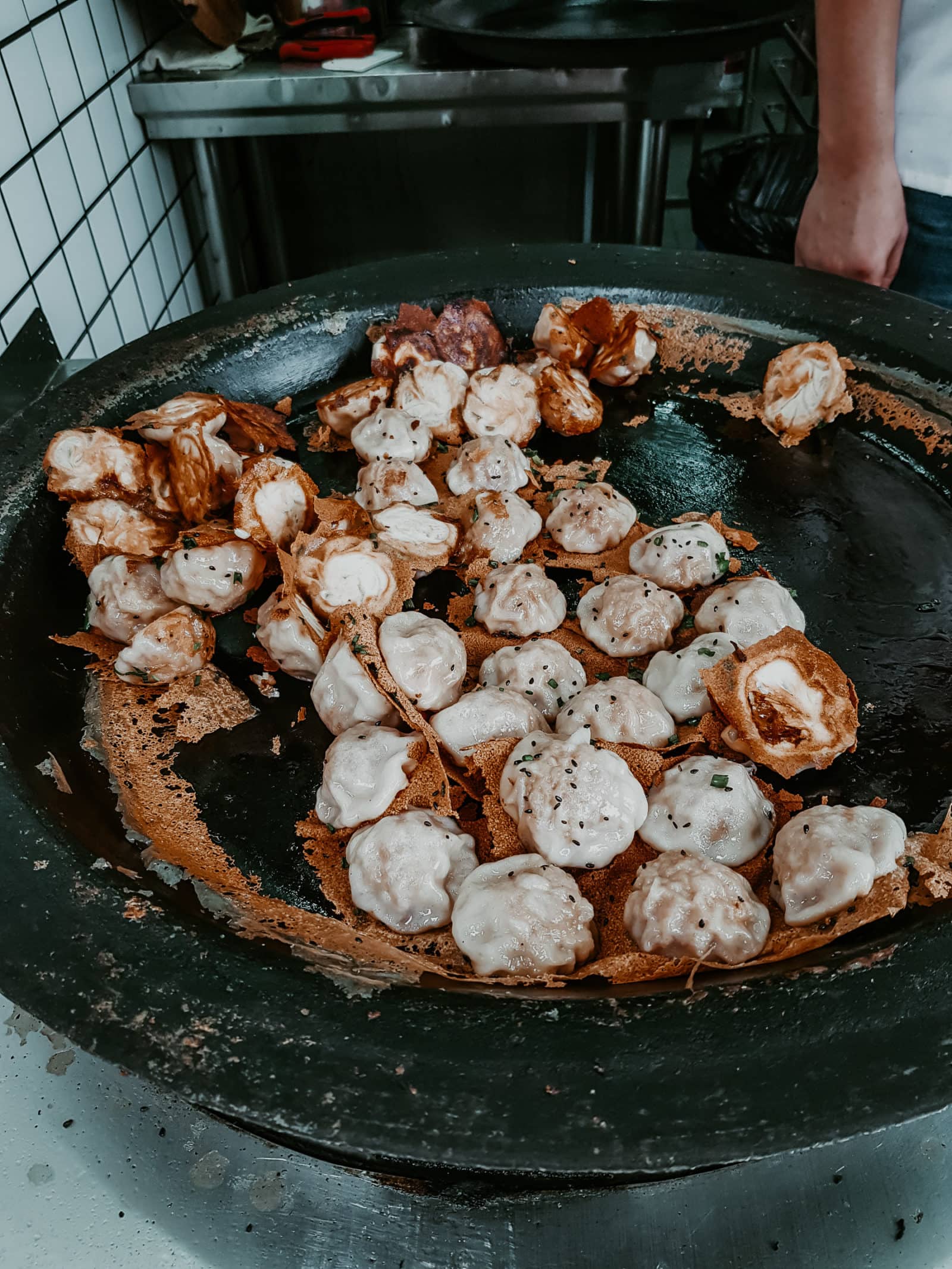
Our accommodation in Suzhou could not have been better. Centrally located, equipped with all the bells and whistles like a pool and tennis court, and with a breakfast buffet to die for, the Garden Hotel * was perfect. The hotel consists of several smaller guest houses and two main houses, nestled – it couldn’t be more fitting in the City of Gardens – in a beautiful, tranquil garden setting. If you want to treat yourself and stay in Suzhou in style: Absolutely recommended!
➜ Book a room at the Garden Hotel in Suzhou *
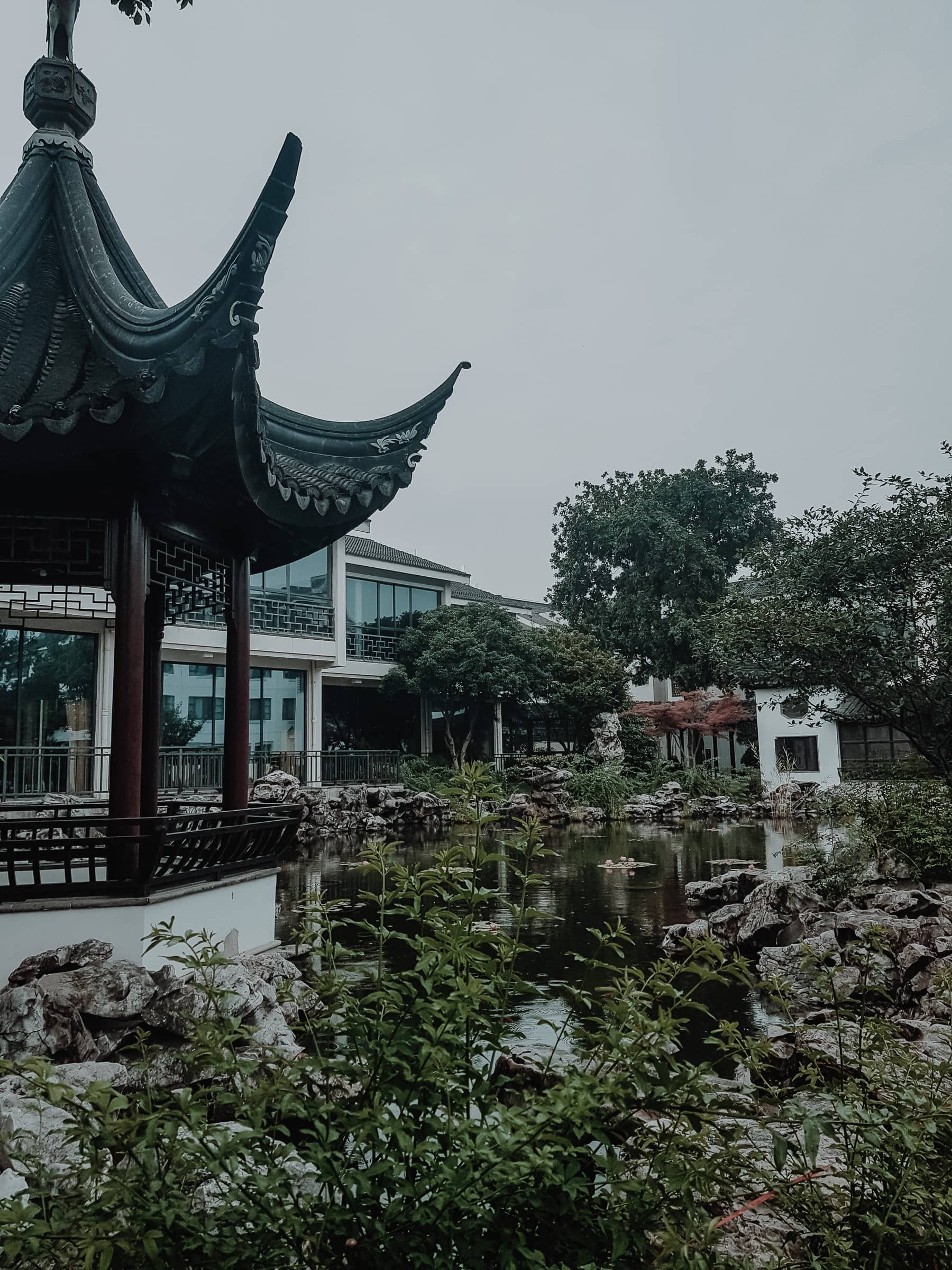
Travel & Getting around Suzhou: How to plan your trip!
Suzhou is located only 80 kilometers from Shanghai , and is directly on the express train line that runs from Shanghai to Beijing. So if you are in Shanghai for a few days, Suzhou is definitely a good choice for a multi-day trip: by train you can be in Suzhou within 90 minutes.
Shanghai is very beautiful, but I personally find Suzhou much more appealing from a historical and cultural point of view – and always only mega big cities can also be very exhausting. By the way, train travel in China is a thousand times more organized than I thought. However, there may be communication problems here as well, since English is not widely spoken.
➜ Here you can book a full day tour by high speed train from Shanghai to Suzhou * (incl. guide, train tickets, entrance tickets and lunch on site).

We were traveling in a small tour group , and although I usually travel individually in Asia and plan everything myself, I was sometimes glad to have a tour guide with me, who explains a lot and can translate in case of need. Especially because the region around Suzhou is not yet very familiar with western tourists, not much English is spoken and in most of the sights there is no information in English, so you are denied a lot of interesting information.
Complete China tours are often very expensive, and honestly, you can book a flight to Shanghai and spend a few days there on your own. For more “exotic” destinations like Suzhou, however, you can book individual modules with China Tours , which I can really only recommend.
We wore out three guides during our trip through several places around Shanghai, all of whom were highly professional, even spoke very good German (!) and had absolutely in-depth knowledge on every topic. Especially with such a complex destination as China with so much culture and history, about which I admittedly didn’t know very much beforehand, professional guidance was worth its weight in gold.

If you prefer to travel individually, you can take a cab or one of the tourist bus lines for longer distances in Suzhou. There are rental bikes in many places. The subway network is being expanded.
I really liked Suzhou and often wondered why it is almost unknown among Western tourists. Especially when you visit Shanghai, a trip (sporty people can do it in one day) to Suzhou is a must. Shanghai is fascinating, but I always missed a little patina there. This can be complemented well with a side trip to Suzhou! Also, the city is much more relaxed and everywhere you are warmly welcomed as an exotic tourist from the West, which showed me again a whole new side of China.
All articles about China at a glance:
- Shanghai Tips: First time in China
Hong Kong: A Typhoon, the Peak Tram and a Skyline
5 tips for hong kong in 24 hours, best things to do in zhouzhuang, china.
- Mutianyu: From Beijing to the Great Wall of China
Disclaimer: I was invited on this trip by the Tourist Offices of Suzhou and Nanjing and China Tours . Thank you very much!
Ähnliche Artikel
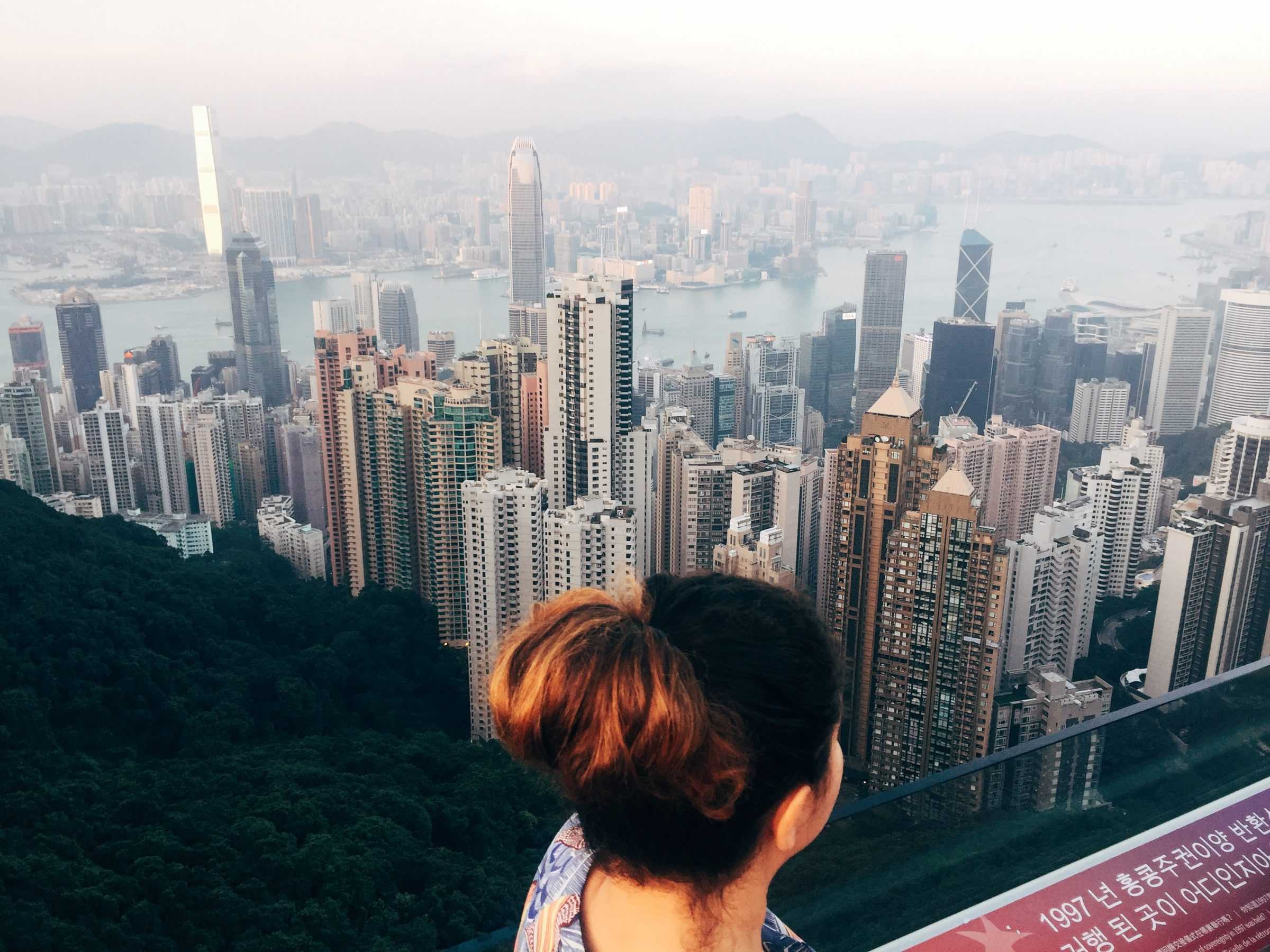
Leave a Reply Cancel Reply
Your email address will not be published. Required fields are marked *
Name *
Email *
Post Comment
What To Do Suzhou – The Ultimate Travel Guide To Plan Your Trip

For centuries Suzhou has been the hub of elegance, high culture, and the silk trade in China . Suzhou still stands today as a testament to the beauty of the past despite many of the areas are now becoming urbanised. In fact, Suzhou has a booming modern economy and many people have their eyes on the city for development.
Masterfully blending the old and the new, there’s enough to do to fill around three days. It also makes a great day trip or overnight stay from Shanghai. Suzhou is a perfect escape from city life and offers a great deal for photographers, art lovers, and foodies.
The old town areas, canals, and traditional waterside architecture are perfect for wandering around and getting lost in. Whereas, the nine famous UNESCO heritage gardens are a tranquil and stark contrast to urban city life in modern China. Suzhou is a must-visit city in China with a lot to offer visitors despite its relatively small size.
How To Get To Suzhou
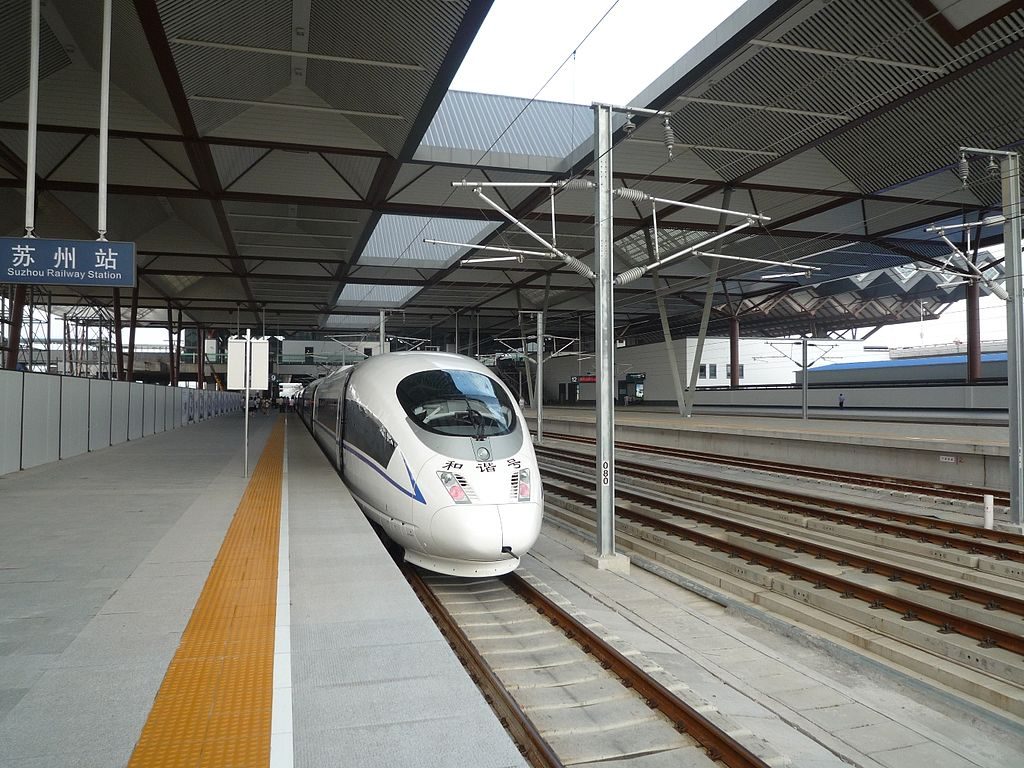
Getting to Suzhou is very convenient, particularly if you arrive at the more central Hongqiao airport which is nearer to the train station than Pudong airport. Either way, it won’t be a problem as you simply hop on the subway until you reach Hongqiao train station (line 1, red).
From there you can buy a single or return ticket to Suzhou at the ticket counter. There are trains running every half an hour so there’s no need to pre-book unless you’re travelling on a major public holiday. (Even then you should be fine). Take your passport, they sometimes ask for it.
It’ll take about half an hour on the bullet train and will cost around 7 USD. Public transport is excellent quality in China and reasonably priced. You’re guaranteed a seat and the journey is a smooth and pleasant one. There are two stations in the city: Suzhou Train Station which is the most central and Suzhou North Station. You’ll want the central one.
Once you’re in Suzhou, an easy and inexpensive way to get around is using taxis. Just have the Chinese address written down or the name of the place you want to go, if it’s a tourist attraction. There are also plenty of buses running to everywhere you need to go and two subway lines. Make sure you check which bus number you need in advance if you’re considering the buses.

Where To Stay In Suzhou
There’s an option for every budget in Suzhou, from traditional spaces, to more modern and boutique hotels. Luckily accommodation is relatively inexpensive to other parts of East Asia so you get more for your money.
Mingtown Youth Hostel
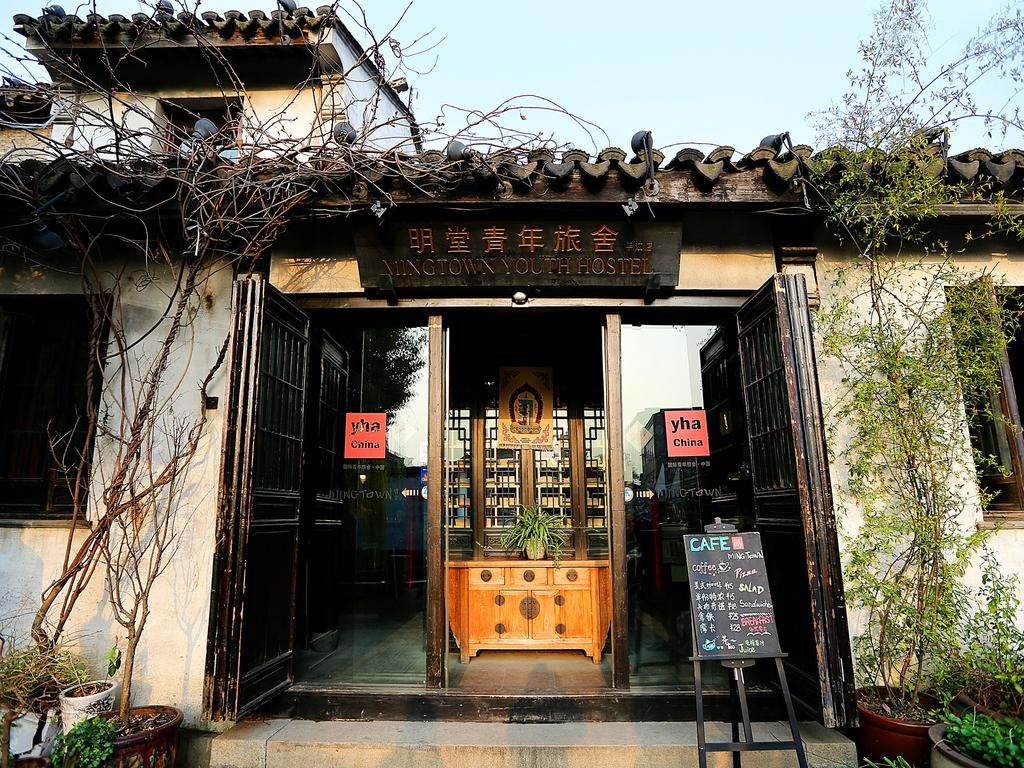
With beautiful private and shared rooms, you can stay in the very heart of Suzhou in a traditional Chinese building for budget prices. All of the main attractions are within walking distance as you’ll be based on Piangjian road, the main tourist street where most of the beautiful canal pictures are taken. They have a restaurant on-site but you’re also near to street-vendors and local restaurants. You can’t beat this for price, location, and traditional aesthetics.
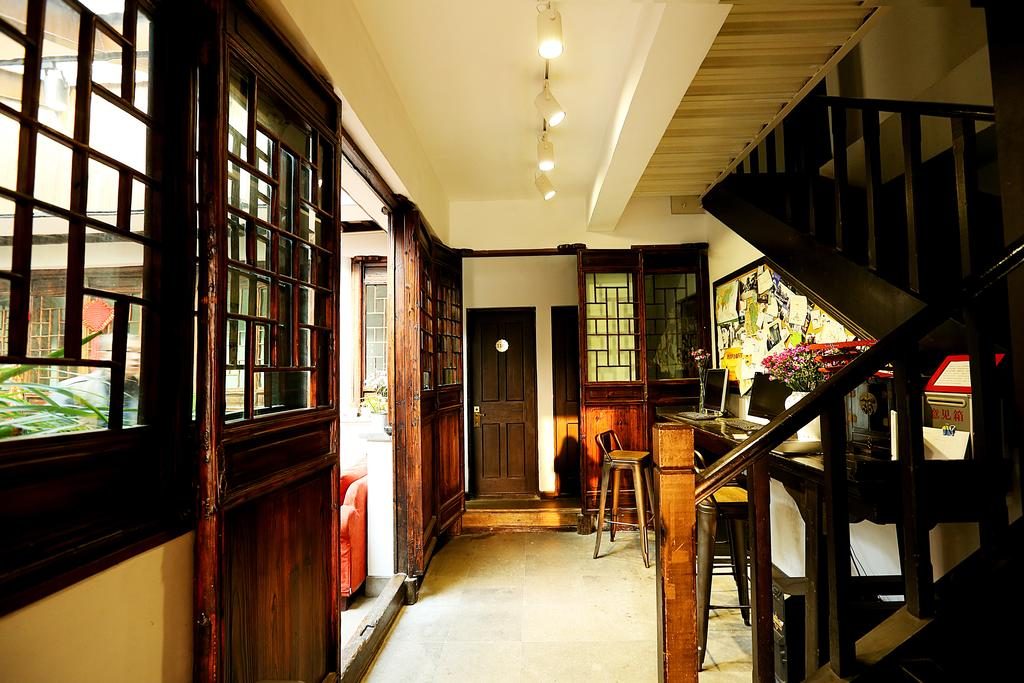
Book here : Mingtown Youth Hostel
Tongli 1917 Best South Boutique Inn

This more luxurious stay is particularly special as you’re actually staying inside one of Suzhou’s famous gardens in the historic area of Tongil. The whole interior and surrounding area make you feel like you’re living in historical China.
From the antique wooden furniture in your room to the canals, gardens, and historical buildings all around you. The owners are lovely and go out of their way to make any stay special. A traditional and western breakfast is provided and the facilities in the rooms are excellent.

Book here : Tongli 1917 Best South Boutique Inn
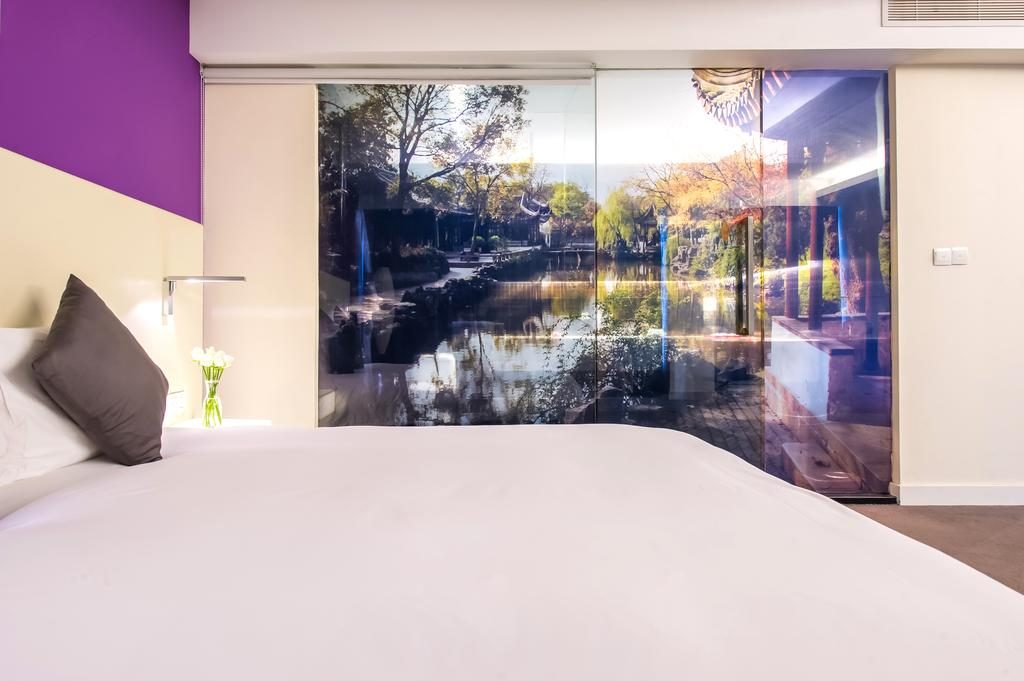
For those looking for a more modern style but still within the convenience of the old town, look no further than Hotel Soul. An on-site gym and restaurant, combined with excellent room facilities, and an ideal location make this a perfect modern choice for your stay. It’s also very near the subway, Suzhou rail station, and the hotel offers a free shuttle service to The Humble Administrator’s Garden.
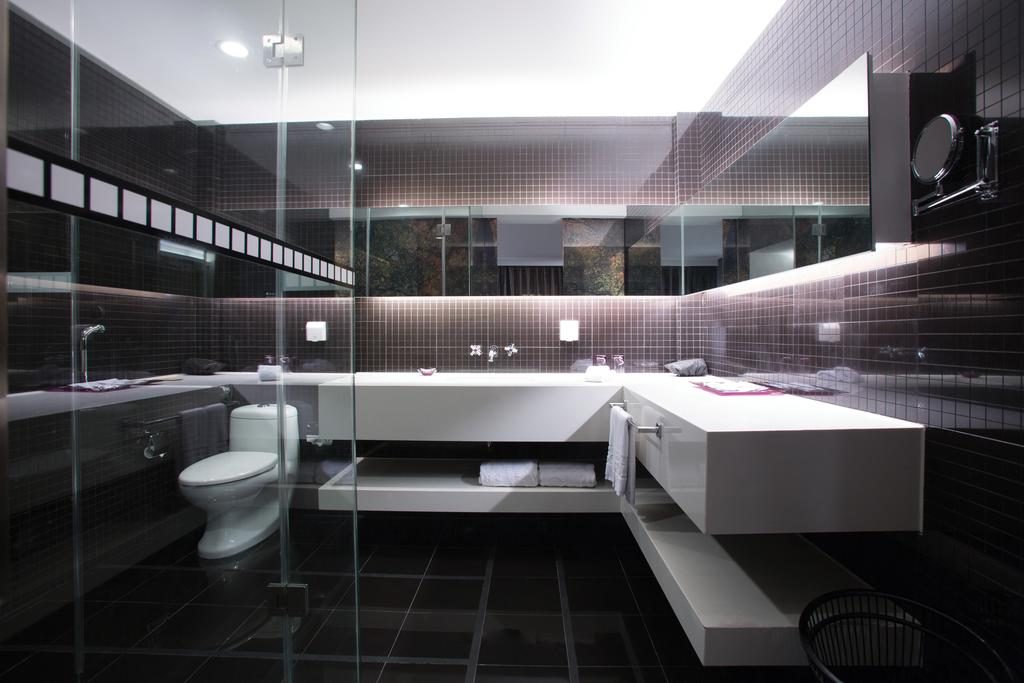
Book here : Hotel Soul
For more info and practical tips about travelling to China, you can also check out this blog post: How to plan a trip to China .
The 10 Best Things To Do In Suzhou, China
1. visit one of the 9 unesco classical gardens .
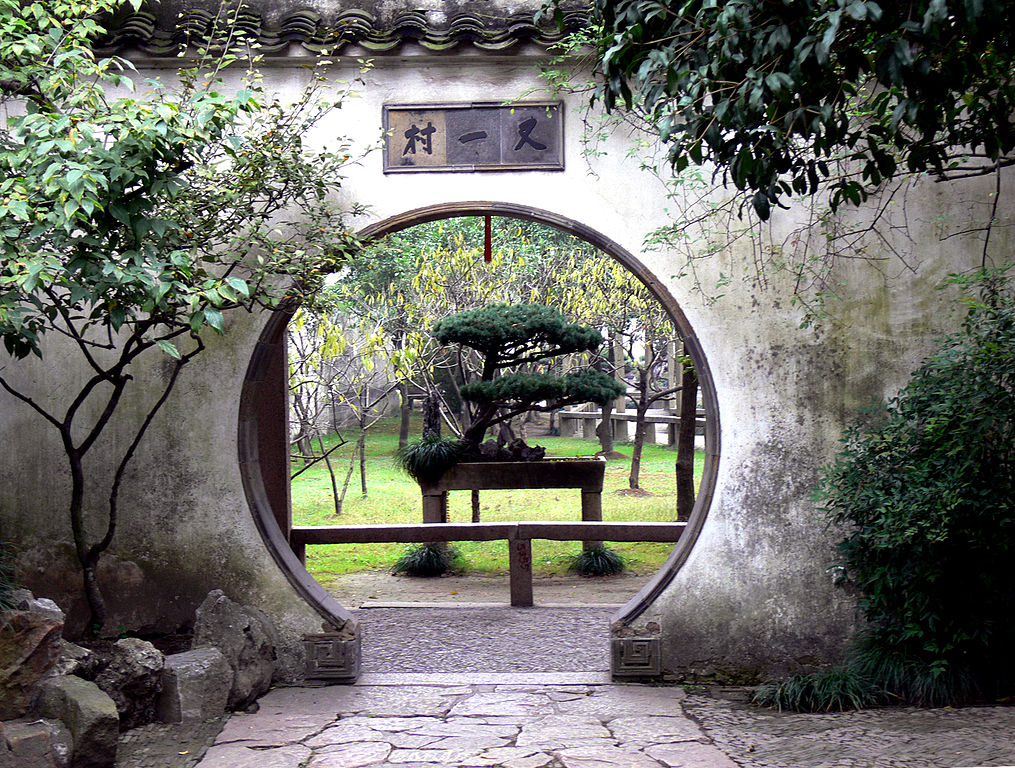
Suzhou is renowned of its gardens and this was recognised by UNESCO in its ‘Nine Classical Gardens of Suzhou’ . They’re all beautiful in their own way but the main features that you’ll find in all of the gardens are pavilions, flowers, water, and bridges. They’re wonderfully romantic and each one could be a Chinese painting of old time.
The Humble Administrator’s Garden, The Lion Forest Garden (named due to the vaguely lion shaped rocks you can find there), and the Lingering Garden are the most popular. The gardens are one of the main reasons to come to Suzhou and they attract thousands of visitors a year. Try to see at least two to take in the different vibes. Luckily, most of them are very close together so seeing more than one isn’t going to take up too much time.
2. Take a Stroll up Tiger Hill
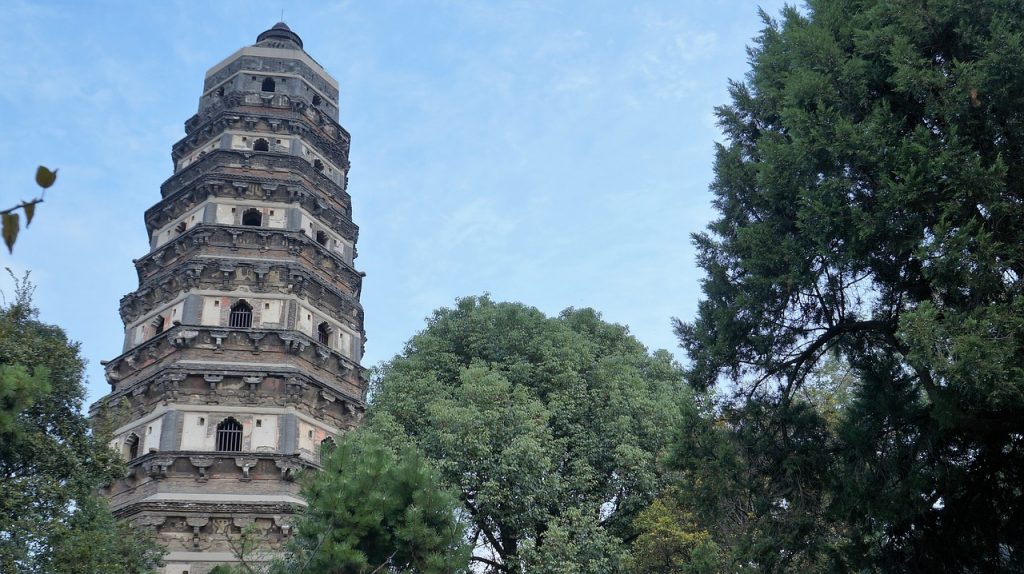
The beautiful pagoda on Tiger Hill has been compared to The Leaning Tower of Pisa in Italy and is well-worth a visit, even if only to compare the two. The bonsai gardens around the area offer gorgeous views, and the old Chinese architecture make this a must-visit on any trip to Suzhou. You can also go for a walk around Sword Pond which is supposed to be the resting place of 1000 buried ancient swords and is very scenic. The entrance fee is 80 yuan and open 7:30am-5:30pm. It’s not far from the Lingering Garden and The Humble Administrator’s Garden so you can easily combine these activities.
- Location : 8 Mennei Street, Huqiu District
- Access : Take bus 32, 146, 816, or 949 and get off at Huqiu Station.
3. Enjoy Tongli Ancient Town

Tongli is gorgeous and definitely not a place you should leave off your Suzhou itinerary. You could call it a condensed version of Suzhou as you’ll find beautiful gardens to visit, the famous three bridges (named peace, good luck, and celebration in Chinese), and beautiful old architecture at every turn.
You can also try most of Suzhou’s delicacies here, including: dimsum, fried eels with sauce and delicious sticky rice pudding. This is a perfect area to visit if you have limited time in the city.

You can actually take a bus from Shanghai to Tongli if you really don’t have much time in Suzhou, it takes two hours and return buses are around 4pm.
4. Visit Zhouzhuang Watertown

This beautiful area serves as a reminder of the many water towns that existed in China in the 14 th century. Over 800 people still live in there and preserve the town using old customs and local practices. This area is perfect for beautiful pictures that capture the feeling of old China.
Apart from the scenic canals, you’ll also find the famous ‘twin bridges’ here, traditional houses that you can look inside, and plenty of tea shops, local eateries, and souvenir shops to keep you busy. It’s actually on the road between Shanghai and Suzhou and is deemed to be the best water town in China.
While we speak about Shanghai, if you are planning to visit that city with kids, make sure to check out this blog post: Ultimate guide to Shanghai with kids .
5. Wander at Pingjiang Road
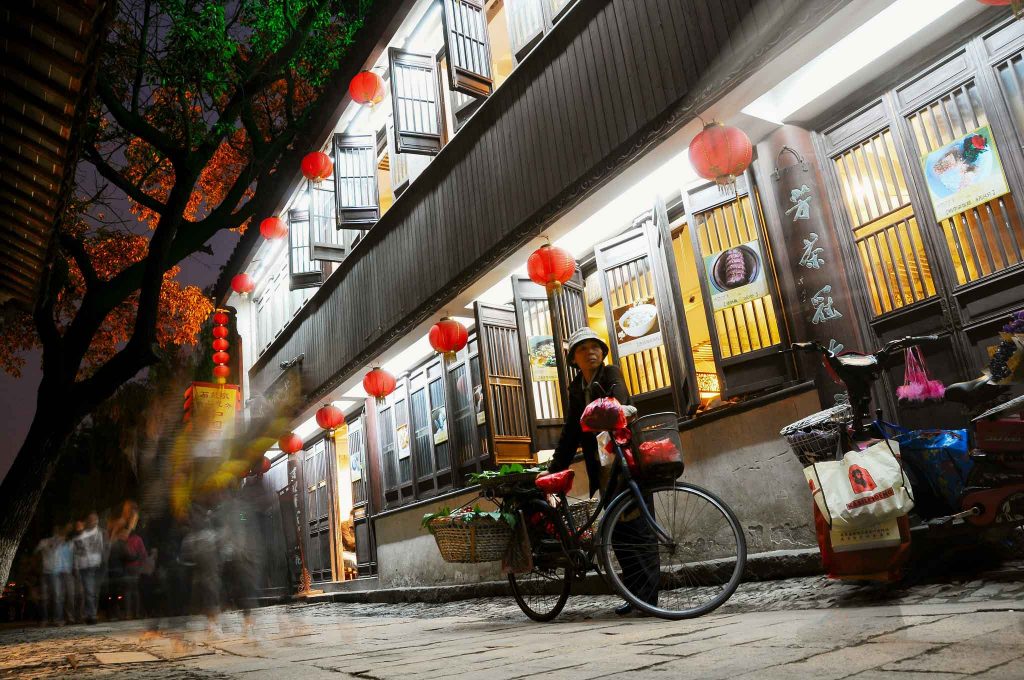
This is the centre of Suzhou’s cultural life, and one of the main attractions for tourists visiting the area. A beautifully quaint road lined with bookshops, eateries, and local opera theatres. You can find delicate handmade dumplings in animal shapes, take pictures on the bridges, buy handmade good and souvenirs, drink tea and coffee, and generally enjoy the bustling atmosphere. This one of the favourite spots among guests and locals, and for good reason.
6. Discover Chinese history at Suzhou Museum
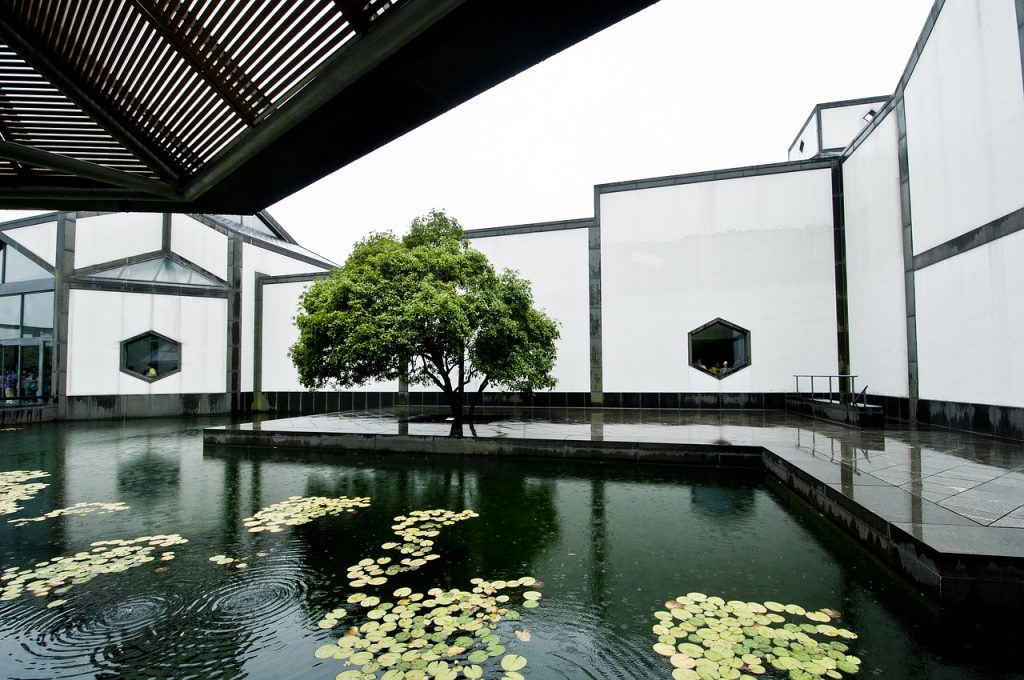
Designed by famous architect Leoh Ming Pai, this museum is a hub of Chinese history featuring over 15,000 pieces. You can view cultural relics including: ancient Chinese art, calligraphy, gold, silver, and jade items. It also takes you through Suzhou’s history within China. Descriptions are in English and Mandarin. Blending the modern and the old this museum uses technology and excellent design to make sure you leave entertained and with a greater knowledge of Chinese history.
- Location : 204, Dongbei Street, Pingjiang District
- Transportation : buses 112 and 202 can take you there
- Opening times : 9:00am-5:00pm except Mondays
7. Eat at De Yue Lou Resturant
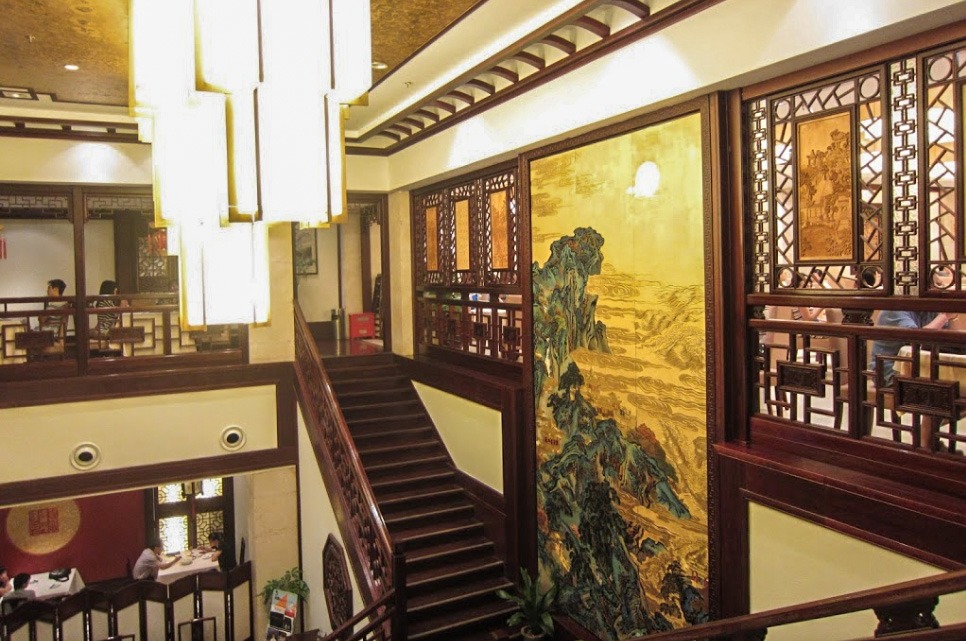
This beautiful restaurant has a long history of several hundred years and dates back to the Ming dynasty. This is the perfect place to try Suzhou’s local cuisine and visit one of the most famous restaurants in China at the same time.
The interior is a traditional Chinese setting but is a bit more up-market than you’ll usually find. Luckily the menu price offers as many affordable dishes as more expensive. Some must-try dishes are: De Yue spring chicken, squirrel-shaped mandarin fish and ham sliced in honey sauce. They have an English language menu
Address : No.27 Taijian Lane, China
8. Try Watermelon Chicken
One of the more unusual dishes that is unique to Suzhou is watermelon chicken. It’s exactly how it sounds, braised chicken that is marinated and served in a watermelon. Whereas most foods on offer in Suzhou are spicy, the result here is a sweet and savoury soup that is delicious on its own or with rice. The chicken is well-cooked and just falls off the bone. It also makes for some great pictures.
9. Visit The Bookworm
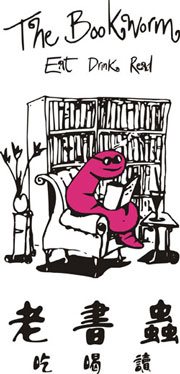
The Bookworm is one of the most popular eateries to stop at, particularly if you’re a book lover. They brand themselves as a literary bar and event space and they often host fantastic evenings including: book readings, pub quizzes, and music. They’re also involved in the organisation of the local literary festival. Even if you’re not looking for events, this is a great place to stop since their menu is fantastic – a delicious mix of Western and Chinese food. They have an extensive drinks menu and some of the best coffee around.
As expected, you’re surrounded by books and cosy nooks to relax in.
Address : 77 Gunxiufang, Shiquan Jie
10. Go Biking around Yangcheng Lake
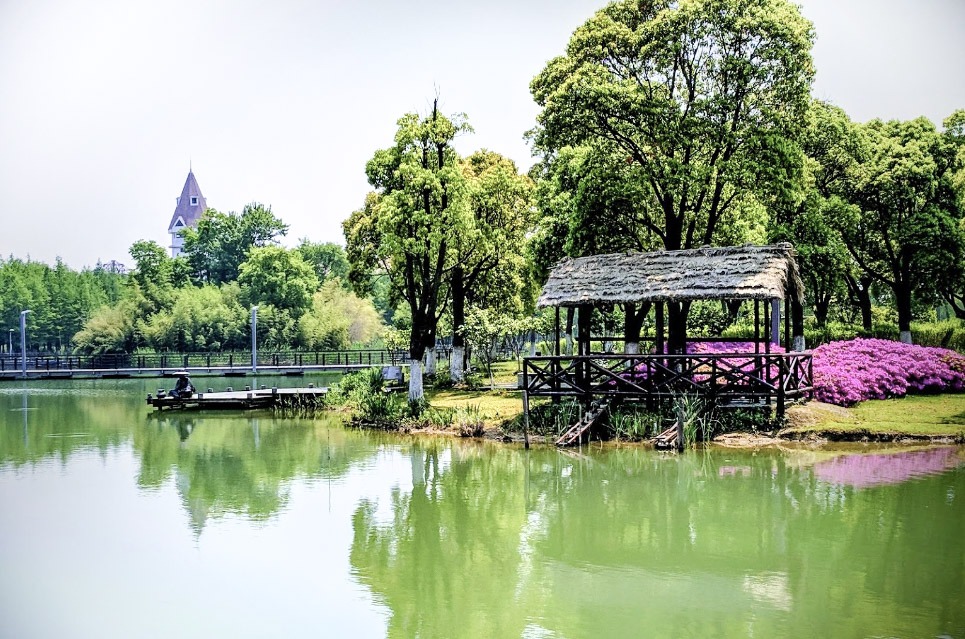
Yangcheng Lake is a great day trip from Suzhou if you have some extra time. Walking around the lake is lovely in itself but if you enjoy cycling then you’re in luck as there’s plenty of places to rent bicycles around the lake. It’s also where the famous Yangcheng ‘hairy crabs’ come from that are quite a delicacy around China. Take in the serene views and get some exercise at the same.
Access : take the minibus Suzhou-Kunshan at Suzhou North Bus Station. Get off at Kunshan and then take bus No. 107 or 118.
Suzhou offers a lot of options for those hoping to explore some of ancient China and don’t want to travel too far. It’s just a stone’s throw away from the buzzing mega-city that is Shanghai and offers stark contrast to the urban jungles around it. Suzhou is also a good hub if you’re carrying on to other parts of China thanks to the bullet trains. Come to Suzhou for the gardens, the excellent food, and the boutique shops where you’ll never know what you’ll find. Visitors can enjoy some peace, tranquillity, and some of the most beautiful natural scenes in China.
PS : For more travel inspiration, feel free to check out these blogs posts: China Travel Blog .
Thank you! This travel guide is very helpful.
Leave a Reply Cancel reply
Your email address will not be published.
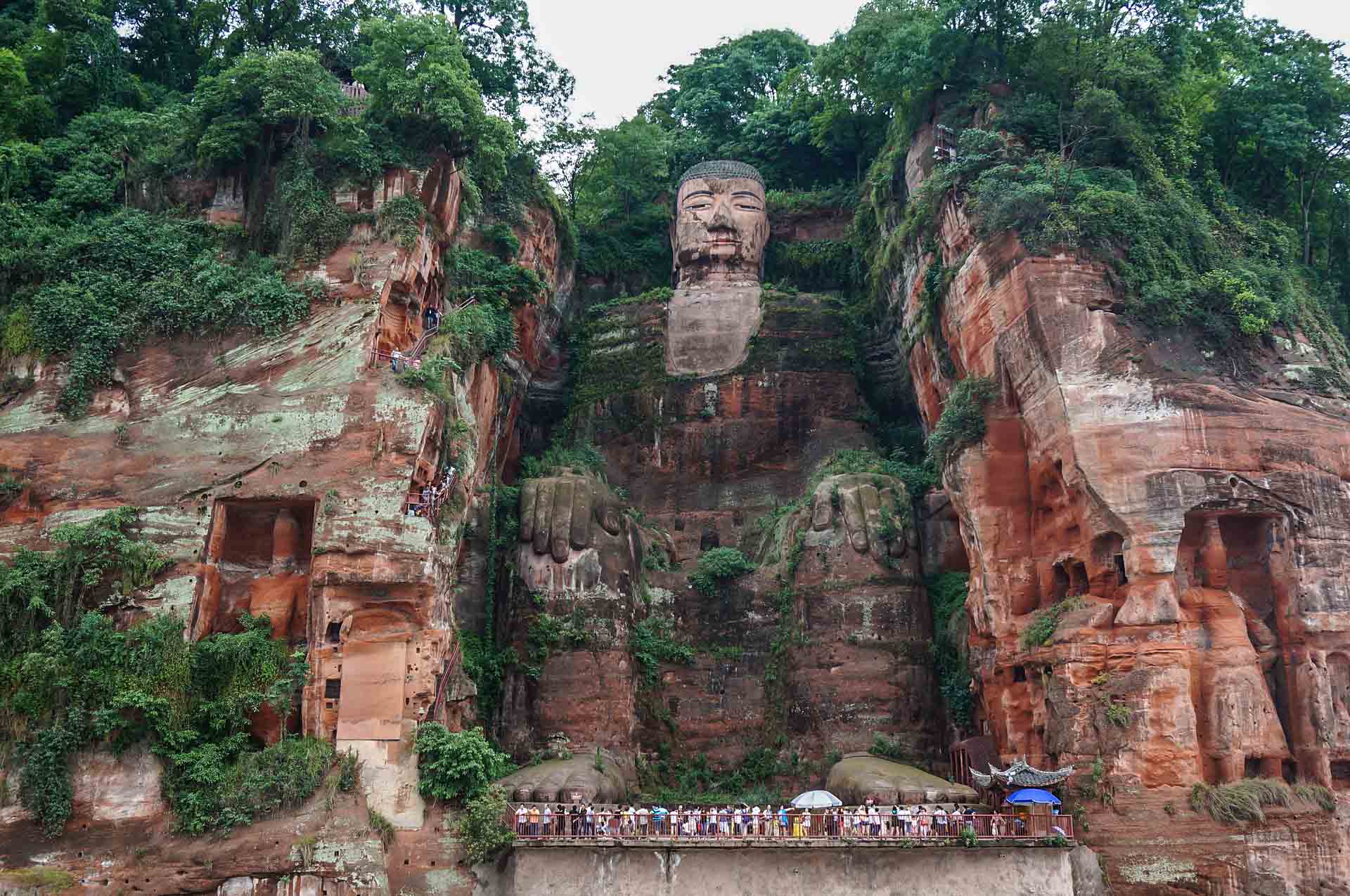
What To Do In Chengdu – 8 Unmissable Things To Do In 2024
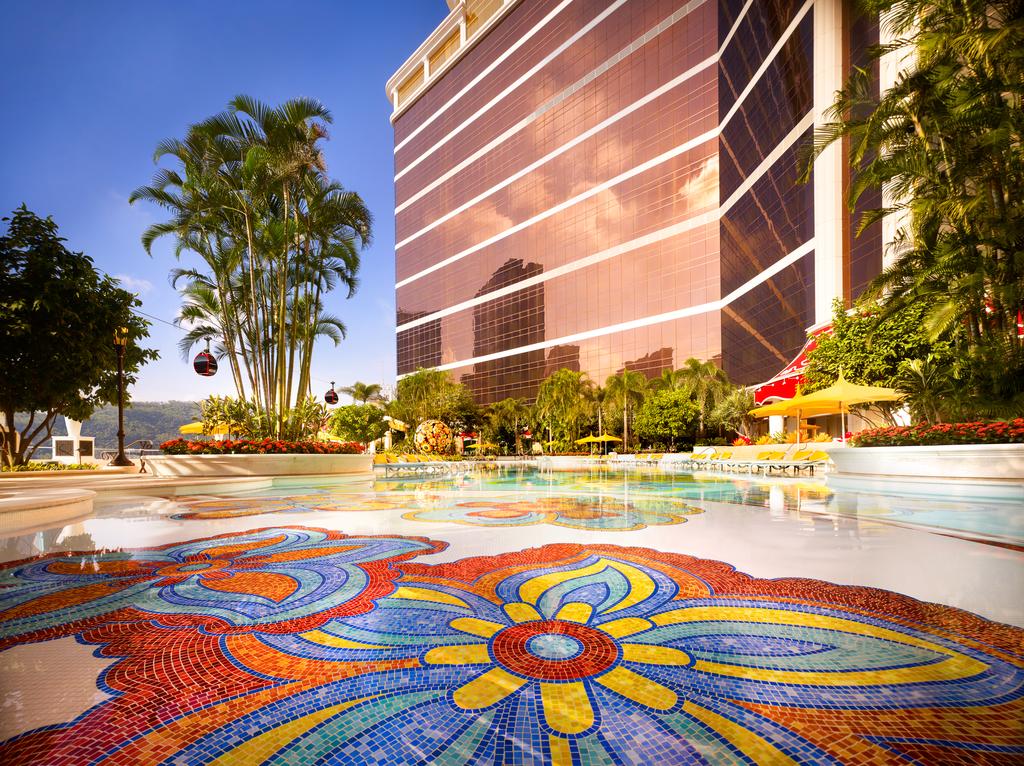
The 10 Most Beautiful Luxury Hotels In Macau You Should Book In 2024

The 15 Best Chinese Fantasy Dramas You Should Watch In 2024

The 10 Best Chinese Historical Dramas You Should Not Miss Out

The 15 Best Chinese Action Dramas You Need To Watch In 2024
- Car Rentals
- Airport Transfers
- Attractions & Tours
- Bundle & Save
- Destinations
- Trip.com Rewards
Suzhou Travel Guide 2022
1. Things to know if you're visiting Suzhou for the first time
2. how to get to suzhou from shanghai airports, 3. transportation in suzhou, 4. best time to visit suzhou, 5. top 3 attractions in suzhou, 6. food in suzhou, 7. shopping in suzhou, 8. local customs in suzhou.
Show More
In China, Suzhou is synonymous with classical Chinese gardens, but this “Heaven on Earth” has so much more to offer. In the past, it was the home of high culture and sophistication, generations of scholars and artists drew inspiration from its natural and man-made beauties. Today visitors to modern Suzhou are still being wowed by its picturesque canals and ancient temples while enjoying contemporary comforts.
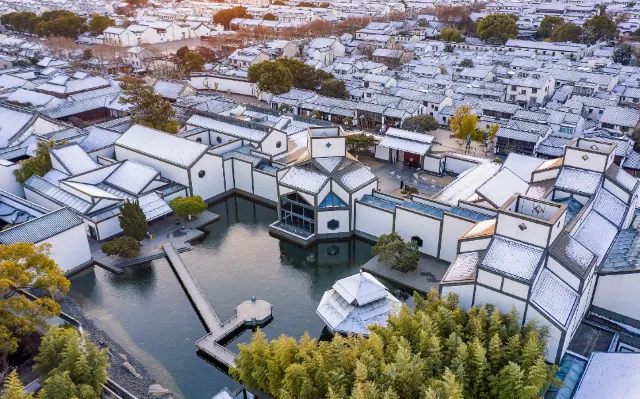
Suzhou is a major city and one of the oldest in the Yangtze Basin. Located in the south of Jiangsu province, it is surrounded by the Yangtze River in the north, Shanghai in the east, Lake Taihu in the west, and the ancient city of Hangzhou in the south. Celebrated for being a city of water, Suzhou has many waterways, streams, and water towns. The city is divided into 5 Urban Districts (Gusu, Wuzhong, Xiangcheng, Huqiu, and Suzhou Industrial Park) and is surrounded by 5 county-level cities.
Constructed in 514 BC, Suzhou has a long history of over 2500 years. Reaching its golden age in Ming and Qing Dynasties, today the city is one of the most developed in China. Beyond Suzhou’s economic significance, it is also the birthplace of Wu Culture which had a special contribution to Chinese culture. For visitors interested in unique local cultural heritage, watch a Kun Opera (Kunqu) performance, learn about silk production in the silk capital of China, or enjoy an ancient form of storytelling called Pingtan.
There are so many first-rate scenic spots in Suzhou, it is impossible to see them all if you only have a short time. Why not start with the astonishing 9 UNESCO World Heritage sites dotted around the city? Humble Administrator’s Garden, Lingering Garden, and Master of the Nets Garden to name just a few. Other amazing experiences visitors can have include a relaxing stroll around Pingjiang Road and its canals, visit the No. 1 Water Town in China – Zhouzhuang, and hike the serene Tianping mountain.
While Suzhou does not have a large airport of its own, visitors can arrive by air at Shanghai ’s Hongqiao International Airport (SHA) or Pudong International Airport (PVG) and then take the train directly to Suzhou. Otherwise, it can be directly and easily reached by high speed and regular trains from all over the country. For getting around town, the metro, SND Trams, taxis, and special sightseeing buses are all affordable transportation options.
For anyone visiting Suzhou for the first time, the city’s historical and cultural richness certainly will not disappoint. But knowing when’s the best time to visit can definitely enhance to experience. Spring and Fall are the peak visiting seasons when Suzhou has the most pleasant weather. Sunny days and mildly warm temperatures are perfect for exploring the city’s many world-famous gardens and water towns. Note that national holidays in May, October, and Spring Festival periods will be extremely crowded.
Now you know when to go, but what about where to stay? Depending on the purpose of your visit, here are a few popular areas to consider. If you want to be in close proximity to top attractions, historic architecture, and a wide range of food and shopping venues, the Guanqian Street in the central Gusu District is a suitable option. Want to stay on one of Suzhou’s famous canals? Pingjiang Road is lined with old traditional-style buildings that have been converted into restaurants, cafes, and trendy shops. This is a great location to hop on a boat tour or take a relaxing stroll down the canal. For a quieter environment or for budget travelers, Wu Jiang District has less crowded streets and gives visitors the opportunity to immerse themselves in the local culture.
Suzhou is a great place to pick up a few souvenirs to remember your China trip. Top-quality local special products are plenty here, such as fine-quality silk, Suzhou embroidery, Biluochun green tea and Suzhou writing brush, etc. A tip on shopping: when buying specialty items like silk, jade, or tea that are pricy, it is advisable to have a local Chinese-speaking guide with you or purchase from official museums, department stores, or factory outlets to ensure quality. Also as with anywhere in China, bargaining is a normal practice.
While Suzhou is a popular tourist destination and major economic center in China, the city does not have its own airport. The closest airport is the Sunan Shuofang International Airport (WUX) which is 22 km (14 miles) away or 30 minutes by car. But it is a small size domestic airport with no direct nonstop flights from the U.S. or other international destinations.
That’s why those who do fly tend to prefer the nearby Shanghai Hongqiao International Airport (SHA) or Pudong International Airport (PVG) and then take the train directly to Suzhou. Both of these airports in Shanghai are major international airports easily reached from all over China and the world. Once arrived at either Shanghai airport, passengers heading to Suzhou can use many transportation options like a train (regular and bullet/high-speed trains), shuttle bus, or taxi. Out of the two airports, the most convenient is Shanghai Hongqiao International Airport (SHA). The airport's Terminal 2 is walkable from Hongqiao bullet train station which has trains that stop at Suzhou’s two bullet train stations (30 minutes journey). If you arrive at Pudong International Airport (PVG) out of necessity, factor in roughly an hour additional travel time as you’ll need to first travel across Shanghai to reach the bullets train station that links Suzhou.
Other transport options from Shanghai to Suzhou include regular trains which will take 90 minutes, long-distance coaches (Suzhou South Gate Station) that take a minimum of 90 minutes, and taxis (approximately 75 to 105 minutes). There are two additional airports: Hangzhou Xiaoshan International Airport and Nanjing Lukou International Airport, which also have transfer options to Suzhou.
Instead of flying, traveling to Suzhou by train from other parts of China is also a convenient option. In addition to numerous regional and local trains, visitors can reach Suzhou quickly via bullet / high-speed trains from Beijing in 5-6 hours (or 13-21 hours by regular train), or from Xi’an in 6-10.5 hours (or 14-23 hours by regular train).
As one of the most developed cities in China, Suzhou has a comprehensive public transport system that ensures convenient and affordable travel for residents and tourists. Because the city attracts millions of visitors each year, the local government authorized five special sightseeing bus routes (Y1, Y2, Y3, Y4, and Y5) to allow easy exploration of many scenic spots.
For example, Route Y1 departs from Suzhou Railway Station to Humble Administrator's Garden (Zhuo Zheng Yuan), Lion Grove Garden, and Silk Museum;
Route Y4 hits destinations like Beisi Pagoda, Ancient Town of Mudu, and Taiping Mountain.
Most fares start at 2 RMB and all routes depart from the Suzhou Railway Station (27 Chezhan Road, Gusu). It is worth noting that, there is no fare collector on the bus, so ensure that you have loose change before boarding.
Suzhou has a modest-size Metro system with 4 lines and 38 stations, but plans for more lines are in the works. The ticket price ranges from 2-8 RMB according to the distance traveled. In addition, there is also the SND Tram which operates 2 tram lines in Suzhou, the fare is 2 RMB per person for a single ride.
If traveling by taxi is more your style, you’ll be happy to hear that finding a taxi in Suzhou is generally very easy, though it is still good to avoid rush hours. All taxis are metered and the starting fare is 10 RMB. Taxis can be flagged down on the street, and an available taxi can be identified when the dash light is lit in green. As taxi drivers rarely speak or read English, so it is best to prepare your destination name in Chinese or in Pinyin.
Suzhou has a subtropical monsoon climate which means four distinct seasons with wet and hot summers, and cold and cloudy winters. With summer lasting from June to September, the hottest month is July when temperature sometimes reaches 38 °C (100 °F). Summer is also the rainy period when the air is humid, and rainfall increases significantly. Winter in Suzhou is between December and February, the temperature could plunge to 0 °C (33 °F) from late January to early February. While it rarely snows, the region still feels quite cold and humid. Hence weather-wise the best times to visit Suzhou is Spring or Fall when it is generally sunny, cool, and dry.
Due to the pleasant weather, Spring and Fall are the peak tourist seasons in Suzhou. Also, Spring is the best time to view peach, plum, and cherry blossoms. People rush to the area’s gardens, parks, and lakes to enjoy the great outdoors. Beside Spring and Fall, other peak times for Suzhou are national holiday periods when millions of domestic tourists tend to descend on the city. To avoid extreme crowds, pick your dates carefully. Also, prices for hotels and flights will be most expensive during these times. Major Chinese holidays are the Chinese Spring Festival, Labor Day, and National Day etc.
Known as “Heaven on Earth” in China, Suzhou has a plethora of attractions to enchant visitors. From its exquisite gardens, charming water towns to architectural masterpieces, it will take days to explore and appreciate.
Out of all the stunning gardens in Suzhou, the number one must-see has got to be the Humble Administrator’s Garden. A UNESCO World Heritage Cultural Site, this garden is considered one of the largest in Suzhou and one of China’s four most famous gardens. Strolling around its serene ponds, shapely rockery, and picturesque pavilions, visitors are transported back in time to a tranquil and past world. If you want to see more classical gardens, consider Garden of Harmony, Master of the Nets Garden, and Lingering Garden.
For Architecture lovers, be sure to stop by the Suzhou Museum and marvel at the perfect fusion of traditional southern Chinese architecture style and modern aesthetics designed by acclaimed architect I.M. Pei. The museum is also home to over 15,000 precious cultural relics including porcelains and gold and silverware. The museum is a short walk away from the Humble Administrator’s Garden and Lion Grove Garden. Alternatively buses 112 and 202 can also take you directly there.
Built on a network of hundreds of waterways, it’s no surprise that Suzhou is also famous for its many well-preserved ancient water towns. Either exploring on foot or by boat, it's yet another great experience that visitors will find unforgettable. The most visited is the Zhouzhuang water town, built in the Ming and Qing Dynasties. Considered as one of the “Six Ancient Towns” in the Jiangnan region, it is renowned for its stone-paced bridges and folk customs like Kunqu Opera. Other ancient water towns worth exploring include Tongli Town, Luzhi Town, and Mudu Ancient Town.
Similar to its neighbor Shanghai, cuisine in Suzhou is famed for its mildly sweet and delicate flavors, fresh ingredients, and impeccable presentations. A famous regional creation is the Sweet and Sour Mandarin Fish, or also known as the Squirrel-Shaped Mandarin Fish. The dramatic orange color and spiky appearance of the fish are created when boneless whole carp is coated in yolk paste and deep-fried, then covered with sweet and sour sauce. Its crispy yet soft texture together with the flavorful sweet tangy taste is what made this dish a required dish at any banquet or family gathering.
If you have time in the morning, try to eat like a local by grabbing a plate of Pan-Fried Bun or Soup Dumpling (Xiaolongbao). While the Pan-fried bun is stuffed with various fillings like minced pork and has a crispy golden bottom, the soup dumpling is steamed, chewy, and filled with a hot, flavorful soup.
Another famous local culinary gem is the Cherry Pork (Yingtao Rou) where pork is roughly cut to the size of a cherry and covered in a red sauce. When served on a bed of green veggies, the dish has a pleasing appearance of fresh cherries just picked from the tree.
Not sure what to bring home from your Suzhou trip? As a historical and cultural city, tourists can find a dizzying array of specialty products like fine-quality silk, Suzhou embroidery - regarded as a pearl of Chinese art, Biluochun green tea – famed in China for its fragrant aroma and mellow taste, Suzhou writing brush, jade carvings, and Tao Hua Wu woodcut New Year pictures, etc.
In terms of where to buy these items, Guanqian Street is one of the oldest shopping streets in Suzhou, with a history of over 150 years. Situated in the historic old town, this pedestrianized shopping street has a concentration of century-old shops, famous old-brand restaurants, as well as numerous historical sites.
Another shopping center not to be missed is Shiquan Street. Near Suzhou’s famous classical garden - the Master of Nets Garden, visitors can find numerous well-known shops selling traditional craftworks like calligraphy, paintings, silk, jade, and much more. The street is full of many Ming-and-Qing Dynasty-style architectures as well as hotels.
If these locations are not enough, here are more recommended popular shopping sites: In City Plaza and Jiuhuang Department Store in the Gongyeyuan District, Meiluo Shopping Mall in the Pingjiang District, and Su Embroidery Museum in the Gusu District.
As one of the 20 most popular tourist cities in China, Suzhou is considered to be safe for tourists with a very low level of crime for travelers and residents. However, visitors should still stay vigilant as petty crimes like theft are common, especially on busy public transportations, in shopping areas, and at crowded tourist sites. For emergencies, dial 110 for police and 120 for ambulance services.
The official currency used in China is Renminbi (RMB) which is also known as Yuan. While tipping is not customary in China, it is acceptable to leave a gratuity for guides, drivers, and hotel porters.
China, or officially the People's Republic of China, is the world’s third-largest country by size, covering an area of around 9.6 million square kilometers (3.7 million square miles). It is also the world's most populous country, with more than 1.41 billion inhabitants. There are 23 provinces, five autonomous regions, and four direct-controlled municipalities, including Beijing.
There are 55 ethnic minority groups, with the Han Chinese being the main ethnic group. The Chinese language is one of the oldest written languages in the world, and today, the official language of China is Standard Chinese (Putonghua) or Mandarin. There are several other main dialects spoken in different regions of China, for example, Cantonese is spoken in Hong Kong and most of Guangdong.
For the size of China, it spans five geographical time zones, but officially China only has one time zone, China Standard Time (CST). CST is also known as Beijing Time in China, always 8 hours ahead of GMT (Greenwich Mean Time). There are no Daylight-Saving Time clock changes.
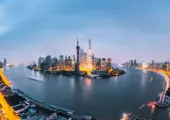
Trending Travelogues
Popular trip moments, popular travel types, popular attractions, popular destinations, recommended attractions at popular destinations.
- Customer Support
- Service Guarantee
- More Service Info
- Website Feedback

- About Trip.com
- Terms & Conditions
- Privacy Statement
- About Trip.com Group
Other Services
- Investor Relations
- Affiliate Program
- List My Property
- Become a Supplier


- [email protected]
- 86-773-286-5632 (Intl rates apply)
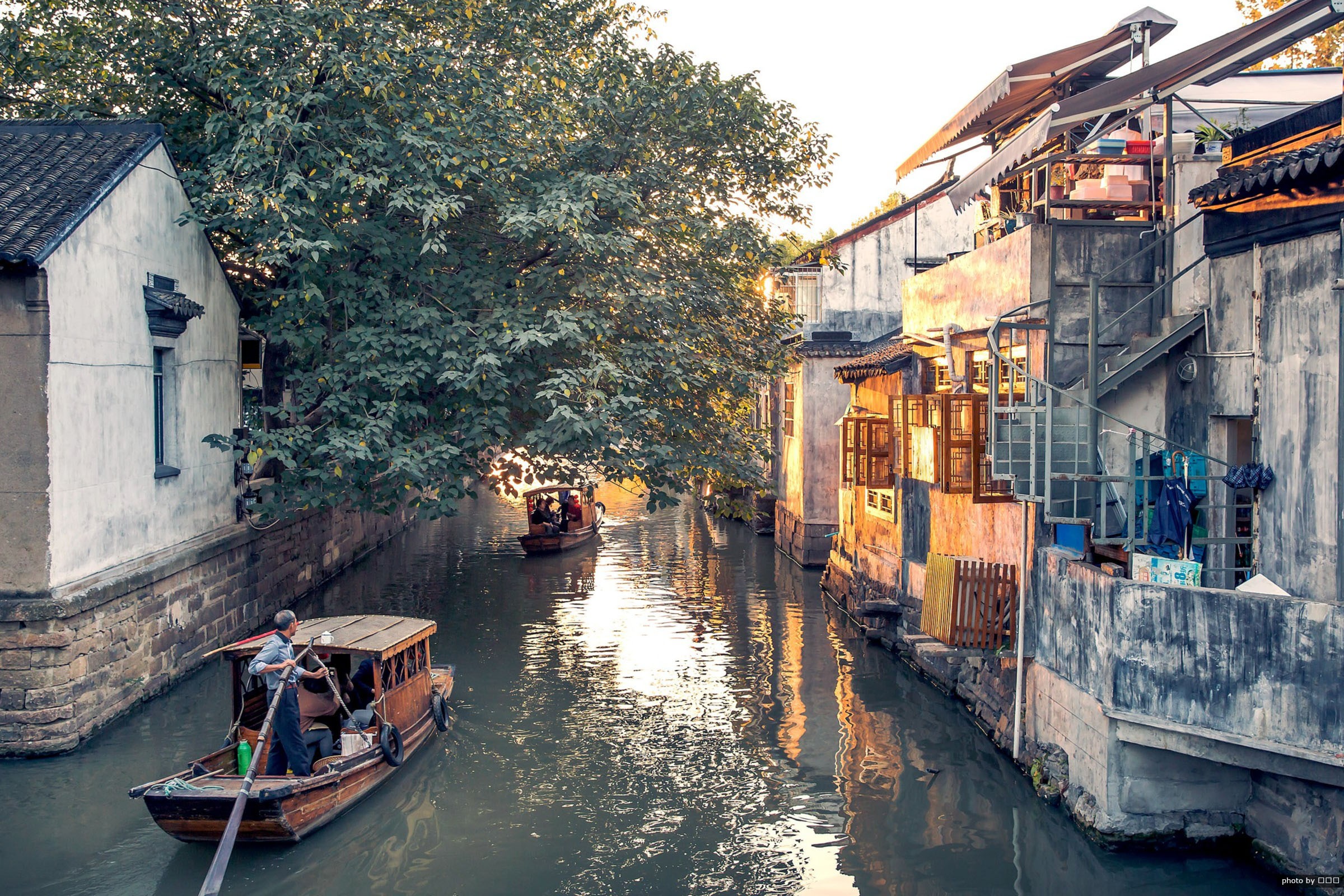
Suzhou Travel Guide
Suzhou Travel Guide: Top Attractions, Best Time to Visit
Suzhou is one of the first 24 national historical and cultural cities in China known as the famous southern water town, hailed as a "paradise on earth."
Suzhou is at the heart of the Yangtze River Delta region, with the Beijing-Hangzhou Grand Canal running through its territory. By taking steps around Suzhou, experiencing the rich history along the riverbanks and its water town, exploring mixed architecture arts by immersing in picturesque gardening nature, fascinating museums, and ancient temples, and discovering cultural appeal with events like Kunqu Opera and delicious Suzhou cuisine.
Suzhou Culture
As the core carrier of "Jiangnan culture," Suzhou is synonymous with the 2500-year-old Kunqu Opera, Pingtan storytelling, gardens, and Suzhou embroidery, becoming distinctive symbols that the world recognizes China.
Suzhou culture, the core of Wu culture, encompasses history, geography, local customs and traditions, traditional customs, lifestyle, literature and art, behavioral norms, ways of thinking, values, and other aspects, and is the product of long-term creative accumulation.
Suzhou Gardens
Suzhou Classical Gardens are outstanding representatives of Chinese garden art, and treasures within China's ancient cultural heritage. The culture of Suzhou Gardens has a long history, embodying a profound national culture.
Suzhou Gardens expresses the ancient people of Wu's inherent pursuit and exploration of beauty. The aesthetic principles they embody serve as permanent aesthetic standards for later generations.
Today, there are many excellent garden architectures in Suzhou, including the Humble Administrator's Garden, Lion Forest Garden, Master of the Nets Garden, Canglang Pavilion, Lingering Garden, Garden of Pleasure, and Garden of Art.
Kun Opera or Kunqu Opera has been seen as the "origin of a hundred operas". Originating in Taicang district, Kunshan in Suzhou, it boasts a history of about 600 years and evolved from Kunshan Tone in the late Yuan Dynasty and the early Ming Dynasty.
Suzhou Pingtan
Besides Kun opera, there is another art form deeply loved by locals. Suzhou Pingtan is a traditional art form that is performed with storytelling and ballad singing , in which two performers take part respectively.
Generally, Pingtan stories are drawn from Chinese folklore, history, and some literature . Enjoying a Pingtan performance in a teahouse is the best option for locals to relax and spend time with their families.
Silk Culture
China is celebrated for its silk and china. As the epicenter of silk , Suzhou has a long history of silk making, dating back to the Song Dynasty (960-1279).
Now locals still cultivate the mulberry trees and raise the silkworms as a prosperous industry, working the looms with weathered hands. Travelers can visit Suzhou Silk Museum which houses hulking, ancient-looking silk-spinning contraptions.
Suzhou Weather
Suzhou falls under the East Asian monsoonal humid subtropical climate, characterized by distinct four seasons. Suzhou weather is moderate, with plentiful rainfall. The average annual temperature is around 16 °C, and the annual rainfall exceeds 1,000 millimeters.
The Best Time to Visit
Suzhou features four distinctive seasons and temperatures vary widely in seasons. Choosing the best time to visit depends on your attitude to the weather and the crowds.
Suzhou's average annual temperature is 14.5 ℃ (58 ℉). Summer temperatures can get up to 33 ℃ (91 ℉), while winter temperatures dip to around 2 ℃ (36 ℉).
If you really ask for an exact time, March to May would definitely be a perfect time to hit the road.
In spring, the tourism peak hasn’t come yet and the mild temperatures are 7 to 17 ℃ (45 to 63 ℉), sometimes breeze and drizzle. The scent of wet earth wafts through the air, which makes it an ideal time to stroll through the city's gardens and temples in peace. It’s the kind of experience that lingers in your memory. During this time, there is less crowded anywhere, although booking in advance with a cheap deal is highly recommended.
Suzhou History
The city of Suzhou was founded in 514 BC, giving it a history of over 2500 years. Emperor Wen of Sui renamed the "Wu County", "Suzhou," taking the name from Mount Gusu, in 589 AD.
During the Spring and Autumn period, Suzhou was the second capital of the Wu kingdom and its economic, political, and cultural center. It was praised as the "unrivaled metropolis in the eastern part of the river" during Qin dynasty, Han, and the Six Dynasties.
In the Tang dynasty, it was recognized as the only predominant state in Jiangnan and known as "the leading state of the world."
In the Song dynasty, the saying "Heaven above, Suzhou and Hangzhou below" began to circulate.
During the Yuan dynasty, Suzhou was "astonishingly beautiful," while in the Ming dynasty, it was a megacity in Jiangnan.
During the Qing dynasty, it was a "prime hotspot for wealth and luxury in the mundane world."
How to get to Suzhou
Although Suzhou isn’t intended to play hard-to-get, there is no direct way to arrive from abroad.
However, as one of the most important tourist cities, once you reach China, it is far easier to come for bullet trains connecting Suzhou to other major cities, including Shanghai, Beijing, Hangzhou, Nanjing, etc. Also, all places in Suzhou are within reach of the convenient metro lines.
Trains to Suzhou
Four railway stations-- Suzhou Railway Station, Suzhou North Railway Station, Suzhou Park Railway Station and Suzhou New District Railway Station in Suzhou offer advanced bullet trains and ordinary trains to nearby cities and beyond. They connect Suzhou by rail to Shanghai, Beijing, Hangzhou, Nanjing, and other cities.
The following two stations have the most daily trains :
Suzhou Railway Station: is situated in the downtown area, making it a convenient place from which tourists can arrive or depart from Suzhou. There are around 130 high-speed trains and more than 50 ordinary trains running between Shanghai and Suzhou daily . Most of the trains start from Shanghai Hongqiao Railway Station and Shanghai Railway Station. There are frequent trains to nearby Nanjing, Hangzhou, Wuxi, and other cities.
Suzhou North Railway Station: is far more away from the city centre than Suzhou Train Station and caters to bullet trains only . It is located on the popular Shanghai–Beijing High-speed Railway. There are over 70 trains connecting Shanghai Hongqiao Station and Shanghai Station with Suzhou North Railway Station daily. It also offers 20 fast trains to Beijing South Railway Station every day.
Transportation in Suzhou
Metro would be the first choice of most people for its convenience and efficiency. Suzhou has 6 metro lines that cover Suzhou Railway Station, Suzhou North Railway Station, Shantang Street, and other places. The ticket price ranges from CN¥2 to CN¥8 according to the distance traveled.
Although city buses are not usually the first choice of foreign travelers, it is a good idea to take them as they cover a lot of the city . Ticket prices range from CN¥1 to CN¥3 per person one way based on the route and distance. It's all self-payment after boarding.
If you would like to travel with greater comfort and privacy , you could take taxis instead of using public transport. The starting taxi fare is CN¥10 for the first 3 km (1 mi). Taxis operate 24/7 in Suzhou, but there are different fares for different times of the day. In addition, taxis may be hard to get during the peak travel times of 7–10 a.m. and 5–8 p.m.
SND Tram would be a great choice for some of your specific destinations . Two tram lines are operating in Suzhou. Line 1 runs between Suzhou Amusement Land (Shizhishan Station) and Xiyangshan Station, while Line 2 connects Longkang Lu Station and Wenchang Lu Station. The fare is CN¥2 per person for a single ride.
There are some places none of the transportation above can run through . So as a more classic and traditional kind of transportation- an alternative to Taxis, rickshaws are a great way to navigate older and more congested neighbourhoods and will give you a taste of local life in the city. While you can try haggling over the rate, the usual cost of taking a rickshaw is around CN¥10 .
Rented Bicycle
China is called the kingdom of bikes and for good reason. Bicycles are the most popular > mode of transportation and also a better way to protect our environment. You can rent a bicycle from some youth hostels or bicycle shops . You could also rent a public bicycle with CN¥3 each time.
Things to do in Suzhou
How to organize your time for a vivid Suzhou if you only get a few days here, while massive marvelous sceneries are waiting for you? Renowned as “ Venice of the East”, various brooks flow through the city from west to east, though plenty of surprises are hidden in winding alleyways making it special.
To better save you time and fulfill your expectations of this trip, there are a few places we provide that should be prioritized.
Tongli Water Town
If you want to experience a world of traditional Chinese painting vibe with bridges, rivers, and beautiful houses, Tongli Water Town is a must-visit tourist spot!
The Three Bridges( The Taiping Bridge, Jili Bridge, and Changqing Bridge) of Tongli are the heart of the town, spanning the network of waterways that the area.
Locals carry on their daily lives in the streets and along the canals, drawing water and washing clothes and the rhythmic splashing of them being wrung out provides a calming backdrop to your visit.
Humble Administrator’s Garden
As one of the most representative classical gardens in Suzhou, a trip wouldn’t be completed without visiting Humble Administrator’s Garden . Experiencing over 500 years of dynastic changes and different owners through splendour and decay, the garden developed from forming one entity into separating into the eastern, middle, the western parts all with exquisite pavilions, winding paths, and picturesque bridges that cross the garden's lakes and ponds.
- Time needed: 2-3h
- Location: 178 Northeast Street, Gusu District (东北街178号)
- Opening Hours: 7:30 a.m. – 5:30 p.m. (low season) / 7:30 a.m. – 5 p.m. (high season)
- Admission: ¥70 (low season) / ¥80 (high season).
Lingering Garden
Recognized as a UNESCO World Heritage Site, the Lingering Garden consists of four distinctly themed sections: East, Central, West, and North which definitely fill your day!
A beautiful entrance gate and a tranquil courtyard make up the East part , where the cloud-capped peak stone marvels you. Occupied one-third of the total area, the Central part , encircled by a pond and several pavilions, features a winding corridor of over a thousand meters. Odd wigwams and winding paths characterize the Western part while a quiet bamboo forest and a traditional teahouse complete the North .
- Time needed: 1h
- Location: 338 Liuyuan Rd. (留园路338号)
- Admission: ¥55 (low season)/ ¥45 (high season)
Suzhou Museum
A perfect example of Pei’s work captures the essence of the city it calls home . Suzhou Museum ’s simple, contemporary lines reflect the influence of Western architecture, while the intricate latticework and lush greenery reflect the beauty of the Jiangnan style which is deeply rooted in Chinese culture.
There are three main parts, the Central area is the main exhibit hall with rotating displays of art and artifacts, the West wing houses the museum’s permanent collection and the East wing is decorated with modern art galleries and other facilities.
- Time needed: 1-2h
- Location: 204 Dongbei Street, Pingjiang District, Suzhou ( 苏州市平江区东北街204号)
- Opening Hours: 9:00 a.m. – 5:00 p.m. (Tue. - Sun. exception for the national day)
- Admission: Free
Hanshan Temple
Dating back to the 9th century, the Hanshan Temple is a legend of Suzhou, embracing the serene and solemn of Buddism while being a coexist with the ancient and modern.
There are inscriptions including poems and wordings, carved on stone steles and two ancient bells that have tolled through the centuries. People who travel by come to the temple making offerings at the temple, leaving behind coins or burning incense, as a way to show their devotion and ask for blessings .
- Location: 24 Hanshansi Ln, Suzhou (寒山寺弄24号)
- Opening Hours: 8:00 a.m. – 5:0 p.m.
- Admission: ¥20.
Shantang Street
Strolling down Shantang Street , the sweet smell of sugar and maltose wafts from shops selling traditional snacks like sugar painting , and the sound of Kun opera and Tanping drifts from the teahouses , where people sit sipping tea and watching the performance.
Stated as the " First Street in Shuzou ", every detail you want to know about Suzhou is exposed everywhere. Especially when you’re exhausted from showing around in daylight, it’s the best place to chill down on a boat under the voices of locals chatting and the backdrop of lights dazzling upon the water.
Master of the Nets Garden
Evoking a sense of serenity and detachment from the outside world, with less than one-sixth of the Humble Administrator's Garden , the garden allows travelers to authentically immerse themselves in nature.
Also, the way the Master of the Nets Garden incorporates the outside monastery with white walls and green tile roofs to add to the garden's overall design is a vital example of the concept of " borrowed scenery ", which was an important part of traditional Chinese garden design. Btw, as the night neared, a night garden show was hosted including Kun opera and Pingtan performances.
- Location: Kuojiatou Alley NO. 11 Daichengqiao Road, Suzhou(苏州市姑苏区阔家头巷11号)
- Opening Hours: 7:30 a.m. – 5:30 p.m. (low season) / 7:30 a.m. – 5 p.m. (high season)
- Admission: ¥30 (low season) / ¥40 (high season)/ ¥100 for a night garden.
Barely over thirty meters high, Tiger Hill is extraordinary, with towering ancient trees and a thousand-year-old pagoda. The hill itself is said to resemble a reclining tiger, hence the name.
If you’re too tired to travel around, it’s a good choice to recharge your batteries in a graceful teahouse , letting the soothing sounds of Kunqu Opera drift in through the windows, and the scent of tea wafts through the air.
- Location: No.8 Jinchang District, Suzhou (苏州市姑苏区山门内八号)
- Admission: ¥60 (low season) / ¥70 (high season)
Suzhou Cuisine
Suzhou is the birthplace of Su Cuisine, where the top characteristic courses include Sweet and Sour Mandarin Fish, Eel Paste with Oyster Saule, Chaudfroid, and Braised Ham in Honey Sauce.
Suzhou Shopping
When shopping in Suzhou, the top recommended souvenir is Suzhou Embroidery. Suzhou's embroidery technique, along with Hunan's Xiang Embroidery, Sichuan's Shu Embroidery, and Guangdong's Yue Embroidery, are collectively known as the Four Famous Embroideries of China.
In addition, Suzhou's Bi Luo Chun Tea is one of China's top ten famous teas and an excellent gift for friends and family. Other renowned local specialties include Suzhou's Song Brocade, Taohuawu Woodblock New Year's Paintings, Caizhizhai Candies, Suzhou-style pastries, Suzhou-style candied fruit, Bi Luo Chun Tea, White Sand Loquats, and Suzhou fans.
Plan your Suzhou Trip with China Travel
If you would like a detailed tour of Suzhou, let us know, and we will plan a trip customized to your preferences. Our experienced English-speaking guides will escort you to the museum and tell you about the history and stories of this charming city.
Please feel free to share your tour ideas with us . We look forward to serving you.
You Might Like to Read
- Shanghai Travel Guide
- Hangzhou Travel Guide
- Huangshan Travel Guide
Request a custom itinerary today and get one step closer to your personalized trip
Create Your Trip

Complete Suzhou Travel Guide: Exploring the Beautiful Venice of the East
- Versed Traveler
- August 20, 2023

Suzhou, a city in southern Jiangsu Province in the center of the Yangtze Delta, is a beautiful area of China that has preserved much of its history. Bordered by the Yangtze River in the north, Shanghai in the east, Zhejiang Province in the south, and Lake Taihu in the west, Suzhou is a major city that’s easy to get to and hard to leave . This beautiful city is known for its stunning Chinese gardens, ancient architecture, and rich cultural heritage.
If you’re planning a trip and looking for a comprehensive travel guide or simply want to learn about this pulchritudinous city, you’ve come to the right place. In this article, we’ll provide you with all the information you need to plan your trip, including the must-see attractions and historic sites, suggested itineraries, and travel tips.
Click here for a packing guide for China

Table of Contents
Getting to Suzhou
The nearest airport to Suzhou is Shanghai Hongqiao International Airport (SHA), about 80 km away. You can take a taxi or train to Suzhou from there. Alternatively, you can fly into Shanghai Pudong International Airport (PVG), about 120 km away, and take a taxi or train to Suzhou. Several airlines operate flights to both these airports from major cities worldwide.
The most convenient way to reach the city is by train. The city has four main railway stations for passengers: Suzhou Railway Station, Suzhou North Railway Station, Suzhou Xinqu Railway Station, and Suzhou Yuanqu Railway Station. High-speed trains operate from Shanghai, Beijing, and other major cities in China, making it easy to reach Suzhou from anywhere in the country.
Several long-distance buses operate from major cities in China to Suzhou. The city’s bus station is located in the city center and is well-connected to other parts of the city. However, traveling by bus can be time-consuming, and it is not the most comfortable mode of transportation.
You can also reach the city by car, renting a car, or hiring a taxi. However, traffic in China can be chaotic, and driving can be challenging for foreigners not accustomed to the local driving style. Hiring a local driver familiar with the roads and traffic conditions is recommended.

Top Attractions
Suzhou is known for its beautiful gardens and water towns. Here are some of the top attractions to visit:
- Humble Administrator Garden: This is one of the most famous gardens in China and a UNESCO World Heritage site. It is a classical Chinese garden with beautiful landscapes, pavilions, and water features.
- Lingering Garden: Another UNESCO World Heritage site, the Lingering Garden is a classical Chinese garden with stunning rock formations, pavilions, and water features. It is known for its unique architecture and landscape design.
- Tiger Hill: This historic hill in Suzhou has a leaning pagoda, beautiful gardens, and scenic views. It is a popular place for tourists to visit and take pictures.
- Tongli Water Town: This is a picturesque water town near Suzhou with beautiful canals, bridges, and traditional architecture. It is a great place to experience traditional Chinese culture and architecture.
- Zhouzhuang Water Town: Another water town near Suzhou, Zhouzhuang is known for its beautiful canals, bridges, and traditional architecture. It is a popular tourist destination and a great place to experience traditional Chinese culture.

Suzhou is known as the “Venice of the East” due to its numerous ponds, streams, and canals. But what makes the city genuinely unique is its classical gardens. Suzhou’s gardens are a symphony of rocks, water, trees, and pavilions that reflect the Chinese appreciation of balance and harmony. Nine of these gardens have been designated as UNESCO World Heritage Sites, and two (Lingering Garden and Humble Administrator’s Garden) are considered China’s most famous.
One of the must-visit gardens is the Humble Administrator’s Garden. This garden is the largest in the city and is divided into three parts: the central, eastern, and western. The garden features a variety of pavilions, bridges, and rock formations, as well as a large lake. Visitors can spend hours wandering the garden’s paths and admiring the scenery.

Another garden worth visiting is the Lingering Garden. This garden is divided into four parts: the central garden, the east garden, the west garden, and the north garden. The garden features a variety of buildings, such as a teahouse, a theater, and a study. Visitors can also see a variety of plants and trees, including bamboo, plum, and peach trees.
In addition to these two famous gardens, many other gardens are worth exploring. The Lion Grove Garden is known for its unique rock formations, while the Master of the Nets Garden is known for its small size and intricate design. Visitors can also explore the Couple’s Retreat Garden, which features a variety of water features and rock formations, or the Retreat & Reflection Garden, which was designed to be a place of meditation and contemplation.

Water Towns
The city is famous for its beautiful water towns, characterized by their ancient architecture, arched stone bridges, and picturesque canals. The water towns are a must-visit for anyone traveling to this part of China, as they offer a glimpse into China’s rich cultural heritage.
Two of the most popular water towns in Suzhou are Zhouzhuang and Tongli. Zhouzhuang is known as the “Venice of the East” and is famous for its well-preserved ancient buildings, beautiful gardens, and winding canals. Visitors can take a boat ride through the canals, explore the traditional homes of residents, and sample local delicacies at the many food stalls and restaurants.
Tongli is another popular water town known for its peaceful atmosphere and beautiful scenery. The town is home to numerous ancient bridges, temples, and gardens, and visitors can take a stroll along the canals or rent a boat to explore the town from a different perspective. Tongli is also famous for its traditional handicrafts, such as embroidery and woodcarving, which make great souvenirs.

Other water towns include Xitang, Luzhi, and Wuzhen, each with their own unique charm and attractions. Xitang is known for its beautiful night scenery, while Luzhi is famous for its ancient stone bridges and well-preserved Ming and Qing dynasty architecture. Wuzhen is a larger water town that is home to numerous museums, galleries, and cultural centers.
Overall, Suzhou’s water towns offer a unique and unforgettable travel experience. Visitors can immerse themselves in the rich history and culture of China while enjoying the beautiful scenery and delicious local cuisine.
Local Cuisine
Suzhou is a city in China that is known for its unique cuisine. The food here is famous for its delicate flavors and sweet taste. The cuisine is a part of the Jiangsu style, one of China’s eight famous cuisine styles. The local chefs are proud to say that the flavors of “su bang cai” (Suzhou cuisine) are far more delicate than Shanghai cuisine.
The cuisine features fresh and seasonal vegetables as one of its raw materials. The vegetable and fish dishes of that region are especially famous. The Squirrel-shaped Mandarin Fish is a traditional dish that is a must-try. The fish is first deboned and then shaped like a squirrel, then deep-fried and served with a sweet and sour sauce. It is a perfect blend of sweet and savory flavors.

Here are the top 10 foods you should try:
- Pan-Fried Bun
- Yangcheng Lake Crab
- Lotus Root Starch Noodles
- Sweet and Sour Mandarin Fish
- Osmanthus Rice Cake
- Eight Treasures Duck
- Crab Roe Tofu Soup
- San Bei Chicken
- Stir-Fried Shrimps with Longjing Tea Leaves
Authentic notable local dishes and snacks can be found in Guanqian Street. You’ll never forget the delicious food and friendly service. There are also many restaurants in Suzhou that serve traditional Suzhou cuisine. It is recommended to try different places to get a taste of the city’s diverse culinary offerings.

Where to Stay
When planning a trip to Suzhou, finding the right place to stay is important. Fortunately, Suzhou offers a variety of accommodation options ranging from budget-friendly hostels to luxurious hotels. Here are some of the best areas to stay in Suzhou:
If you want to be in the heart of the city, downtown Suzhou is the place to be. This area is home to many of Suzhou’s top attractions such as Humble Administrator’s Garden, Suzhou Museum, and Pingjiang Road. It is also where you can find a wide range of hotels, from 5-star to 3-star, as well as plenty of restaurants, malls, and snack streets. Plus, the area is well-connected to public transportation, making it easy to get around.
If you’re looking for a more upscale experience, consider staying near Jinji Lake. This area is known for its luxury hotels, such as the Crowne Plaza , and its beautiful waterfront views. It’s also close to Suzhou Industrial Park, which is home to many international companies and a popular spot for business travelers.
If you’re on a budget, Dushu Lake is a great option. This area is home to many mid-range hotels, such as the Oakwood Hotel & Residence Suzhou, and is known for its peaceful atmosphere. It’s also close to Suzhou Industrial Park and Suzhou University, making it a popular spot for students and business travelers.
No matter where you choose to stay, be sure to book your accommodations in advance, especially during peak travel season. With the right planning, you can find the perfect place to stay and make the most of your time in this beautiful city.

Suzhou is a city that can pique the interest of history lovers, culture enthusiasts, or those who simply enjoy beautiful scenery. With its many canals, gardens, and historic landmarks, Suzhou will leave a lasting impression on any traveler.
During your visit take a stroll along the canals and explore the many gardens the city is famous for. You can also visit historical landmarks such as the Humble Administrator’s Garden and the Suzhou Museum to learn more about the city’s rich history and culture.
If you’re a foodie, you’ll love the cuisine, known for its delicate flavors and use of fresh, local ingredients. Be sure to try some of the city’s specialties, such as Suzhou-style mooncakes and sweet and sour Mandarin fish.
Overall, Suzhou is well worth a visit, whether you’re traveling to China for the first time or have been there many times and are now looking for a new adventure. With its unique blend of history, culture, and natural beauty, this city is sure to captivate and inspire you.

Tips for Scoring Affordable Airplane Tickets via Google Flights: Expert Strategies Revealed
Travel costs can fluctuate dramatically and finding the best deal on airfare is often a

Inexpensive Spring Vacation Ideas: Budget-Friendly Getaways to Try
Get inspired with our top inexpensive spring vacation ideas. We provide a list of activities and destinations

Best Disposable Slippers: Top Choices for Comfort and Convenience
Learn about the best disposable slippers for at home or travel

Best Things to Do in the Outer Banks: Unmissable Attractions
Learn about all of the best things to do in the Outer Banks. Get inspiration for your next beach vacation.

Flying with Young Children: A Parents’ Guide to Stress-Free Travel
Learn about essential tips and policies for flying with young children

Best Travel Outlet Adapter: Your Ultimate Guide for Global Connectivity
We review the the best travel outlet adapters on the market. Learn which travel outlet adapter is the best for your needs.
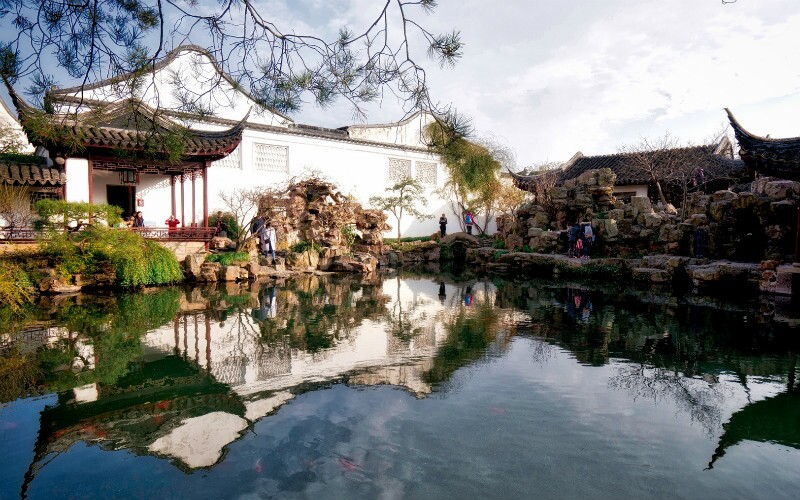
Suzhou Travel Guide
An old Chinese proverb praising the beauty and prosperity of Suzhou says, "In heaven there is paradise, on earth there are Hangzhou and Suzhou." It has long been a heaven for scholars, artists, and skilled craftsmen, and it still is today.
The beautifully landscaped city of Suzhou is located in the center of the Yangtze Delta region, and is renowned for its classic gardens, traditional waterside architecture, and traditional operas .
Suzhou was a prosperous ancient state capital, built in 514 BC by He Lv (/her lyoo/), the King of Wu State. It grew in favor with China's dynasties - a summer retreat of emperors , and a well-placed trade center.
144-Hour Visa-Free Travel
You may enjoy 6-day visa-free access to Suzhou if you meet the relevant qualifying criteria of the 144-hour visa-free transit policy
The Highlights of Suzhou
Classic gardens.
As the saying goes, "Gardens in the 'Yangtze South' area are the best in the world, and Suzhou gardens are the best among them." Suzhou's classical gardens have an international reputation.
The classic gardens flourished in the mid-Ming to early-Qing dynasties (1500–1700). Most gardens are private ones built by aristocrats, scholars, and rich businessmen.
Today, more than 60 classic gardens remain in the city, nine of which have been listed as World Heritage , including the Humble Administrator's Garden , Lingering Garden , and Net Master's Garden .
Water Towns
With the Yangtze River flowing through the city's north boundary, and the Grand Canal running down from north to south, Suzhou is rich in canals, and is called "the World's Oriental Venice" .
The top water towns of Suzhou are Zhouzhuang , Luzhi, Tongli , Shaxi, Qiandeng, and Jinxi. Of these Zhouzhuang is honored as the number one water town in China, but it is the most commercialized. Tongli is a quiet water town and is less crowded. See the top 10 ancient towns near Shanghai .
The water towns of Suzhou are crisscrossed by canals, rivers, and bridges. Old buildings and streets are built along the waterways. Many of them are still preserved well, reflecting old China. You can walk along lanes and bridges, or take a boat to appreciate ancient architecture and the beautiful canal scenery .
Suzhou is the hometown of Kun Opera (or Kunqu /kwnn-chyoo/), one of the oldest forms of Chinese opera. It was listed as one of the Masterpieces of Oral and Intangible Heritage of Humanity by UNESCO in 2001. It perfectly blends dramatic literature, soulful singing, and elegant dancing.
The best place to watch a Kun Opera performance and learn about Kun Opera is Suzhou Opera Museum.
Convenient Travel by Train
Suzhou is located between Shanghai and Nanjing. Suzhou Railway Station is among the busiest passenger stations in China. The Shanghai–Nanjing/Beijing–Shanghai high-speed railways passes through Suzhou.
There are frequent high-speed trains from Suzhou to Shanghai, Kunshan, Wuxi, Zhenjiang, and Nanjing. It only takes 25 minutes to Shanghai, less than 1½ hours to Nanjing, and 5 hours to Beijing.
There are also many high-speed trains to/from other cities like Hangzhou, Chengdu, Xi'an, Guangzhou, and so on. If you go to Suzhou, take the high-speed train. Read more about Suzhou transportation .
Planning a Suzhou Trip
For first time travelers to Suzhou must-see attractions and historic sites are the Humble Administrator's Garden, Lingering Garden, the Grand Canal, and Zhouzhuang Water Town.
A Suggested Itinerary
The First Day: Arrive in Suzhou. Check in to your hotel. Stroll around the city to experience the local life. Have a cup of tea and some local snacks in a tea house.
The Second Day: Explore the best representatives of Chinese gardens - Humble Administrator's Garden and Lingering Garden. Take a motorboat cruise on the Grand Canal. Ride a rickshaw to visit the old streets and hutongs in the old city area.
The Third Day: Visit Zhouzhuang Water Town. Experience the traditional culture, appreciate the well-preserved ancient architecture, and enjoy the beautiful scenery along the waterways.
The Best Times to Visit Suzhou
The best times to visit Suzhou are March–May and September–November when the weather is pleasant.
You'd better visit on a weekday as it will be less crowed than on a weekend and holidays. Less than an hour away by high-speed train, Suzhou has become a weekend hangout for Shanghai folk, and the streets can be crowded.
Discover Suzhou with Us
For a first time trip to China you may not want to go to Suzhou, as there are more popular places to go, like Beijing, Shanghai, Xi'an, and Guilin. Suzhou is a good second trip destination to deepen your understanding and appreciation of Chinese culture.
With the 144-hour visa-free transit policy, Suzhou can be conveniently added into your itinerary when you transit through Shanghai or Nanjing. We have specially designed some tours to take advantage of your visa-free stay.
- 1-Day Shanghai to Suzhou Round-Trip Tour : Make the most of your time to visit Suzhou and Tongli Water Town from Shanghai in 1 day!
- 5-Day Shanghai, Hangzhou, and Suzhou Bullet Train Tour : This tour offers the best of the three most important cities in the Yangtze Delta.
See more of our Suzhou tours . Our tours are extremely flexible and can be tailor-made based on your requirements.
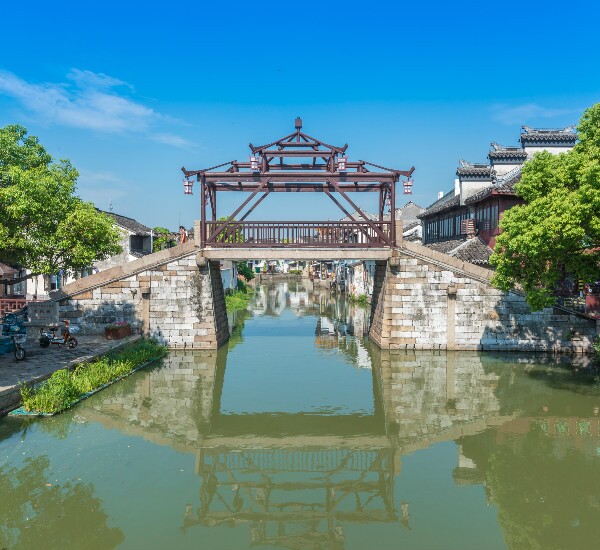
- 8-Day Beijing–Xi'an–Shanghai Private Tour
- 9-Day Beyond the Golden Triangle
- 10-Day Lanzhou–Xiahe–Zhangye–Dunhuang–Turpan–Urumqi Tour
- 11-Day Classic Wonders
- 11-Day Family Happiness
- 12-day Panda Keeper and Classic Wonders
- 13-Day A Broad Taste of China
- 13-Day Beijing–Xi'an–Dunhuang–Urumqi–Shanghai Tour
- 14-Day China Natural Wonders Discovery
- 14-Day Classic China Photo Tour
- 2-Week Riches of China
- 3-Week Must-See Places China Tour Including Holy Tibet
- How to Plan Your First Trip to China 2024/2025 — 7 Easy Steps
- Best (& Worst) Times to Visit China, Travel Tips (2024/2025)
- 15 Best Places to Visit in China (2024)
- The 15 Most Beautiful Places in China (#7 Will Impress You)
- One Week in China - 4 Time-Smart Itineraries
- How to Plan a 10-Day Itinerary in China (Best 5 Options)
- Top 4 China Itinerary Options in 12 Days (for First Timers) 2024/2025
- 2-Week China Itineraries: Where to Go & Routes (2024)
- 17-Day China Itineraries: 4 Unique Options
- How to Spend 19 Days in China in 2024/2025 (Top 5 Options and Costs)
- How to Plan a 3-Week Itinerary in China: Best 3 Options (2024)
- China Itineraries from Hong Kong for 1 Week to 3 Weeks
- China Weather in January 2024: Enjoy Less-Crowded Traveling
- China Weather in February 2024: Places to Go, Costs, and Crowds
- China Weather in March 2024: Destinations, Crowds, and Costs
- China Weather in April 2024: Where to Go (Smart Pre-Season Pick)
- China Weather in May 2024: Where to Go, Crowds, and Costs
- China Weather in June 2024: How to Benefit from the Rainy Season
- China Weather in July 2024: How to Avoid Heat and Crowds
- China Weather in August: Tips for Family Travel
- China Weather in September: a Quieter Month in the Peak Season
- China Weather in October: Where to Go, Crowds, and Costs
- China Weather in November: Places to Go, Costs, and Crowds
- China Weather in December: Places to Go, Costs, and Crowds
Get Inspired with Some Popular Itineraries
More travel ideas and inspiration, sign up to our newsletter.
Be the first to receive exciting updates, exclusive promotions, and valuable travel tips from our team of experts.
Why China Highlights
Where can we take you today.
- Southeast Asia
- Japan, South Korea
- India, Nepal, Bhutan, and Sri lanka
- Central Asia
- Middle East
- African Safari

- Travel Agents
- Loyalty & Referral Program
- Privacy Policy

Address: Building 6, Chuangyi Business Park, 70 Qilidian Road, Guilin, Guangxi, 541004, China

- 86-19138970032 (GMT+8 18:00~09:00)

- Beijing Xian Tours
- Shanghai Beijing Tours
- Hong Kong Guilin Tours
- Hangzhou Suzhou Tours
- Kunming Lijiang Tours
- Shanghai Yangtze Cruise Tours
- Chengdu Tibet Tours
- More Short Stay Tours
- China Tours in January
- China Tours in February
- China Tours in March
- China Tours in April
- China Tours in May
- China Tours in June
- China Tours in July
- China Tours in August
- China Tours in September
- China Tours in October
- China Tours in November
- China Tours in December

- High Speed Trains
- China Yangtze Cruise Tour
- Photography
- Desert Adventure
- Ethnic Villages
- Biking Tours
- Kung Fu Tours
- Heritage Sites Exploration
- China Spring Tours
- China Summer Tours
- China Autumn Tours
- China Winter Tours

- Best-value Yangtze Cruises
- Top Family-friendly Cruise Ships
- Top 3 Luxury Yangtze River Cruises
- Yangtze River Highlights
- Yangtze River Cruise Routes
- Upstream or Downstream?
- Dining & Drinking
- Accommodations
- On-board Activities
- Yangtze Cruise Booking Steps

- Inner Mongolia

- Fanjingshan
- How to Plan Your First China Tour
- How to Plan Beijing Tour
- How to Plan Xian Tour
- How to Plan Shanghai Tour
- How to Plan Guilin Tour
- How to Plan Sichuan Tour
- How to Plan Family Tour
- 2024 China Travel Ideas
- Best Time to Visit China
- What to Pack for Your China Journey
- Updated China Travel News
- Ultimate Chinese Visa Guide
- Chinese Visa Types
- Chinese Visa Requirements
- Do I Need a Visa for China
- Chinese Visa Application
- Chinese Visa Exemptions
- 144-hour Visa Free
- Shenzhen Visa on Arrival
- Hainan 30-day Visa Free
- Embassies & Consulates
- Invitation Letter
- Useful Visa FAQs & Tips
- Entry Regulations
- Baggage Allowance
- Customs Declaration
- Exit Regulation
- How to Book Train Tickets
- How to Collect Train Tickets
- How to Cancel & Alter Train Tickets
- How to Read Train Tickets
- China High Speed Train Types
- Seats Class & How to Choose
- Friendly Facilities on the Train
- The Train Station Departure Process
- Available Food and Drinks on the Train
- Western Toilets on the Train
- Luggage Racks & Baggage Allowance
- Beijing Train Stations
- Shanghai Train Stations
- Guilin Train Stations
- Xian Train Stations
- Chengdu Train Stations
- Hong Kong West Kowloon Railway Station
- Beijing - Xian
- Beijing - Shanghai
- Guangzhou - Shanghai
- Shenzhen - Shanghai
- Chengdu - Xian
- Shanghai - Hangzhou
- Shanghai - Xian
- Chengdu - Chongqing
- Kunming - Lijiang
- Beijing Capital International
- Beijing Daxing International
- Shanghai Pudong International
- Shanghai Hongqiao International
- Guangzhou Baiyun International
- Hangzhou Xiaoshan International
- Chengdu Tianfu International
- Chengdu Shuangliu International
- Xian Xianyang International
- Shanghai - Beijing
- Hong Kong - Shanghai
- Guangzhou - Beijing
- Chengdu - Lhasa
- Shanghai - Guilin
- Shanghai - Sanya
- Travel in Spring Season
- Travel in Summer Season
- Travel in Autumn Season
- Travel in Winter Season
- Weather in January
- Weather in February
- Weather in March
- Weather in April
- Weather in May
- Weather in June
- Weather in July
- Weather in August
- Weather in September
- Weather in October
- Weather in November
- Weather in December
- Top 10 China Destinations
- Top 15 Things to Do
- China World Heritage Sites
- Top 10 Best Natural Beauties
- Top 10 Museums in China
- Top 10 Old Towns & Villages
- Five Great Mountains in China
- Top 10 Monasteries & Temples
- Top 10 Ski Resorts
- Top 10 Beautiful Lakes in China
- 7 Best Beaches in Sanya
- Top 6 Beautiful Waterfalls
- Panda Volunteering
- Having fun on Ice and Snow Festival
- About Us Who We Are Our Team Why Travel with Us Feedback & Reviews Travel Stories Travelers' Gallery Payment Guide Customer Support Contact Us
- Tour Experiences
Destinations
- Travel Guide

Suzhou Travel Guide 2024
Located in the southeast of Jiangsu Province and in the central of Yangtze River Delta, Suzhou is a famous historic and cultural city in China. First built from 514BC, Suzhou now has a history over 2500 years. This city embodies the classic flavor of Jiangnan, rich in tourism resources, and Suzhou gardens and water towns are the most famous among all. Suzhou gardens can be traced back to the royal garden in 6th century BC. People always say “Suzhou Gardens are the finest under heaven”, that’s not an exaggeration. Besides that, the water ancient towns, like Tongli and Zhouzhuang also attract numerous tourists for is elegant and quiet flavor.
Why Visit Suzhou?
- Classic Suzhou Gardens - Suzhou Gardens are the perfect combination of architecture, landscape, flowers and trees, sculpture and painting and calligraphy. Natural beauty and artistic charm value have united in the winding and changeable views.
- Water Towns - There are many water towns in Suzhou, like Tongli, Zhouzhuang, Luzhi, Mudu, Jinxi, etc. The water towns here can be called the most beautiful and most classic water towns in China. Travellers can experience the peaceful local life and appreciate the charm of the Oriental Venice.
- Silk Culture - Suzhou offers a great opportunity to explore the silk. You can explore the long silk history, the lifespan of silkworms $ silk cocoons, traditional silk-weaving techniques, appreciate beautiful silk products and even take part in some steps of making silk.
144-hour Visa-free travel: From Jan. 30, 2016, qualified travelers of 51 countries could travel among Shanghai , Jiangsu Province (Suzhou included) and Zhejiang Province (Hangzhou included) for 144 hours (6 days) without visa. Learn more about 144 Hours China Visa Free Transit >>
Top Attractions
In Suzhou, the top attractions you must visit are the Suzhou gardens and water towns, like Humble Administrator’s Garden, Lingering Garden, Lion Grove Garden, Tongli Water Town and Zhouzhuang Water Town. Other attractions like Panmen Gate, Suzhou Museum and Suzhou No.1 Silk Factory are also recommended. Another feature activity in Suzhou is cruising on the Suzhou Grand Canal, and Suzhou is the only place travellers can cruise on the Grand Canal. For detailed Suzhou attraction information, please see All Attractions in Suzhou.
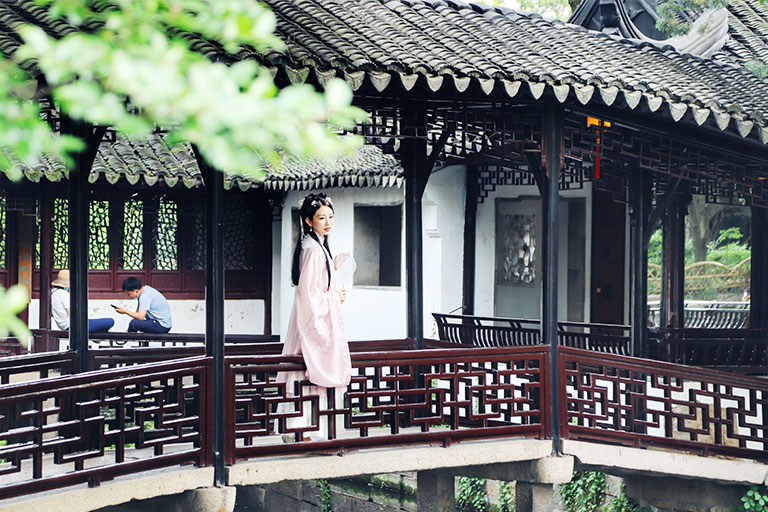
The largest and most famous Suzhou garden, listed as World Heritage Site by UNESCO, and is the most classis private garden in China.
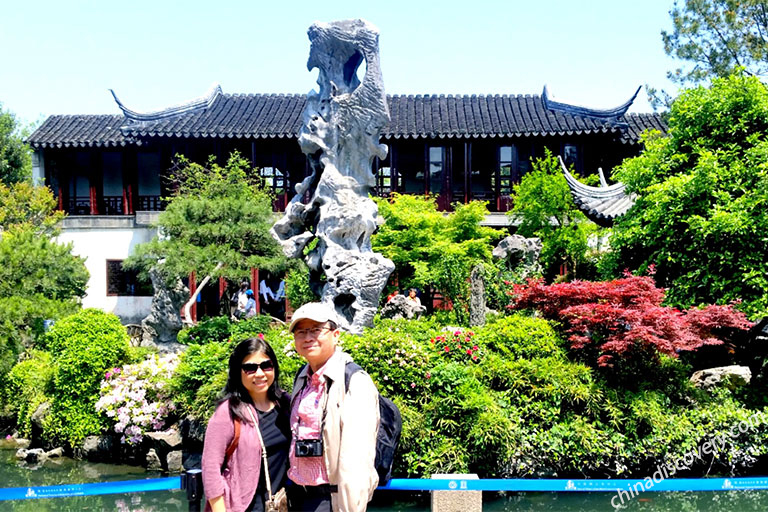
Lingering Garden is a UNESCO-recognized Chinese Classical Garden with delicate designed architecture, featured shaped stones and idyllic scenery.
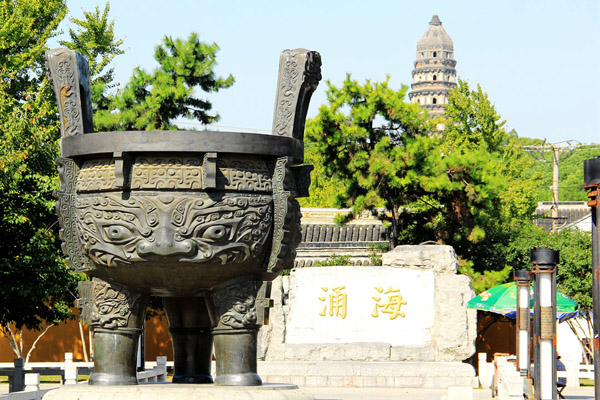
With a history of over 2,500 years, Tiger Hill in Suzhou is an attractive place which enjoys lots of historical legendary and old buildings. It was reputed as the "No.1 Sight of Suzhou"
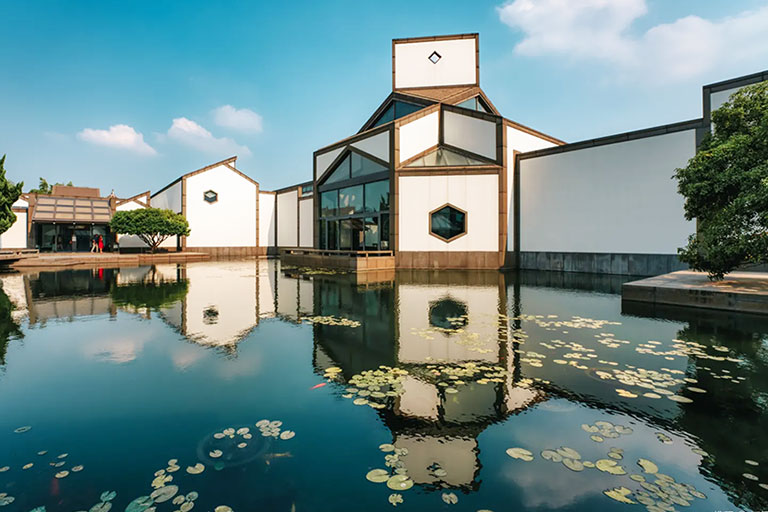
Suzhou Museum designed by I. M. Pei is popular among archetecture lovers with abundant historical and cultural relics of Suzhou.
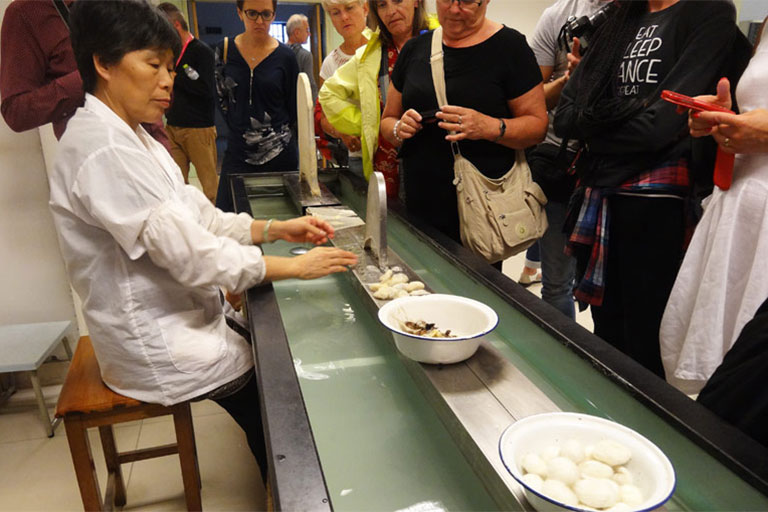
Established for near 100 years, Suzhou No.1 Silk Factory is the best place to see the real process of making Suzhou silk items from silkworms to the delicate silk products.
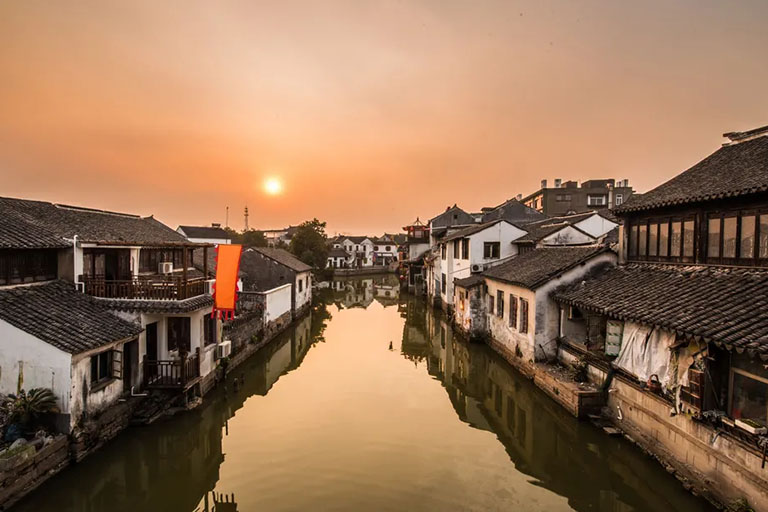
Tongli of over 1,000 years old is a featured Jiangnan water town with ancient residences, old streets, stone bridges, anthentic folk customs, etc.
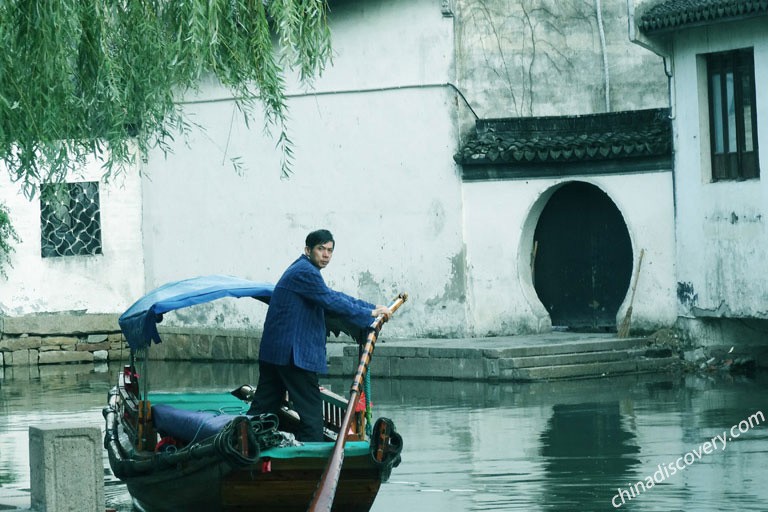
Zhouzhuang is the "No. 1 Water Town in China" of nearly 1000 years old and a great place to see old buildings and picturesque waterscape on the boat.

Master of the Nets Garden is a perfect garden in pocket size. By unique adopting skills for creating "Mountain and Water" garden, it gives the visitor an unbelievable visual feast.
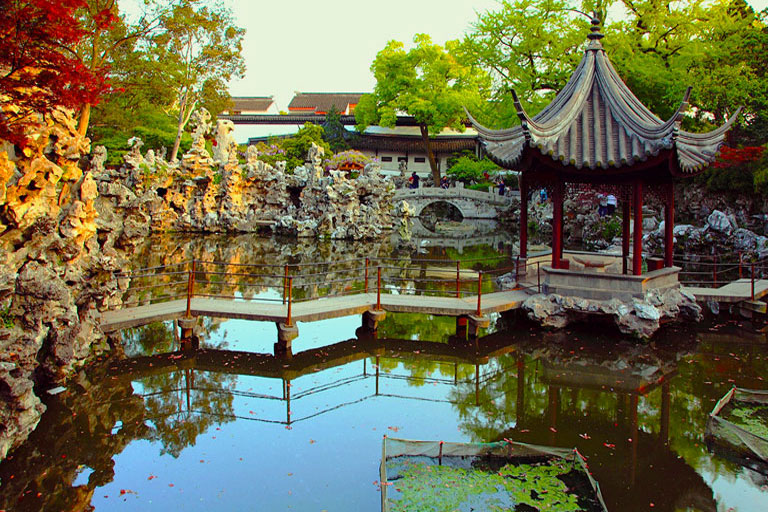
Lion Grove Garden, one of the four famous gardens in Suzhou is praised as the "Kingdom of Rockeries" that offers you a lot of joyment and real visual feast.
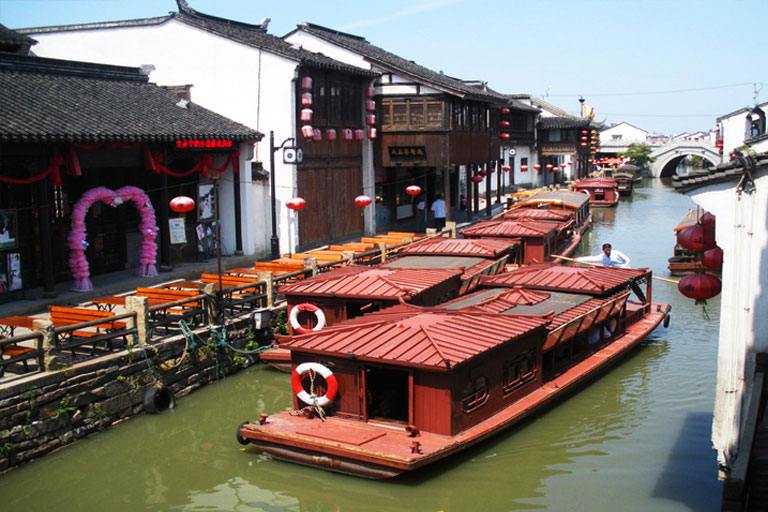
An important part of Beijing-Hangzhou Grand Canal, and cruise on the Grand Canal is definitely a unique experience to experience the water scene of Suzhou.
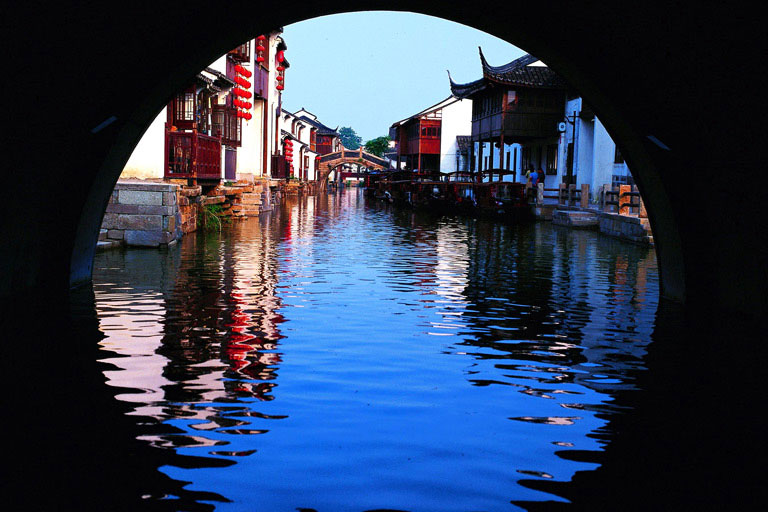
Shantang Street from 825 AD is a famous prosperous street block to savor the local Suzhou buildings, river sceneries, boating fun, real ancient street scene, etc.
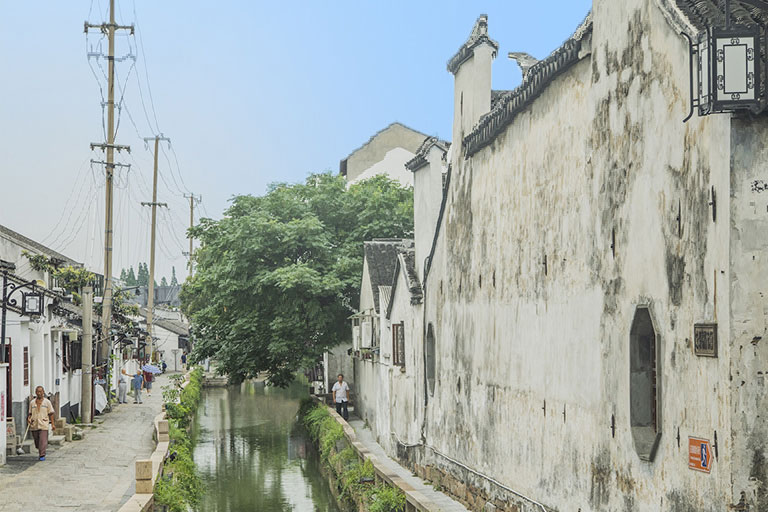
Pingjiang Road is a historical street which dates back to the South Song Dynasty. With well-preserved blocks, it acts as an epitome of ancient Suzhou.
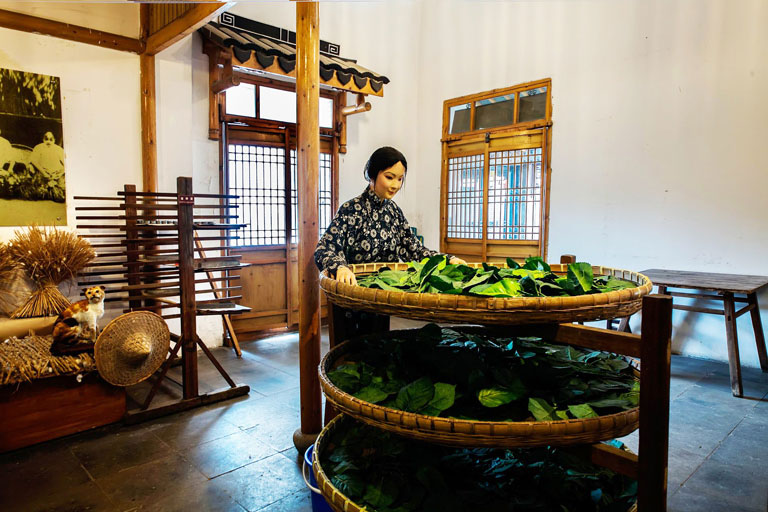
Suzhou Silk Museum is the first museum that specializes in silk in China which well demonstrates the thousand years’ Chinese silk history, displays silk relics, fragments, garments and tapestry, etc.
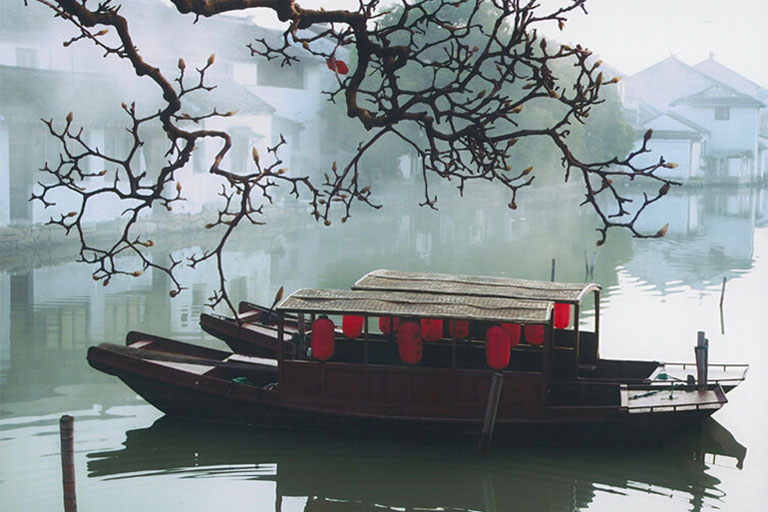
In the picturesque Jiangnan area, there are top 10 ancient towns scattered near Shanghai, Suzhou and Hangzhou, such as Zhujiajiao, Zhouzhuang, Wuzhen, Tongli.
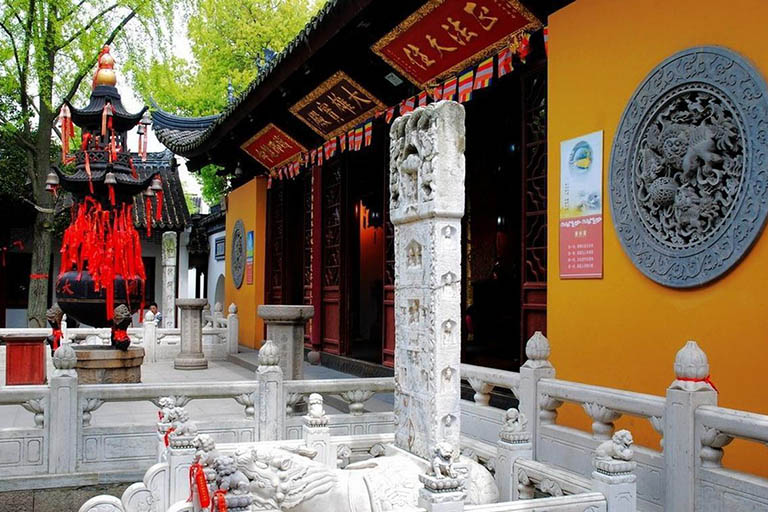
Hanshan Temple is a famous Buddhist temple in Chinas history. There are many historical buildings and tablet inscriptions written by calligraphers and it is also a popular place to pray ....
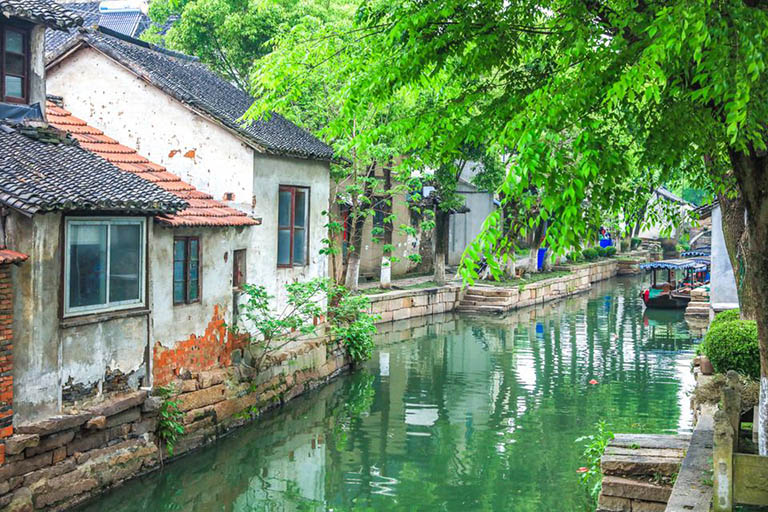
Luzhi Water Town in Suzhou is an ancient town with a history of 2500 years. Here you can avoid the crowds and spend a leisure time walking on the historic bridges, strolling along the flowing river...
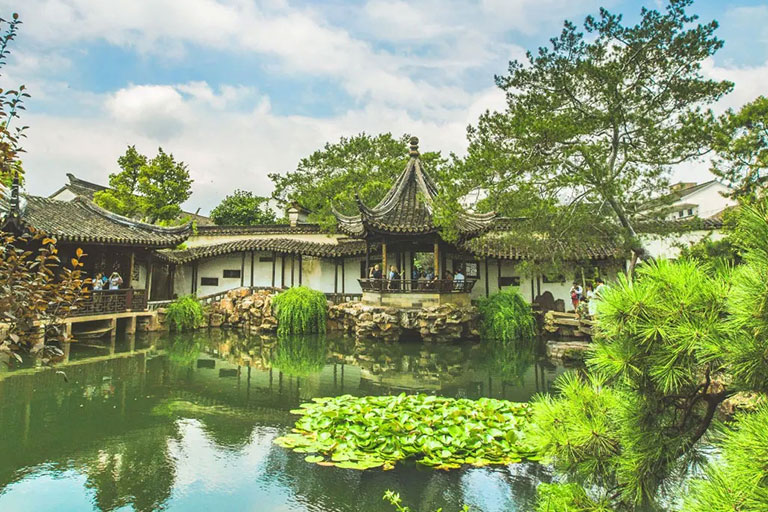
Classical Gardens of Suzhou are the great masterpieces in the history of gardening and World Cultural Heritages, including Humble administrator's Garden, Lingering Garden...
Featured Activities
Visiting Suzhou, you will have a lot of interesting things to do to feel the rich culture and long history of this ancient city in Jiangnan. Enjoying Kunqu Opera and Pingtan, boating on the old canal, watching a night show in the Master of the Nets Garden, tasting the delicious food, etc. To know more information, Please check All Activities in Suzhou .
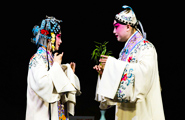
Kunqu Opera
Kunqu of over 600 years old from Suzhou is reputed as the "mother of Chinese operas" and the "World Intangibel Heritage" with elegant soft singing, graceful performance, poetic lines and classic stories. The famous "Peony Pavilion" written by Tang Xianzong is one of the best Kunqu operas and praised by many people.
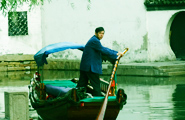
Suzhou Boat
Take a wooden boat to appreciate the waterscape in downtown of Suzhou ancient city is really fun, beacuse you can feel the previous prosperity and the past water transportation of ancient people on the old river. Also, taking a sculling boat in a water town to see the old residences is full of joy.
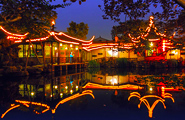
Night Show in Master of the Nets Garden
Night Garden Traditional Art Performance in the Mater of the Nets Garden is famous among visitors from the whole world. Splendid lights and shows including traditional ballad singing, instrument performence, classic dances, etc. Held from 19:30 to 21:00 (May to November) with an admission of about RMB 100
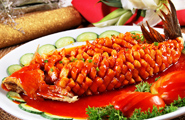
Suzhou Food
Suzhou cusine of over 3000 years profound is one of the Four Famous Cusines in China. Focused to keep the origin flavors of food and with some sweet taste, Suzhou cusine is welcomed by visitors. Sweet and Sour Mandarin Fish, Glutinous Rice Dumplings in Sweet Rice Wine, etc. are the most popular.
Weather & When to Go
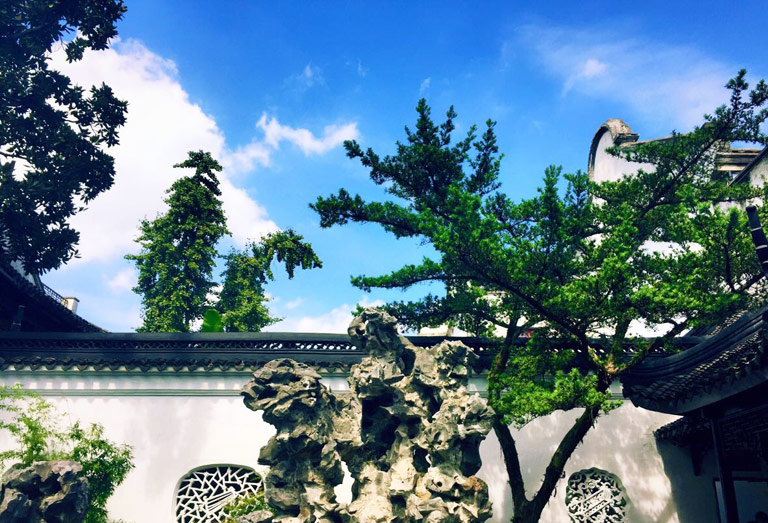
Feature in typical subtropical monsoon climate, the weather in Suzhou is relatively moderate with a clear distinction between the four seasons. Average temperature is about 15.7℃, while 2.5℃ in January and 28℃ in July. Abundant rainfall in all year and average annual precipitation is about 1100 millimeters.
Since the weather is very moderate, so you can visit Suzhou all year round, especially in spring. Spring is the most beautiful time of the gardens, for the flowers will blossom and trees will sprout in this season. From April to October, the pink peaches and green willows set each other off, and lotus root, Biluochun tea, waxberry, loquat and hairy crabs will be on the market in turn, and you will satisfy your eyes as well as your appetite. Though winter scenery is not beautiful as other season, it’s a low season for tourism, so it’s a great time for those who prefer less crowded Suzhou.
Learn more about Suzhou Weather>>
Transportation
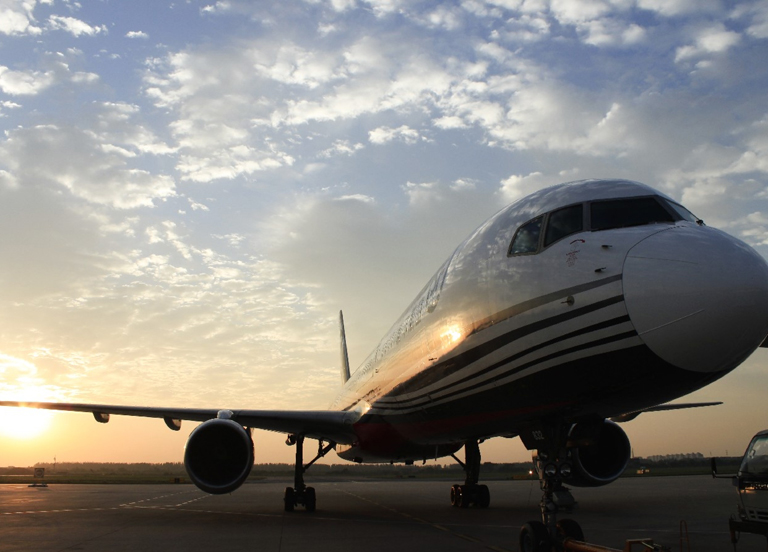
Getting to Suzhou
With a good location in the southeast of Jiangsu and central part of Yangtze River Delta, Suzhou enjoys convenient traffic condition.
By Flight: Suzhou has no airport, however, travellers can take flight to Sunan Shuofang International Airport in Wuxi, Shanghai Hongqiao International Airport and Shanghai Pudong International airport from different cities. Then take a high-speed train (from Shanghai) and shuttle bus (from Wuxi) to Suzhou.
By Tran: There are four train stations in Suzhou: Suzhou Railway Station, Suzhou North Railway Station, Suzhou Yuanqu Station and Suzhou Xinqu Railway Station. The high-speed train to Shanghai from Suzhou is only about half an hour, while to Hangzhou is about 1.5 hours.
By Road: Suzhou enjoys a sophisticated highway system. Visitors could easily get to Shanghai and Hangzhou within 2 hours and 2.5 hours by expressway. The road to Wuxi (45 km, 70 minutes’ drive), Zhouzhuang Water Town (46 km, 1 hour’s drive) and Tongli Water Town (27 km, 45 minutes’ drive) are also in good condition.
Getting around Suzhou
To travel around Suzhou, travellers can take public bus, tourist bus, Bus Rapid Transit, metro , taxi, bicycle and rickshaw. Choose the suitable transportation tools according to your detailed itinerary and needs.
Learn more about Suzhou Transportation>>
Accommodation
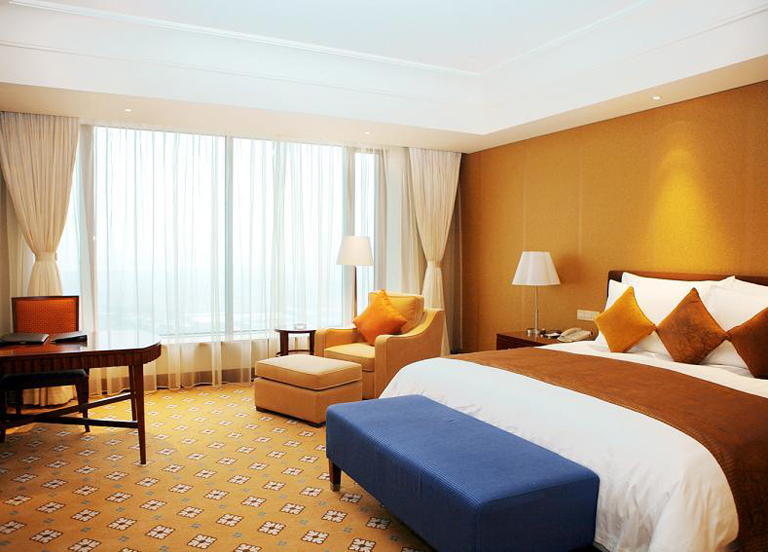
Suzhou offers tourists with all kinds of hotels, from 5-stars international brands to economic hotels and hostels. International brands, like Kempinski, Shangri-La and Crown Plaza can be found in Suzhou. The economic hotels in the city center are mainly located in Lindun Road and Yuanlin Road, while Guanqian Street, Shiquan Street, Ganjiang Road and Industrial Park have more starred hotels. For travellers who have other destinations after Suzhou, it’s recommended to stay near the railway station – not far from the attractions and has a convenient transportation. Besides, water towns of Suzhou are fully equipped with accommodation facilities.
Learn more about Suzhou Hotels>>
Useful Suzhou Maps
To help you to know more about Suzhou attractions and how to travel in the scenic spot, we have selected some useful Suzhou maps for you. Please feel free to use them. For more maps of Suzhou, please see Suzhou Maps.
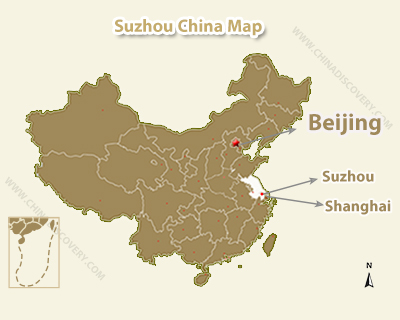
Suzhou Location Map
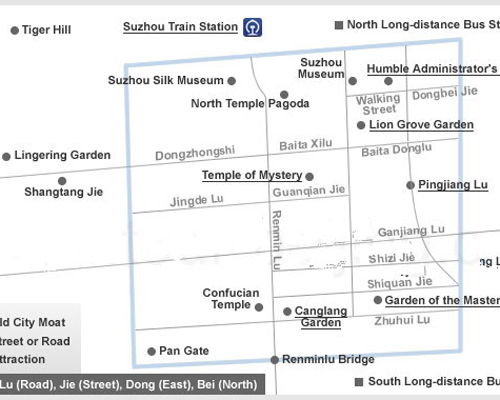
Suzhou Attraction Map
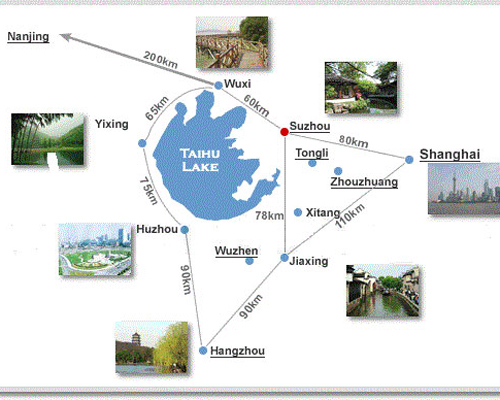
Suzhou Side Trip Map
Other Destinations Near Suzhou
There are some awesome destinations near Shanghai which are well worth your time and exploration. Travelers can visit exquisite Suzhou Gardens in Suzhou, West Lake in Hangzhou, Yellow Mountain with Hongcun, Xidi Ancient Village in Huangshan, also Dr. Sun Yat-sen Mausoleum in Nanjing. Discover now!
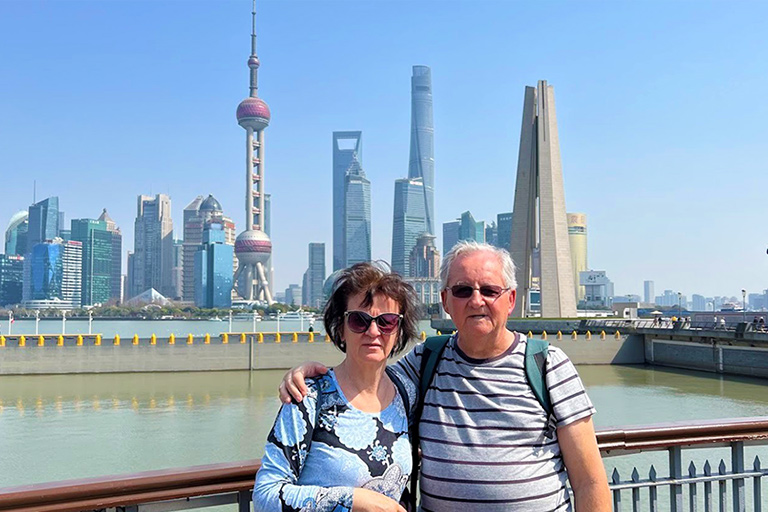
Chinese Name: 苏州
Chinese Pinyin: Sū Zhōu
English IPA: ['su:dʒəu]
Population: 10.6 million
Language: Mandarin & Suzhou Dialect
Tel Code: 0512
Zip Code: 215000
Time Zone: (UTC+8)
Plan your Suzhou Tour
Normally, travellers will need 2 ~ 3 days to explore the classic gardens and water towns in Suzhou. For those who have limited time, it’s possible to see the essence of Suzhou in one day, including the Humble Administrator’s Garden, Grand Canal, Suzhou No.1 Silk Factory. If you want to explore the water town and garden in one travel, then you’ll need at least three days. It’s suggested to choose one or two gardens and one water town into the itinerary to make sure you see the highlights of Suzhou.
Since Shanghai and Hangzhou are very close to Suzhou, and travellers can take high speed trains to travel among those cities. It’s advised 4 to 5 days for Suzhou and Shanghai tour, while 3 to 4 days for Suzhou and Hangzhou tour. If you want to travel the three cities at one time, you’ll need at least 6 days.
Recommended Tours
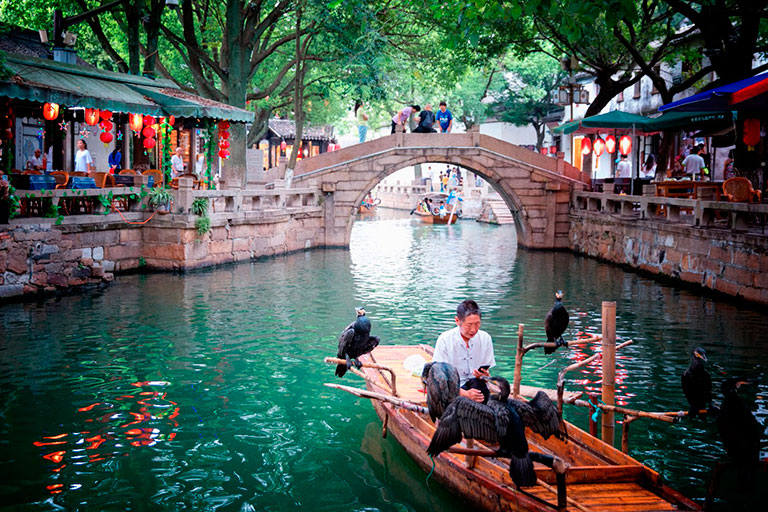
Suzhou / Tongli Water Town
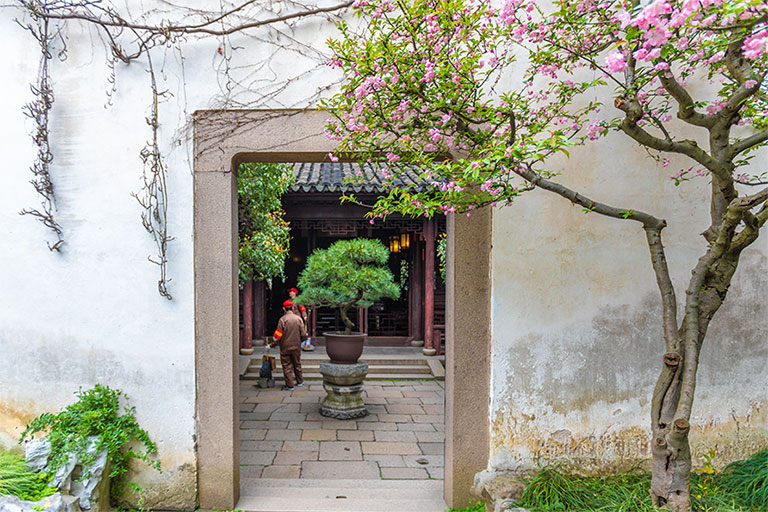
Shanghai / Tongli / Suzhou / Shanghai
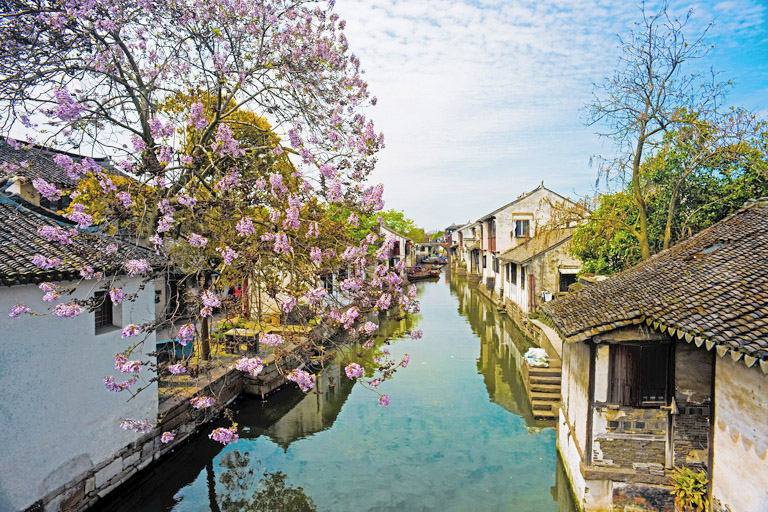
Shanghai / Suzhou / Zhouzhuang / Shanghai
Start planning your tailor-made holiday to China by contacting one of our specialists. Once inquired, you’ll get a response within 0.5~23.5 hours.

- Affordable and valuable price
- 100% tailor-made packages
- Highly rated customers reviews
- Efficient customer support
China Tours
- Top 10 China Tours
- Classic China Tours
- China Tours from Beijing
- China Tours from Shanghai
- China Tours from Hong Kong
- China Tours from Chengdu
- Short China Trips
- Customize China Tour
- China Panda Tours
- Family Tour with Kids
- High-Speed Train Tour
- Silk Road Travel
- Yangtze River Cruise
- Hiking & Trekking Tours
- Photography Tours
- China Minority Travel
- Beijing Shanghai Tours
- Shanghai Yangtze Tours
- Chengdu Jiuzhaigou Tours
- Chengdu Lhasa Tours
- Suzhou Hangzhou Tours
- Guilin & Yangshuo
- Zhangjiajie
“Very good experience”
“WONDERFUL 25 DAYS IN CHINA - PRIVATE TOUR”
“Awesome China tour from northeast to southwest”
Any questions, please email us at: [email protected] or call us at: 86-19138970032 (Monday-Friday 9 a.m. to 6 p.m. GMT+8)
- Terms & Condition
- Privacy Policy
- Customer Support
Copyright © 2011-2024. All rights reserved.
Cookie policy
We use cookies to give you the best experience on our website. Continue using our website means you agree with our cookie policy. For more info, please read here .
- Destinations
- Travel Tips
- Community Trips
- TTIFridays (Community Events)
- SG Travel Insider (Telegram Grp)

5D4N Suzhou and Hangzhou Itinerary — Soak In the Beauty of Tiger Hill, West Lake and More
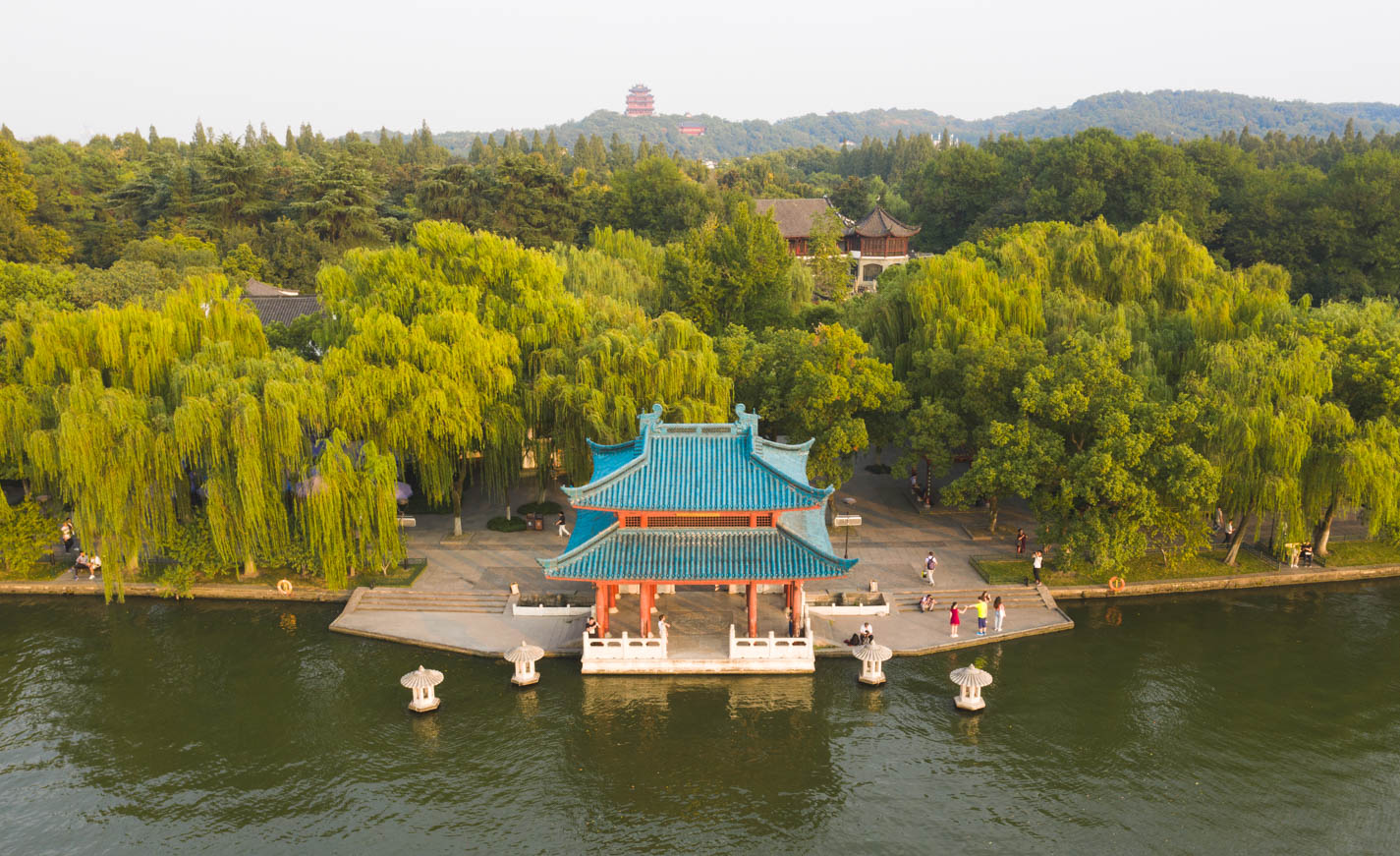
Looking to explore the scenic, quainter side of China? This Suzhou and Hangzhou itinerary discovers the cities seemingly trapped in time .
Beijing and Shanghai are like the cool kids at the high school cafeteria, showing off their fancy gadgets (read: modern skyline) and stature (read: Great Wall). But Suzhou and Hangzhou in the introverts’ corner deserve some attention too!
Although Suzhou and Hangzhou aren’t typically first-choice destinations in China, they have their own special charms that make them worth visiting from the famous West Lake to its beautifully preserved ancient towns. Plus, Suzhou is only a one-hour train ride from Shanghai (more details later)! You could easily fit it into your Shanghai itinerary.
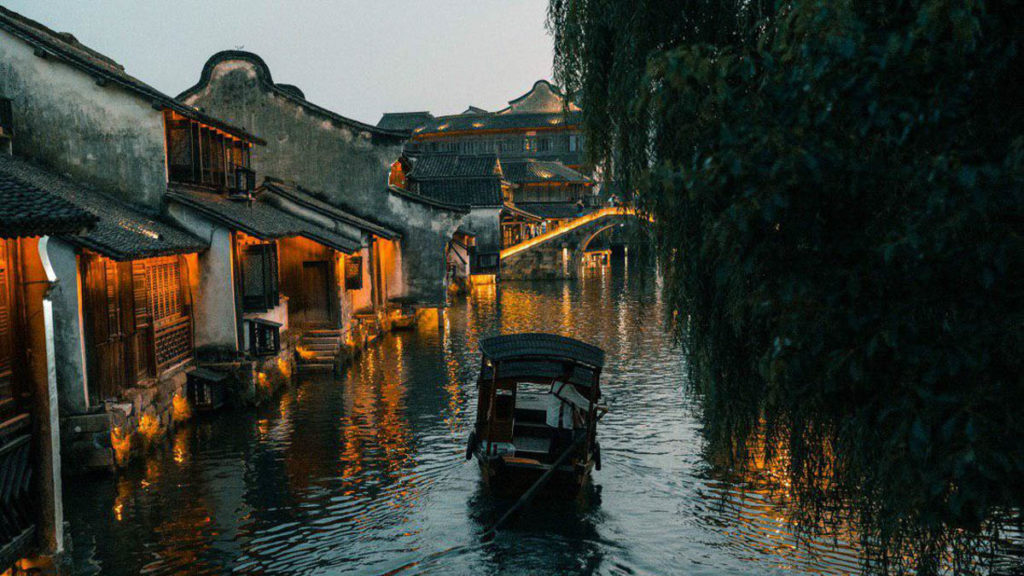
There’s a Chinese proverb, “上有天堂 下有苏杭”, which means “Above there’s heaven, below there’s Su Hang (Suzhou and Hangzhou)”. After our experience, we could totally see why these cities are known as heaven on earth.
Read on for our Suzhou and Hangzhou itinerary where we explore the best of these cities!
Pre-trip Essentials
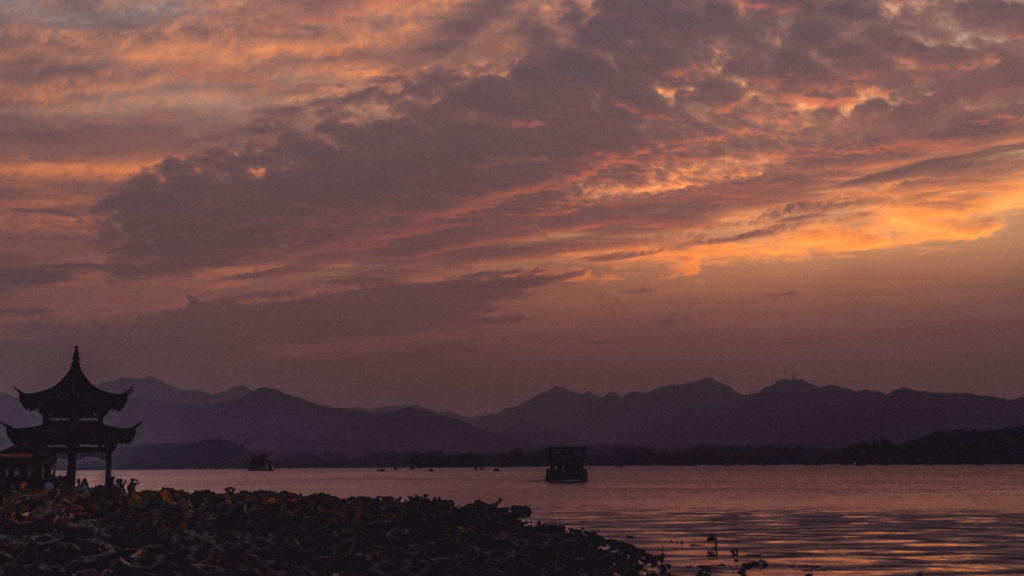
Connectivity: We pre-booked our 4G SIM Cards online (~S$15) with 2GB, 3GB and 6GB options for 30 days, which we picked up at the Shanghai airport. To access sites like Google and Instagram, you’ll have to download a VPN app like VPN Proxy Master .
Essential apps: Getting around is easiest with Didi , China’s version of Uber. There’s even an auto-translation feature to communicate with drivers, and you can pay with either card or cash. (Click here for other essential apps to download !)
Flights: We travelled to Suzhou after visiting Shanghai. You can check flight prices to Shanghai with this nifty widget:
If you can’t see the widget above, click here to check flights from Singapore to Shanghai instead!
Read also: 25 Things To Do In Shanghai — From the Must-dos To the Hidden Gems
Day 1 (Suzhou): Bike Tour, Tiger Hill And Humble Administrators Garden
Getting from Shanghai to Suzhou: Take a one-hour train ride from Shanghai South Railway Station ( book tickets here ).
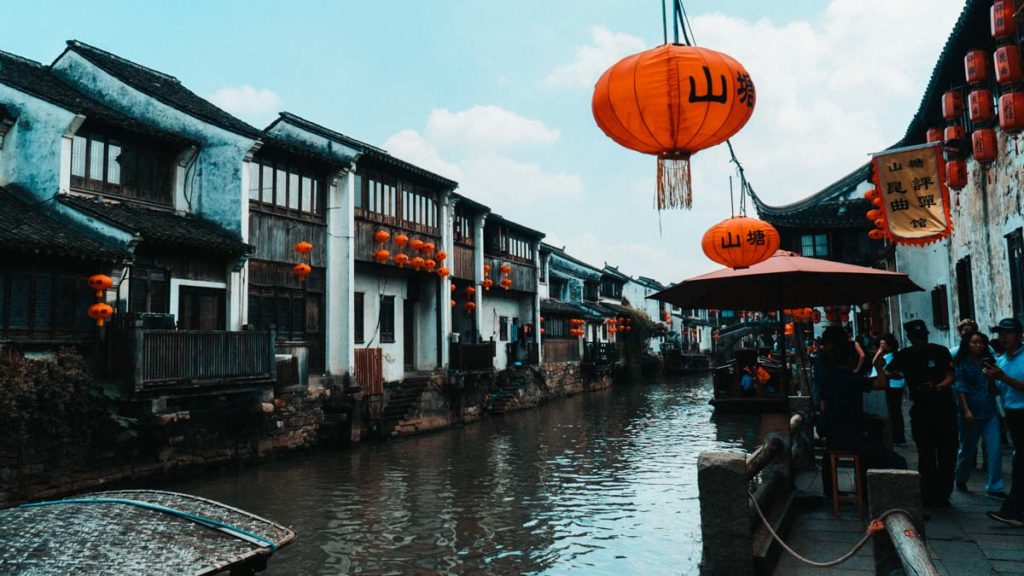
Half-Day Bike Tour
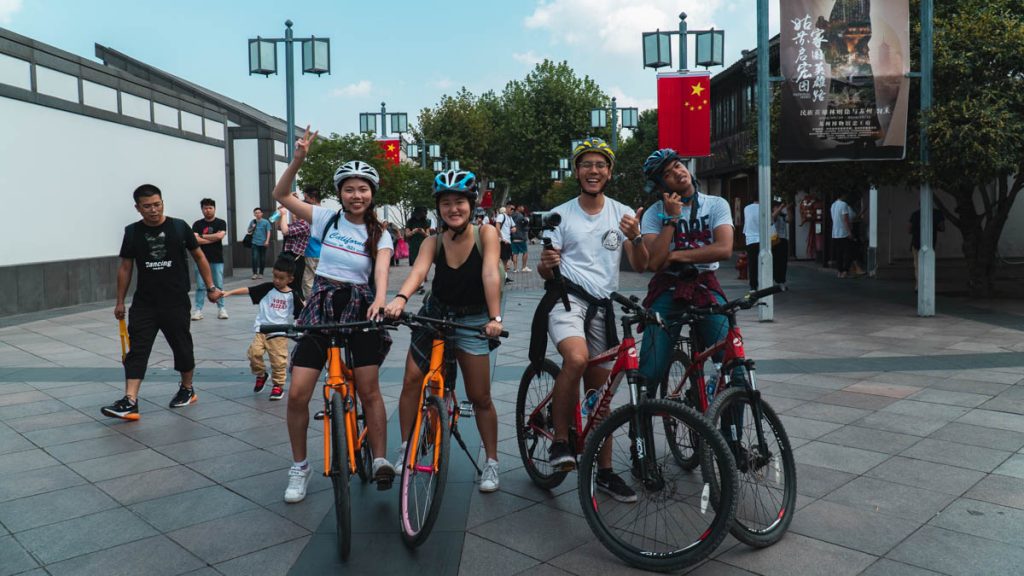
Coming from someone who hardly cycles back home, this half day tour was real fun — it’s almost like a “welcome to Suzhou” package that takes you to the best sights of the city. Here are the highlights from the three-hour tour:
(1) Suzhou Museum: Designed by the same architect who designed the Louvre in Paris, Suzhou Museum is home to an impressive collection of Chinese relics. Drop by for a history lesson or two.
(2) Pingjiang Historic Block: Pingjiang Historic Block is an 800-year-old street with classic cobblestone pavements and a river flowing through. You’re practically transported back to ancient Suzhou!
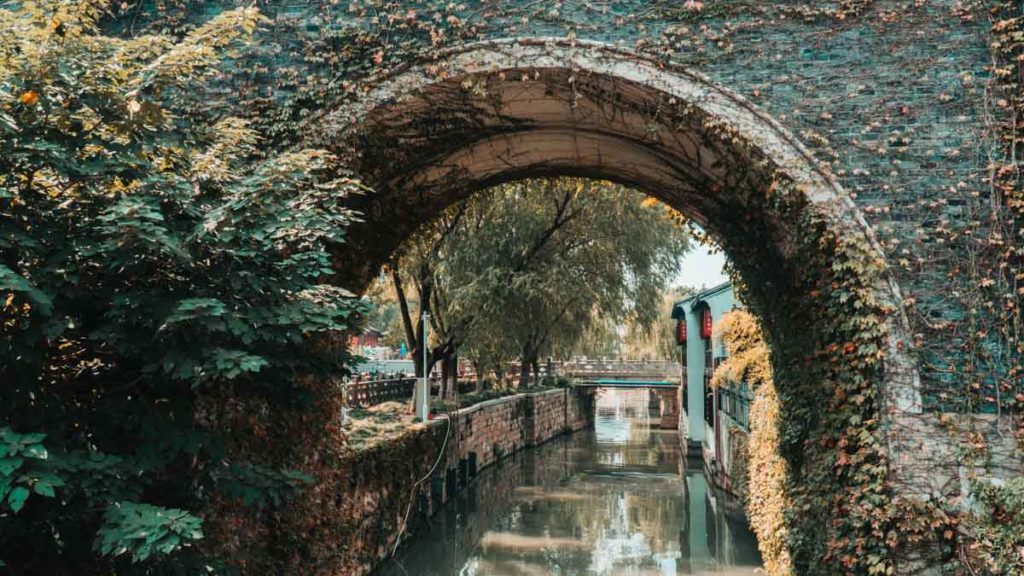
(3) Ancient City Wall: Built to fortify and protect Suzhou 2,500 years ago, the ancient city walls now represent an important part of the city’s heritage. Eight gates surround Suzhou’s historic district, and still retains the grandeur of the original architecture.
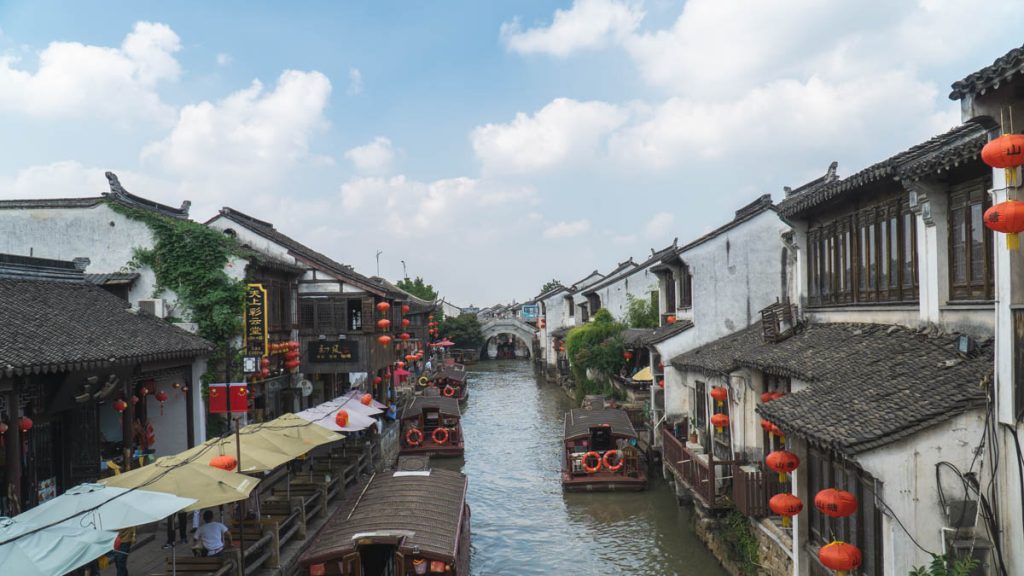
Shantang Street
(4) Shantang Street: Previously a commodities hub, Shantang Street is now a popular pedestrian street home to several shops and restaurants. Also known as Seven-li Shantang, this street stretches for 11km from Changmen Gate to Tiger Hill.
Cycling and electric biking is pretty big in Suzhou. If you want to see the city like a local, this is the way to go. Our guide was very experienced and expertly navigated the alleyways so rest assured you’re in safe hands!
Suzhou Highlights Half Day Biking Tour Cost: ~S$73.80 (incl. bikes and English-speaking guide) Tour hours: 9:30AM – 1PM Address: Intersection of Shiquan Street and Fenghuang Street, Suzhou (苏州十全街凤凰街路口)
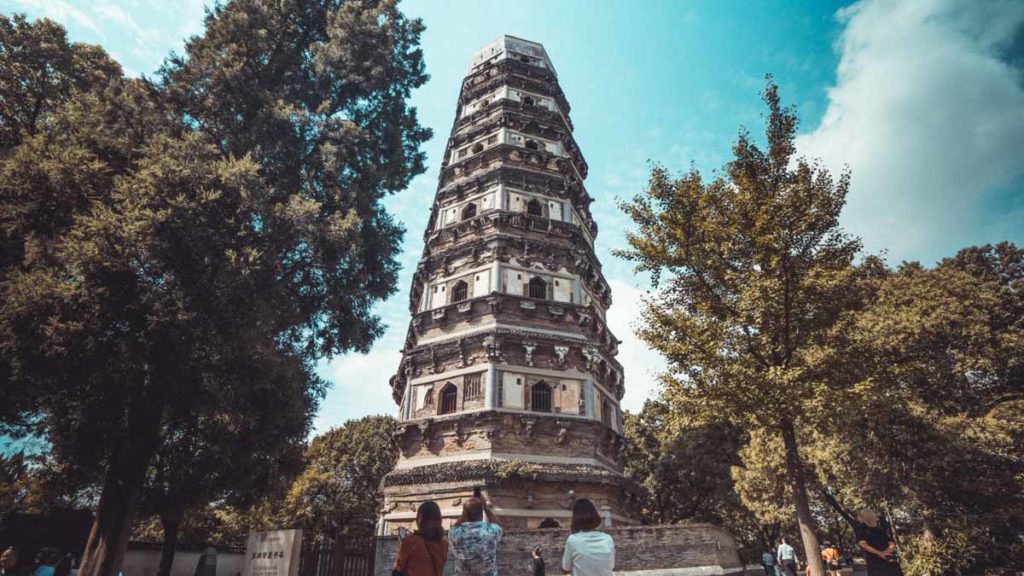
One of Suzhou’s most famous attractions is Tiger Hill . It’s said that three days after the King of Wu State, He Lu was buried here, a white tiger was spotted guarding the tomb, hence giving the place its name.
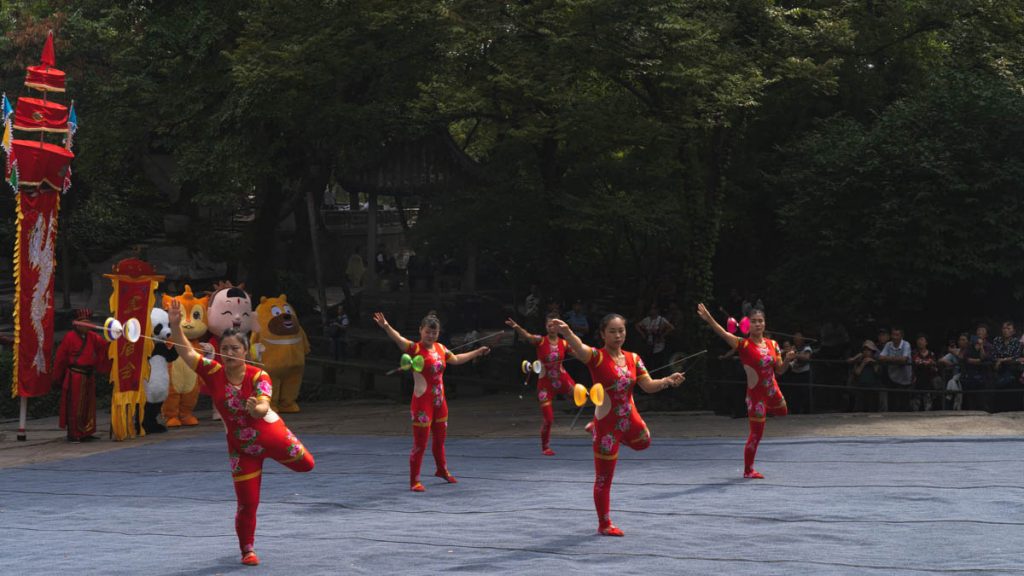
The Tiger Hill pagoda leans at a 4° angle, giving it its reputation as China’s answer to the Leaning Tower of Pisa. No need to fly all the way to Italy to take a silly photo of you holding up the tower!
If you’re lucky, you might catch a free street performance while you’re there.
Entrance fee: 80RMB (~S$15.50) Opening hours: 7:30AM – 5:30PM Address: Jinchang District, Suzhou City, Jiangsu Province 215008, China (江苏省苏州市金昌区215008)
Humble Administrator’s Garden
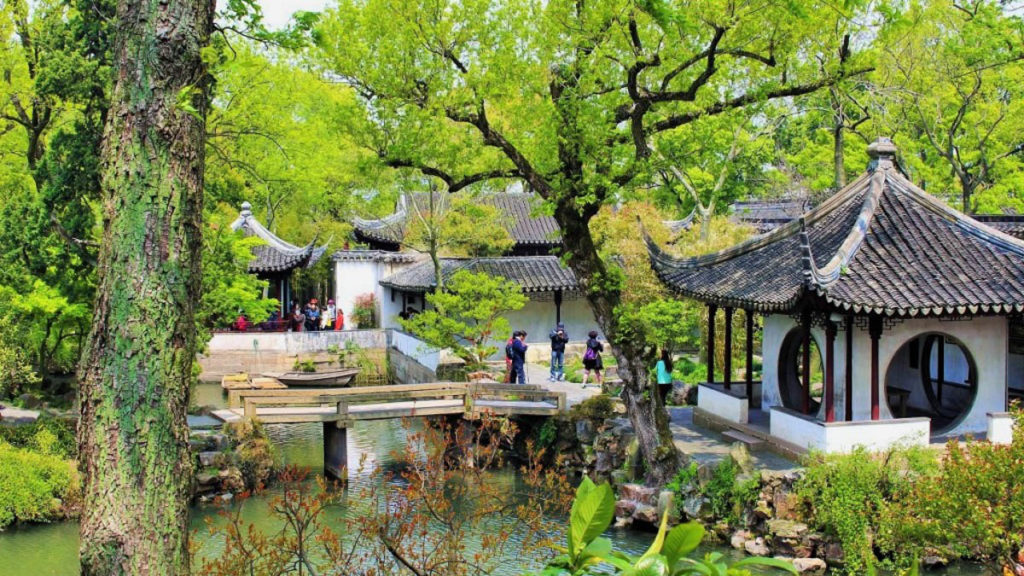
Photo credit: China Unlimited
Listed as a World Cultural Heritage site in 1997, the Humble Administrator’s Garden is Suzhou’s largest garden. Built in 1509, it’s among the best classical gardens and is home to mesmerising lakes, rock formations, nature and pavilions. Definitely a must-see while in town!
Entrance fee: 70RMB (16 Apr – 30 Oct), 50RMB (31 Oct – 15 Apr) Opening hours: 7:30AM – 5:30PM Address: No.178 Dongbei Street Pingjiang District, Suzhou City, Jiangsu Province (江苏省苏州市平江区东北街178号)
Enjoy Local Cuisine at Yang Yang Dumpling Restaurant
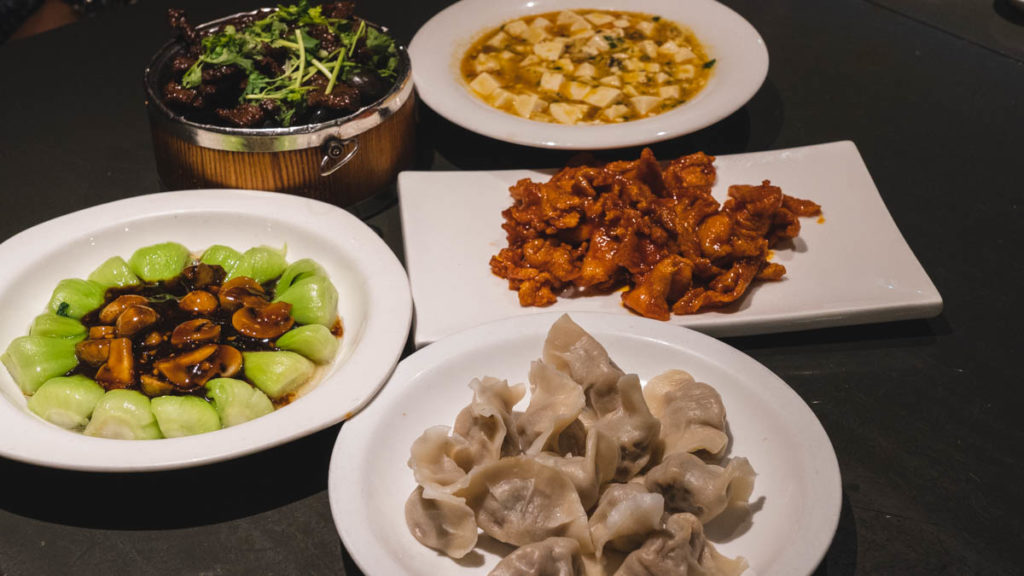
It’ll be a sin to leave without trying some local food. Yang Yang Dumpling Restaurant is a popular option specialising in dumplings, but also serves other delicious Chinese dishes. We tried the stone roasted beef, sweet and sour chicken and beef dumplings, and left with very happy bellies.
Prices here are more than reasonable for the quality so we left with happy wallets as well. Score!
Cost: 50RMB/pax (~S$10) Opening hours: 10AM – 2:30PM, 5PM – 9PM Address: CangLang District ShiQuan Street 420, Suzhou, China (苏州市沧浪区十权街420号)
Shop Till You Drop at Guanqian Street
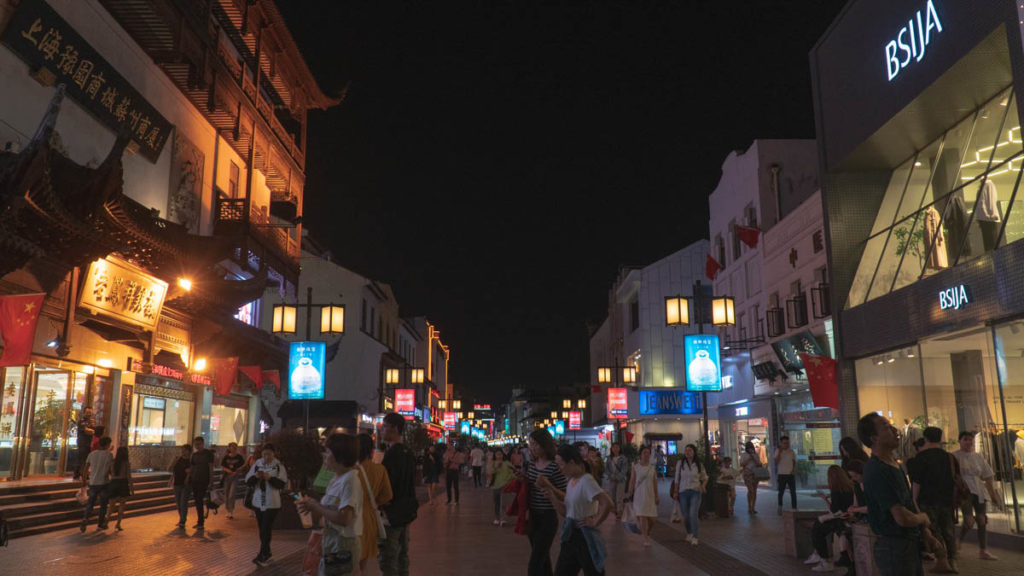
Suzhou isn’t just gardens and ancient towns, there’s so much shopping and eating to do here as well! Located at the heart of old Suzhou, Guanqian Street is a pedestrian street with hundreds of shops and street food stalls. It’s only a 20-minute walk from Yang Yang Dumpling Restaurant so head here for post-dinner shopping and supper.
Opening hours: Most shops close by 10PM Address: Guanqian Street, Gusu, Suzhou, Jiangsu, China (中国江苏省苏州市姑苏市观前街)
Day 2 (Suzhou): Jinxi Ancient Town and Jinji Lake
Jinxi ancient town.
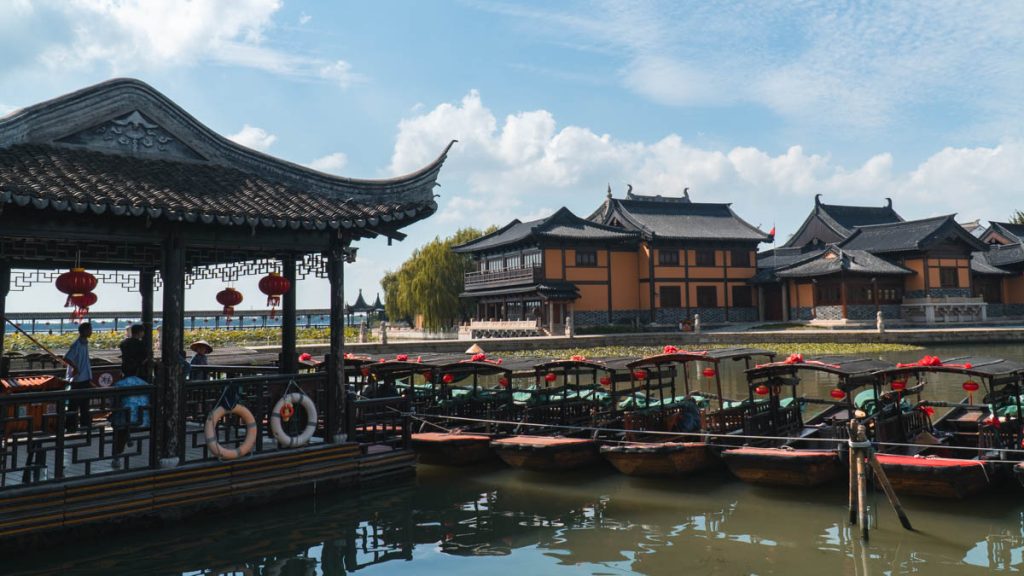
Known as the “Town of Bridges”, Jinxi Ancient Town has an impressive 36 bridges connecting 16 lakes and 238 rivers. If you’re looking to visit an ancient town unpolluted by commercialism, this is it. The town is pretty quiet, and I imagine hasn’t changed too much from back in the day.
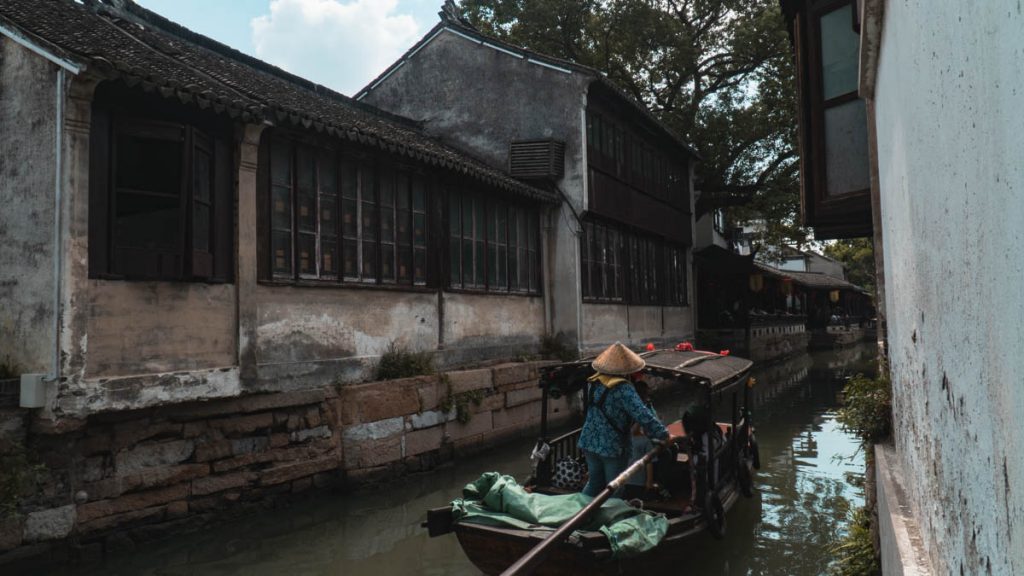
We took a boat tour that brought us through the town (it has that many lakes and rivers after all), and realised you generally won’t need to spend too much time here to cover everything. We recommend heading back to the city for lunch as there aren’t too many options there.
Cost: ~S$8.75 per person Opening hours: 8AM – 4PM Address: Jinxi Ancient Town, Wenchang Rd, Kunshan Shi, Suzhou Shi, Jiangsu Sheng, China (中国江苏省苏州市昆山市文昌路锦西古镇)
Jinji Lake Scenic Area
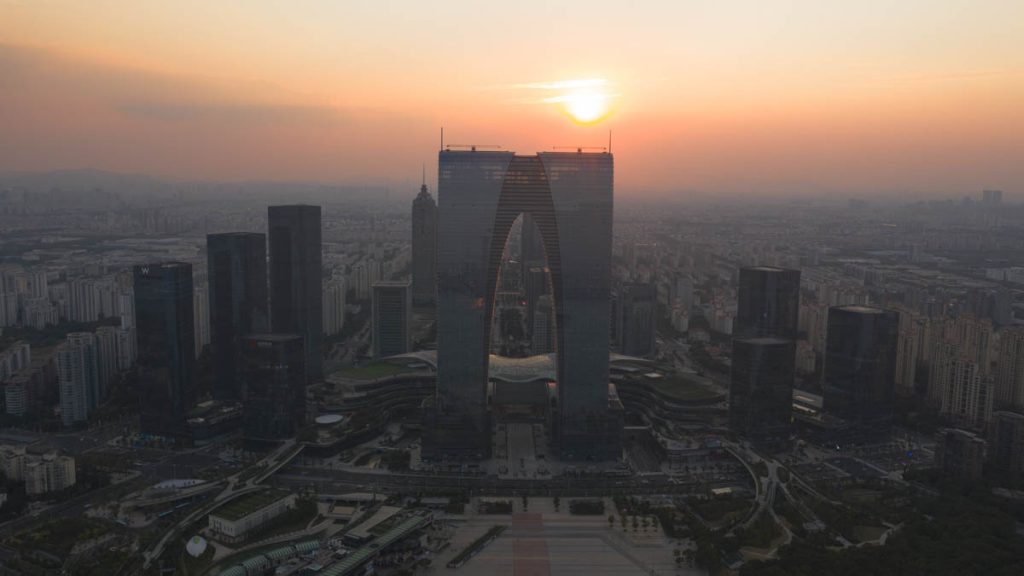
The area around Jinji Lake lets you in on the modern side of Suzhou. It’s the largest city park in China, and a great place to catch the sunset against the backdrop of Suzhou Center Mall .
If you’re a thrill-seeker, visit the Suzhou Ferris Wheel Amusement Park (60RMB) which sits on the opposite, east bank of the lake. There’s a 120m-tall ferris wheel which offers magnificent views of the city!
Address: Jinjihu Road, Wuzhong District, Suzhou 215000, China (苏州吴中区金鸡湖路215000)
Day 3 (Hangzhou): Exploring Xixi Wetlands And West Lake Scenic Area
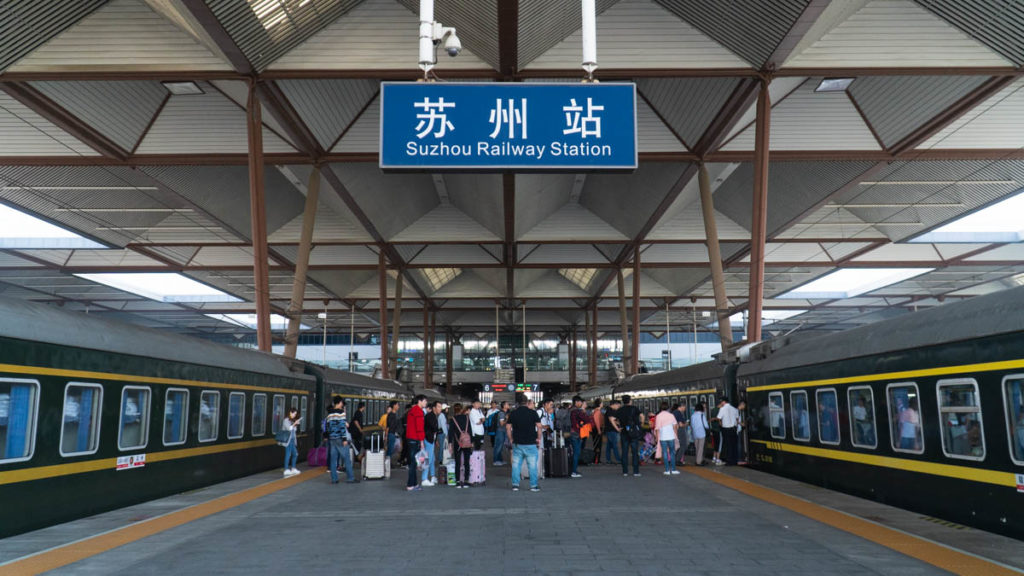
Getting from Suzhou to Hangzhou: Take the train from Suzhou Railway Station to Hangzhou ( from S$8.05 ) which takes between one and a half to five hours, depending on the type of train you select.
Xixi Wetlands
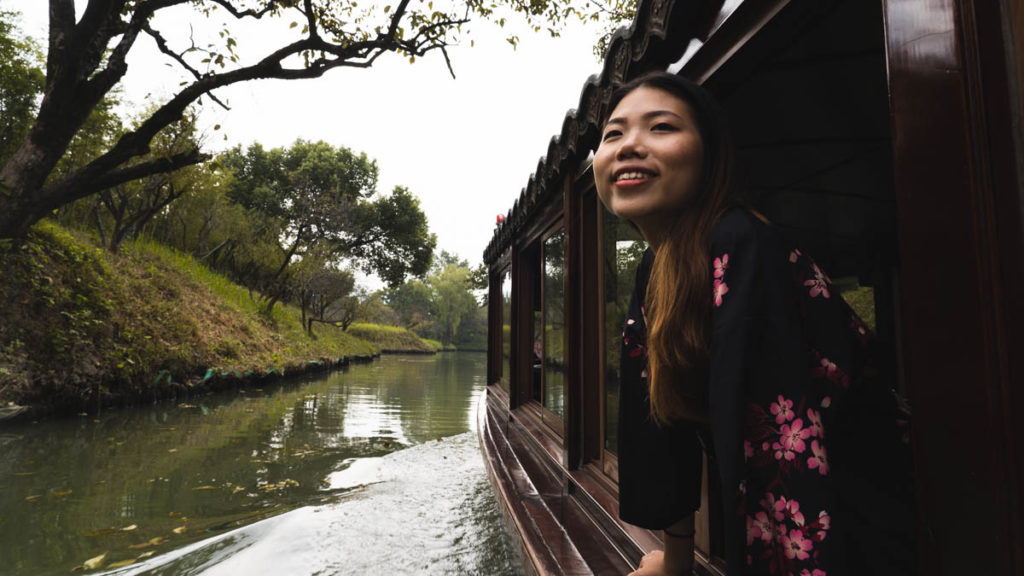
Switch out city views for some lush forests and beautiful waterscapes. Located 5km from West Lake is Xixi Wetlands , a scenic urban wetland. It’s over 1,800 years old and is the first national wetland park in China!
Enjoy the scenery by taking a boat ride (60RMB) through the wetlands. During the annual Dragon Boat Festival in late June, the area becomes the grounds for major dragon boating competitions and dragon dancing performances.
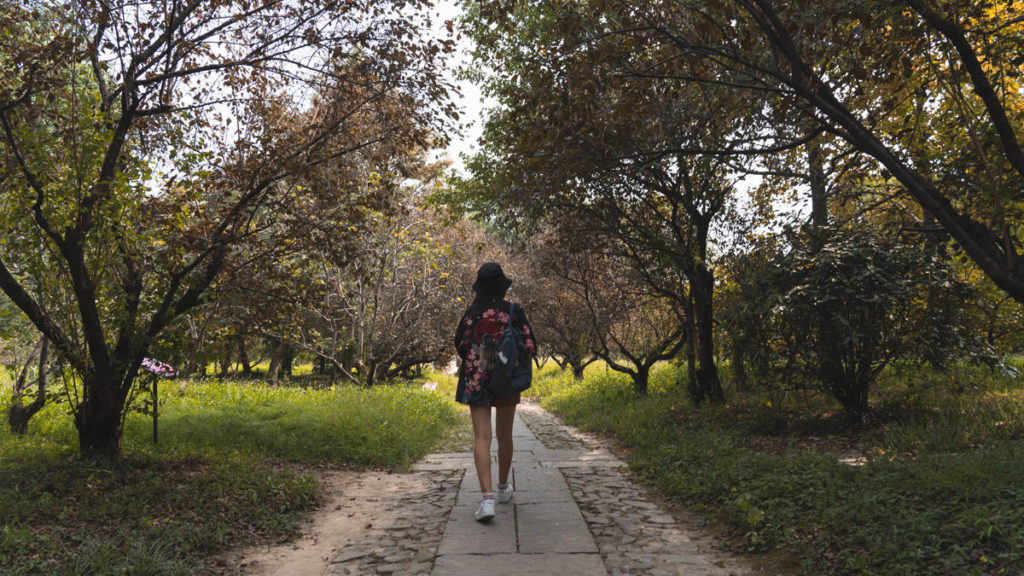
Entrance Fee: 80RMB (40RMB for students) Opening Hours: 8:30AM – 5:30PM Address: 518 Tianmushan Road, West Lake District, Hangzhou, Zhejiang (浙江省杭州西湖区天目山路518号)
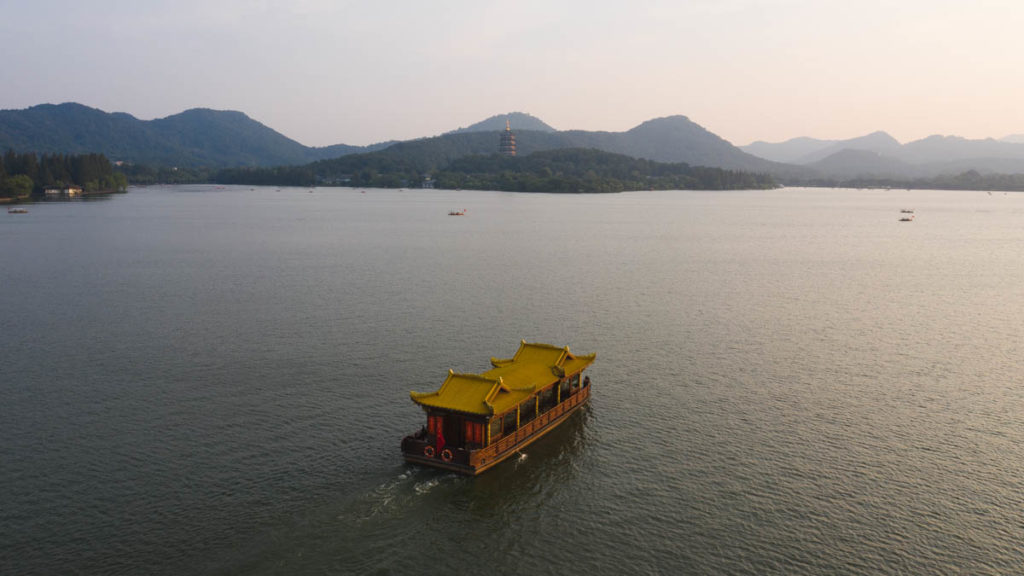
Just like how Shanghai has The Bund , Hangzhou has West Lake . West Lake is Hangzhou’s most popular sight and is widely regarded as one of the most beautiful places in China. Locals flock here to dance (yes), exercise and spend time with friends and family.
The lake stretches for 3.2km and is home to several attractions like the Leifeng Pagoda and Three Pools Mirroring the Moon (see below). Opt to take a boat ride to enjoy West Lake from the water (55RMB)!
Address: West Lake, Hangzhou, 310000 China (西湖杭州310000)
Three Pools Mirroring The Moon
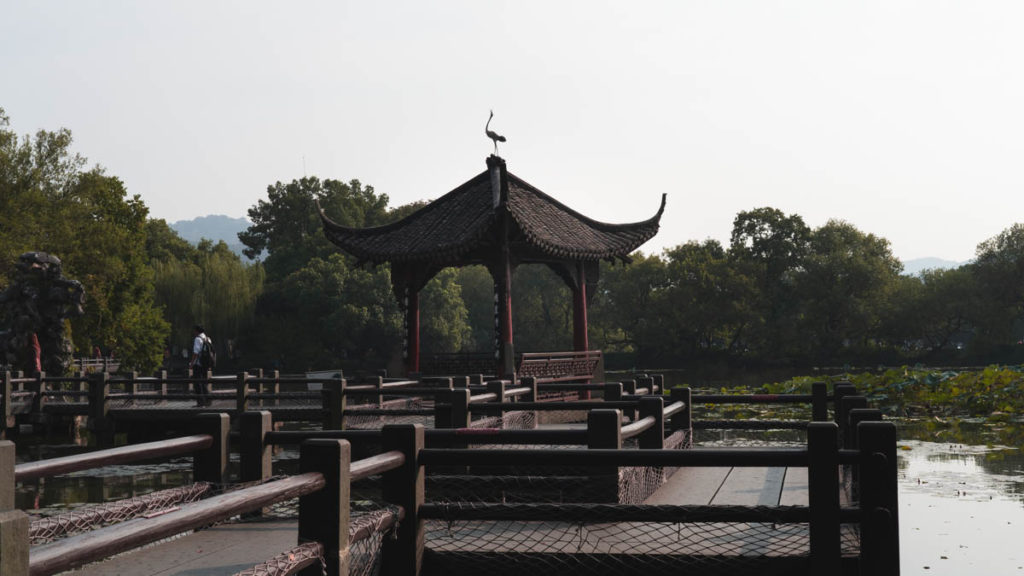
The Three Pools Mirroring the Moon is actually printed on the one yuan bill! It’s on the south side of West Lake and you can only access it via boat for 55RMB. Look out for the three stone towers perched on three deep pools, seen as a symbol of Hangzhou.
Entrance fee: 55RMB (incl. boat and entrance ticket) Opening hours: 8AM – 5PM Address: Santanyinyue Islet, Xihu District, Hangzhou 310007, China (杭州市西湖区三潭音月岛,杭州310007)
Leifeng Pagoda
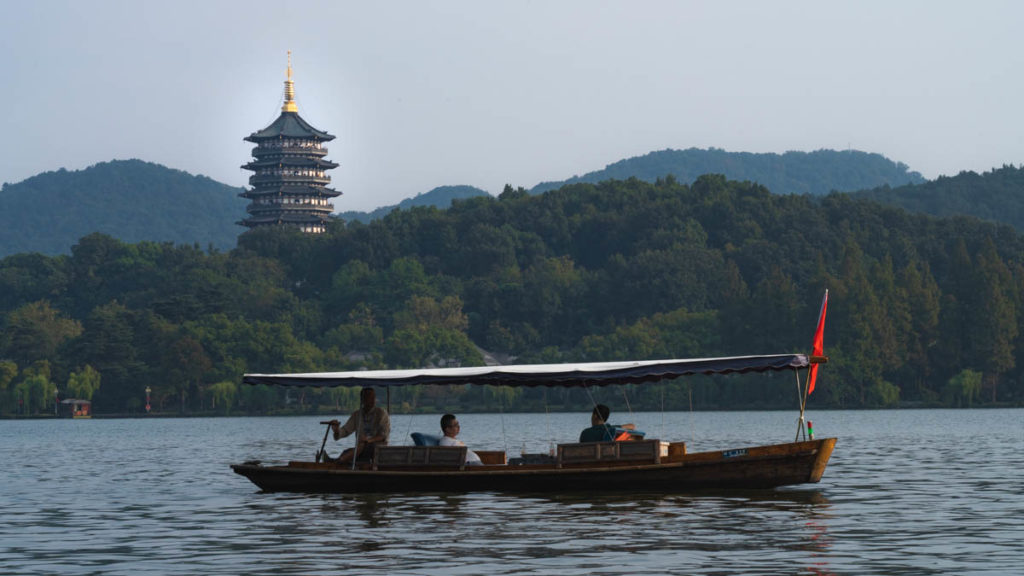
Situated on Sunset Hill overlooking West Lake is Leifeng Pagoda , a five storey-tall pagoda constructed in AD 975. Although the original structure collapsed in 1924, the building was rebuilt in 2002 and is now one of Hangzhou’s most popular attractions.
Leifeng Pagoda is famous for its legendary love story where a young scholar falls in love with a beautiful woman. Turns out she’s actually a white snake in human form! A monk finds out and intervenes by casting the white snake into a well at Leifeng Pagoda.
Today, the pagoda provides an excellent vantage point for a panoramic view of West Lake. Don’t worry, you won’t find white-snake-humans there anymore.
Entrance fee: 40RMB (20RMB for students) Opening hours: 8AM – 8PM (May – Sep), 8AM – 5:30PM (Sep – May) Address: 15 Nanshan Rd, Xihu, Hangzhou, Zhejiang, China, 310007 (中国浙江省杭州市西湖区南山路15号310007)
Marvel at the Sunset from West Lake
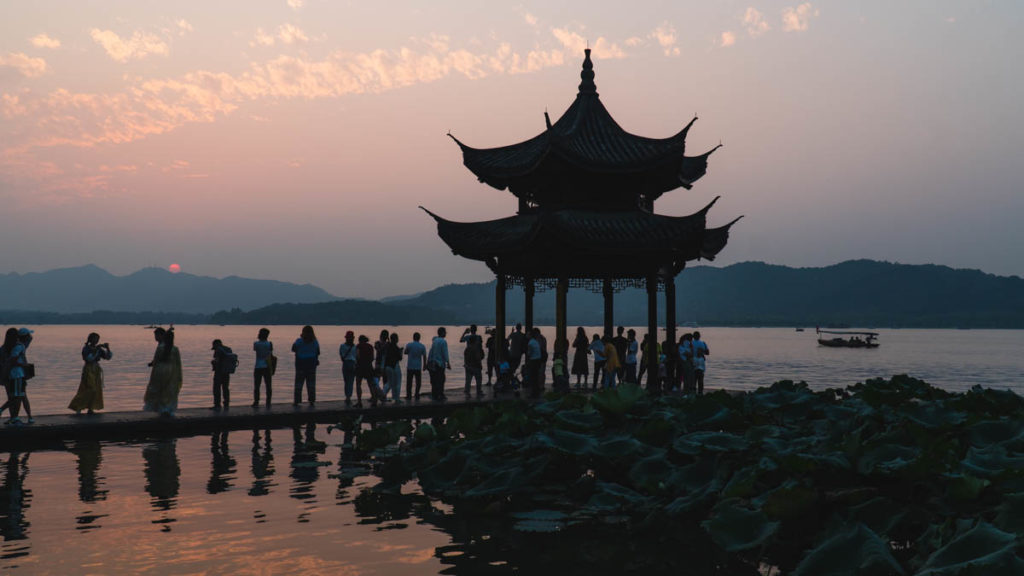
I’ve always loved sunsets. Especially ones with vibrant pinks and oranges. The sunset here did not disappoint and wrapped up our West Lake journey beautifully.
Hubin Pedestrian Street, Hangzhou’s Main Shopping District
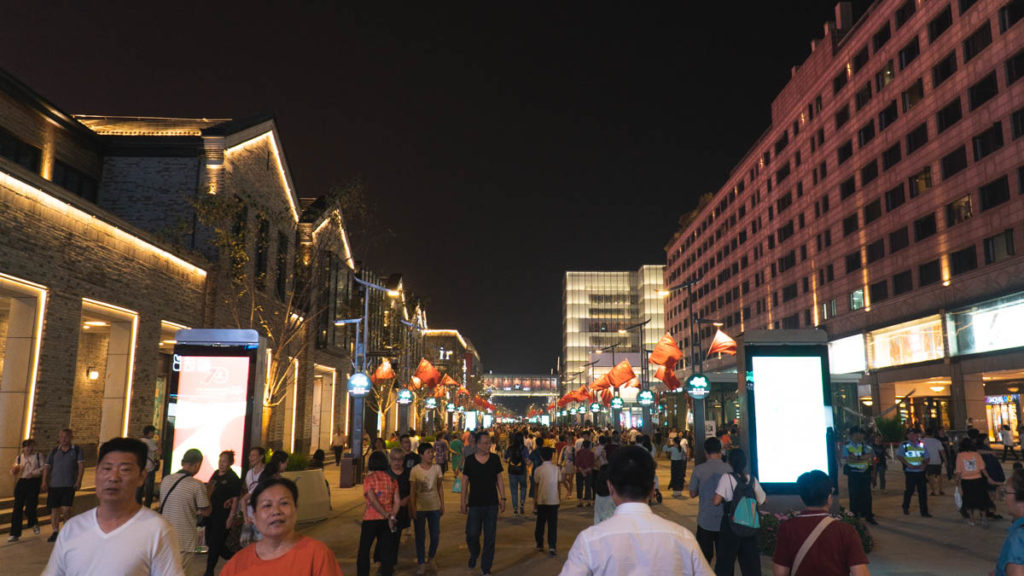
Situated parallel to West Lake is Hangzhou’s vibrant shopping district, Hubin Pedestrian Street. This area is so modern and packed with mega-malls and big brands, I forgot I was in Hangzhou. The major roads for shopping are Dongpo Road, Yan’an Road and Xueshi Road.
Opening Hours: Most shops close by 10PM Address: Hu Bin Lu, Hu Bin Shang Quan, Shangcheng Qu, Hangzhou Shi, Zhejiang Sheng, China (胡斌路,胡斌商圈,上城区,浙江省杭州市)
Enjoy Local Delicacies Along Wushan Road
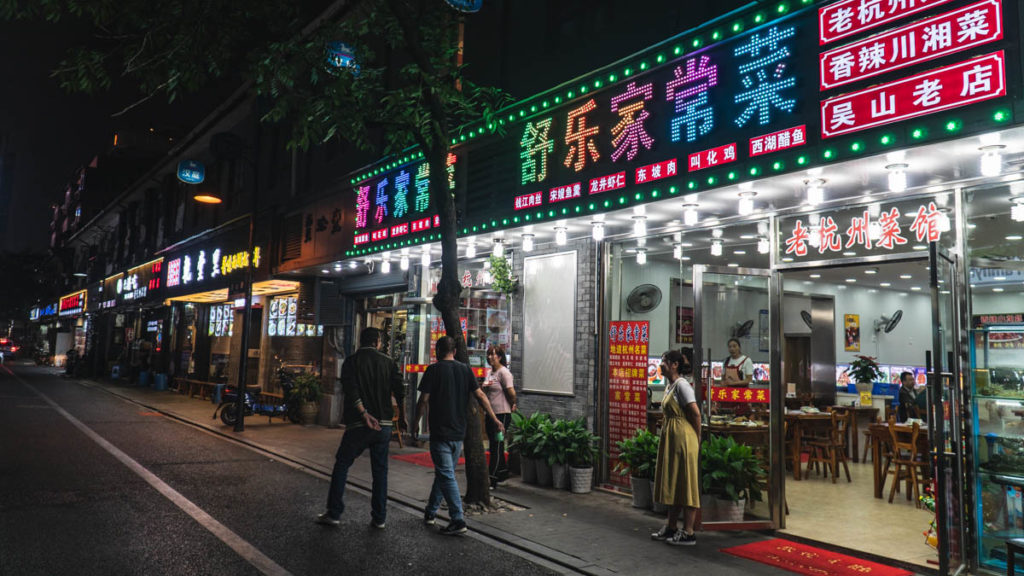
Just off the main shopping area, you’ll find plenty of smaller streets like Wushan Road. There are several local restaurants selling Hangzhou’s must-try delicacies.
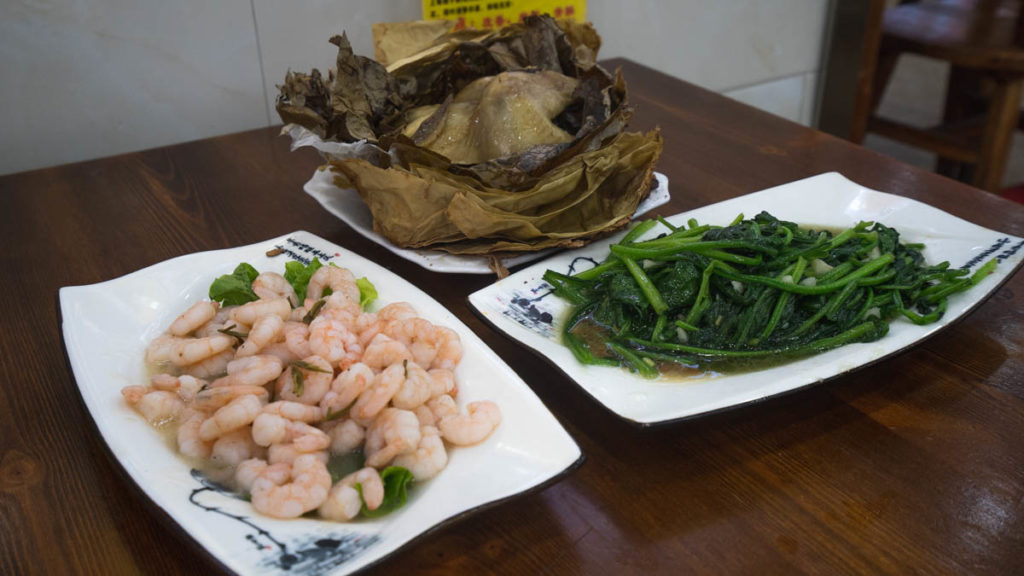
We had dinner at unit 112 on Wushan Road and ordered local delicacies like beggar’s chicken, long qing tea shrimp and garlic spinach for a total of 150RMB (~S$15/pax).
Address: Wu Shan Lu, Shangcheng Qu, Hangzhou Shi, Zhejiang Sheng, China (中国浙江省杭州市上城区曲山路吴山路)
Check Out Fake Goods at Wushan Night Market
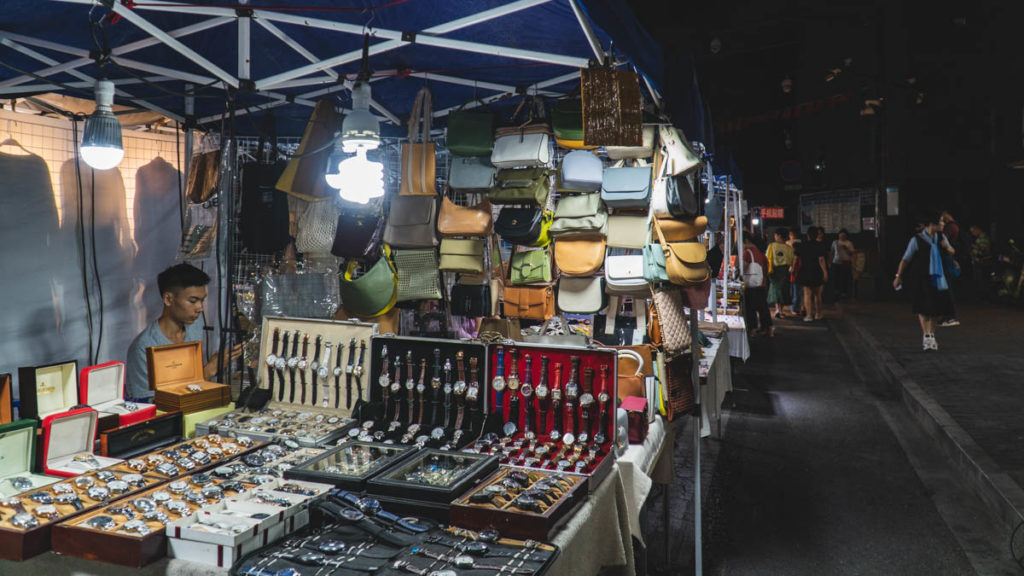
Don’t scroll past just yet at the sight of “fake goods” — if you’re up for more shopping after dinner, just a 15-minute walk away is Wushan Night Market . A different kind of shopping from the upscale Hubin Pedestrian Street, you’ll find all sorts of knock-off goods and other cheap buys here. From shoes to bags! Reminds me of Singapore’s pasar malam night markets.
Opening hours: 7PM – 10PM Address: Renhe Rd, Hu Bin Shang Quan, Shangcheng Qu, Hangzhou, China (杭州市上城区湖滨上泉人和路)
Day 4 (Hangzhou): Mount Mogan & Hefang Street
Hiking at mount mogan.
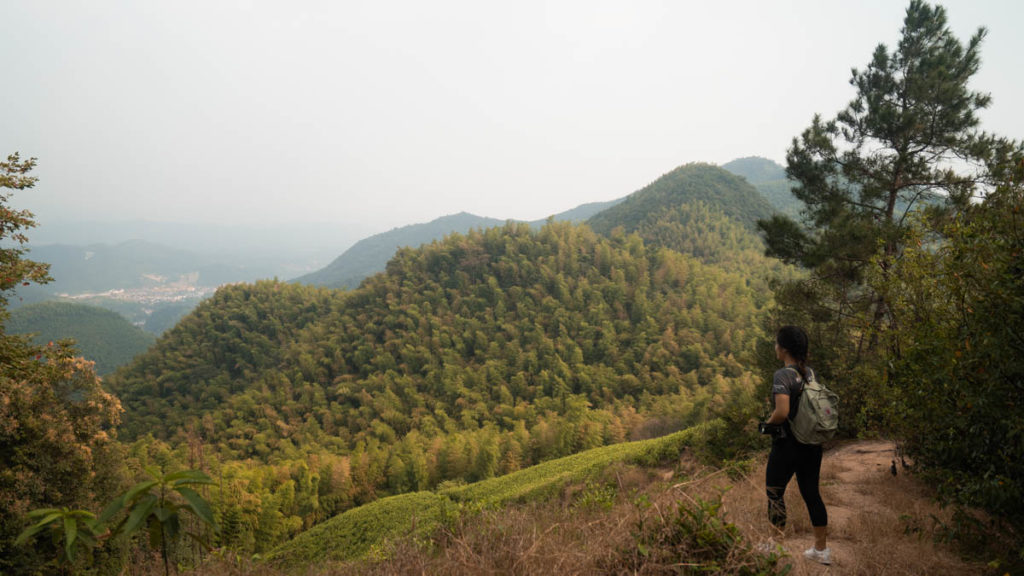
Mount Mogan , or Moganshan, has three peaks, the highest of which is called Ta Shan at 724m tall. Known as the “Hamptons of China”, Moganshan was popular amongst missionaries, business people and politicians as a resort getaway with Chiang Kai-shek and Mao Zedong as some of its famous former residents.
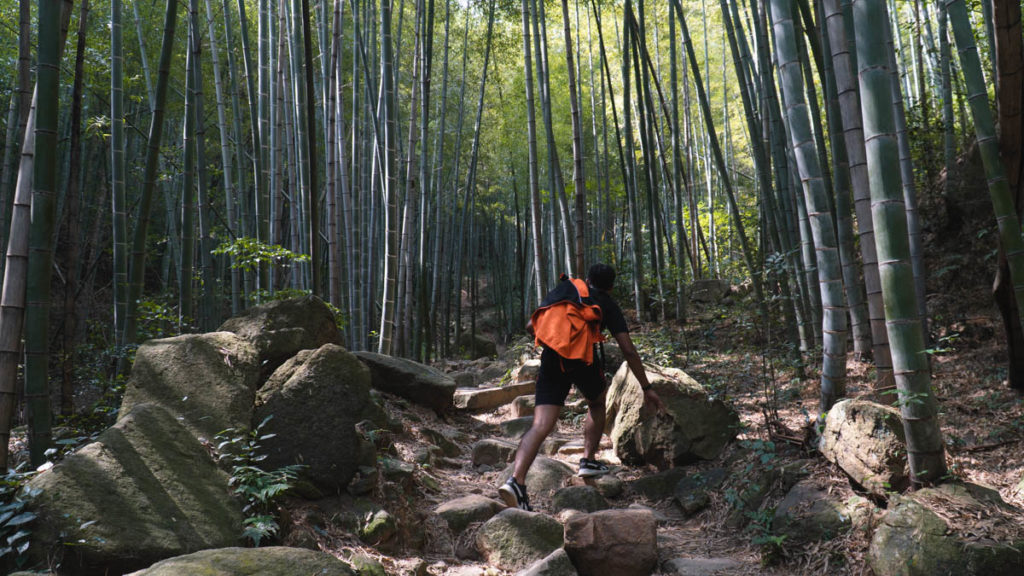
We took a five-hour round trip hike as part of a day tour, and it was a welcome change of scenery from the main city (and a good work out!). Don’t worry about melting under the heat — the lush bamboos provide ample shade and give off an air of tranquillity. Kinda feels like where Kungfu Panda would come to find inner peace.
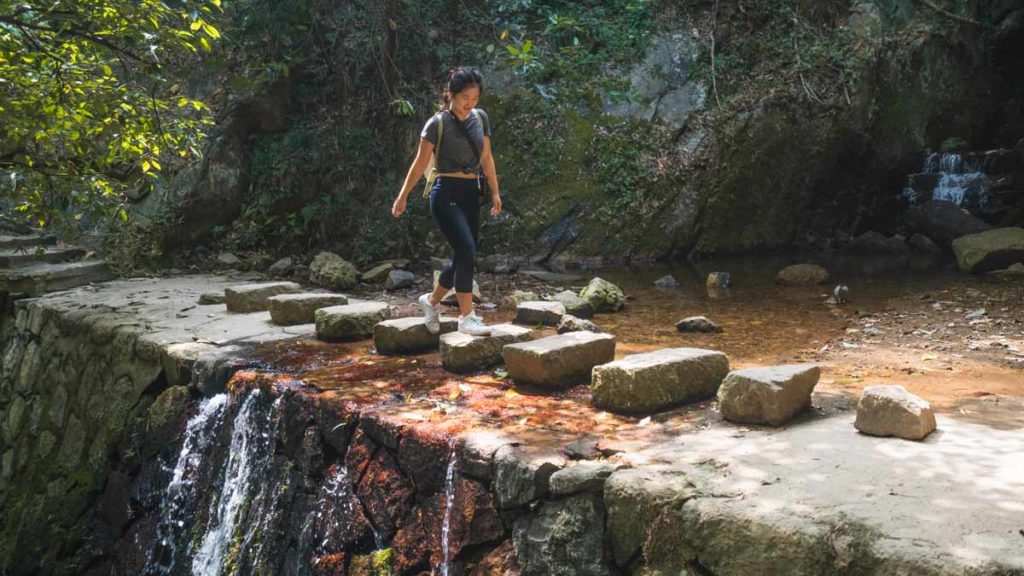
We got to enjoy a homey local lunch as part of the private tour — chicken soup, bamboo with pork, tofu with carrots and bitter gourd.
Mount Mogan Hiking Day Tour Cost: From ~S$100 (incl. round trip transport, guide, entrance fees and lunch) Tour hours: 8:30AM – 6:30PM Address: Moganshan Town, Deqing County 313200, China (中国德清县莫干山镇313200)
Dinner and Shopping at Hefang Street
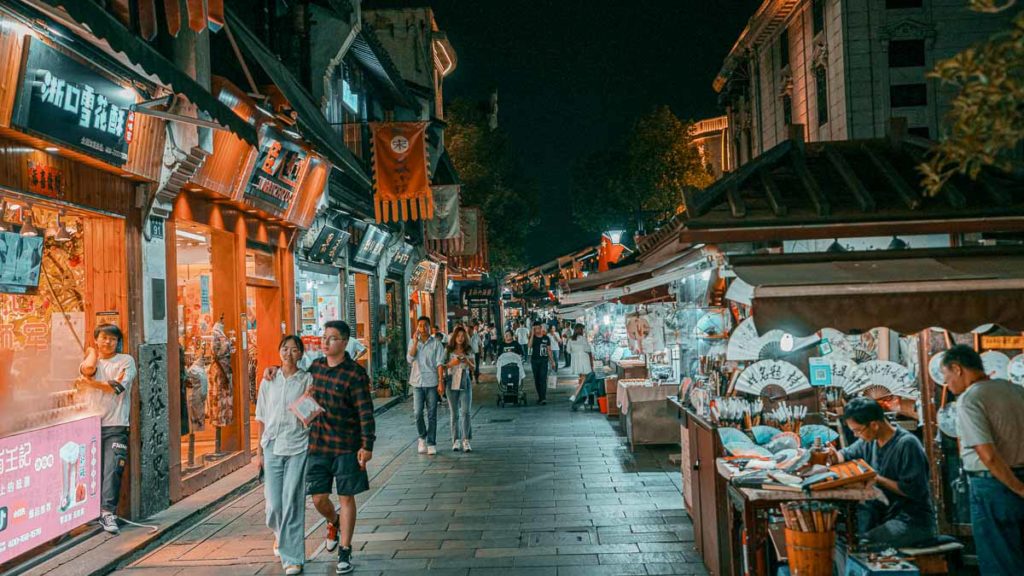
Hefang Street is Hangzhou’s most famous ancient street. It’s extremely lively and has a blend of street food, souvenir and handicraft stores lining the street. One thing we noticed — many food vendors there give out food samples, not something you see at many other streets in China!
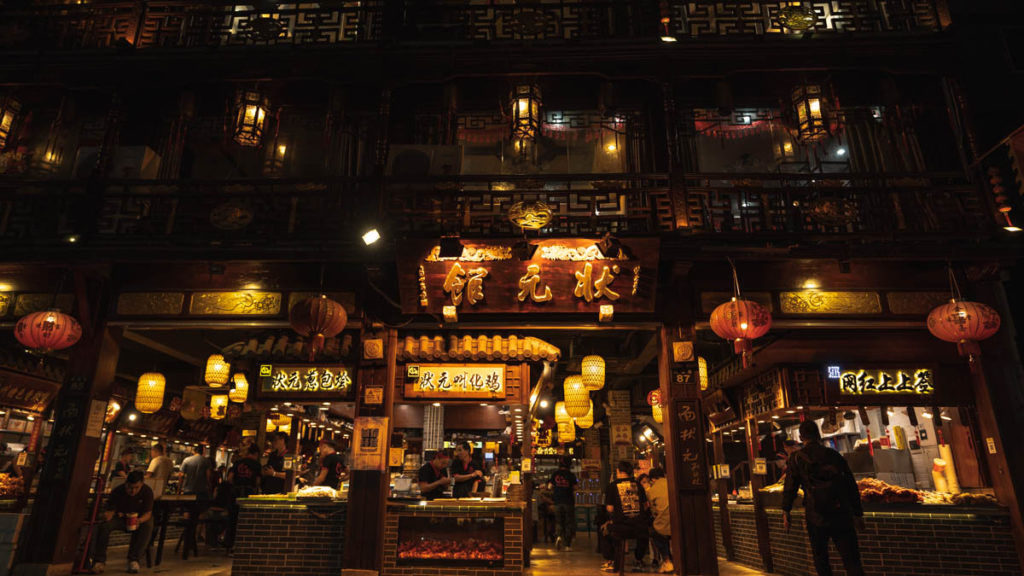
If you prefer dining in restaurants instead of street food, check out nearby Gaoyin Street one street down from Hefang Street. The entire street is lined with local restaurants.
Opening Hours: Most stores close around 10PM Address: Hefang Street, Hangzhou City, Zhejiang Province, China, 310002 (中国浙江省杭州市河坊街310002)
Day 5 (Hangzhou): Wuzhen Old Street or Anchang Ancient Town
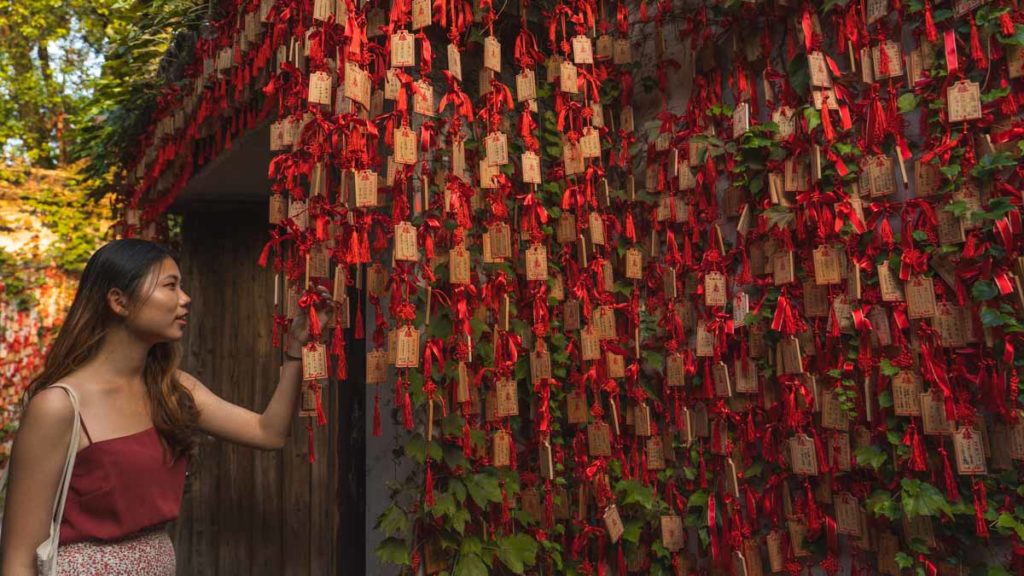
A visit to Hangzhou wouldn’t be complete without seeing at least one of its many ancient towns.
We visited Wuzhen Old Street and Anchang Ancient Town and love both, but for this Suzhou and Hangzhou itinerary, you can choose one depending on what you’d like — Wuzhen is more commercialised and trendy, while Anchang has a more rustic charm (or extend this itinerary by doing both!).
Option 1: Wuzhen Old Street
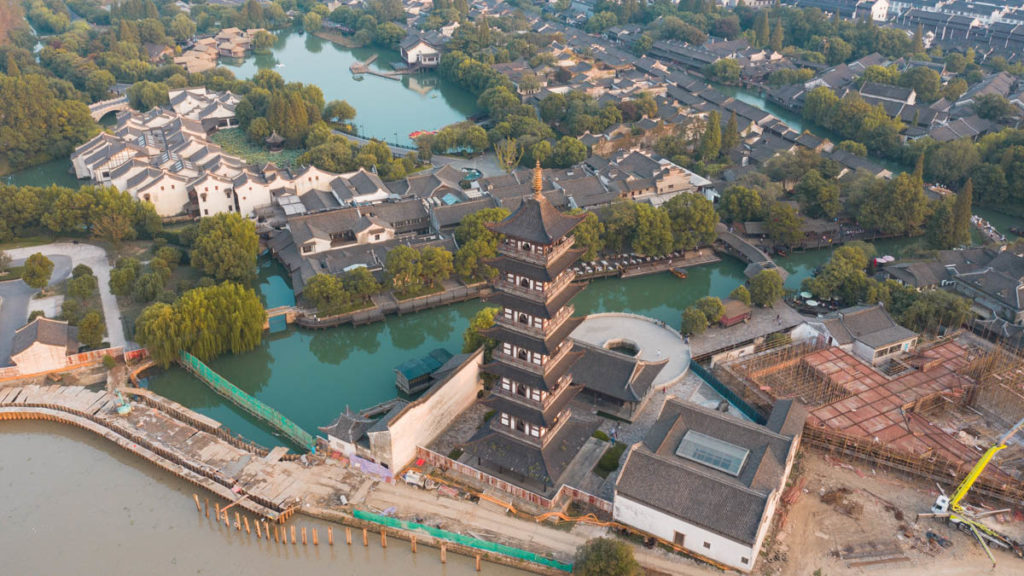
Wuzhen is a picturesque water town established over 1,300 years ago. The streets are livened up by souvenir shops, restaurants and exhibitions, but the best thing about it is its many, many , picturesque backdrops spread all over town. From dreamy lavender fields to traditional crafts on display, this place is any Instagrammer’s dream.
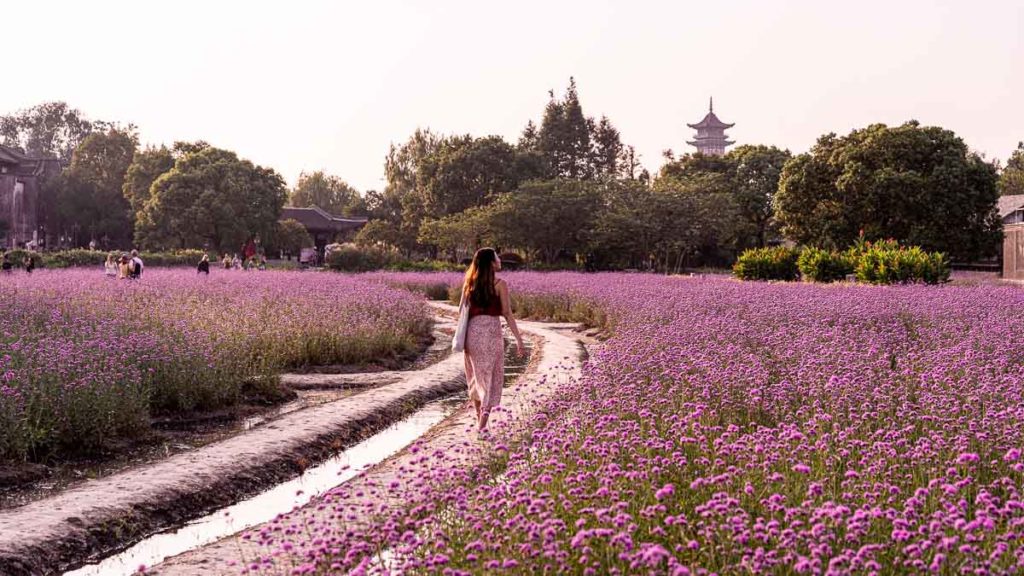
We couldn’t resist snapping a few IG shots ourselves!
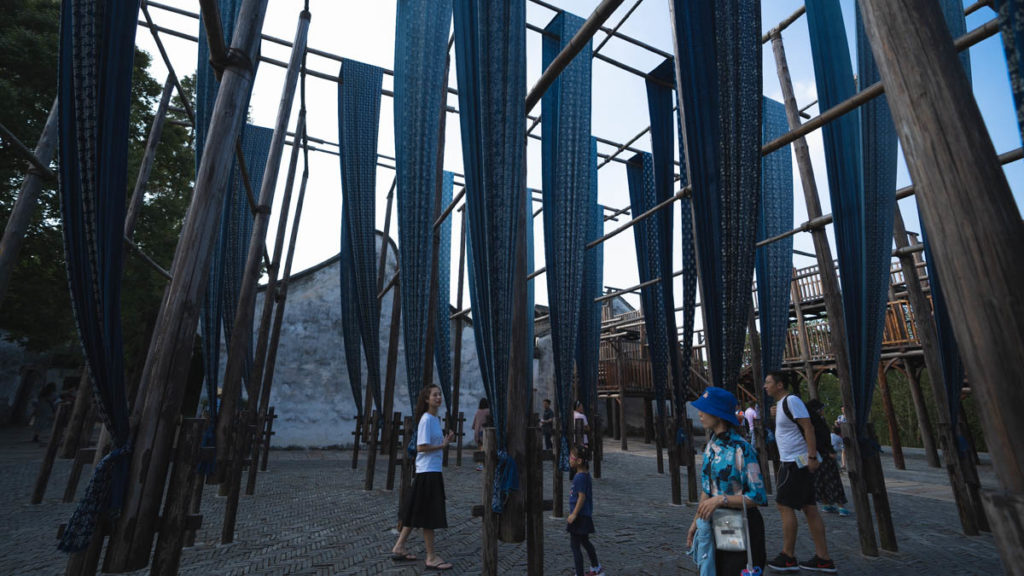
Visit a local dye house and check out its beautiful products!
Despite its age, the town somehow exudes a youthful vibrance. We were surprised to learn that this ancient town even had a nightlife scene. Besides the usual snack and trinket stalls, there are also cafes and bars located in the West Scenic Zone.
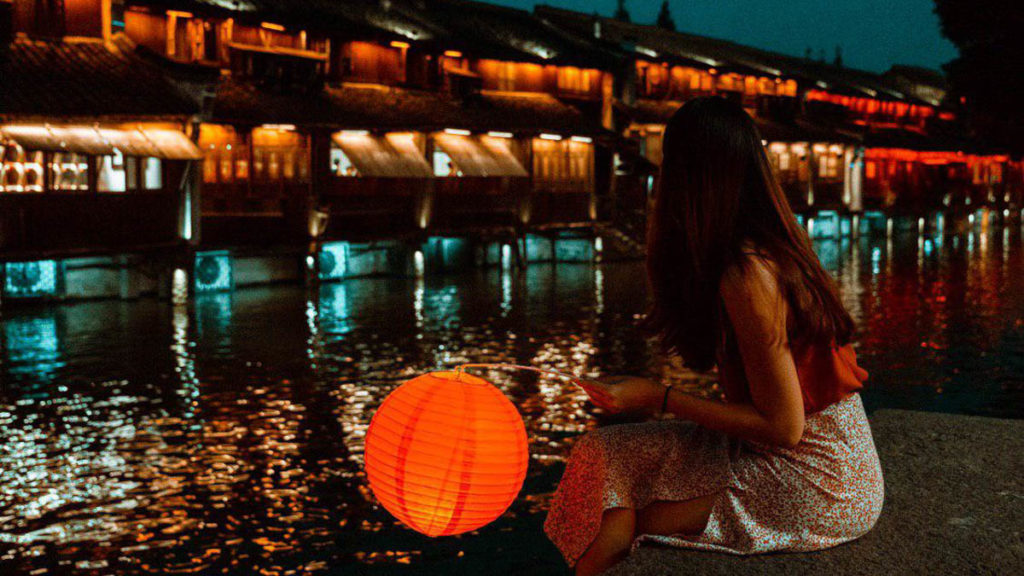
Wuzhen Old Street Full-Day Tour Cost: ~S$90.29 (incl. Chinese-speaking guide, transport and entrance fees) Opening Hours: 7:20AM – 6PM (May 1 – Oct 8), 7:20AM – 5:30PM (Oct 9 – Apr 30) Address: Wuzhen Town, Tongxiang 314500, China (桐乡市乌镇镇314500)
Option 2: Anchang Ancient Town and Yangshan Stone Quarry
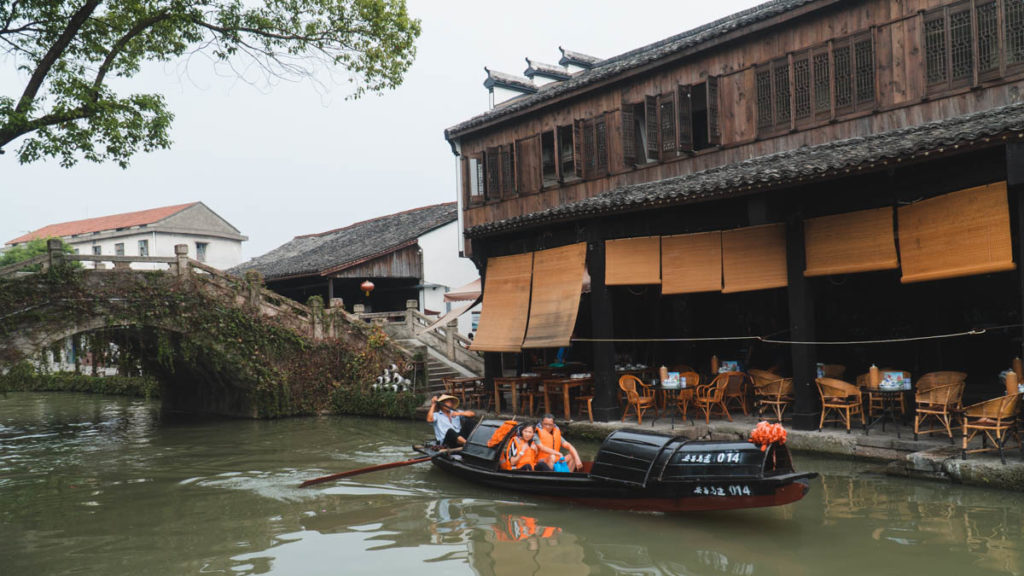
If I were to describe Anchang Ancient Town , I would say it’s quiet yet happening. The town only opened to the public in 2018 and is not yet known to many tourists. Take a stroll along the ancient streets and soak in its charm and history!
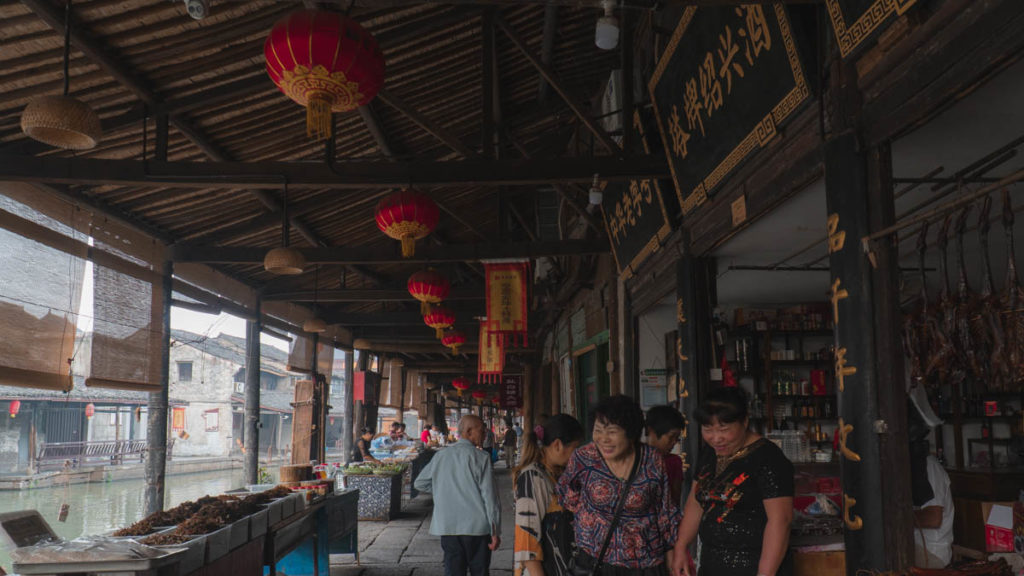
It’s a perfect place to people-watch. Here you’ll see locals going about their day — making furniture, selling handmade candy and washing items by the river.
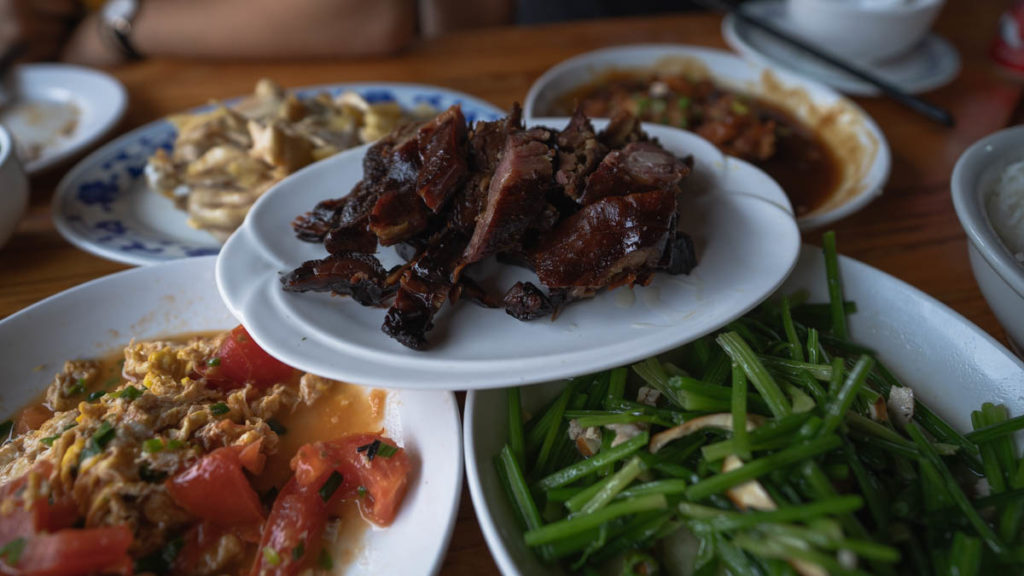
On the day tour we booked, we had a local lunch consisting of steamed chicken, sweet and sour pork, eggs, vegetables and the town’s speciality, salted duck. Our guide recommended rice wine ice cream (yum!) which we loved and then had us try some local rice wine. Not a fan of the latter, but it’s worth a try.
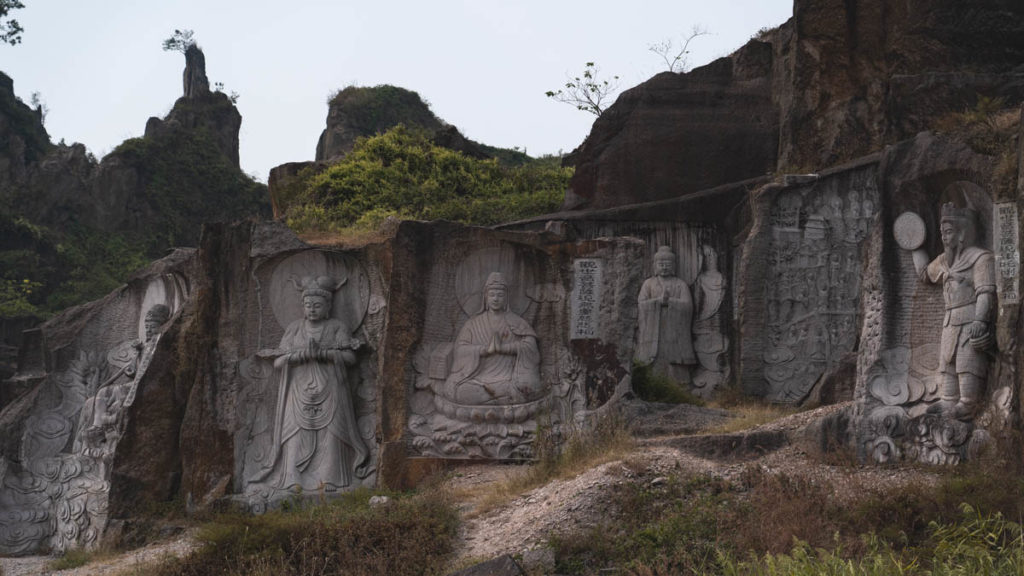
Our day tour then brought us to the Yangshan Stone Quarry, that was once the main quarry supplying stone to Shaoxing. Now, it’s a park filled with rock formations and 88 impressively intricate Buddha statues. It’s located in the city but feels like you’re on the set of a badass action movie.
Anchang Ancient Town And Yangshan Stone Quarry Day Tour Cost: From ~S$76.25 (incl. transport, lunch and a guide) Tour hours: 8:30AM – 6:30PM Address: AnchangTown, Shaoxing County 312000, China (绍兴县安昌镇312000)
Suzhou and Hangzhou Itinerary Overview
Accommodation in suzhou and hangzhou.
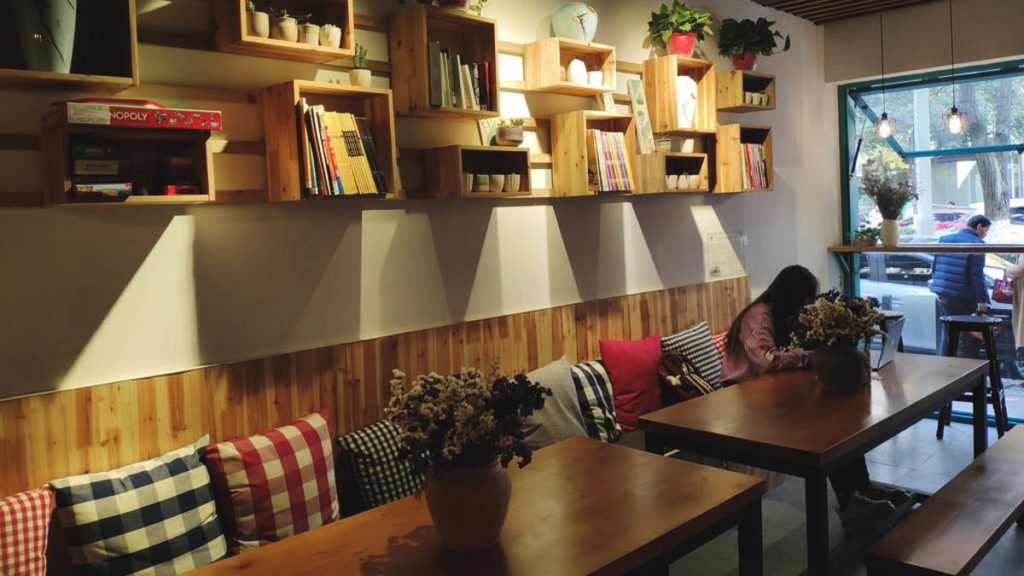
Photo credit: Booking.com
Suzhou Blue Gate Youth Hostel offers budget-friendly accommodation for travellers. It’s within walking distance of Guanqian Shopping Street and has several eateries, convenience stores and shops along the same street.
Cost: From ~S$7/bed Address: NO.259 Fenghuang Street, Gu Su District, Suzhou, 215000, China (姑苏区凤凰街259号, 姑苏区, (苏州, 215000))
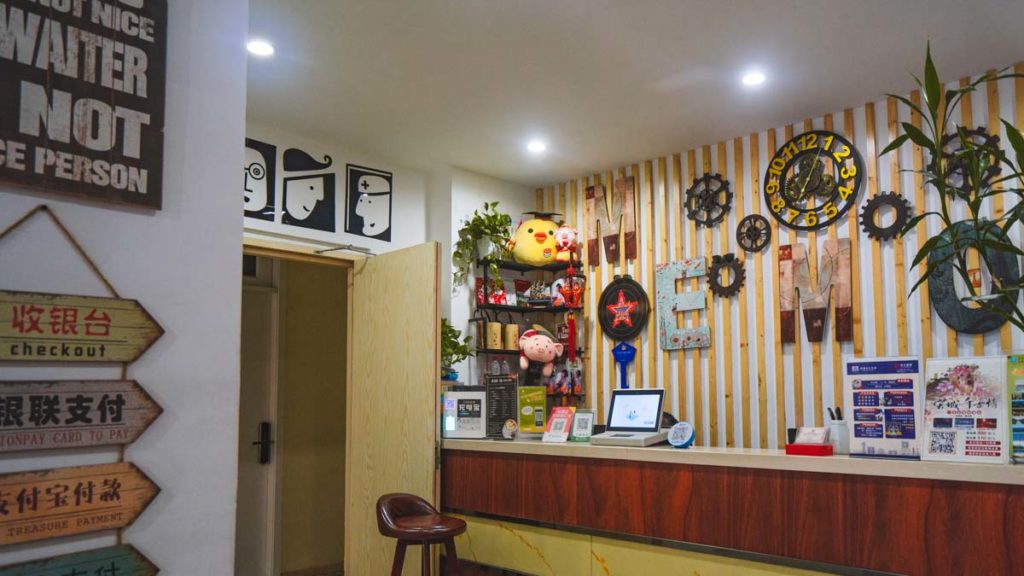
Memory Travel Hotel is an excellent home base for exploring Hangzhou. Not counting day trips out of the city, we walked practically everywhere. Just 10 minutes away lies West Lake, Yan’an Shopping District and an endless amount of dining options.
Cost: From ~S$10/bed Address: No.306, Zhongshanzhong Road, ShangCheng District, Hangzhou (上城区中山中路306号,近解放路)
A Less Explored Side of China
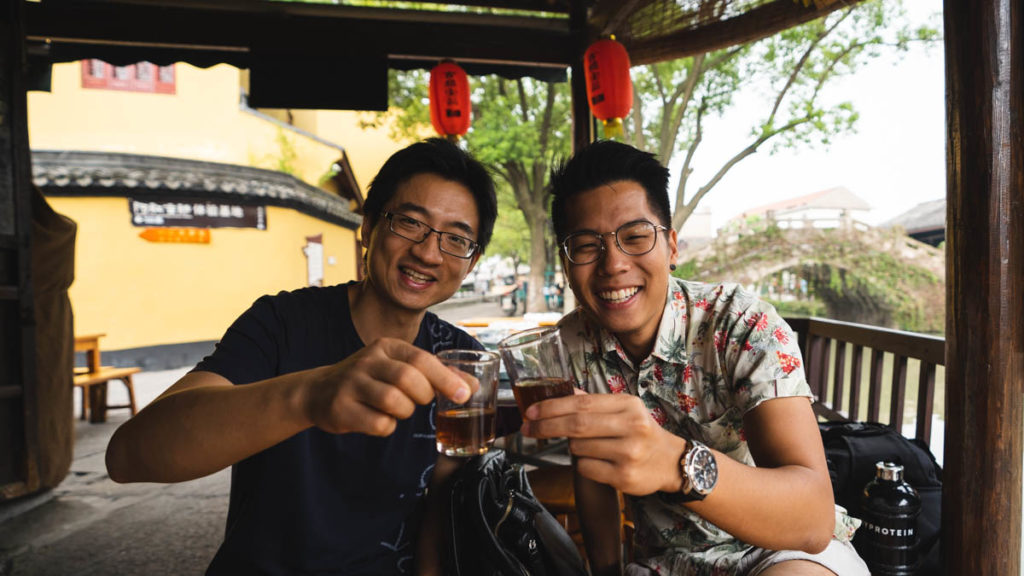
Suzhou and Hangzhou really surprised me. Prior to the trip, I had my doubts. But after the rush of Shanghai and Beijing, these cities provided a welcome change of pace. Suzhou and Hangzhou seem to exude calm and peace even with so much going on!
For this trip, we booked a few day tours that made our lives a lot easier. Especially for places further out of the city, having someone pick you up at and settle everything saves you a ton of time and effort.
Here are some of the tours we experienced on this trip: – Suzhou Highlights Half Day Biking Tour – Wuzhen Old Street Full-Day Tour – Mount Mogan Hiking Day Tour – Anchang Ancient Town And Yangshan Stone Quarry Day Tour
Getting around the two cities via Metro is also not complicated. It’s the cheapest mode of transportation if you’re on a budget, and it’s not tough to navigate as there aren’t many lines on the Suzhou Metro and Hangzhou Metro !
Check Flights to Shanghai
Ready for your Suzhou and Hangzhou trip? Check the best flight prices with this widget:
Can’t see the widget above? Click here to check flights from Singapore to Shanghai instead!
Anything we missed out in our Suzhou and Hangzhou itinerary? Let us know in the comments!
This post was brought to you by Klook .
For more travel inspiration, follow us on Instagram , YouTube , and Facebook !
View this post on Instagram A post shared by The Travel Intern (@thetravelintern) on Oct 5, 2019 at 5:36am PDT
RELATED ARTICLES MORE FROM AUTHOR
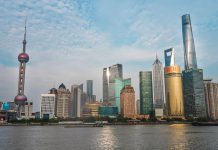
25 Exciting Things to Do in Shanghai — First Timer’s Guide From Must-Dos to Hidden Gems
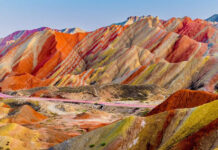
7 Places in China that Weren’t On Your Radar But Should Be
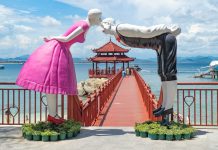
4-Day Hainan Itinerary Under S$650 — A Short Island Getaway to the Hawaii of China

Mobile Payment in China: Step-by-step Guide to Using Alipay and WeChat Pay without a Chinese Bank Account

Yunnan Nature Bucket List For Outdoor Lovers — Best Spots in Kunming, Lijiang, Dali & Shangri-la

12D Central China Itinerary — Things to do in Wuhan, Changsha & Zhangjiajie
Leave a reply cancel reply.
Save my name, email, and website in this browser for the next time I comment.

20 Things to Eat-See-Do in Sabah’s Capital Besides Climbing Mount Kinabalu

Experience Macao Singapore Roadshow: Get Exclusive Deals, Experience the Macau Grand...

Ultimate 6-Day Adelaide Itinerary — The Best of South Australia’s Underrated...

30 New Deals and Attractions in Singapore this April 2024

2D1N JB Itinerary — The Broke Friends Getaway

- Terms Of Use
- Privacy Policy
- Press & Partnerships
- Work With Us
Lost In Time In Suzhou, China

The most quiet and still of places still echo their history. In the peace and tranquility of a sleepy morning, the remnants of a place’s ancient past are like passing shadows. You can imagine the people’s feet walking down the same path as your own. You can fathom the centuries of sweat and laughter and joy that filled the air. The unwritten bliss of travel is the ability to imagine how tiny and fleeting your imprint in a place’s history truly is. Suzhou’s quiet channels, ancient gardens and aged alleyways are just the place to remind yourself just that. Suzhou is a gem hidden and distilled in its ancientness. Suzhou is lost in time.

The modernization of many Asian cities have pushed the continent towards new heights. In many ways, China leads the front in progressive invention. The shiny, skyscraper-dotted, modern cities of the east are expected when visiting beautiful China. But to catch a glimpse of the old world in its modern age is a treat for the eyes and a feast for the imagination. Suzhou, although sparkling with modern amenities, flexes its deeply rooted history in its untouched beauty.
Suzhou shimmers in its frozen in time feeling. Lingering in the Shan Tang Old Street, you will see Qing and Ming dynasties’ architecture in between shopping stores and delicious foods. While boating through the canals and winding waterways, you will feel its ancient charm and sacred, historic tea houses and private houses. In between hearing the folklore of King of Wu seeing a mighty, white tiger atop a mountain, you will soak in the wear and age of a thousand year old pagoda. You will imagine the stories and whispers of the people who encompassed the city for centuries. You will get lost in the peace and tranquility of the Humble Administrator’s Garden’s koi ponds, twisting pathways and quiet pavilions. And in between all of these moments and sights you will be bombarded with the overwhelming realization that you are so young and so small in juxtaposition to Suzhou’s history.

Suzhou Cultural Highlights
Boat Ride On Suzhou’s Canals – Prepare to be enchanted. Boating through the winding, peaceful waterways of Suzhou gives you the full experience of the “Venice Of The East.” The old, narrow passages recall an ancient time we can only experience with a vivid imagination and a beautifully preserved place as this.
Humble Administrator’s Garden – What might be the most perfect Chinese garden. The whimsy, the mystery, the restfulness that comes when slowly walking through the pristine gardens is a lot like a meditative moment to savor. Each unfolding scene reveals a moment preserved with great intention, giving you a moment to breathe, be still and enjoy the beauty of nature.

Tiger Hill Garden – A legend best heard by a local who can truly bring it to life. According to the folk stories of ancient China, in 496 B.C., three days after the King of Wu buried his father atop the hill, a white tiger appeared and guarded the tomb. So moved by this moment, the thousand year old leaning Yunyan Pagoda stands as a relic to the story. Below the towering pagoda, sits the Sword Pool, believed to be the spot where the king’s sword rests. There’s a reason that the ancient poet Su Dongpo says “to visit Suzhou and not see Tiger Hill would lead to a lifetime of regret.”
Dongshan & Taihu Lake – Tea lovers, this is for you! For more than a thousand years, Biluochun Tea has been sipped and enjoyed. It’s one of the most famous and requested green teas in China! Seeing a harvesting of the tea leaves is a great way to feel more connected to your favorite drink.

Shan Tang Old Street – A great spot to shop while traipsing through architecture from the Ming and Qing dynasties. Mixing the old world with the new world in a few city blocks.
Pingjiang Road – The perfect vantage point to enjoy passing boats, traditional Chinese music, tea houses and boutique shops.
Suzhou Museum – One of Suzhou’s most popular attractions, located right by the Humble Administrator’s Garden. The Suzhou Museum is free and open to the public to see some of the most ancient ceramics and woodcarvings. Don’t forget to take in the absolutely stunning lotus pool in the center.

Boat Trip To Visit The Village Of Tongli – A preserved water town with more than a thousand years of history. (Have you noticed that Suzhou is rich in ancient history yet?!) For years the Ming and Qing dynasty pavilions, temples, gardens and towers were kept away from the public. Not until recently has “the Oriental Venice” become a wonder to see for ourselves. Find yourself here and prepare your imagination to flourish!
Suzhou Kunqu Opera Theater – The unique, theatrical art that originated from Suzhou features bright costumes, graceful movements and a unique timbre of sound.
No. 1 Silk Factory – Suzhou’s famous fine silk production once dominated the world with its luxurious texture. The secret process to create such soft and opulent silks was under lock and key. It was once so important that it was punishable by death to reveal the secret! Today, we’re able to sideline that punishment. Tour the silk factories and learn the process of silk making, hand weaving and silkworm raising.

Lost in time, Suzhou remains untouched, and yet, quietly knows of its age and wear. Rolling, winding canals and waterways and the looming, overhanging trees. Quiet alleys, slow boats floating through canals. Suzhou is not to be forgotten. Find yourself lost in time there.
Trip sponsored by Suzhou Tourism .

Share this:
- Click to share on Twitter (Opens in new window)
- Click to share on Facebook (Opens in new window)
- Click to share on Pinterest (Opens in new window)

Nastasia, originally a Labor & Delivery nurse turned travel blogger, has leveraged her passion for travel, photography and has founded Dame Traveler, a curated women’s travel blog where solo female travelers can inspire, and connect with, one another. Her eye for stunning travel visuals has helped build a large Instagram following, with over 600,000 followers on @dametraveler and 100,000 on her personal account, @nastasiaspassport, in addition to a large network of travel bloggers. Her hard work has led her to be featured in publications such as Travel & Leisure, Fodor’s, Vogue and more. 55+ countries into her journey, her passion for the world has led her to create a sizeable community of female travelers where her mission is to empower them to travel more, do more and be more. Whether sipping on chai in Istanbul or volunteering abroad in South Africa, Nastasia continues to find and share the beauty of this world, thus inspiring people to change the way they see and experience life.
You Might Also Like
Overcoming getting robbed in paris.

Off the Beaten Path: Tana Toraja, Indonesia | Trip of Wonders

Don’t Miss These Stunning Seattle Views
[…] Via DameTraveler […]
Suzhou truly is an amazing place to visit and it is so easy to get lost in time while you are there. We loved travel while we were there and found all of our favorite activities from here: https://www.traveltosuzhou.com/things-to-do/top-10-attractions-suzhou-china
(C) 2023 - All Rights Reserved.
- 1 Day Classical Gardens
- Day Trip from Shanghai
- 2 Days Suzhou & Tongli
- 2 Days City Tour
- Humble Administrator's Garden
- The Master of Nets Garden
Tongli Town
Lingering garden, zhouzhuang water town.
- Shantang Street
- Pingjiang Road
Suzhou Museum
- Silk Museum
- Zhangjiajie
12 Best Places to Visit in Suzhou for First-time Visitors
Suzhou , praised to be “Oriental Venice” and “Heavenly City on Earth”, is famous for the Chinese classical gardens and water towns. Then what are the best places to visit in Suzhou when you get there? Here we recommend some Suzhou must visits for reference.
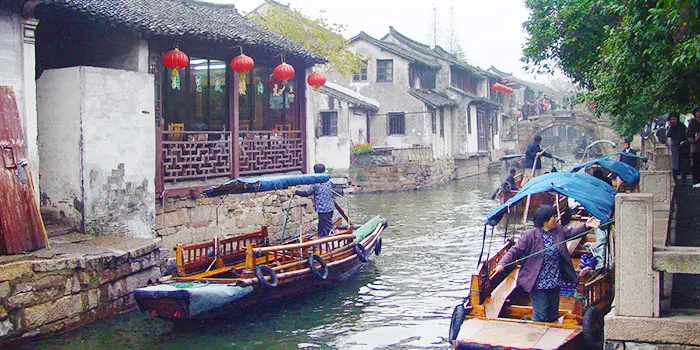
Humble Administrator's Garden
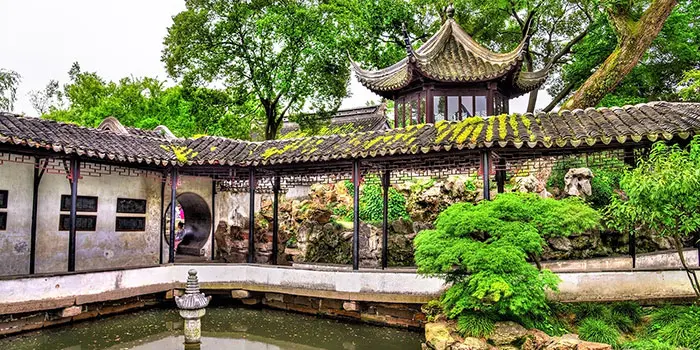
Seven-Li Shantang Street
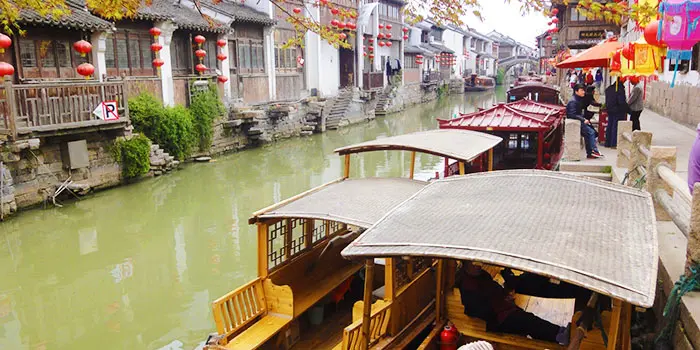
Lion Grove Garden
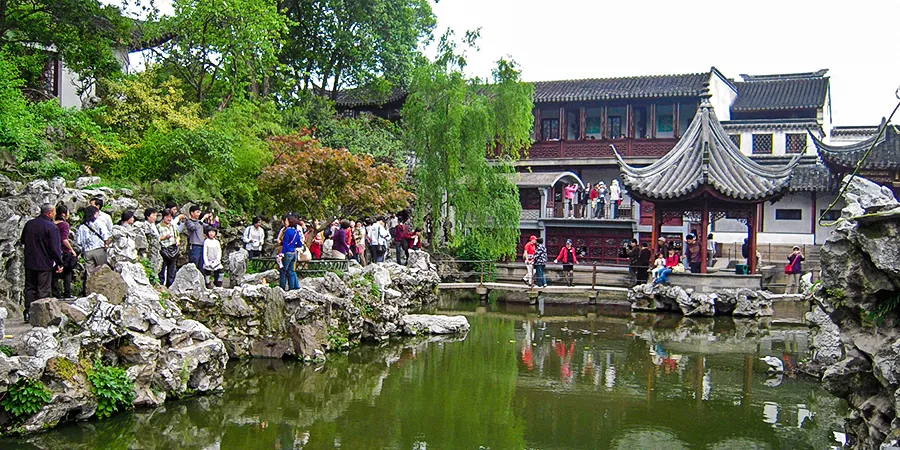
Guanqian Street
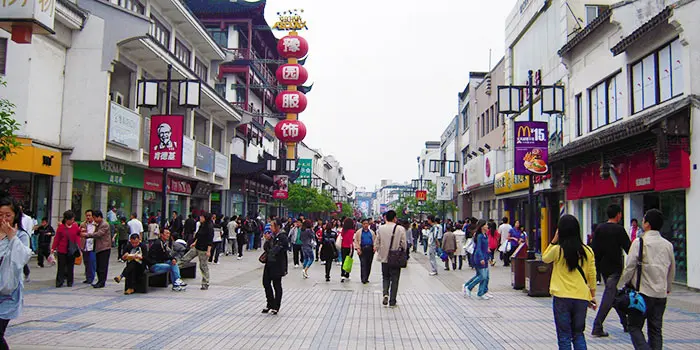
Mudu Ancient Town
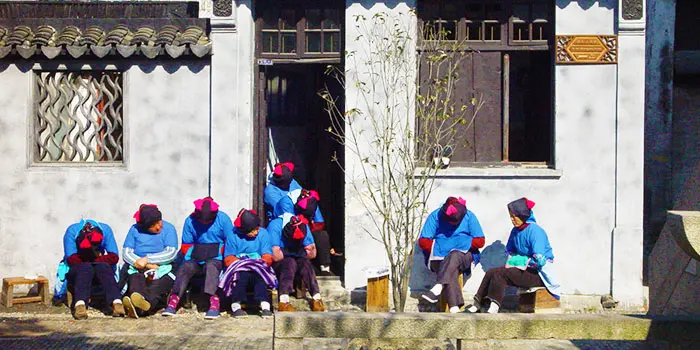
Hanshan Temple
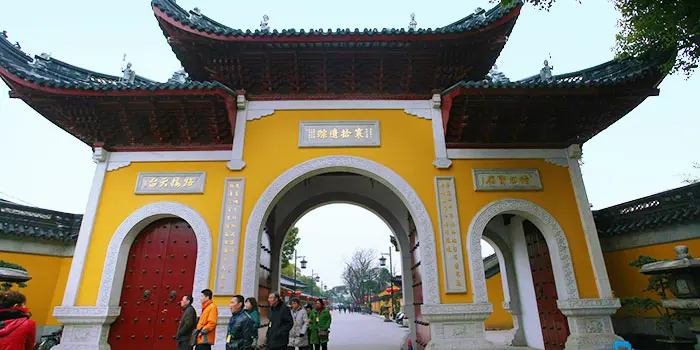
You May Like

Award-winning Service
We measure success by your satisfaction. 1000+ good reviews
Flexible Change Policy
Flexible policy for tour change or cancellation.
24/7 Customer Support
24/7 support from a real person. Assistance throughout your trip.
Worry-free Booking & Travel
No hidden costs or detours. Your health and safety is our top priority.
China Xian Tour, Travel with Joy!
We are thrilled to announce that China is once again open to international visitors, and we can’t wait to welcome you back! Despite a significant decline in clientele from 2020 to 2022, we persevered and focused on improving our services, and we proudly launched our new brand, “Joy Travel,” which had helped thousands of expat clients in China to arrange and tailor-make their memorable China holidays.
Boasting over a decade of industry experience, we consistently prioritize our customers’ needs and strive for self-improvement. Our expertise lies in crafting flawless China itineraries, uncovering one-of-a-kind experiences, and meticulously managing accommodations, meals, transportation, and other travel specifics.
As we look ahead to the future, we are filled with anticipation and excitement to welcome you back to China. We believe that now is the perfect time to embark on a new adventure, to rediscover the splendors that make China a truly remarkable destination and the endearing people here. With our renewed commitment to exceptional service, a wealth of knowledge about the hidden gems of this vast country, and a genuine passion for creating unforgettable memories, we are eager to be your trusted partner in exploring the beauty, history, and charm that await you in China.
Top China Tours 2024/2025
10 days silk road hexi corridor tour from xining to dunhuang, 3 days xian history & tang costume experience tour, 8 days classic yunnan minority tour of kunming-dali-lijiang-shangri-la, 11 days china family tour: beijing, xi’an, guilin, shanghai, 13 days china private tour from beijing with yangtze cruise, 12 days zhangjiajie-changsha-chengdu-jiuzhaigou tour, 13 days beijing – xi’an – lhasa – shanghai tour, 11 days china exploration: beijing – chengdu -xian -zhangjiajie, xi'an tours 2024-2025, 2-hour xian muslim quarter night walking foodie tour, 2 days xian essence tour (time-efficient itinerary), 1 day xian highlight tour, 4 days xian in-depth tour with mt. hua, why travel with us, worry-free booking, 1:1 travel consultant, 24/7 customer service, expert local guides, authentic experiences, flexible change.
We are China travel experts and have been ready to bring you safe and pleasant trip experiences with flexible cancellation policies. We are dedicated to creating memorable and authentic travel experiences in China.
China Tours by Destinations
China silk road tours, xinjiang tours, beijing tours, yunnan tours, yangtze river cruise tours, zhangjiajie tours, shanghai tours, guided china tours for every travel style, private china tours, tailor-made china tours, group china tours, travel articles and inspirations.
Top 15 Things to Do in China
10 Most Beautiful Mountains in China
How to Plan Your First Trip to China 2024/2025
How to Plan a Family Trip to China?
China Silk Road Travel Tips
Top 10 Attractions in China
Is Xi’an Worth Visiting? Reasons to Visit Xi’an
Top 16 China Travel Tips
Top 10 Great Wall Sections around Beijing
Top 8 Family-Friendly Destinations in China
The 15 Most Beautiful Places in China
12 Breathtaking Places to Visit in China in Autumn
How to Pay in China As a Foreigner: Popular Payment Methods
New Regional Visa-free Entry Policy into China
How to Plan a Summer Trip to China
How to Choose a Train Type & Seat Class in China?
Best Time to Visit China
Top 7 Tourist Landmarks in China
3 Steps to Travel with Us
Select/customize, plan your tailor-made trip with 1-1 help from our travel experts., destinations, popular tours, travel blog.
Top 15 Things to Do in China 2024/2025 11/10/2022 07:53
Chinese Zodiac 04/14/2022 09:29
Why Visit Dunhuang and Top Things to Do in Dunhuang 03/29/2022 09:33
We are member of:
Email: [email protected] [email protected] WeChat/Whatsapp: 86-15129005119 Call: (+86)18792910029 (08:00-21:00 Beijing Time)
2002-2022 © All Rights Reserved.
Username or email *
Send us a quick inquiry
* Tell us your travel requirements/questions here.
I prefer to be contacted via:
Email WeChat WhatsApp Phone call
Your travel consultant will reply within 24 hours.
A TripAdvisor award-winning China travel agency organizing diverse private and mini-group China tours. We offer in-depth experience, free cancellation, flexible & safe trips.
[email protected] [email protected]
WeChat/Whatsapp
86-15129005119
(+86)18792910029 (08:00-21:00 Beijing Time)
Book your individual trip , stress-free with local travel experts
- roughguides.com
- Travel guide
- Itineraries
- Local Experts
- Travel Advice
- Accommodation
With its centre riddled with classic gardens and picturesque canals, SUZHOU is justly one of eastern China’s biggest tourist draws. Whereas most Chinese cities are busy building themselves up from the inside out, parts of central Suzhou remain remarkably quaint and calm – no mean feat in a city of around six million. As if greenery and waterways were not enough, Suzhou has also long been famed for its silk production, making it one of China’s best places in which to shop for said commodity.
Just forty minutes from Shanghai by high-speed train, many choose to visit Suzhou on a day-trip, though those who stay the night will see the soft light of innumerable paper lanterns dappling the canal sides, whose paved lanes make Suzhou one of those rare places that looks fantastic in the rain. Additionally, beyond the industrial areas which surround the city are several smaller canal towns, and the majestic lake of Tai Hu.
Suzhou’s gardens
Gardens, above all, are what Suzhou is all about. Some were founded during the Song dynasty, a thousand years ago, and in their Ming and Qing heyday it is said that the city had two hundred of them. Some half-dozen major gardens have now been restored, as well as a number of smaller ones, mostly in enclosed areas behind high compound walls.
Chinese gardens do not set out to improve upon a slice of nature or to look natural: they are a serious art form, the designer working with rock, water, buildings, trees and vegetation in subtly different combinations. As with painting and poetry, the aim is to produce for contemplation the balance, harmony, proportion and variety which the Chinese seek in life. The wealthy scholars and merchants who built Suzhou’s gardens intended them to be enjoyed either in solitude or in the company of friends over a glass of wine and a poetry recital or literary discussion. Their designers used little pavilions and terraces to suggest a larger scale, undulating covered walkways and galleries to give a downward view, and intricate interlocking groups of rock and bamboo to hint at, and half conceal, what lies beyond. Glimpses through delicate lattices, tile-patterned openings or moon gates, and reflections in water created cunning perspectives which either suggested a whole landscape or borrowed outside features (such as external walls of neighbouring buildings), in order to create an illusion of distance.
Among the essential features of the Suzhou gardens are the white pine trees, the odd-shaped rocks from Tai Hu and the stone tablets over the entrances. The whole was completed by animals – there are still fish and turtles in some ponds today. Differences in style among the various gardens arise basically from the mix and balance of the ingredients; some are dominated by water, others are mazes of contorted rock, yet others are mainly inward-looking, featuring pavilions full of strange furniture. Almost everything you see has some symbolic significance – the pine tree and the crane for long life, mandarin ducks for married bliss, for example.
Visiting the gardens
Among the Chinese, Suzhou is one of the most highly favoured tourist destinations in the country, and the city is packed with visitors from far and wide – meaning that you are rarely able to appreciate the gardens in the peace for which they were designed. The most famous ones attract a stream of visitors year-round, but many of the equally beautiful yet lesser-known gardens, notably Canglang Ting and Ou Yuan, are comparatively serene and crowd-free; the best strategy is to visit one or two of the popular gardens before 10am and spend the rest of the day in the smaller gardens. Prices for many of these sights are slightly lower in the off-season.
Tailor-made travel itineraries for China, created by local experts

8 days / from 2208 USD
Sichuan Specialities: Chengdu, Temples and Pandas
Discover the Buddhist history and the natural wonders of Sichuan. From bustling Chengdu and its giant pandas, to the national parks and lake districts of Sichuan Province, to the giant Buddha statue at Leshan, this trip is perfect for those who want to discover this culturally rich part of China.

5 days / from 838 USD
Family Time in Guilin and Yangshuo
This 5-day family trip is a magnificent opportunity to experience the beautiful outdoor settings of Guilin and Yangshuo. Walk, cycle and raft through awe-inspiring scenery, including dramatic limestone karst mountains, and learn about the everyday lives of the Zhuang and Yao ethnic groups.

8 days / from 1962 USD
Sichuan Family Adventure
Sichuan is home to a rich and vibrant culture, stunning scenery and wildlife, and delicious cuisine. Spend time with Chengdu's giant pandas, trek around Mount Qingcheng, stand in awe of the world’s largest Buddha at Leshan, and much more, all with this exciting trip, which is perfect for families!
Tailor-made trips for China
The Rough Guides to China and related travel guides
In-depth, easy-to-use travel guides filled with expert advice.

Find even more inspiration here

written by Andy Turner
updated 26.04.2021
Ready to travel and discover China?
Get support from our local experts for stress-free planning & worry-free travels.
- Where to stay
- Travel advice

Suzhou Travel Guide
- Attractions
- Things to Do
- Transportation
Suzhou is a city compared with heaven in Chinese poems, and no exaggeration at all. The natural landscape is obviously not Suzhou's style, like the "Garden City", a number of beautiful and elegant Chinese gardens are what we are expecting from the Suzhou tours .
Designed in line with the unique traditional Chinese aesthetic, the gardens in Suzhou are probably not that garden-like. Instead, they act more as a spiritual utopia for our ancestor who in pursuit of the peace in mind. Take a stroll around the gardens and appreciate their delicately sculpted ponds and rockeries, elegant beams and pillars, carefully placed trees and flowers, etc. you will definitely understand them.
Besides the famous Humble Administrator's Garden , Lingering Garden , and Master of Nets Garden. Lion Grove Garden is also worth visiting when you are traveling with kids ; nothing's more interesting than to play hide-and-seek in its legion of curiously shaped rocks.
Travel ideas about Suzhou
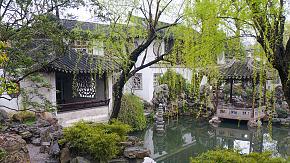
2 days is enough for you to cover the best of Suzhou, as long as you don’t count water town in. Visit your favorite landscape garden; learn how the pure silk products are made from a small cocoon and cruise the old canals, a vivid and classic Suzhou will stay in your mind.
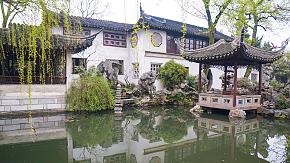
I bet most travelers come to Suzhou for gardens. There are many gardens in Suzhou, but each is different from another. Looking for a grand one? The Humble Administrators Garden is your first choice. A smaller and quaint one? I would recommend the Lingering Garden. Want to see a show at night? Nothing beats the Master of the Nets Garden.
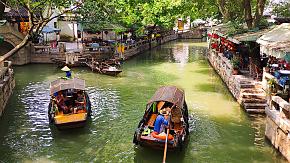
If you have a half day or full day left after toured Suzhou city, extend your tour to a nearby water town, Tongli, Zhouzhuang, or Xitang, which are within easy drivingdistance of Suzhou.And we admit Zhouzhuang is more famous, and perhaps more familiar to youbut it's also more commercialized than Tongli.
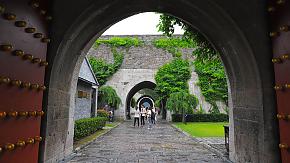
For those who have a passion for architectures, there is a place for you: Suzhou Museum, the masterpiece of famed architect I.M. Pei.
Recommended Suzhou Tours
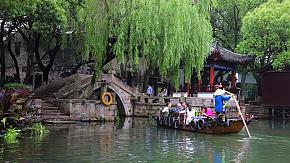
Highlights of Suzhou
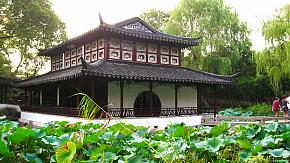
Shanghai Highlights with Suzhou and Tongli
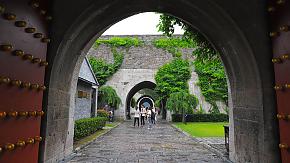
Essence Tour from Nanjing to Suzhou
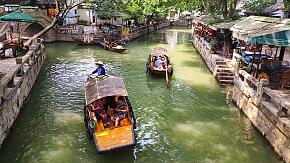
East China Garden and Watertown Tour
China tours including suzhou.
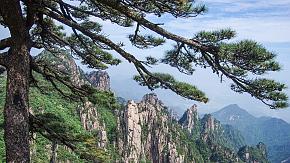
East China: Shanghai Suzhou Hangzhou & Mt. Huangshan
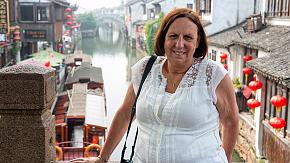
Best of China Tour with Suzhou
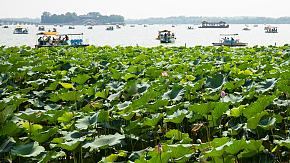
Vivid China Tour with Panda
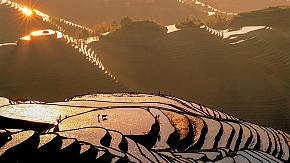
Photo Tour in China
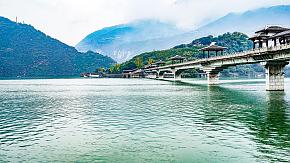
Essential River Cruise Tour of China
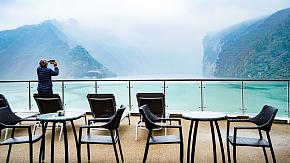
China Culture & Nature in a Nutshell

CONTACT A TRAVEL EXPERT
1-to-1 Service | Reply within 24hrs | Expert's Advice
China City Guide
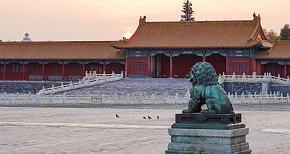
- Yangtze River Cruises
Essencial Info of China
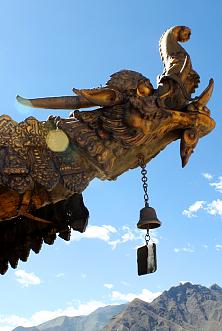
Posts Update
Others you may like.
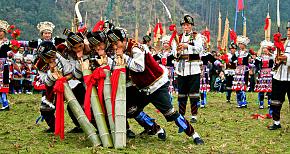
SUBSCRIBE TO WIN A FREE TOUR
Subscribe to our newsletter for a chance to win a free 7-day Morocco tour! And more insider travel news, exclusive offers, and inspiration will be sent straight to your inbox.
- Attractions & Tours
- Flight + Hotel New
- Car Rentals
- Airport Transfers
- Destinations
- Trip.com Rewards
Suzhou Travel Guide 2022
1. Things to know if you're visiting Suzhou for the first time
2. how to get to suzhou from shanghai airports, 3. transportation in suzhou, 4. best time to visit suzhou, 5. top 3 attractions in suzhou, 6. food in suzhou, 7. shopping in suzhou, 8. local customs in suzhou.
Show More
In China, Suzhou is synonymous with classical Chinese gardens, but this “Heaven on Earth” has so much more to offer. In the past, it was the home of high culture and sophistication, generations of scholars and artists drew inspiration from its natural and man-made beauties. Today visitors to modern Suzhou are still being wowed by its picturesque canals and ancient temples while enjoying contemporary comforts.

Suzhou is a major city and one of the oldest in the Yangtze Basin. Located in the south of Jiangsu province, it is surrounded by the Yangtze River in the north, Shanghai in the east, Lake Taihu in the west, and the ancient city of Hangzhou in the south. Celebrated for being a city of water, Suzhou has many waterways, streams, and water towns. The city is divided into 5 Urban Districts (Gusu, Wuzhong, Xiangcheng, Huqiu, and Suzhou Industrial Park) and is surrounded by 5 county-level cities.
Constructed in 514 BC, Suzhou has a long history of over 2500 years. Reaching its golden age in Ming and Qing Dynasties, today the city is one of the most developed in China. Beyond Suzhou’s economic significance, it is also the birthplace of Wu Culture which had a special contribution to Chinese culture. For visitors interested in unique local cultural heritage, watch a Kun Opera (Kunqu) performance, learn about silk production in the silk capital of China, or enjoy an ancient form of storytelling called Pingtan.
There are so many first-rate scenic spots in Suzhou, it is impossible to see them all if you only have a short time. Why not start with the astonishing 9 UNESCO World Heritage sites dotted around the city? Humble Administrator’s Garden, Lingering Garden, and Master of the Nets Garden to name just a few. Other amazing experiences visitors can have include a relaxing stroll around Pingjiang Road and its canals, visit the No. 1 Water Town in China – Zhouzhuang, and hike the serene Tianping mountain.
While Suzhou does not have a large airport of its own, visitors can arrive by air at Shanghai ’s Hongqiao International Airport (SHA) or Pudong International Airport (PVG) and then take the train directly to Suzhou. Otherwise, it can be directly and easily reached by high speed and regular trains from all over the country. For getting around town, the metro, SND Trams, taxis, and special sightseeing buses are all affordable transportation options.
For anyone visiting Suzhou for the first time, the city’s historical and cultural richness certainly will not disappoint. But knowing when’s the best time to visit can definitely enhance to experience. Spring and Fall are the peak visiting seasons when Suzhou has the most pleasant weather. Sunny days and mildly warm temperatures are perfect for exploring the city’s many world-famous gardens and water towns. Note that national holidays in May, October, and Spring Festival periods will be extremely crowded.
Now you know when to go, but what about where to stay? Depending on the purpose of your visit, here are a few popular areas to consider. If you want to be in close proximity to top attractions, historic architecture, and a wide range of food and shopping venues, the Guanqian Street in the central Gusu District is a suitable option. Want to stay on one of Suzhou’s famous canals? Pingjiang Road is lined with old traditional-style buildings that have been converted into restaurants, cafes, and trendy shops. This is a great location to hop on a boat tour or take a relaxing stroll down the canal. For a quieter environment or for budget travelers, Wu Jiang District has less crowded streets and gives visitors the opportunity to immerse themselves in the local culture.
Suzhou is a great place to pick up a few souvenirs to remember your China trip. Top-quality local special products are plenty here, such as fine-quality silk, Suzhou embroidery, Biluochun green tea and Suzhou writing brush, etc. A tip on shopping: when buying specialty items like silk, jade, or tea that are pricy, it is advisable to have a local Chinese-speaking guide with you or purchase from official museums, department stores, or factory outlets to ensure quality. Also as with anywhere in China, bargaining is a normal practice.
While Suzhou is a popular tourist destination and major economic center in China, the city does not have its own airport. The closest airport is the Sunan Shuofang International Airport (WUX) which is 22 km (14 miles) away or 30 minutes by car. But it is a small size domestic airport with no direct nonstop flights from the U.S. or other international destinations.
That’s why those who do fly tend to prefer the nearby Shanghai Hongqiao International Airport (SHA) or Pudong International Airport (PVG) and then take the train directly to Suzhou. Both of these airports in Shanghai are major international airports easily reached from all over China and the world. Once arrived at either Shanghai airport, passengers heading to Suzhou can use many transportation options like a train (regular and bullet/high-speed trains), shuttle bus, or taxi. Out of the two airports, the most convenient is Shanghai Hongqiao International Airport (SHA). The airport's Terminal 2 is walkable from Hongqiao bullet train station which has trains that stop at Suzhou’s two bullet train stations (30 minutes journey). If you arrive at Pudong International Airport (PVG) out of necessity, factor in roughly an hour additional travel time as you’ll need to first travel across Shanghai to reach the bullets train station that links Suzhou.
Other transport options from Shanghai to Suzhou include regular trains which will take 90 minutes, long-distance coaches (Suzhou South Gate Station) that take a minimum of 90 minutes, and taxis (approximately 75 to 105 minutes). There are two additional airports: Hangzhou Xiaoshan International Airport and Nanjing Lukou International Airport, which also have transfer options to Suzhou.
Instead of flying, traveling to Suzhou by train from other parts of China is also a convenient option. In addition to numerous regional and local trains, visitors can reach Suzhou quickly via bullet / high-speed trains from Beijing in 5-6 hours (or 13-21 hours by regular train), or from Xi’an in 6-10.5 hours (or 14-23 hours by regular train).
As one of the most developed cities in China, Suzhou has a comprehensive public transport system that ensures convenient and affordable travel for residents and tourists. Because the city attracts millions of visitors each year, the local government authorized five special sightseeing bus routes (Y1, Y2, Y3, Y4, and Y5) to allow easy exploration of many scenic spots.
For example, Route Y1 departs from Suzhou Railway Station to Humble Administrator's Garden (Zhuo Zheng Yuan), Lion Grove Garden, and Silk Museum;
Route Y4 hits destinations like Beisi Pagoda, Ancient Town of Mudu, and Taiping Mountain.
Most fares start at 2 RMB and all routes depart from the Suzhou Railway Station (27 Chezhan Road, Gusu). It is worth noting that, there is no fare collector on the bus, so ensure that you have loose change before boarding.
Suzhou has a modest-size Metro system with 4 lines and 38 stations, but plans for more lines are in the works. The ticket price ranges from 2-8 RMB according to the distance traveled. In addition, there is also the SND Tram which operates 2 tram lines in Suzhou, the fare is 2 RMB per person for a single ride.
If traveling by taxi is more your style, you’ll be happy to hear that finding a taxi in Suzhou is generally very easy, though it is still good to avoid rush hours. All taxis are metered and the starting fare is 10 RMB. Taxis can be flagged down on the street, and an available taxi can be identified when the dash light is lit in green. As taxi drivers rarely speak or read English, so it is best to prepare your destination name in Chinese or in Pinyin.
Suzhou has a subtropical monsoon climate which means four distinct seasons with wet and hot summers, and cold and cloudy winters. With summer lasting from June to September, the hottest month is July when temperature sometimes reaches 38 °C (100 °F). Summer is also the rainy period when the air is humid, and rainfall increases significantly. Winter in Suzhou is between December and February, the temperature could plunge to 0 °C (33 °F) from late January to early February. While it rarely snows, the region still feels quite cold and humid. Hence weather-wise the best times to visit Suzhou is Spring or Fall when it is generally sunny, cool, and dry.
Due to the pleasant weather, Spring and Fall are the peak tourist seasons in Suzhou. Also, Spring is the best time to view peach, plum, and cherry blossoms. People rush to the area’s gardens, parks, and lakes to enjoy the great outdoors. Beside Spring and Fall, other peak times for Suzhou are national holiday periods when millions of domestic tourists tend to descend on the city. To avoid extreme crowds, pick your dates carefully. Also, prices for hotels and flights will be most expensive during these times. Major Chinese holidays are the Chinese Spring Festival, Labor Day, and National Day etc.
Known as “Heaven on Earth” in China, Suzhou has a plethora of attractions to enchant visitors. From its exquisite gardens, charming water towns to architectural masterpieces, it will take days to explore and appreciate.
Out of all the stunning gardens in Suzhou, the number one must-see has got to be the Humble Administrator’s Garden. A UNESCO World Heritage Cultural Site, this garden is considered one of the largest in Suzhou and one of China’s four most famous gardens. Strolling around its serene ponds, shapely rockery, and picturesque pavilions, visitors are transported back in time to a tranquil and past world. If you want to see more classical gardens, consider Garden of Harmony, Master of the Nets Garden, and Lingering Garden.
For Architecture lovers, be sure to stop by the Suzhou Museum and marvel at the perfect fusion of traditional southern Chinese architecture style and modern aesthetics designed by acclaimed architect I.M. Pei. The museum is also home to over 15,000 precious cultural relics including porcelains and gold and silverware. The museum is a short walk away from the Humble Administrator’s Garden and Lion Grove Garden. Alternatively buses 112 and 202 can also take you directly there.
Built on a network of hundreds of waterways, it’s no surprise that Suzhou is also famous for its many well-preserved ancient water towns. Either exploring on foot or by boat, it's yet another great experience that visitors will find unforgettable. The most visited is the Zhouzhuang water town, built in the Ming and Qing Dynasties. Considered as one of the “Six Ancient Towns” in the Jiangnan region, it is renowned for its stone-paced bridges and folk customs like Kunqu Opera. Other ancient water towns worth exploring include Tongli Town, Luzhi Town, and Mudu Ancient Town.
Similar to its neighbor Shanghai, cuisine in Suzhou is famed for its mildly sweet and delicate flavors, fresh ingredients, and impeccable presentations. A famous regional creation is the Sweet and Sour Mandarin Fish, or also known as the Squirrel-Shaped Mandarin Fish. The dramatic orange color and spiky appearance of the fish are created when boneless whole carp is coated in yolk paste and deep-fried, then covered with sweet and sour sauce. Its crispy yet soft texture together with the flavorful sweet tangy taste is what made this dish a required dish at any banquet or family gathering.
If you have time in the morning, try to eat like a local by grabbing a plate of Pan-Fried Bun or Soup Dumpling (Xiaolongbao). While the Pan-fried bun is stuffed with various fillings like minced pork and has a crispy golden bottom, the soup dumpling is steamed, chewy, and filled with a hot, flavorful soup.
Another famous local culinary gem is the Cherry Pork (Yingtao Rou) where pork is roughly cut to the size of a cherry and covered in a red sauce. When served on a bed of green veggies, the dish has a pleasing appearance of fresh cherries just picked from the tree.
Not sure what to bring home from your Suzhou trip? As a historical and cultural city, tourists can find a dizzying array of specialty products like fine-quality silk, Suzhou embroidery - regarded as a pearl of Chinese art, Biluochun green tea – famed in China for its fragrant aroma and mellow taste, Suzhou writing brush, jade carvings, and Tao Hua Wu woodcut New Year pictures, etc.
In terms of where to buy these items, Guanqian Street is one of the oldest shopping streets in Suzhou, with a history of over 150 years. Situated in the historic old town, this pedestrianized shopping street has a concentration of century-old shops, famous old-brand restaurants, as well as numerous historical sites.
Another shopping center not to be missed is Shiquan Street. Near Suzhou’s famous classical garden - the Master of Nets Garden, visitors can find numerous well-known shops selling traditional craftworks like calligraphy, paintings, silk, jade, and much more. The street is full of many Ming-and-Qing Dynasty-style architectures as well as hotels.
If these locations are not enough, here are more recommended popular shopping sites: In City Plaza and Jiuhuang Department Store in the Gongyeyuan District, Meiluo Shopping Mall in the Pingjiang District, and Su Embroidery Museum in the Gusu District.
As one of the 20 most popular tourist cities in China, Suzhou is considered to be safe for tourists with a very low level of crime for travelers and residents. However, visitors should still stay vigilant as petty crimes like theft are common, especially on busy public transportations, in shopping areas, and at crowded tourist sites. For emergencies, dial 110 for police and 120 for ambulance services.
The official currency used in China is Renminbi (RMB) which is also known as Yuan. While tipping is not customary in China, it is acceptable to leave a gratuity for guides, drivers, and hotel porters.
China, or officially the People's Republic of China, is the world’s third-largest country by size, covering an area of around 9.6 million square kilometers (3.7 million square miles). It is also the world's most populous country, with more than 1.41 billion inhabitants. There are 23 provinces, five autonomous regions, and four direct-controlled municipalities, including Beijing.
There are 55 ethnic minority groups, with the Han Chinese being the main ethnic group. The Chinese language is one of the oldest written languages in the world, and today, the official language of China is Standard Chinese (Putonghua) or Mandarin. There are several other main dialects spoken in different regions of China, for example, Cantonese is spoken in Hong Kong and most of Guangdong.
For the size of China, it spans five geographical time zones, but officially China only has one time zone, China Standard Time (CST). CST is also known as Beijing Time in China, always 8 hours ahead of GMT (Greenwich Mean Time). There are no Daylight-Saving Time clock changes.

Trending Travelogues
Popular travel types, popular attractions, popular destinations, recommended attractions at popular destinations.
- Customer Support
- Service Guarantee
- More Service Info
- Website Feedback

- About Trip.com
- Terms & Conditions
- Privacy Policy
- About Trip.com Group
Other Services
- Investor Relations
- List My Hotel
- Become a Supplier

- Airport Transfers
- Attractions & Tours
- Flight + Hotel
- Destinations
- Trip.com Rewards
Suzhou Travel Guide 2022
1. Things to know if you're visiting Suzhou for the first time
2. how to get to suzhou from shanghai airports, 3. transportation in suzhou, 4. best time to visit suzhou, 5. top 3 attractions in suzhou, 6. food in suzhou, 7. shopping in suzhou, 8. local customs in suzhou.
Show More
In China, Suzhou is synonymous with classical Chinese gardens, but this “Heaven on Earth” has so much more to offer. In the past, it was the home of high culture and sophistication, generations of scholars and artists drew inspiration from its natural and man-made beauties. Today visitors to modern Suzhou are still being wowed by its picturesque canals and ancient temples while enjoying contemporary comforts.

Suzhou is a major city and one of the oldest in the Yangtze Basin. Located in the south of Jiangsu province, it is surrounded by the Yangtze River in the north, Shanghai in the east, Lake Taihu in the west, and the ancient city of Hangzhou in the south. Celebrated for being a city of water, Suzhou has many waterways, streams, and water towns. The city is divided into 5 Urban Districts (Gusu, Wuzhong, Xiangcheng, Huqiu, and Suzhou Industrial Park) and is surrounded by 5 county-level cities.
Constructed in 514 BC, Suzhou has a long history of over 2500 years. Reaching its golden age in Ming and Qing Dynasties, today the city is one of the most developed in China. Beyond Suzhou’s economic significance, it is also the birthplace of Wu Culture which had a special contribution to Chinese culture. For visitors interested in unique local cultural heritage, watch a Kun Opera (Kunqu) performance, learn about silk production in the silk capital of China, or enjoy an ancient form of storytelling called Pingtan.
There are so many first-rate scenic spots in Suzhou, it is impossible to see them all if you only have a short time. Why not start with the astonishing 9 UNESCO World Heritage sites dotted around the city? Humble Administrator’s Garden, Lingering Garden, and Master of the Nets Garden to name just a few. Other amazing experiences visitors can have include a relaxing stroll around Pingjiang Road and its canals, visit the No. 1 Water Town in China – Zhouzhuang, and hike the serene Tianping mountain.
While Suzhou does not have a large airport of its own, visitors can arrive by air at Shanghai ’s Hongqiao International Airport (SHA) or Pudong International Airport (PVG) and then take the train directly to Suzhou. Otherwise, it can be directly and easily reached by high speed and regular trains from all over the country. For getting around town, the metro, SND Trams, taxis, and special sightseeing buses are all affordable transportation options.
For anyone visiting Suzhou for the first time, the city’s historical and cultural richness certainly will not disappoint. But knowing when’s the best time to visit can definitely enhance to experience. Spring and Fall are the peak visiting seasons when Suzhou has the most pleasant weather. Sunny days and mildly warm temperatures are perfect for exploring the city’s many world-famous gardens and water towns. Note that national holidays in May, October, and Spring Festival periods will be extremely crowded.
Now you know when to go, but what about where to stay? Depending on the purpose of your visit, here are a few popular areas to consider. If you want to be in close proximity to top attractions, historic architecture, and a wide range of food and shopping venues, the Guanqian Street in the central Gusu District is a suitable option. Want to stay on one of Suzhou’s famous canals? Pingjiang Road is lined with old traditional-style buildings that have been converted into restaurants, cafes, and trendy shops. This is a great location to hop on a boat tour or take a relaxing stroll down the canal. For a quieter environment or for budget travelers, Wu Jiang District has less crowded streets and gives visitors the opportunity to immerse themselves in the local culture.
Suzhou is a great place to pick up a few souvenirs to remember your China trip. Top-quality local special products are plenty here, such as fine-quality silk, Suzhou embroidery, Biluochun green tea and Suzhou writing brush, etc. A tip on shopping: when buying specialty items like silk, jade, or tea that are pricy, it is advisable to have a local Chinese-speaking guide with you or purchase from official museums, department stores, or factory outlets to ensure quality. Also as with anywhere in China, bargaining is a normal practice.
While Suzhou is a popular tourist destination and major economic center in China, the city does not have its own airport. The closest airport is the Sunan Shuofang International Airport (WUX) which is 22 km (14 miles) away or 30 minutes by car. But it is a small size domestic airport with no direct nonstop flights from the U.S. or other international destinations.
That’s why those who do fly tend to prefer the nearby Shanghai Hongqiao International Airport (SHA) or Pudong International Airport (PVG) and then take the train directly to Suzhou. Both of these airports in Shanghai are major international airports easily reached from all over China and the world. Once arrived at either Shanghai airport, passengers heading to Suzhou can use many transportation options like a train (regular and bullet/high-speed trains), shuttle bus, or taxi. Out of the two airports, the most convenient is Shanghai Hongqiao International Airport (SHA). The airport's Terminal 2 is walkable from Hongqiao bullet train station which has trains that stop at Suzhou’s two bullet train stations (30 minutes journey). If you arrive at Pudong International Airport (PVG) out of necessity, factor in roughly an hour additional travel time as you’ll need to first travel across Shanghai to reach the bullets train station that links Suzhou.
Other transport options from Shanghai to Suzhou include regular trains which will take 90 minutes, long-distance coaches (Suzhou South Gate Station) that take a minimum of 90 minutes, and taxis (approximately 75 to 105 minutes). There are two additional airports: Hangzhou Xiaoshan International Airport and Nanjing Lukou International Airport, which also have transfer options to Suzhou.
Instead of flying, traveling to Suzhou by train from other parts of China is also a convenient option. In addition to numerous regional and local trains, visitors can reach Suzhou quickly via bullet / high-speed trains from Beijing in 5-6 hours (or 13-21 hours by regular train), or from Xi’an in 6-10.5 hours (or 14-23 hours by regular train).
As one of the most developed cities in China, Suzhou has a comprehensive public transport system that ensures convenient and affordable travel for residents and tourists. Because the city attracts millions of visitors each year, the local government authorized five special sightseeing bus routes (Y1, Y2, Y3, Y4, and Y5) to allow easy exploration of many scenic spots.
For example, Route Y1 departs from Suzhou Railway Station to Humble Administrator's Garden (Zhuo Zheng Yuan), Lion Grove Garden, and Silk Museum;
Route Y4 hits destinations like Beisi Pagoda, Ancient Town of Mudu, and Taiping Mountain.
Most fares start at 2 RMB and all routes depart from the Suzhou Railway Station (27 Chezhan Road, Gusu). It is worth noting that, there is no fare collector on the bus, so ensure that you have loose change before boarding.
Suzhou has a modest-size Metro system with 4 lines and 38 stations, but plans for more lines are in the works. The ticket price ranges from 2-8 RMB according to the distance traveled. In addition, there is also the SND Tram which operates 2 tram lines in Suzhou, the fare is 2 RMB per person for a single ride.
If traveling by taxi is more your style, you’ll be happy to hear that finding a taxi in Suzhou is generally very easy, though it is still good to avoid rush hours. All taxis are metered and the starting fare is 10 RMB. Taxis can be flagged down on the street, and an available taxi can be identified when the dash light is lit in green. As taxi drivers rarely speak or read English, so it is best to prepare your destination name in Chinese or in Pinyin.
Suzhou has a subtropical monsoon climate which means four distinct seasons with wet and hot summers, and cold and cloudy winters. With summer lasting from June to September, the hottest month is July when temperature sometimes reaches 38 °C (100 °F). Summer is also the rainy period when the air is humid, and rainfall increases significantly. Winter in Suzhou is between December and February, the temperature could plunge to 0 °C (33 °F) from late January to early February. While it rarely snows, the region still feels quite cold and humid. Hence weather-wise the best times to visit Suzhou is Spring or Fall when it is generally sunny, cool, and dry.
Due to the pleasant weather, Spring and Fall are the peak tourist seasons in Suzhou. Also, Spring is the best time to view peach, plum, and cherry blossoms. People rush to the area’s gardens, parks, and lakes to enjoy the great outdoors. Beside Spring and Fall, other peak times for Suzhou are national holiday periods when millions of domestic tourists tend to descend on the city. To avoid extreme crowds, pick your dates carefully. Also, prices for hotels and flights will be most expensive during these times. Major Chinese holidays are the Chinese Spring Festival, Labor Day, and National Day etc.
Known as “Heaven on Earth” in China, Suzhou has a plethora of attractions to enchant visitors. From its exquisite gardens, charming water towns to architectural masterpieces, it will take days to explore and appreciate.
Out of all the stunning gardens in Suzhou, the number one must-see has got to be the Humble Administrator’s Garden. A UNESCO World Heritage Cultural Site, this garden is considered one of the largest in Suzhou and one of China’s four most famous gardens. Strolling around its serene ponds, shapely rockery, and picturesque pavilions, visitors are transported back in time to a tranquil and past world. If you want to see more classical gardens, consider Garden of Harmony, Master of the Nets Garden, and Lingering Garden.
For Architecture lovers, be sure to stop by the Suzhou Museum and marvel at the perfect fusion of traditional southern Chinese architecture style and modern aesthetics designed by acclaimed architect I.M. Pei. The museum is also home to over 15,000 precious cultural relics including porcelains and gold and silverware. The museum is a short walk away from the Humble Administrator’s Garden and Lion Grove Garden. Alternatively buses 112 and 202 can also take you directly there.
Built on a network of hundreds of waterways, it’s no surprise that Suzhou is also famous for its many well-preserved ancient water towns. Either exploring on foot or by boat, it's yet another great experience that visitors will find unforgettable. The most visited is the Zhouzhuang water town, built in the Ming and Qing Dynasties. Considered as one of the “Six Ancient Towns” in the Jiangnan region, it is renowned for its stone-paced bridges and folk customs like Kunqu Opera. Other ancient water towns worth exploring include Tongli Town, Luzhi Town, and Mudu Ancient Town.
Similar to its neighbor Shanghai, cuisine in Suzhou is famed for its mildly sweet and delicate flavors, fresh ingredients, and impeccable presentations. A famous regional creation is the Sweet and Sour Mandarin Fish, or also known as the Squirrel-Shaped Mandarin Fish. The dramatic orange color and spiky appearance of the fish are created when boneless whole carp is coated in yolk paste and deep-fried, then covered with sweet and sour sauce. Its crispy yet soft texture together with the flavorful sweet tangy taste is what made this dish a required dish at any banquet or family gathering.
If you have time in the morning, try to eat like a local by grabbing a plate of Pan-Fried Bun or Soup Dumpling (Xiaolongbao). While the Pan-fried bun is stuffed with various fillings like minced pork and has a crispy golden bottom, the soup dumpling is steamed, chewy, and filled with a hot, flavorful soup.
Another famous local culinary gem is the Cherry Pork (Yingtao Rou) where pork is roughly cut to the size of a cherry and covered in a red sauce. When served on a bed of green veggies, the dish has a pleasing appearance of fresh cherries just picked from the tree.
Not sure what to bring home from your Suzhou trip? As a historical and cultural city, tourists can find a dizzying array of specialty products like fine-quality silk, Suzhou embroidery - regarded as a pearl of Chinese art, Biluochun green tea – famed in China for its fragrant aroma and mellow taste, Suzhou writing brush, jade carvings, and Tao Hua Wu woodcut New Year pictures, etc.
In terms of where to buy these items, Guanqian Street is one of the oldest shopping streets in Suzhou, with a history of over 150 years. Situated in the historic old town, this pedestrianized shopping street has a concentration of century-old shops, famous old-brand restaurants, as well as numerous historical sites.
Another shopping center not to be missed is Shiquan Street. Near Suzhou’s famous classical garden - the Master of Nets Garden, visitors can find numerous well-known shops selling traditional craftworks like calligraphy, paintings, silk, jade, and much more. The street is full of many Ming-and-Qing Dynasty-style architectures as well as hotels.
If these locations are not enough, here are more recommended popular shopping sites: In City Plaza and Jiuhuang Department Store in the Gongyeyuan District, Meiluo Shopping Mall in the Pingjiang District, and Su Embroidery Museum in the Gusu District.
As one of the 20 most popular tourist cities in China, Suzhou is considered to be safe for tourists with a very low level of crime for travelers and residents. However, visitors should still stay vigilant as petty crimes like theft are common, especially on busy public transportations, in shopping areas, and at crowded tourist sites. For emergencies, dial 110 for police and 120 for ambulance services.
The official currency used in China is Renminbi (RMB) which is also known as Yuan. While tipping is not customary in China, it is acceptable to leave a gratuity for guides, drivers, and hotel porters.
China, or officially the People's Republic of China, is the world’s third-largest country by size, covering an area of around 9.6 million square kilometers (3.7 million square miles). It is also the world's most populous country, with more than 1.41 billion inhabitants. There are 23 provinces, five autonomous regions, and four direct-controlled municipalities, including Beijing.
There are 55 ethnic minority groups, with the Han Chinese being the main ethnic group. The Chinese language is one of the oldest written languages in the world, and today, the official language of China is Standard Chinese (Putonghua) or Mandarin. There are several other main dialects spoken in different regions of China, for example, Cantonese is spoken in Hong Kong and most of Guangdong.
For the size of China, it spans five geographical time zones, but officially China only has one time zone, China Standard Time (CST). CST is also known as Beijing Time in China, always 8 hours ahead of GMT (Greenwich Mean Time). There are no Daylight-Saving Time clock changes.

Trending Travelogues
Popular travel types, popular attractions, popular destinations, recommended attractions at popular destinations.
- Customer Support
- Service Guarantee
- More Service Info
- Website Feedback

- About Trip.com
- Terms & Conditions
- Privacy and Cookies
- About Trip.com Group
Other Services
- Investor Relations
- Affiliate Program
- List My Property
- Become a Supplier


IMAGES
COMMENTS
Suzhou travel blog: Overview of Suzhou Suzhou has a long-standing history, located in the lower Yangtze River and on the bank of Lake Tai (or Lake Taihu) in Jiangsu province, China. Suzhou is 122km away from Shanghai and 240km away from Hangzhou.
4. Shantang street at night. Shantang Street is a completely different vibe at night and the crowds come out in droves to soak in the energetic atmosphere. We quickly made our way through the narrow street along the canal to the Chaozong Pavilion where traditional Suzhou collides with the modern city. 5.
Where to go in Suzhou in one day: A complete 1-day itinerary. As with most of our one-day city itineraries, this Suzhou itinerary includes stops at various historic sites and includes plenty of time for shopping and dining. You'll spend most of the day in the central downtown area, home to several of the iconic gardens and canals.
3. Shantang Street. Shantang Street, also known as Seven-Li Shantang, extends about 2.2 miles (seven li), hence its name. This street was built over a thousand years ago during the Tang Dynasty when the great poet Bai Juyi was the governor of Suzhou, and workers were recruited to dig the river and build the embankment.
Suzhou is an ancient city located in the southeast of China's Jiangsu Province. It has a long history and culture, dating back thousands of years ago. Suzhou was once known as "The Venice of the East" for its beautiful classical gardens and canals that crisscross through the city center. Today it is a popular tourist destination in China ...
The most beautiful sights in Suzhou. Suzhou and its gardens: The garden of the humble official. Shantang Street: Immersion in Ancient China. Pingjiang Road: tea houses, canal boats and nightlife. Suzhou Opera in the Garden of the Master of the Nets. Real Chinese Silk: A Visit to the Silk Factory. The Suzhou Museum.
We listed for you the 10 most interesting things to do in Suzhou as well as tips on where to stay and how to. What To Do Suzhou - The Ultimate Travel Guide To Plan Your Trip ... For more travel inspiration, feel free to check out these blogs posts: China Travel Blog. Tags: China. 289 1. Asian Wanderlust January 11 2024. 1 Comment . Alexis ...
Suzhou is a major city and one of the oldest in the Yangtze Basin. Located in the south of Jiangsu province, it is surrounded by the Yangtze River in the north, Shanghai in the east, Lake Taihu in the west, and the ancient city of Hangzhou in the south. Celebrated for being a city of water, Suzhou has many waterways, streams, and water towns. The city is divided into 5 Urban Districts (Gusu ...
The Best Time to Visit. Suzhou features four distinctive seasons and temperatures vary widely in seasons. Choosing the best time to visit depends on your attitude to the weather and the crowds. Suzhou's average annual temperature is 14.5 ℃ (58 ℉). Summer temperatures can get up to 33 ℃ (91 ℉), while winter temperatures dip to around 2 ...
Search. Friday, March 15, 2024
144-Hour Visa-Free Travel. You may enjoy 6-day visa-free access to Suzhou if you meet the relevant qualifying criteria of the 144-hour visa-free transit policy. The Highlights of Suzhou Classic Gardens. As the saying goes, "Gardens in the 'Yangtze South' area are the best in the world, and Suzhou gardens are the best among them."
Top Attractions. In Suzhou, the top attractions you must visit are the Suzhou gardens and water towns, like Humble Administrator's Garden, Lingering Garden, Lion Grove Garden, Tongli Water Town and Zhouzhuang Water Town. Other attractions like Panmen Gate, Suzhou Museum and Suzhou No.1 Silk Factory are also recommended.
Getting from Suzhou to Hangzhou: Take the train from Suzhou Railway Station to Hangzhou (from S$8.05) which takes between one and a half to five hours, depending on the type of train you select. Xixi Wetlands. Switch out city views for some lush forests and beautiful waterscapes. Located 5km from West Lake is Xixi Wetlands, a scenic urban ...
Suzhou's quiet channels, ancient gardens and aged alleyways are just the place to remind yourself just that. Suzhou is a gem hidden and distilled in its ancientness. ... a curated women's travel blog where solo female travelers can inspire, and connect with, one another. Her eye for stunning travel visuals has helped build a large Instagram ...
Shantang Street is a thousand-year-old street along the Grand Canal, and was one of the busiest streets in Ming and Qing Dynasties (1368 - 1911 AD). Nowadays, it is an epitome of old Suzhou, so among the top places to visit in Suzhou China.
Suzhou Travel Guide. Suzhou, located in the southern part of Jiangsu province in East China, is a prominent city renowned for its vibrant culture and exquisite gardens. With a history spanning over 2,500 years, it graces the banks of the Grand Canal and the shores of Lake Tai. ... Travel Blog. Top 15 Things to Do in China 2024/2025 11/10/2022 ...
Rough Guides® is a trademark owned by Apa Group with its headquarters at 7 Bell Yard London WC2A 2JR, United Kingdom. Plan your visit to Suzhou, China: find out where to go and what to do in Suzhou with Rough Guides. Read about itineraries, activities, places to stay and travel essentials and get inspiration from the blog in the best guide to ...
Up-to-date information on Suzhou attractions, travel tips & idea, things to do & see, all from insiders to help you plan a wonderful trip to Suzhou. MENU CLOSE China Odyssey Tours +1 347 2227702 +86 15697730073. ... TRAVEL BLOG ; ODYNOVO KNOWS ; TRAVEL NEWS ; SUBSCRIBE TO WIN A FREE TOUR.
Suzhou is a major city and one of the oldest in the Yangtze Basin. Located in the south of Jiangsu province, it is surrounded by the Yangtze River in the north, Shanghai in the east, Lake Taihu in the west, and the ancient city of Hangzhou in the south. Celebrated for being a city of water, Suzhou has many waterways, streams, and water towns. The city is divided into 5 Urban Districts (Gusu ...
Suzhou is a major city and one of the oldest in the Yangtze Basin. Located in the south of Jiangsu province, it is surrounded by the Yangtze River in the north, Shanghai in the east, Lake Taihu in the west, and the ancient city of Hangzhou in the south. Celebrated for being a city of water, Suzhou has many waterways, streams, and water towns. The city is divided into 5 Urban Districts (Gusu ...